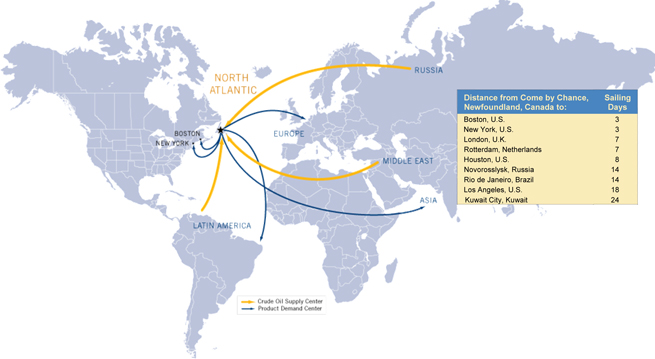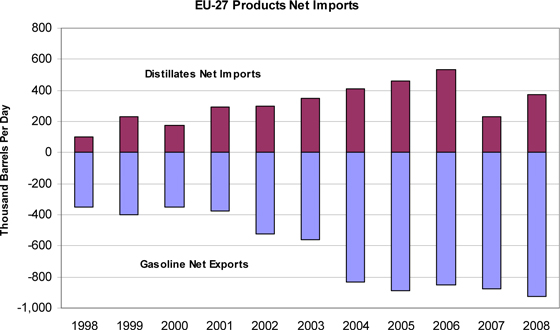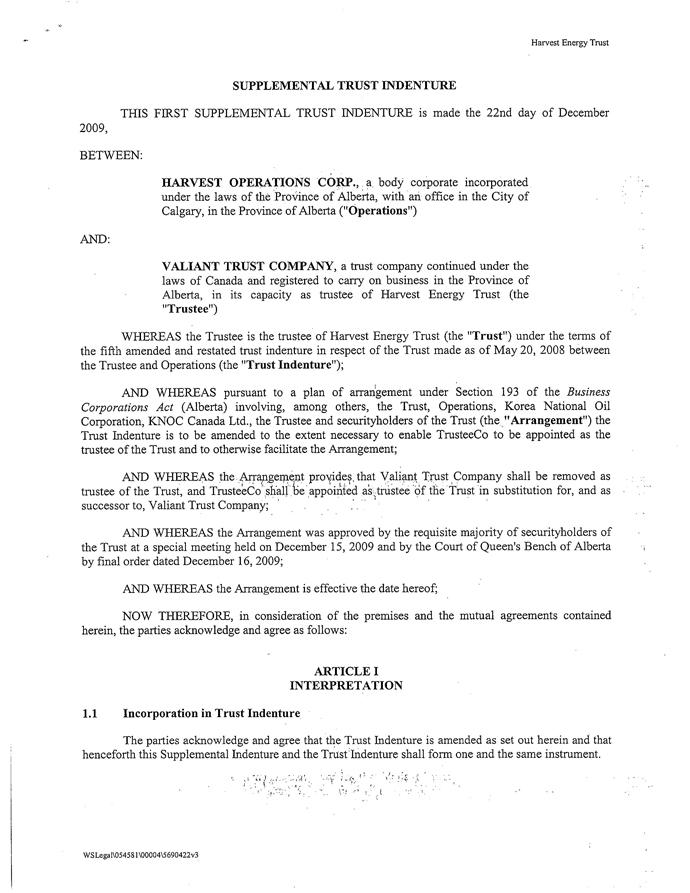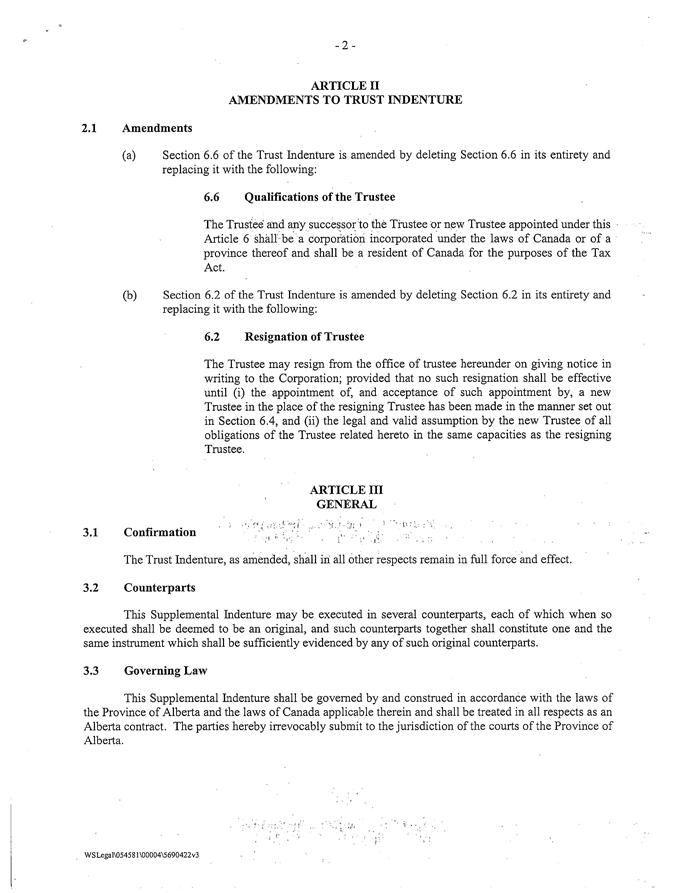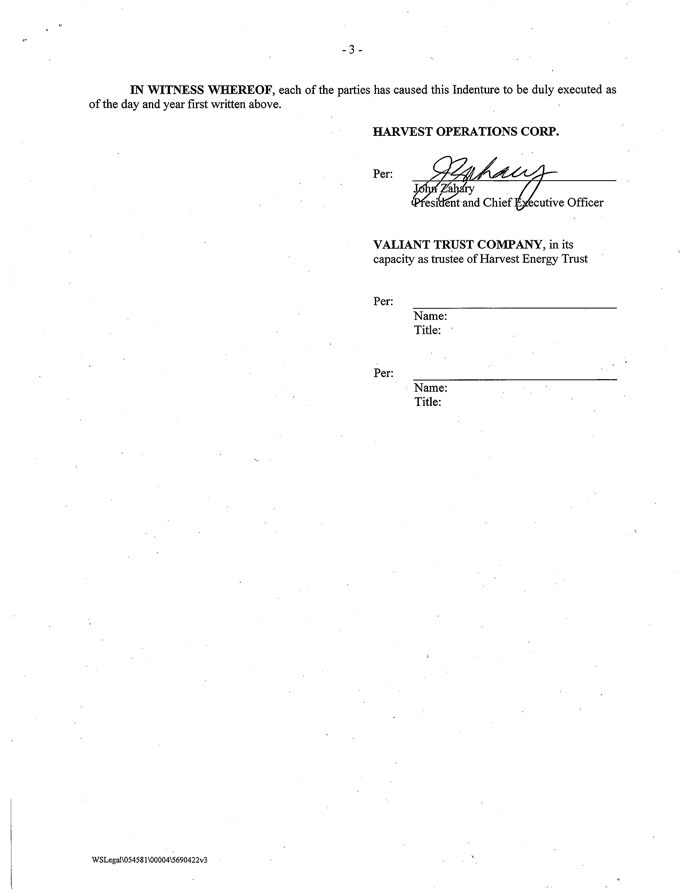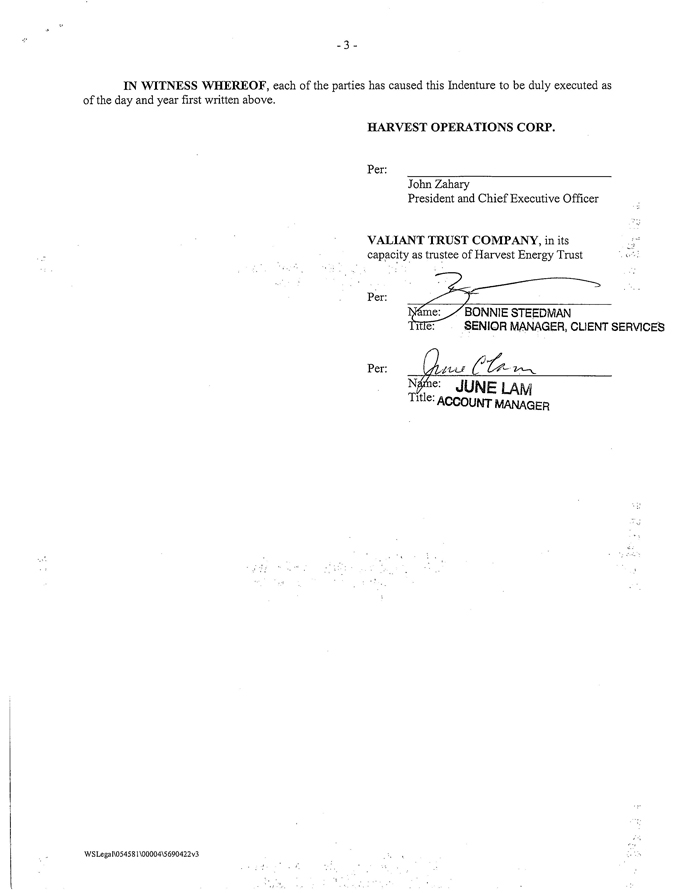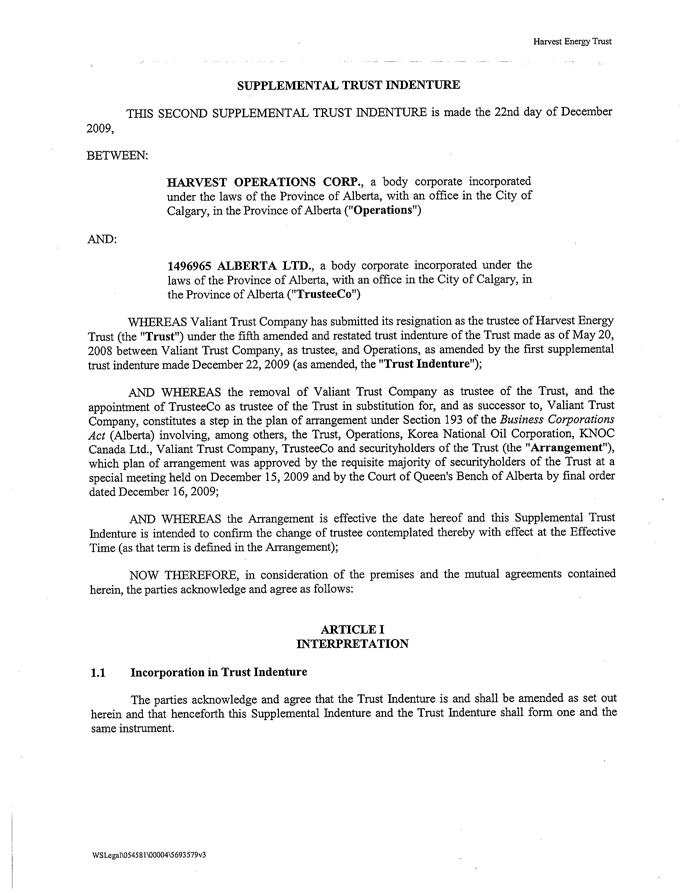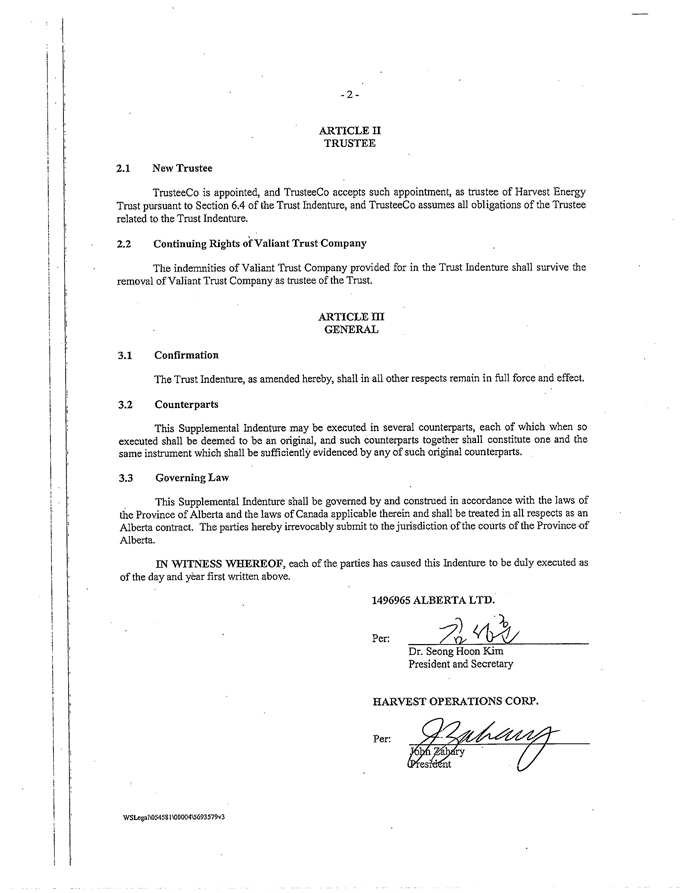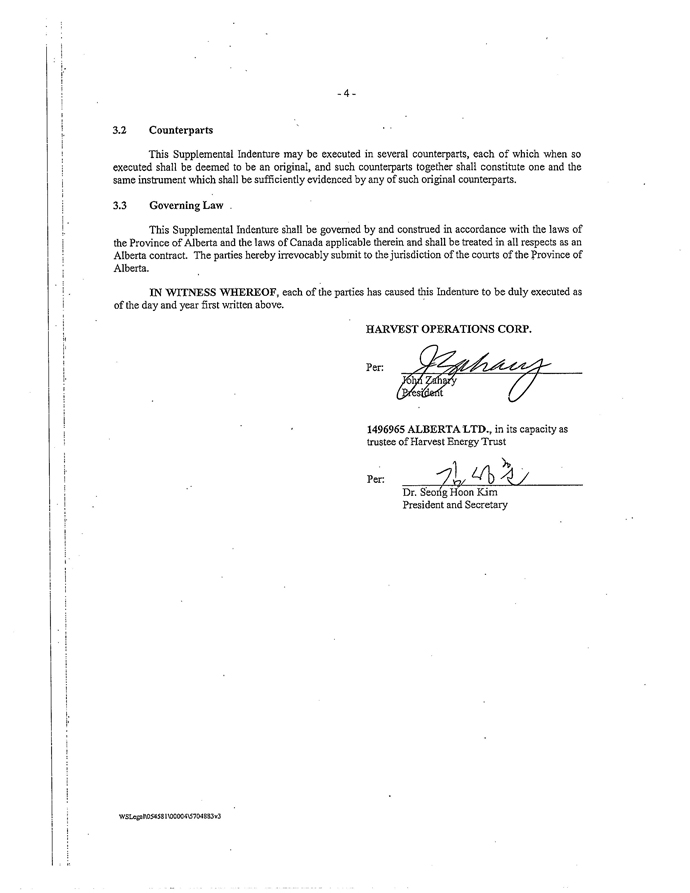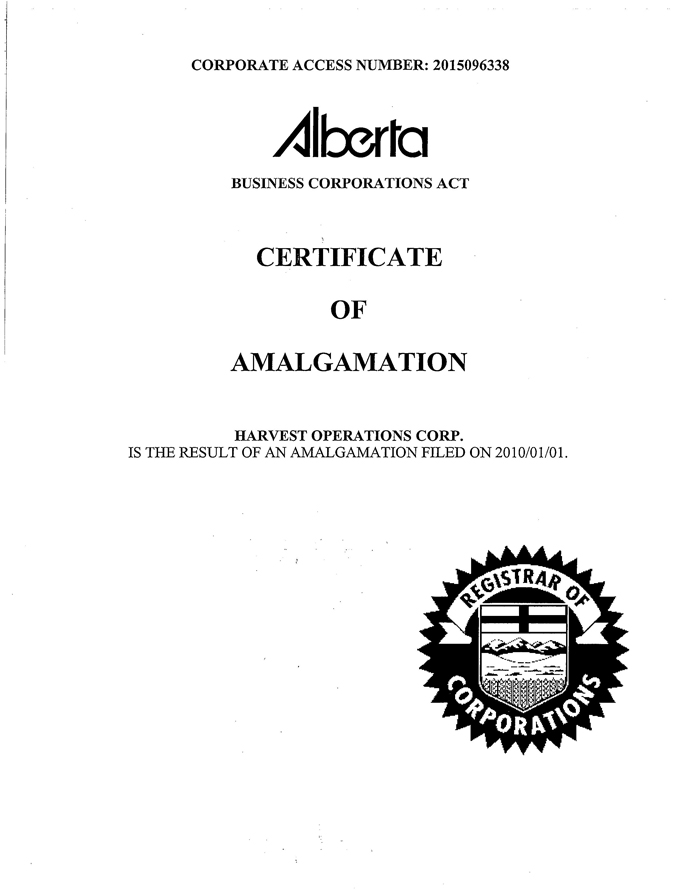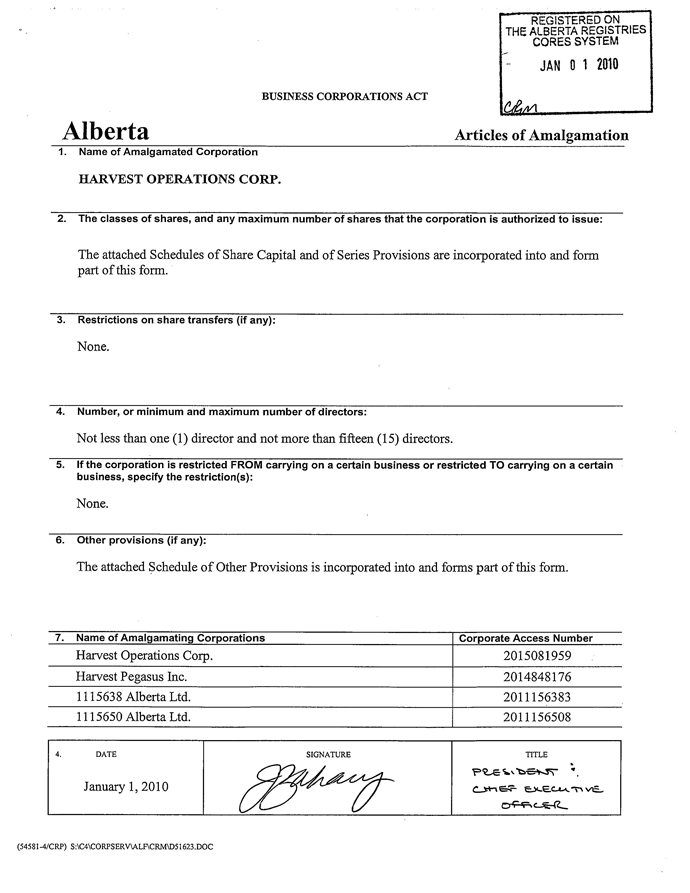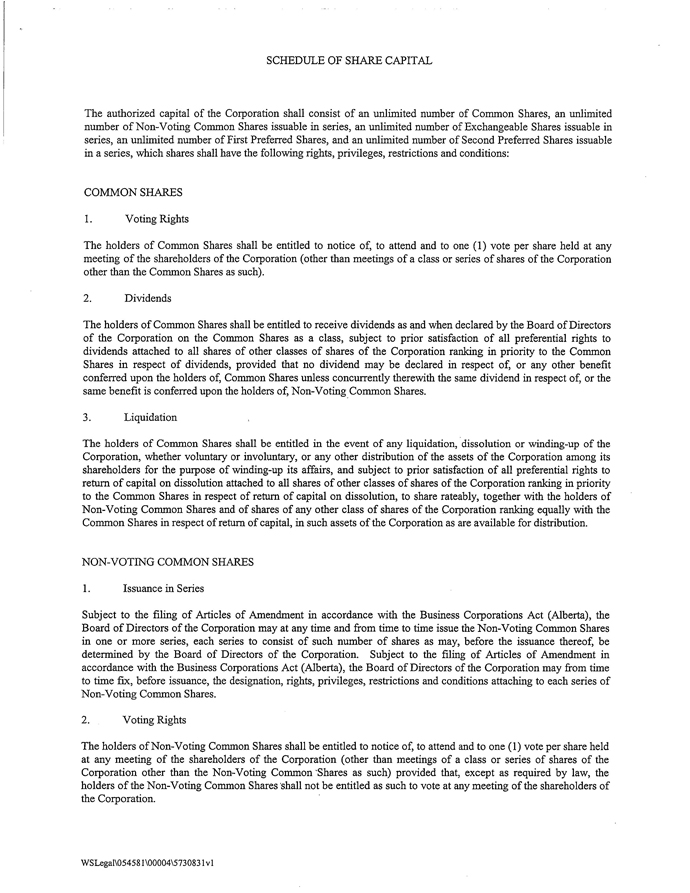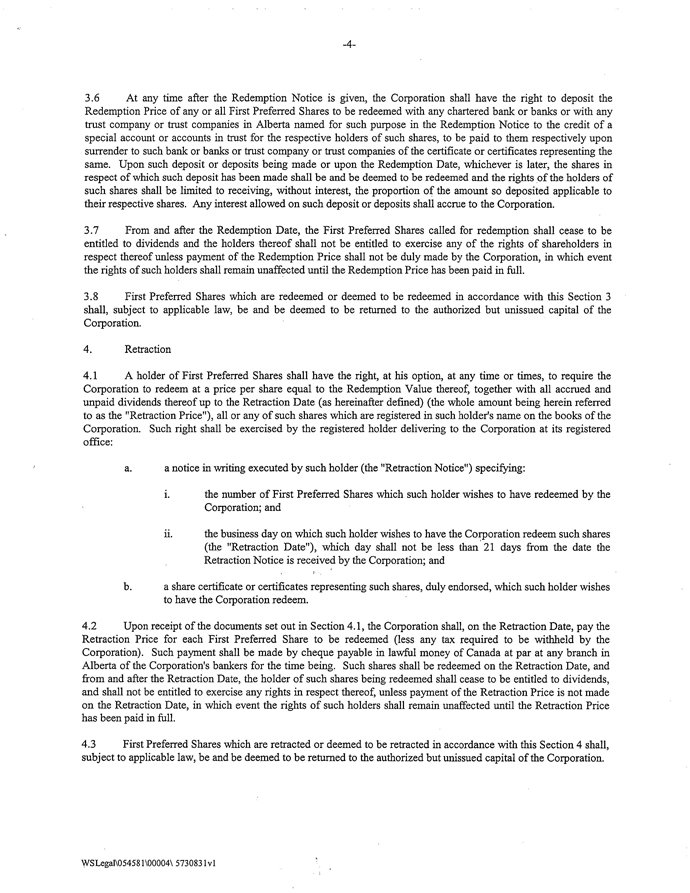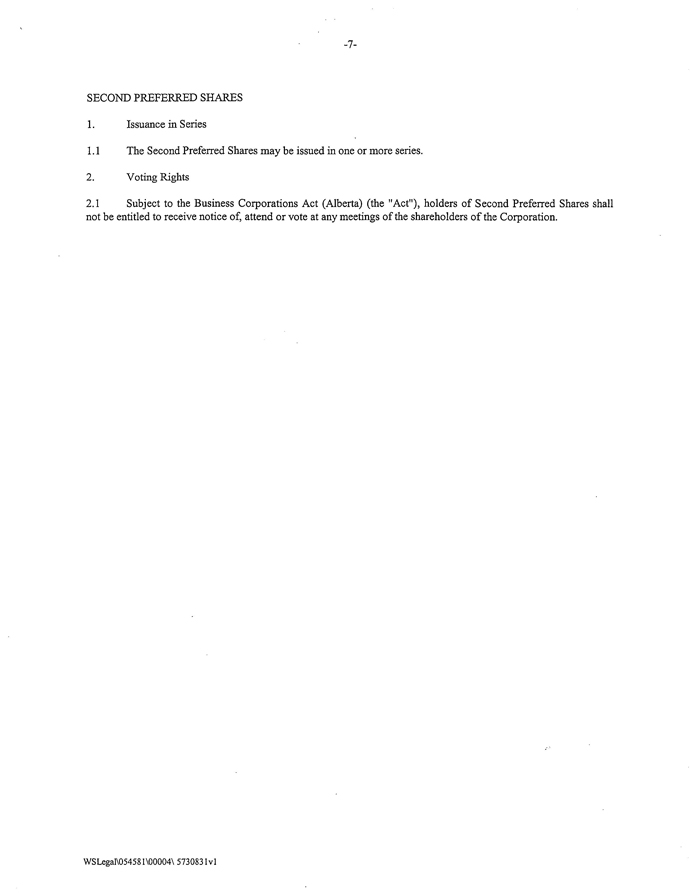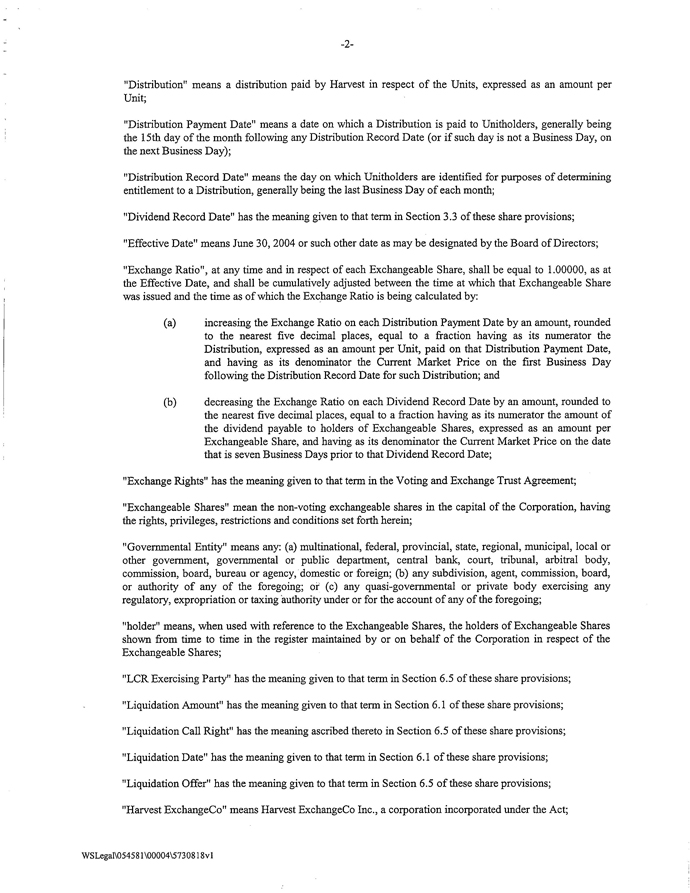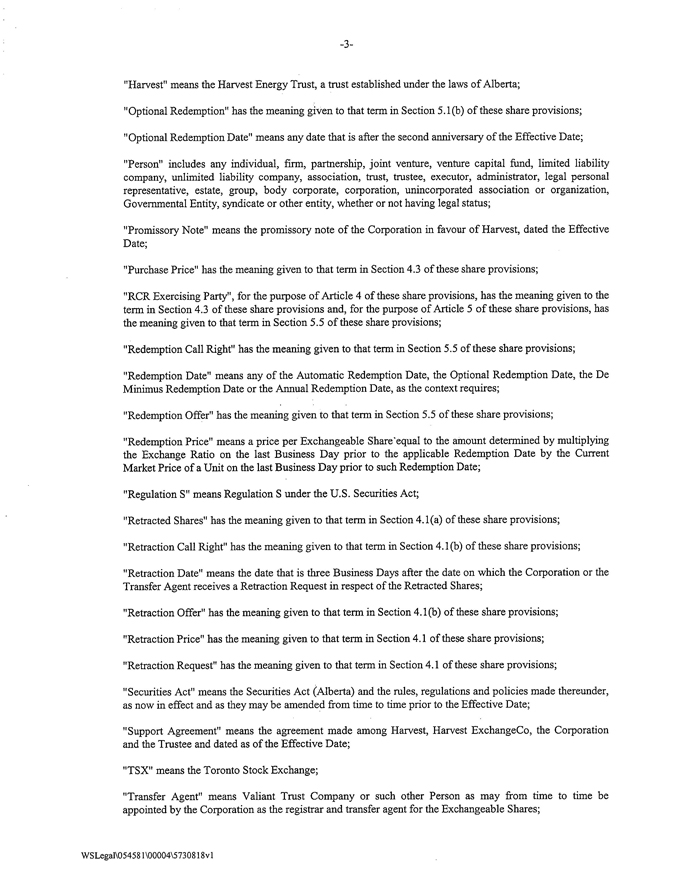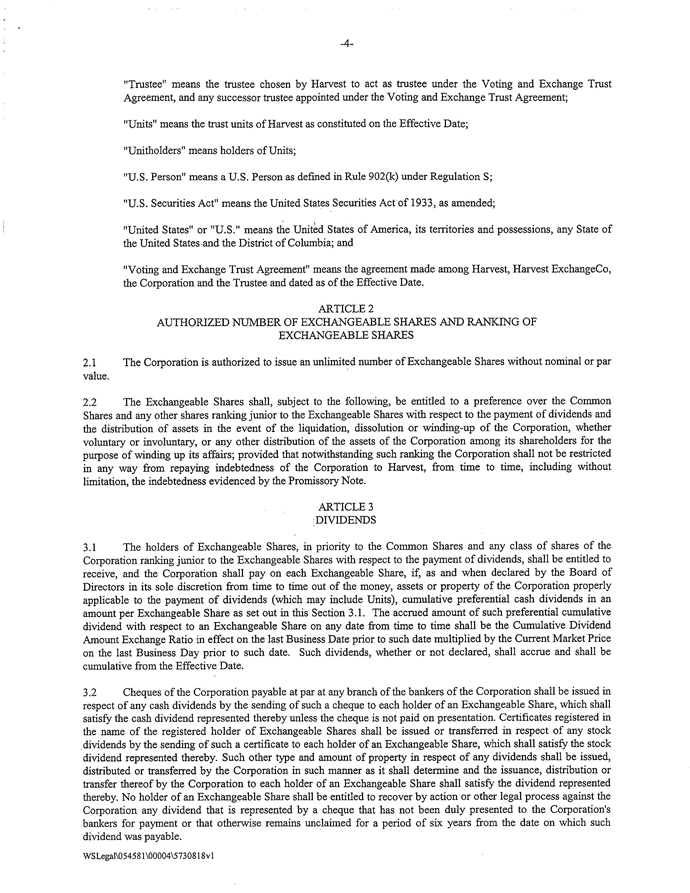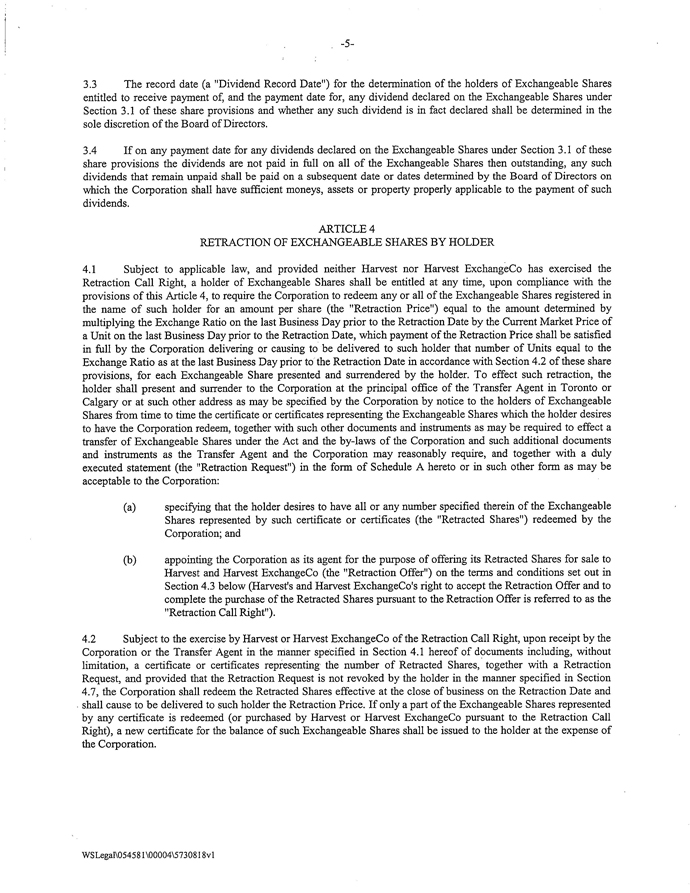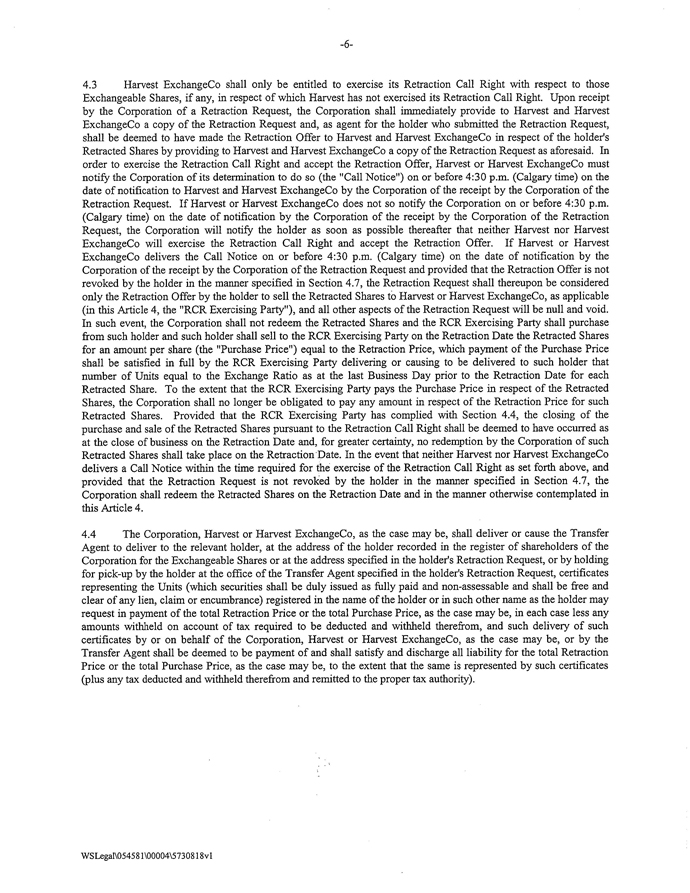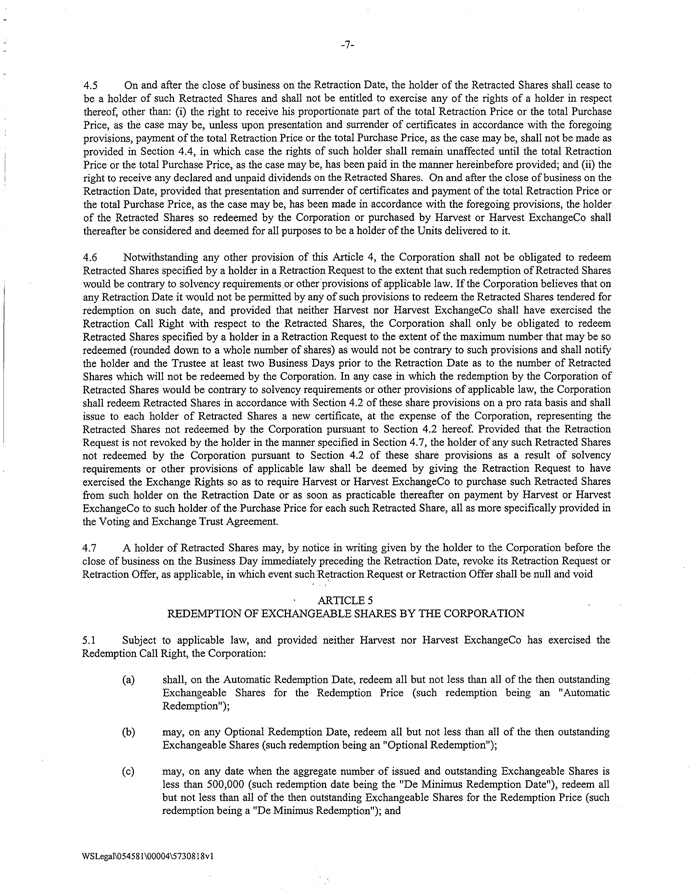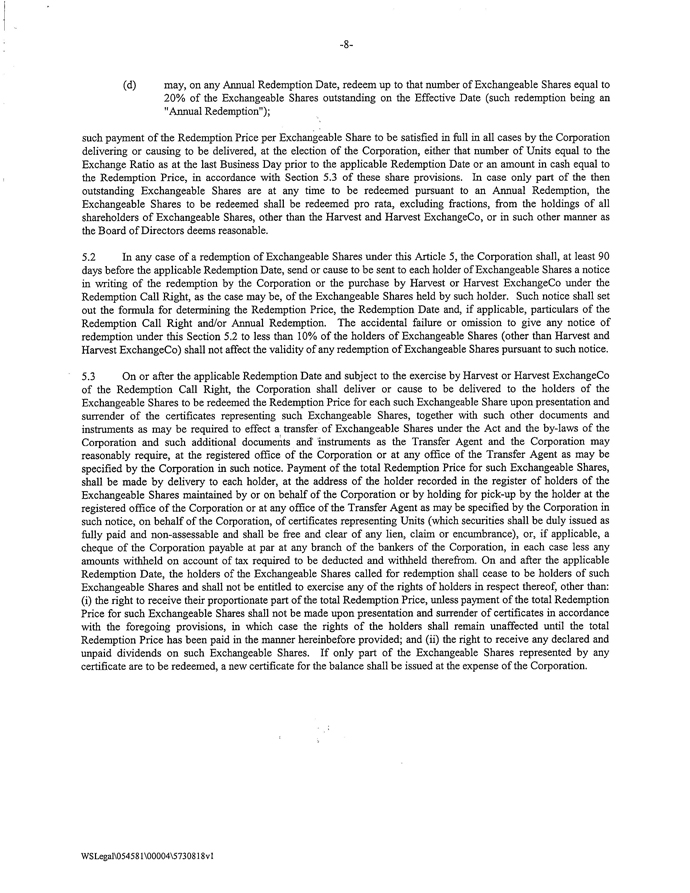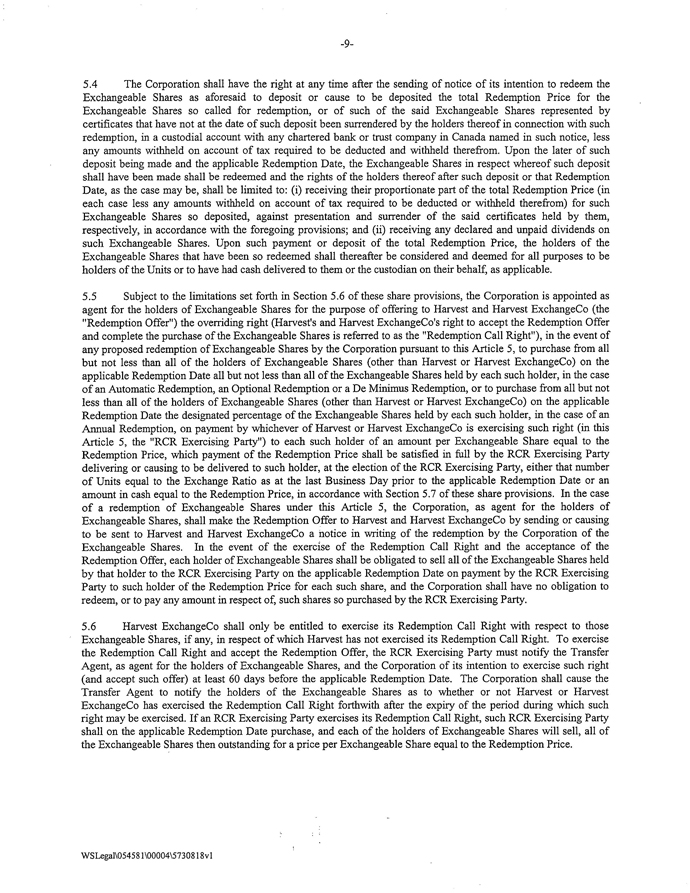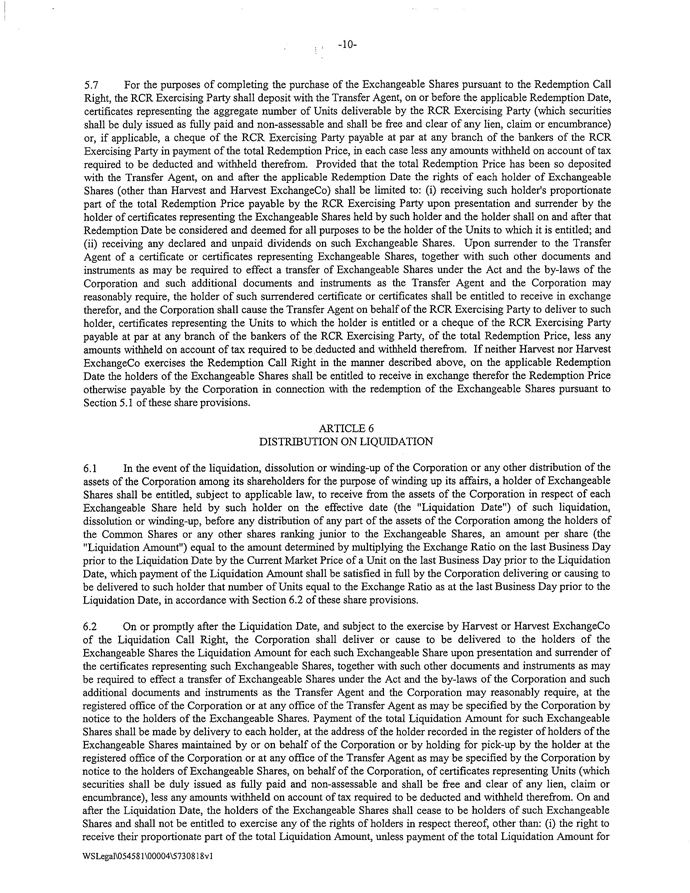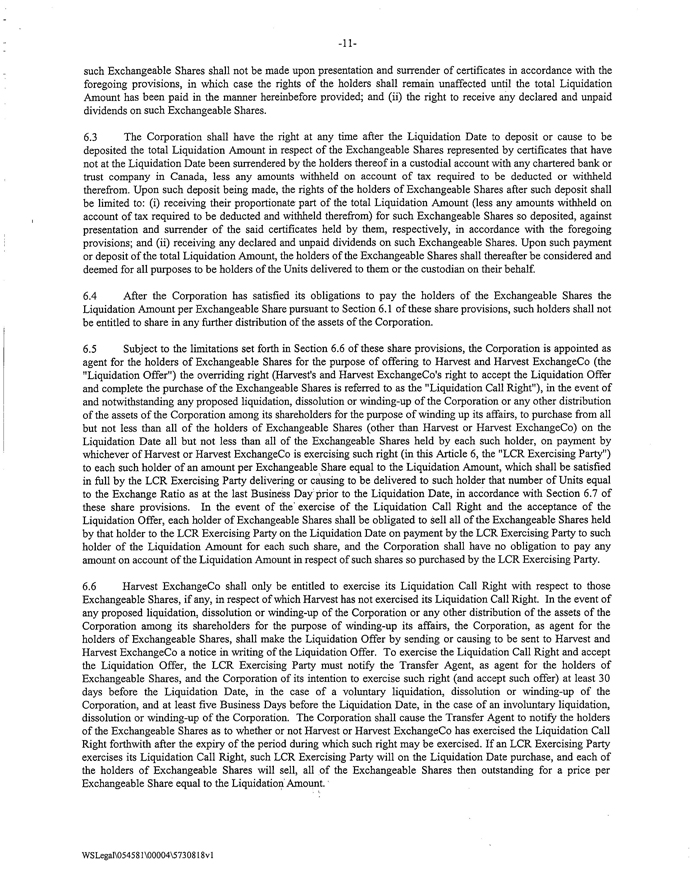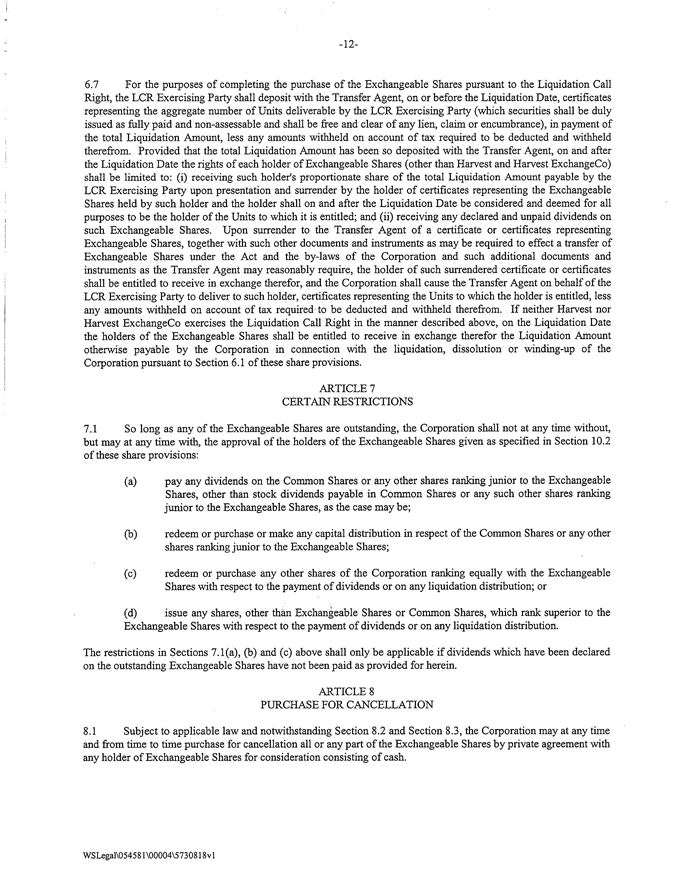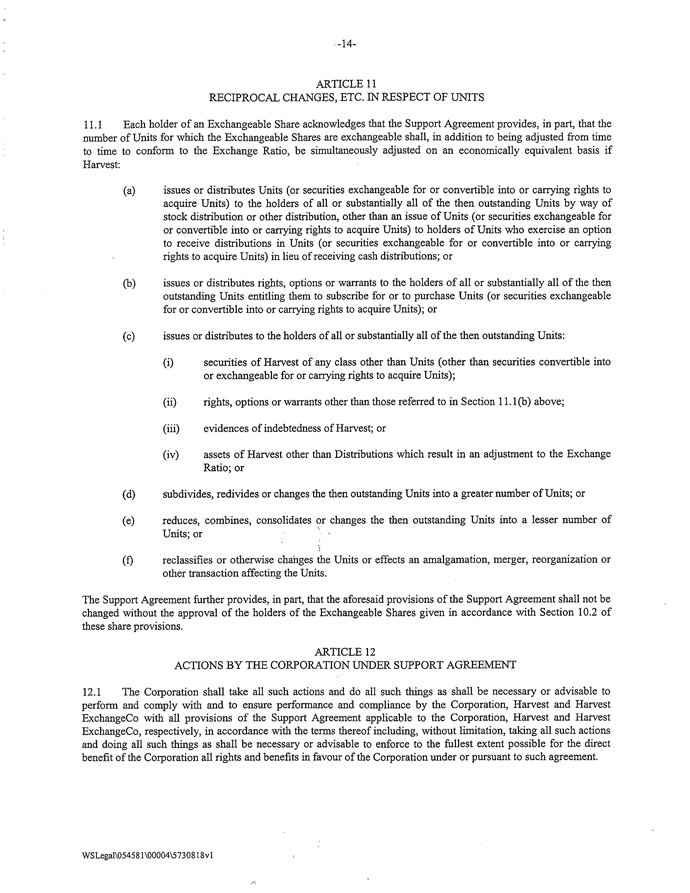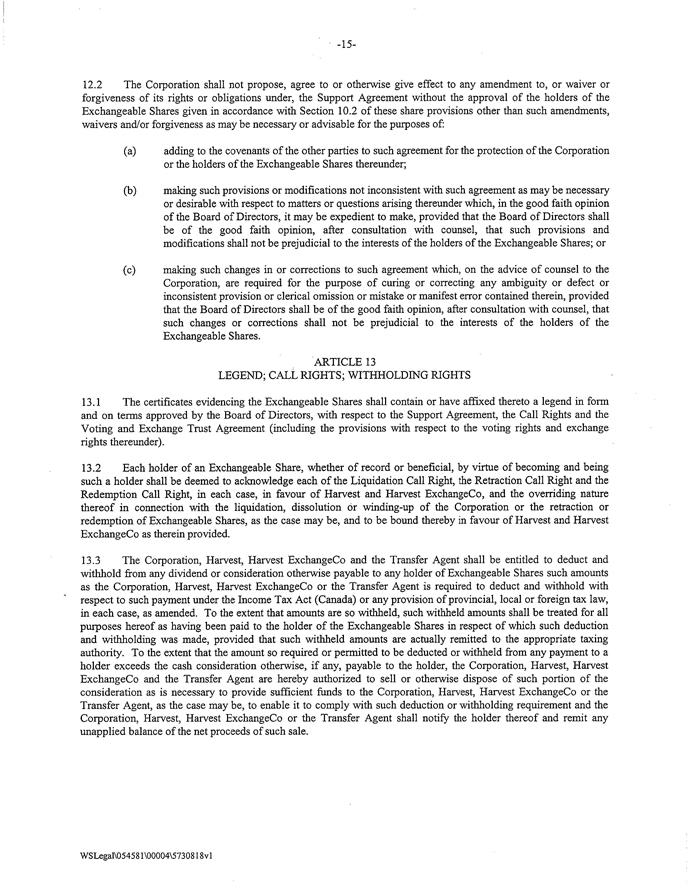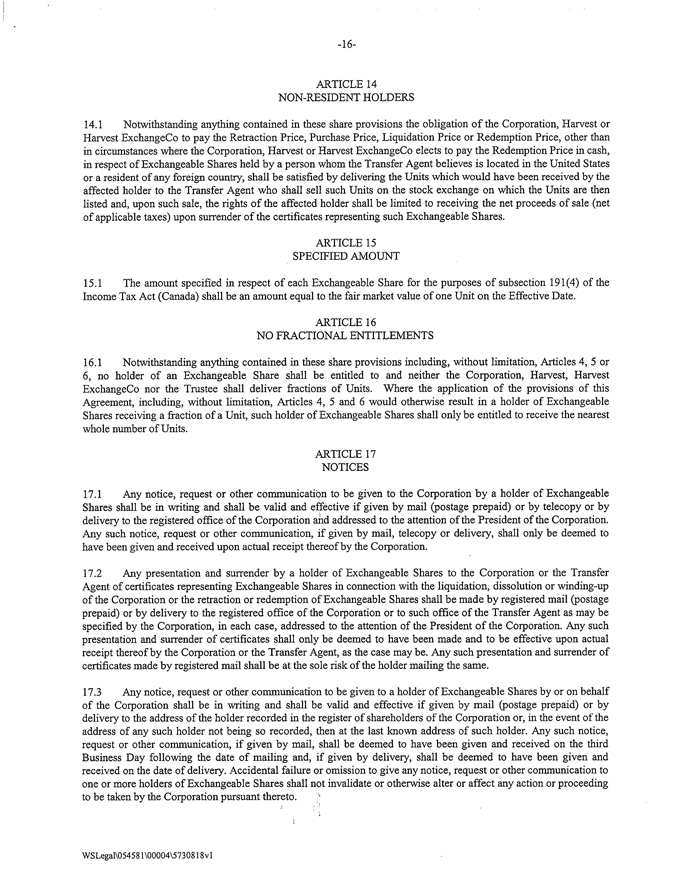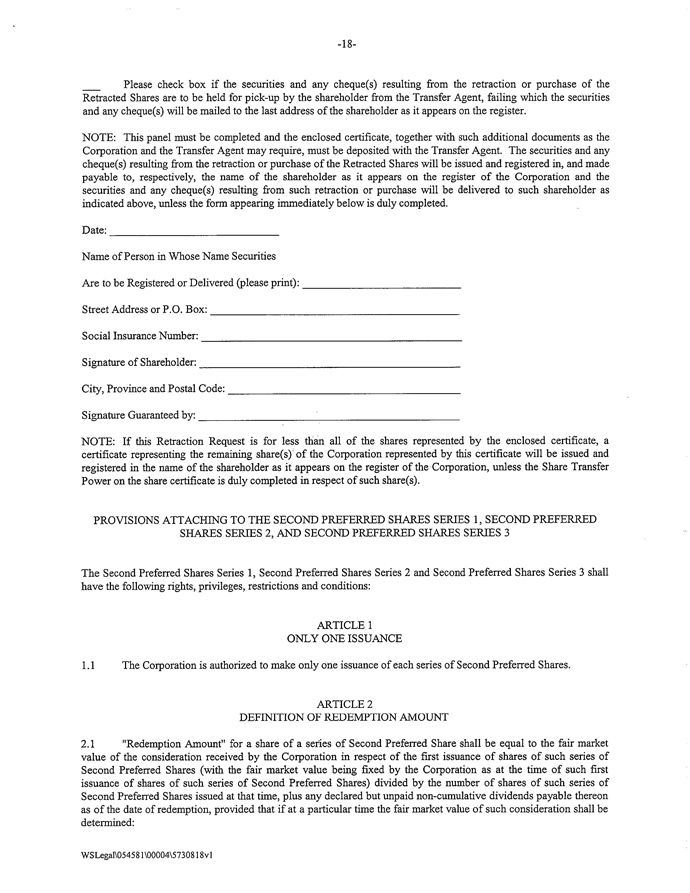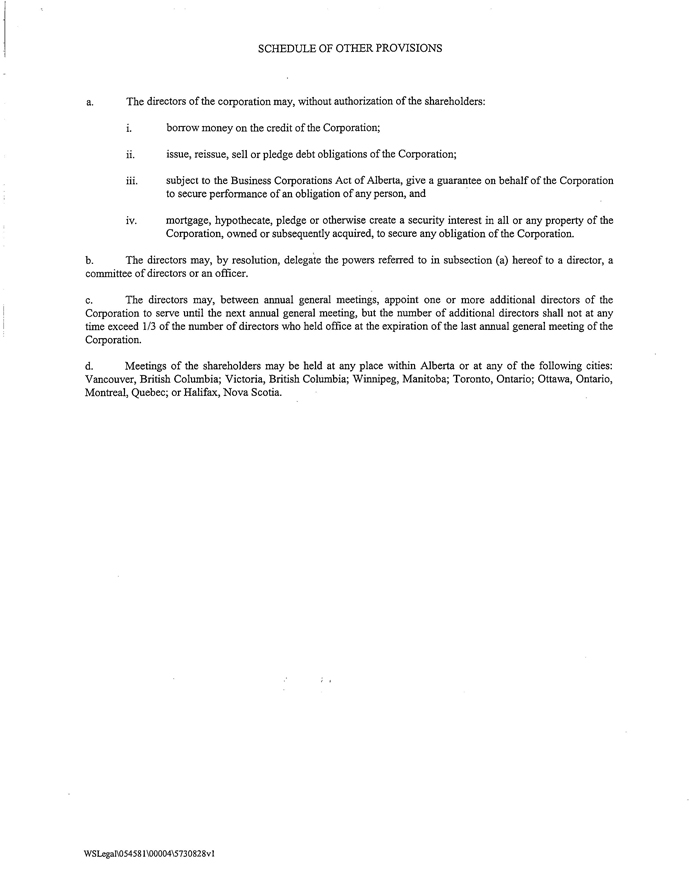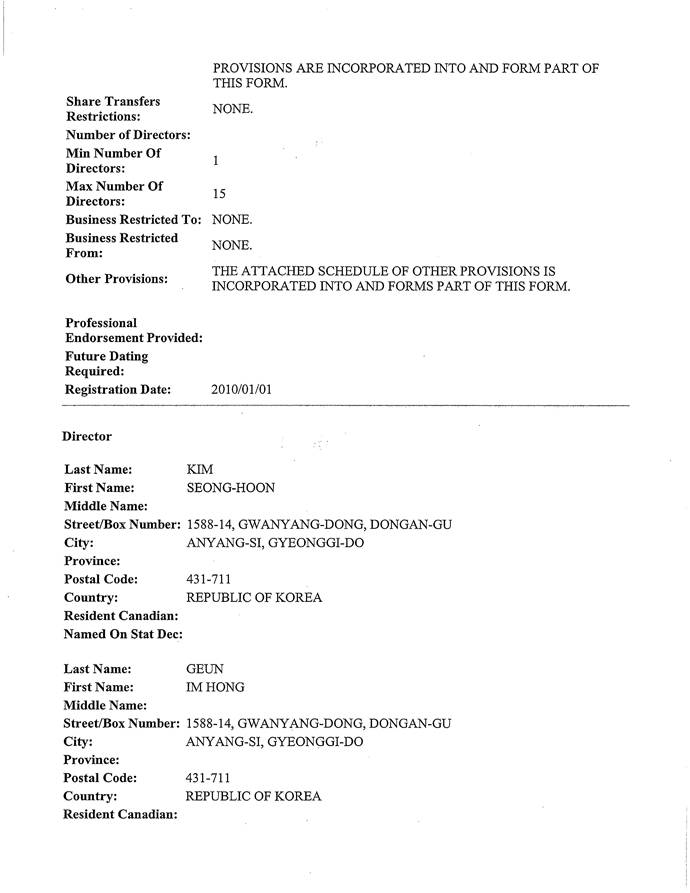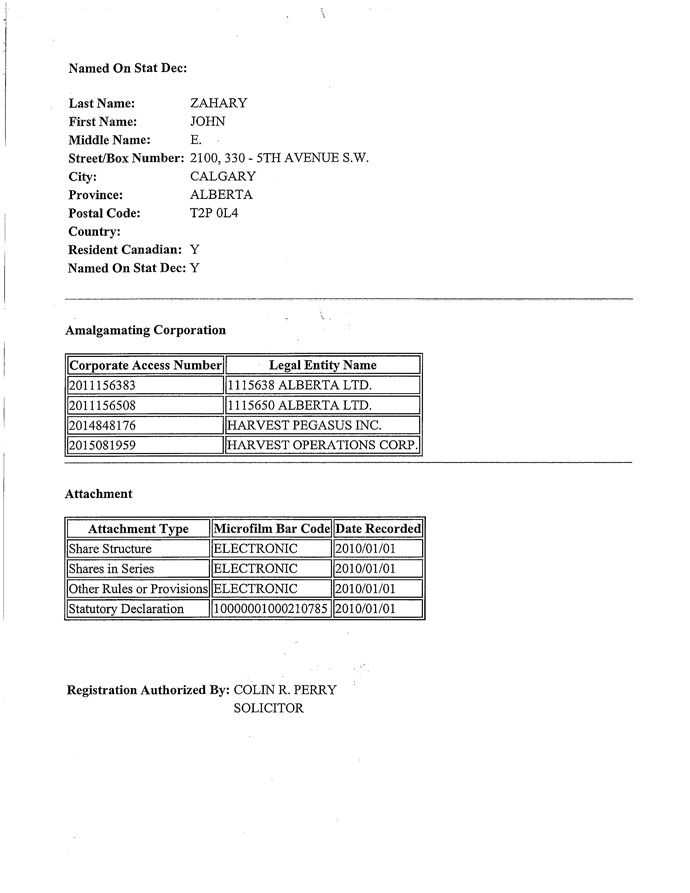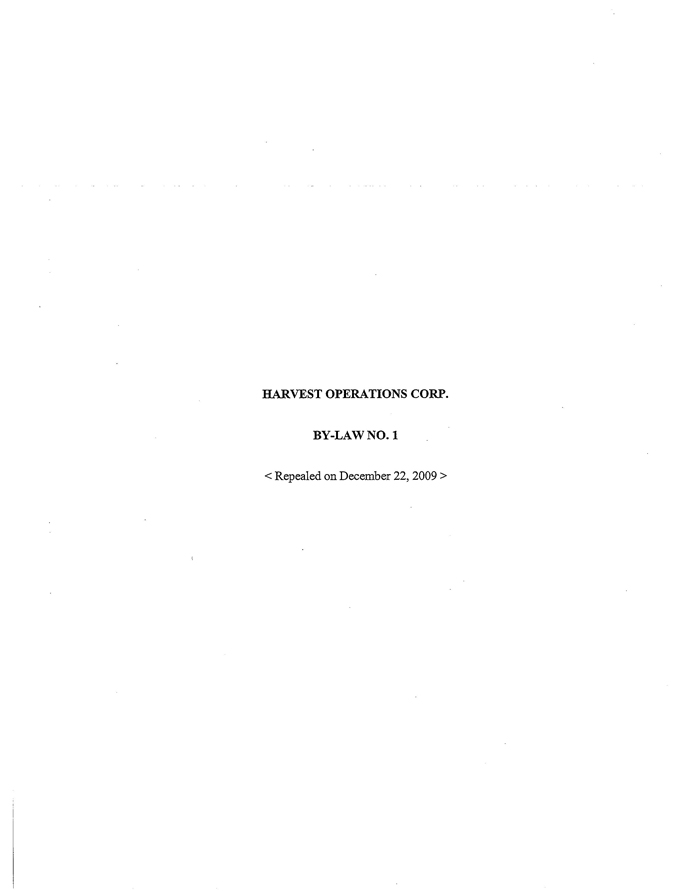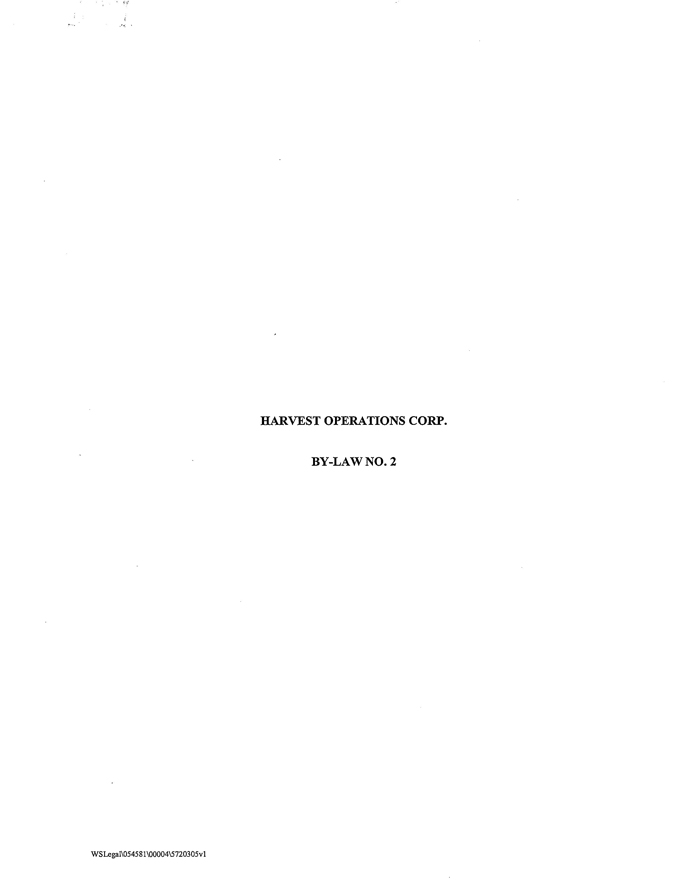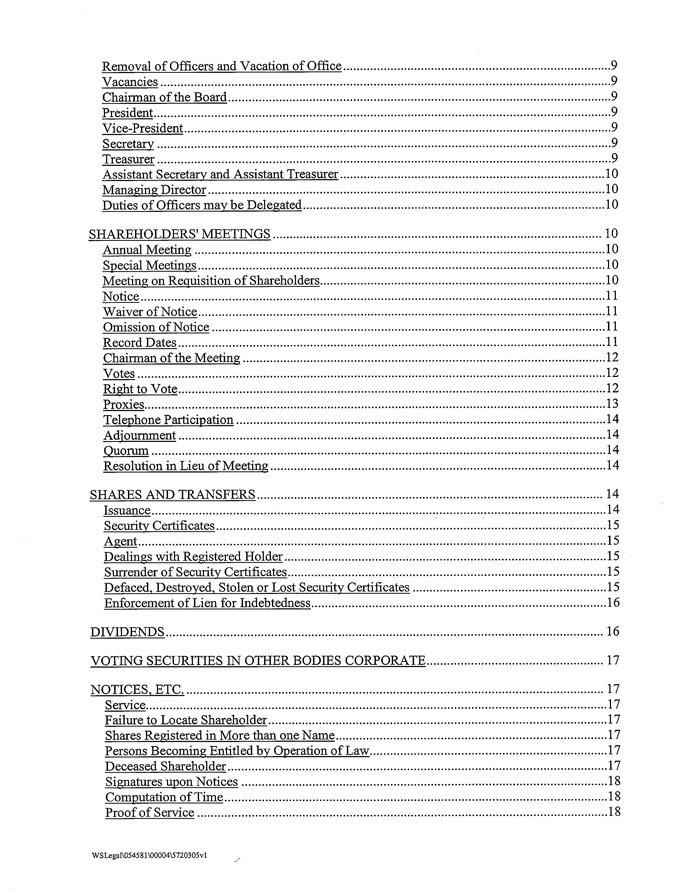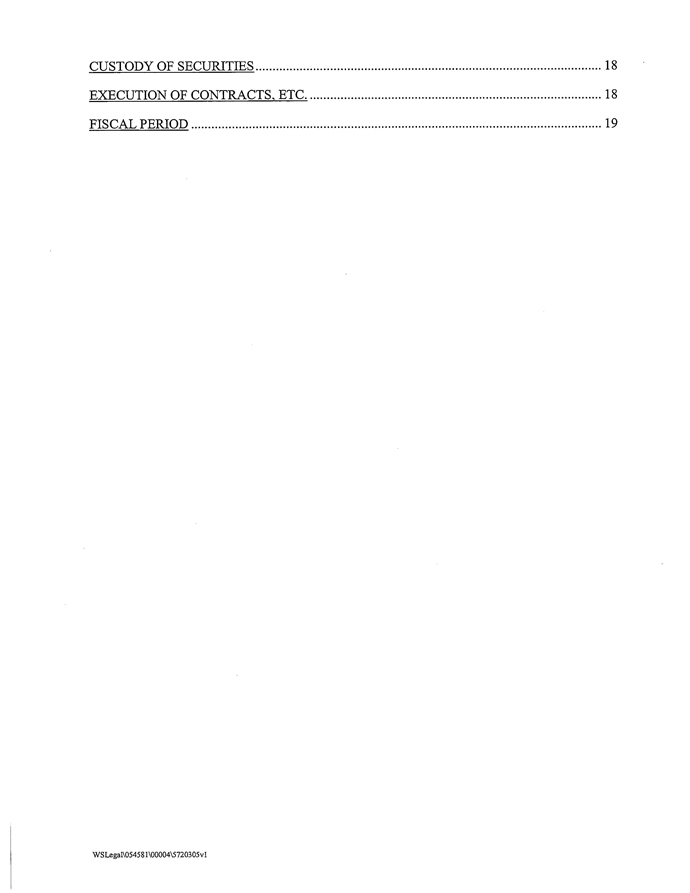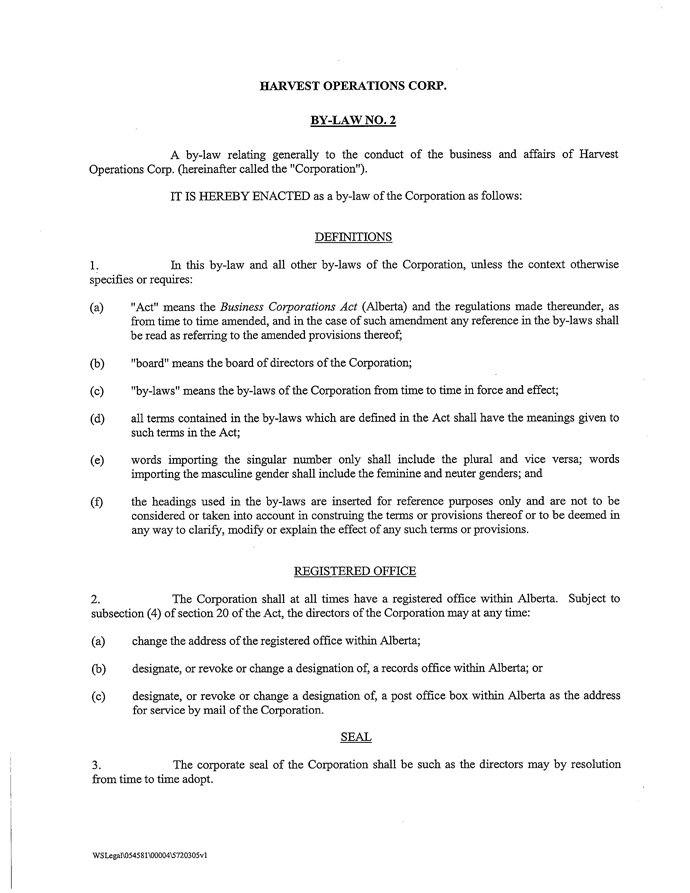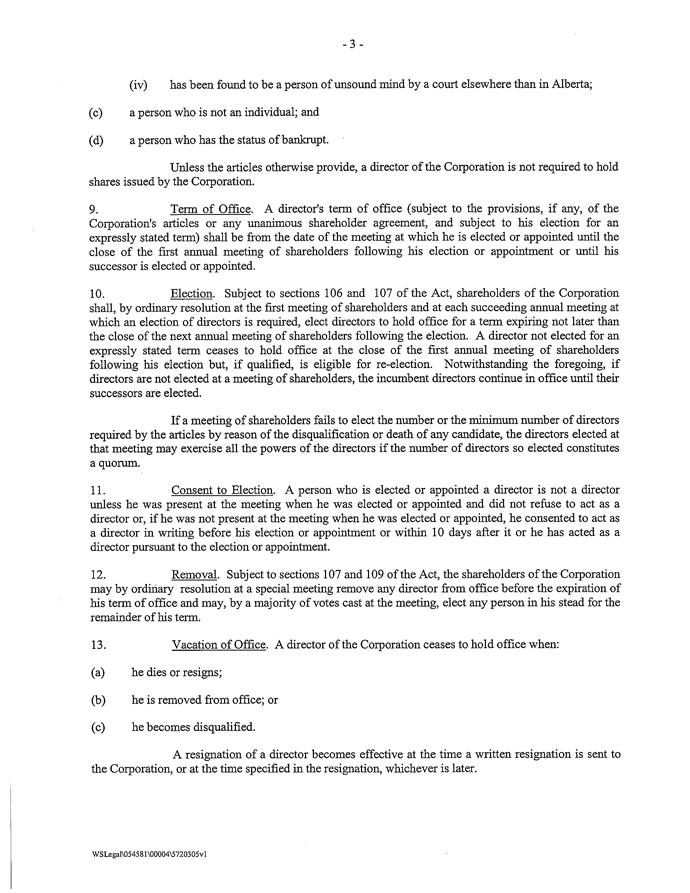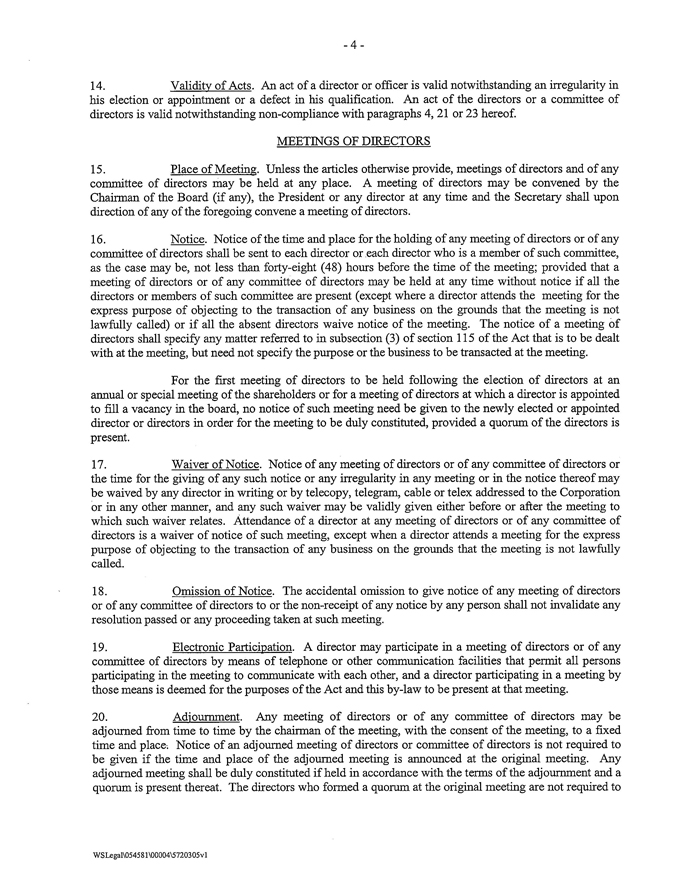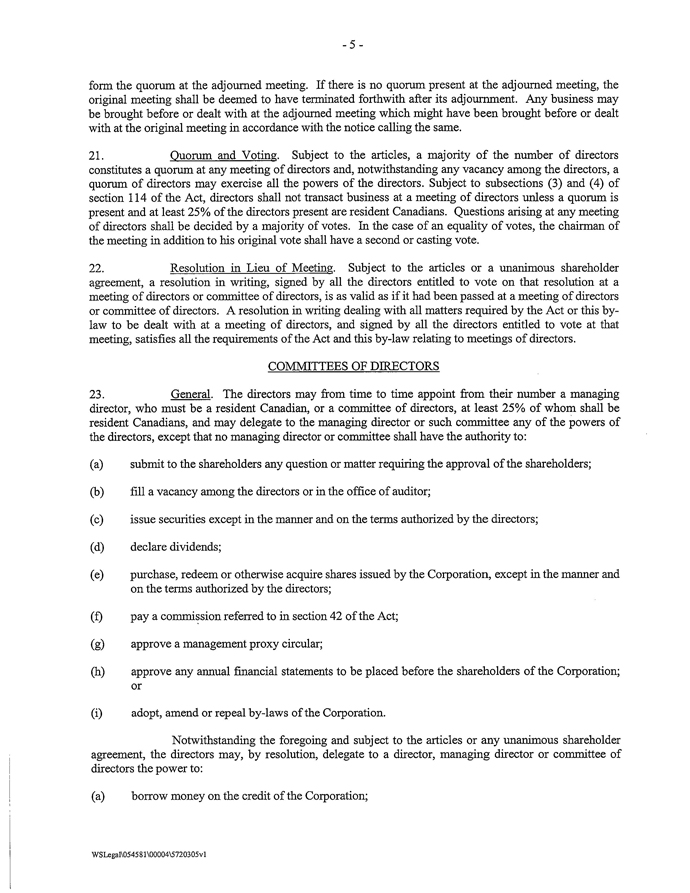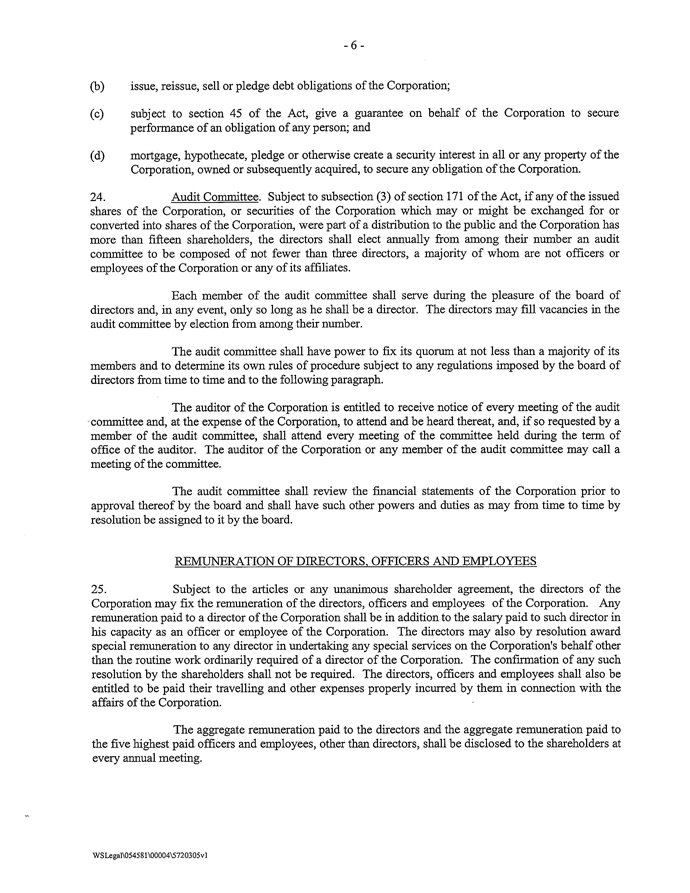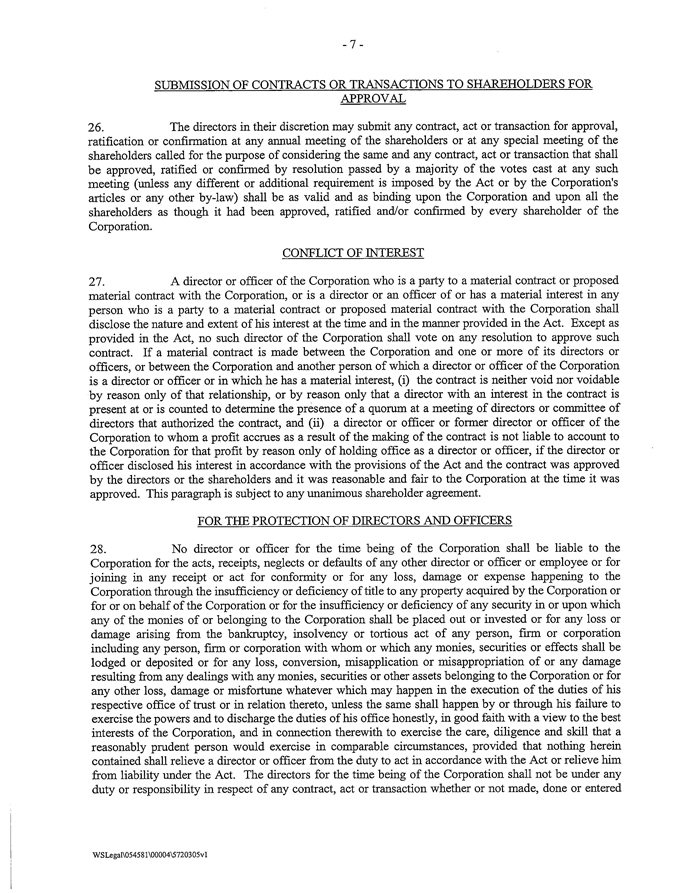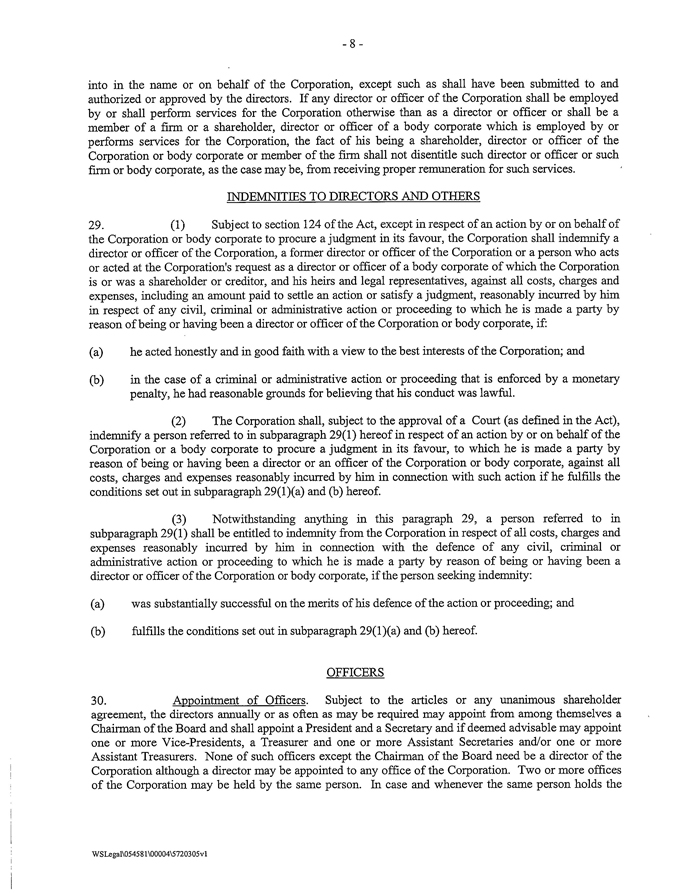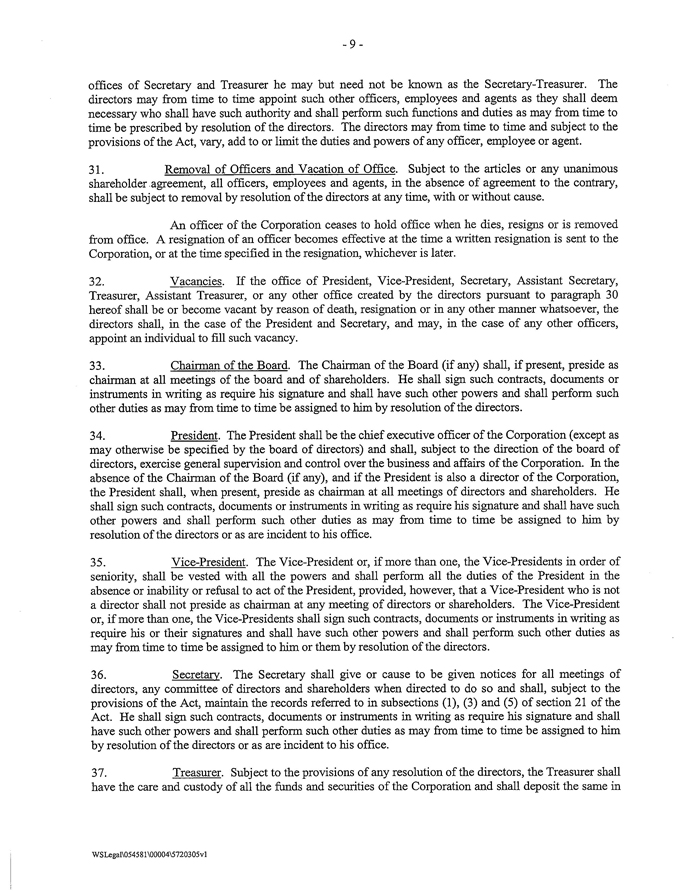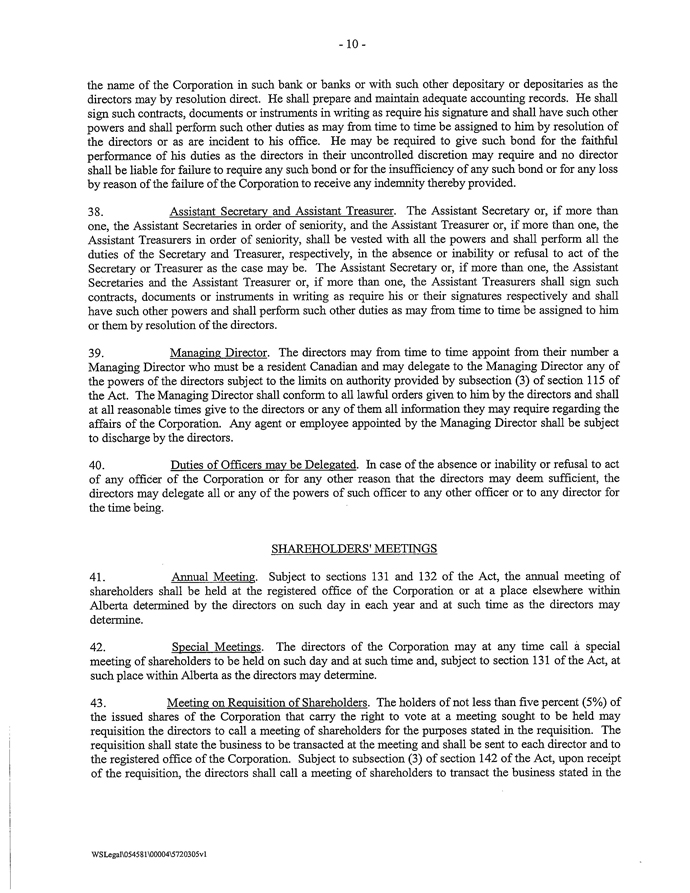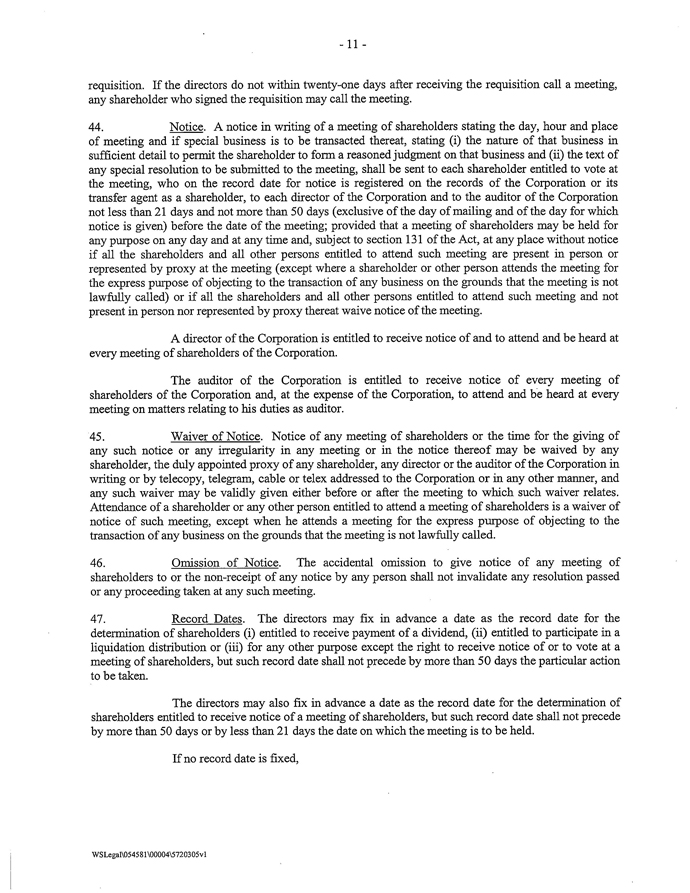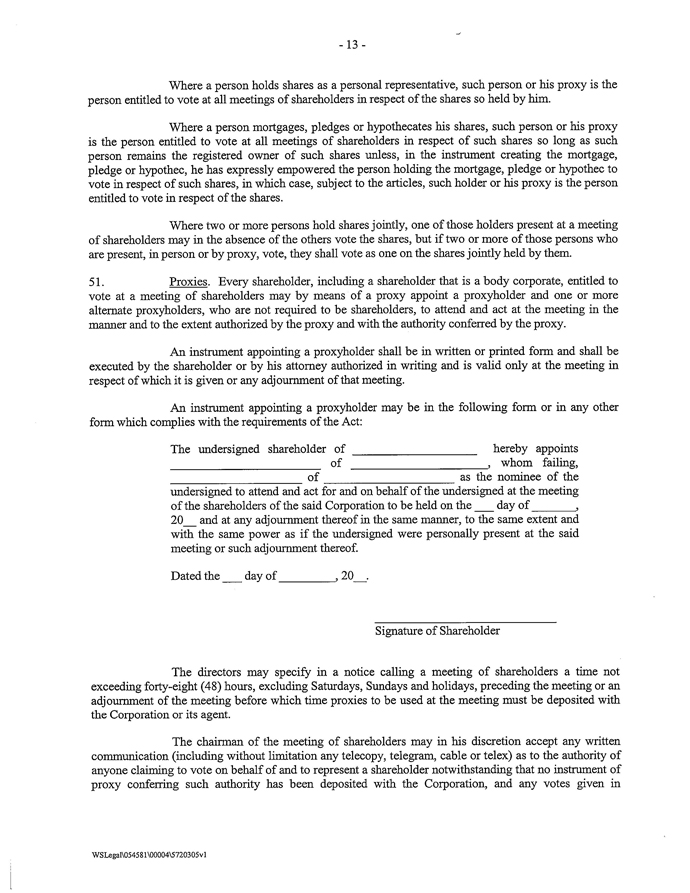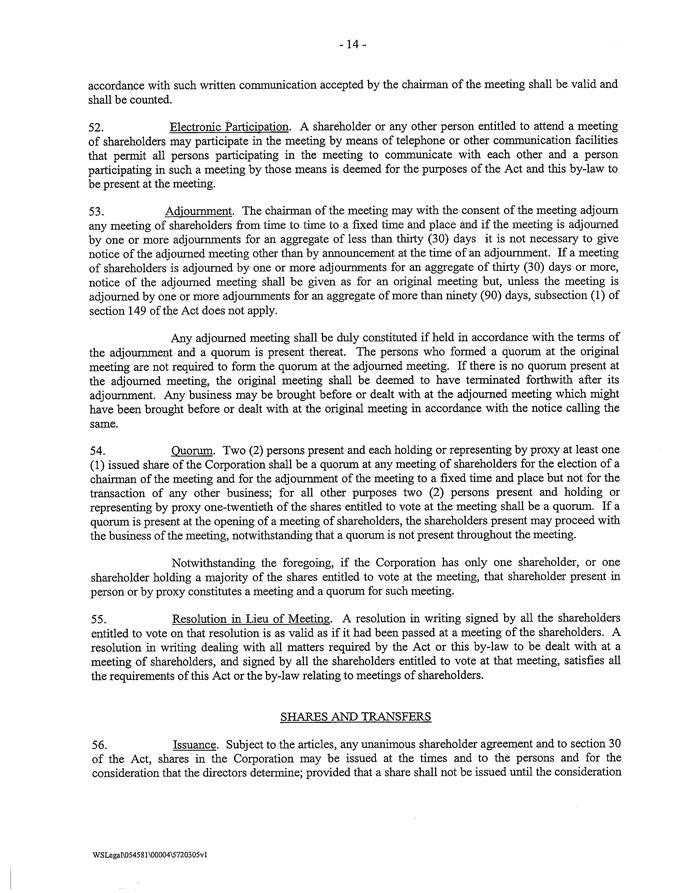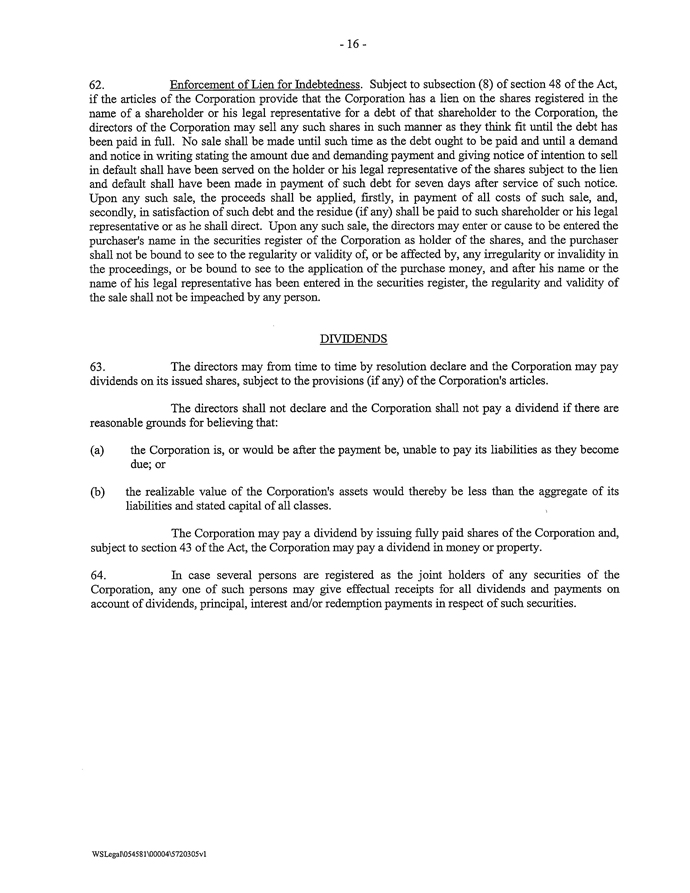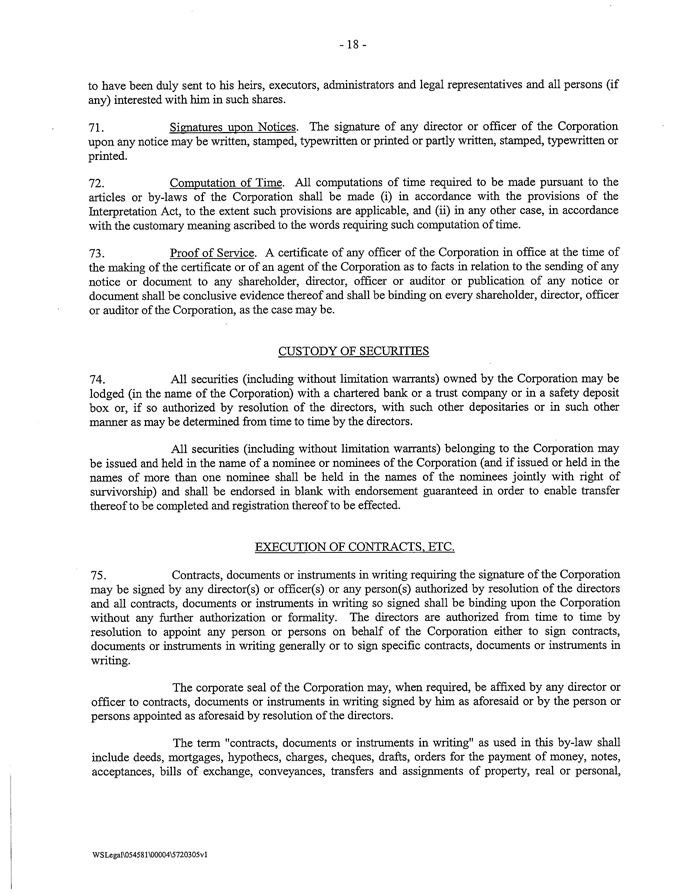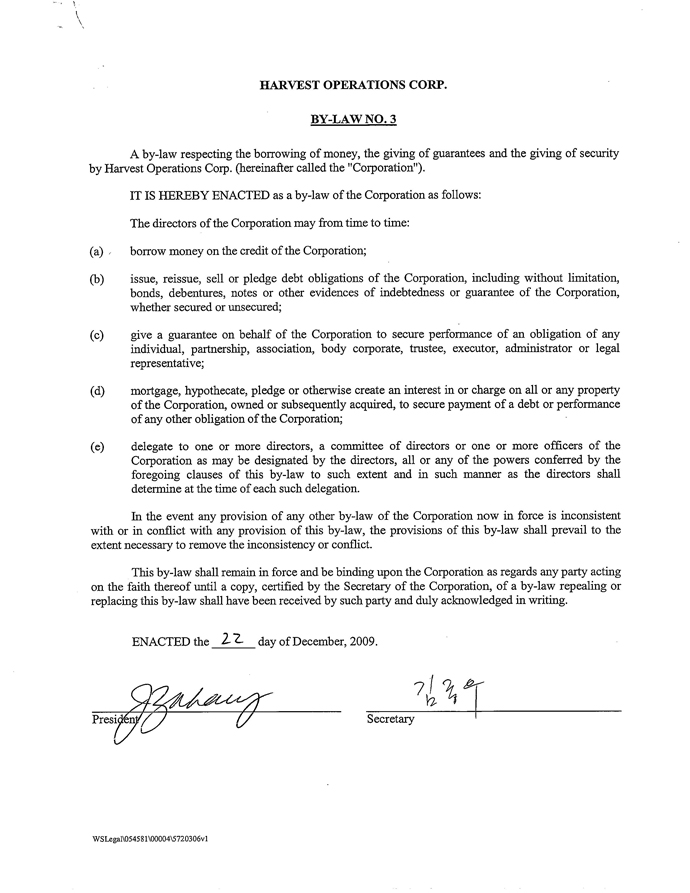FORM 6-K
SECURITIES AND EXCHANGE COMMISSION
Washington, D.C. 20549
REPORT OF FOREIGN PRIVATE ISSUER
PURSUANT TO RULE 13a-16 OR 15d-16
UNDER THE SECURITIES EXCHANGE ACT OF 1934
March 31 st, 2010
Commission File Number: 333-121627
HARVEST ENERGY TRUST
(Exact name of registrant as specified in its charter)
Suite 2100, 330 - 5th Avenue S.W,
Calgary, Alberta, Canada T2P 0L4
(403) 265-1178
(Address of principal executive offices)
Indicate by check mark whether the registrant files or will file annual reports under cover Form 20-F or Form 40-F.
Form 20-F x Form 40-F ¨
Indicate by check mark if the registrant is submitting the Form 6-K in paper as permitted by Regulation S-T Rule 101(b)(1). __
Note: Regulation S-T Rule 101(b)(1) only permits the submission in paper of a Form 6-K if submitted solely to provide an attached annual report to security holders.
Indicate by check mark if the registrant is submitting the Form 6-K in paper as permitted by Regulation S-T Rule 101(b)(7):
Note: Regulation S-T Rule 101(b)(7) only permits the submission in paper of a Form 6-K if submitted to furnish a report or other document that the registrant foreign private issuer must furnish and make public under the laws of the jurisdiction in which the registrant is incorporated, domiciled or legally organized (the registrant’s "home country"), or under the rules of the home country exchange on which the registrant’s securities are traded, as long as the report or other document is not a press release, is not required to be and has not been distributed to the registrant’s security holders, and, if discussing a material event, has already been the subject of a Form 6-K submission or other Commission filing on EDGAR.
Indicate by check mark whether the registrant by furnishing the information contained in this Form is also thereby furnishing the information to the Commission pursuant to Rule 12g3-2(b) under the Securities Exchange Act of 1934.
Yes ¨ No x
If "Yes" is marked, indicate below the file number assigned to the registrant in connection with Rule 12g3-2(b):
| EXHIBIT | | TITLE |
| | | |
| 1 | | Material Document – Amending Agreement to the Amended and restated Credit Agreement dated December 21, 2009 filed on SEDAR March 30, 2010. |
| | | |
| 2 | | Material Document – Supply and Offtake Agreement dated October 19, 2006 filed on SEDAR March 30, 2010. |
| | | |
| 3 | | Annual Information Form filed on SEDAR March 30, 2010. |
| | | |
| 4 | | News release dated March 30, 2010 announcing filing of 2009 Annual Information Form filed on SEDAR March 30, 2010. |
| | | |
| 5 | | CEO certification of annual filings of Harvest Energy Trust, dated March 30, 2010 filed on SEDAR March 30, 2010. |
| | | |
| 6 | | CFO certification of annual filings of Harvest Energy Trust, dated March 30, 2010 filed on SEDAR March 30, 2010. |
| | | |
| 7 | | Securityholders Documents – First, Second and Third Supplemental Trust Indentures as of December 22, 2009 filed on SEDAR March 30, 2010. |
| | | |
| 8 | | Securityholders Documents – Certificate of Amalgamation as of January 1, 2010 filed on SEDAR March 30, 2010. |
| | | |
| 9 | | Securityholders Documents – By-Laws of Harvest Operations Corp. dated December 22, 2009 filed on SEDAR March 30, 2010. |
SIGNATURE
Pursuant to the requirements of the Securities Exchange Act of 1934, the registrant has duly caused this report to be signed on its behalf by the undersigned, thereunto duly authorized.
| | HARVEST ENERGY TRUST |
| | (Registrant) |
| | | |
Date: March 31 st, 2010 | By: | /S/ John Zahary |
| | | John Zahary |
| | | President & Chief Executive Officer |
INDEX TO EXHIBITS
| | TITLE |
| | | |
| 1 | | Material Document – Amending Agreement to the Amended and restated Credit Agreement dated December 21, 2009 filed on SEDAR March 30, 2010. |
| | | |
| 2 | | Material Document – Supply and Offtake Agreement dated October 19, 2006 filed on SEDAR March 30, 2010. |
| | | |
| 3 | | Annual Information Form filed on SEDAR March 30, 2010. |
| | | |
| 4 | | News release dated March 30, 2010 announcing filing of 2009 Annual Information Form filed on SEDAR March 30, 2010. |
| | | |
| 5 | | CEO certification of annual filings of Harvest Energy Trust, dated March 30, 2010 filed on SEDAR March 30, 2010. |
| | | |
| 6 | | CFO certification of annual filings of Harvest Energy Trust, dated March 30, 2010 filed on SEDAR March 30, 2010. |
| | | |
| 7 | | Securityholders Documents – First, Second and Third Supplemental Trust Indentures as of December 22, 2009 filed on SEDAR March 30, 2010. |
| | | |
| | Securityholders Documents – Certificate of Amalgamation as of January 1, 2010 filed on SEDAR March 30, 2010. |
| | | |
| 9 | | Securityholders Documents – By-Laws of Harvest Operations Corp. dated December 22, 2009 filed on SEDAR March 30, 2010. |

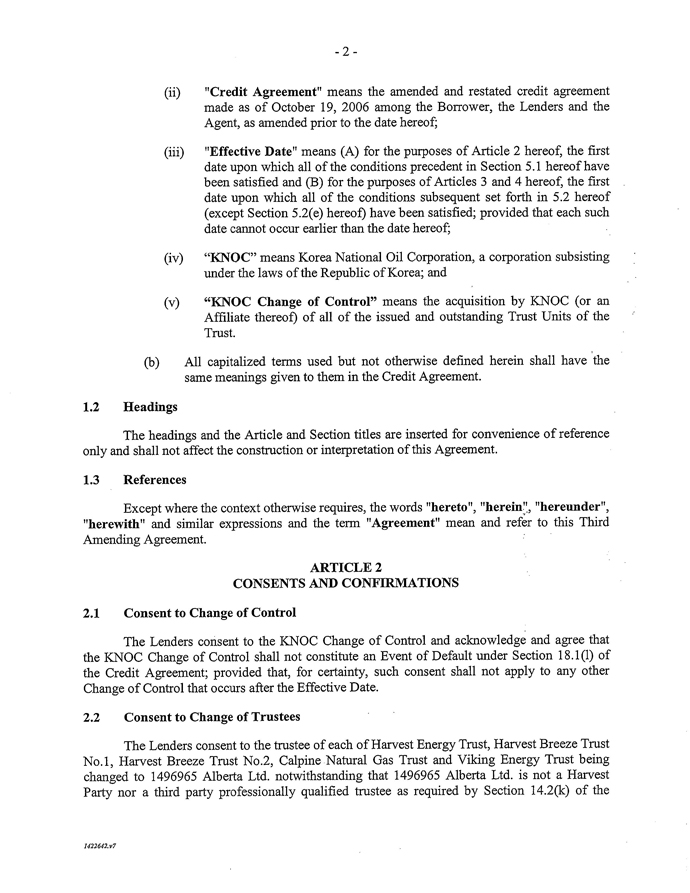


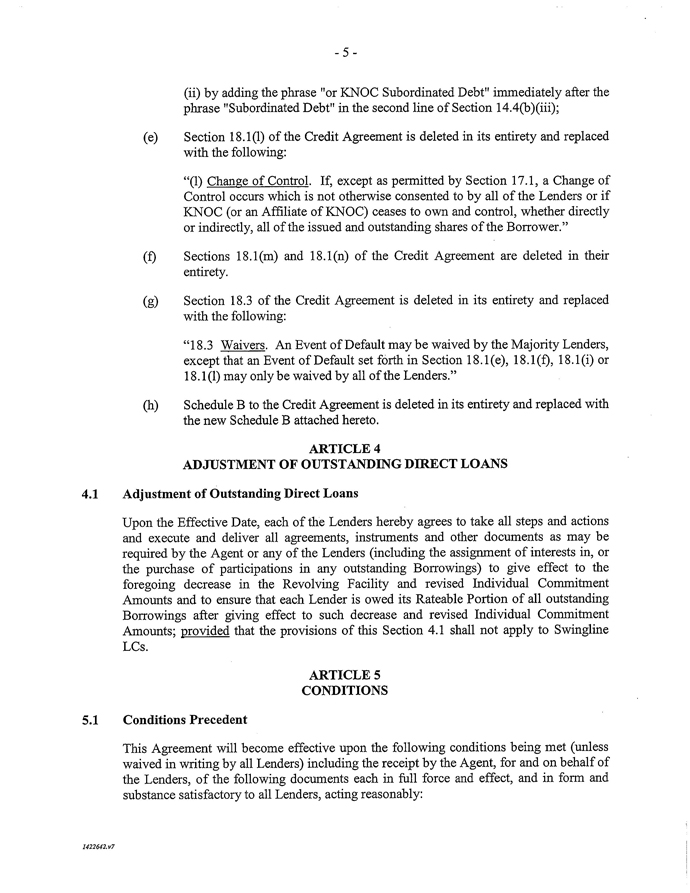
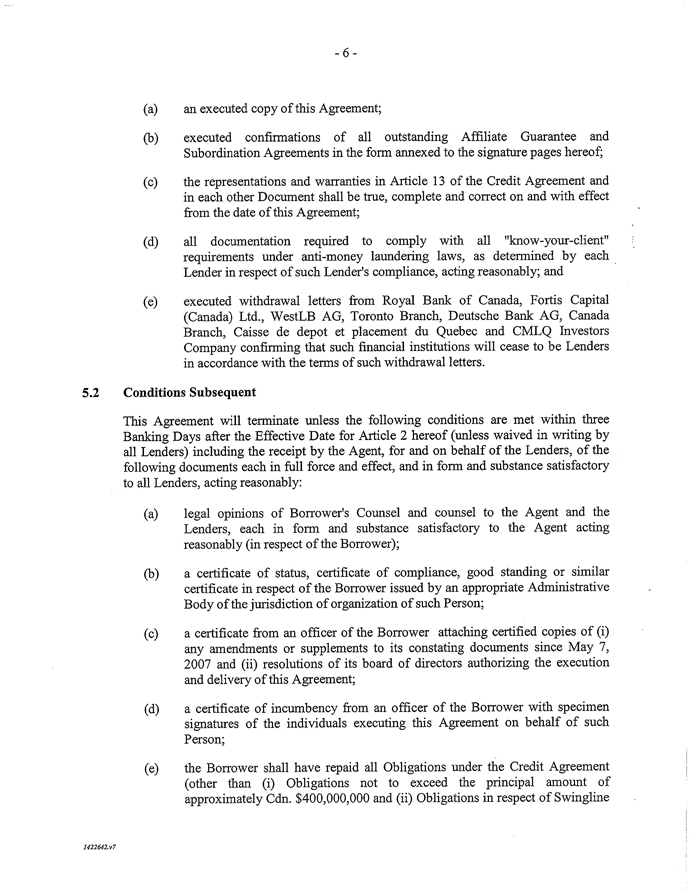
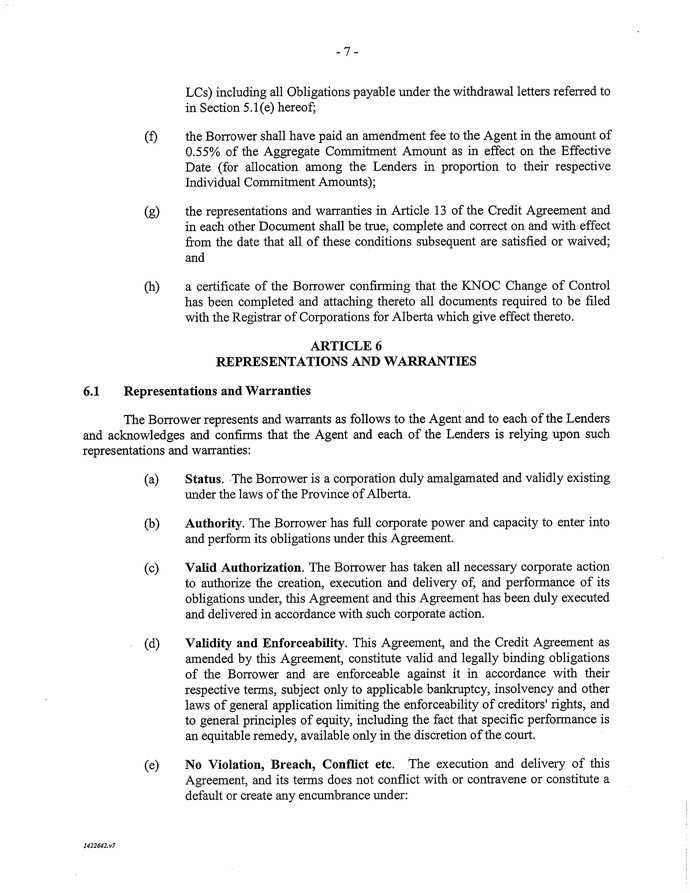
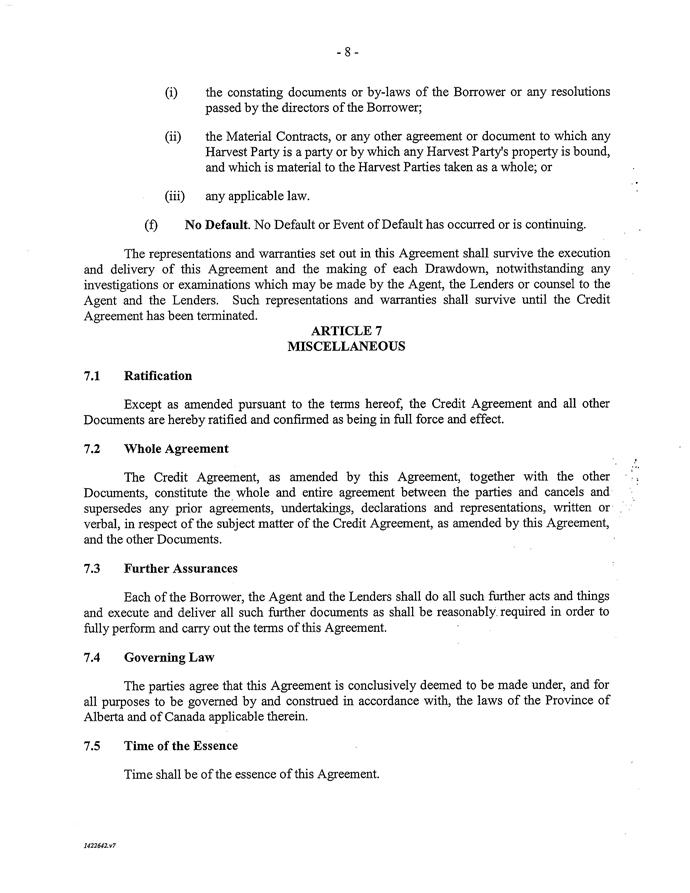

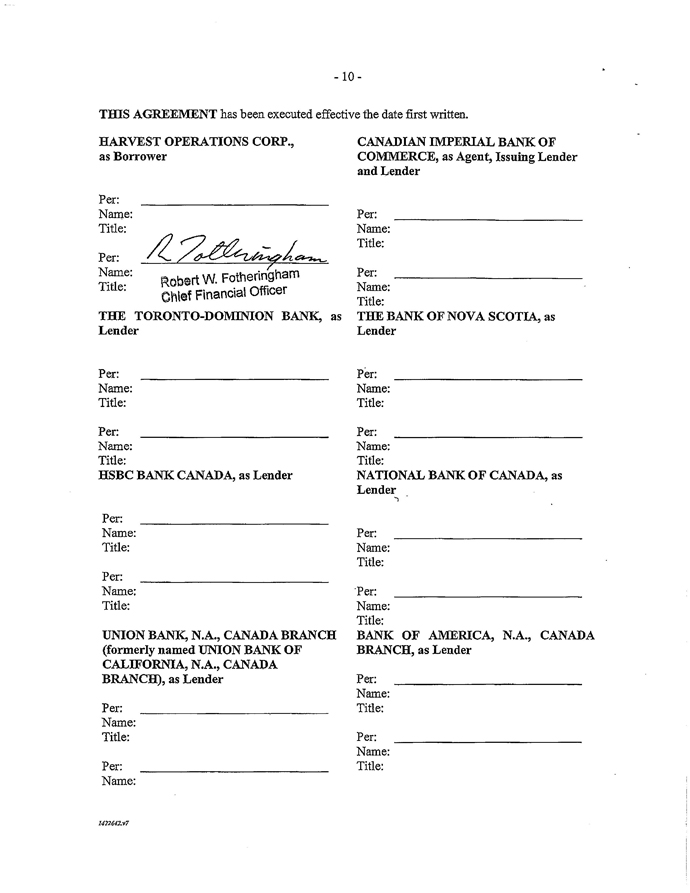
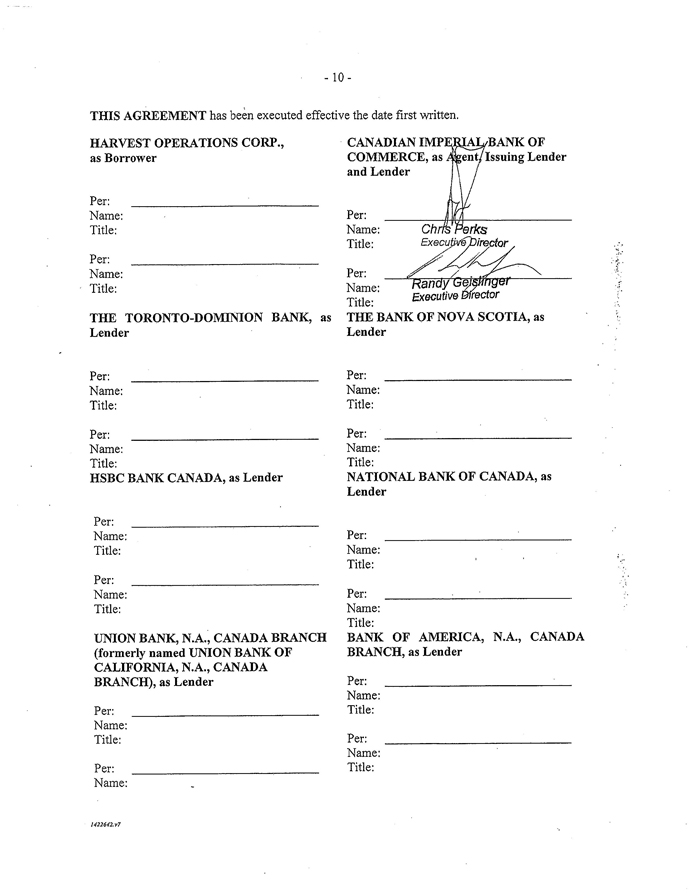
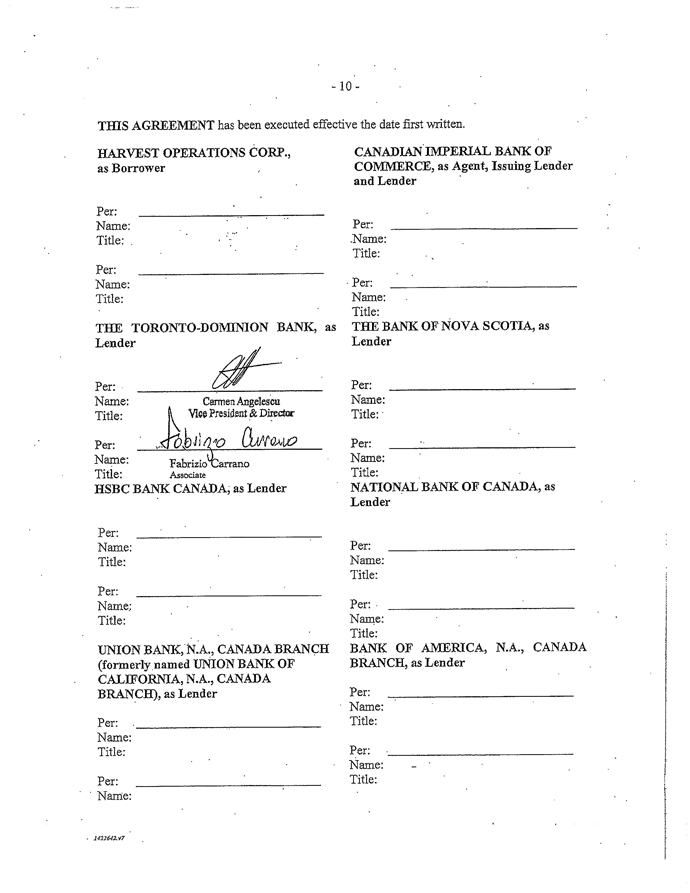



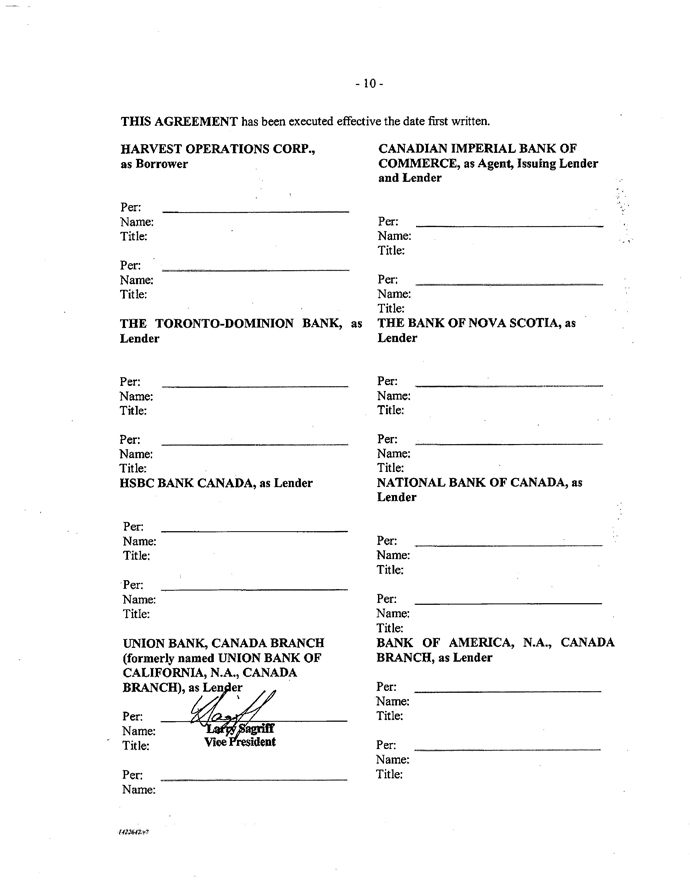
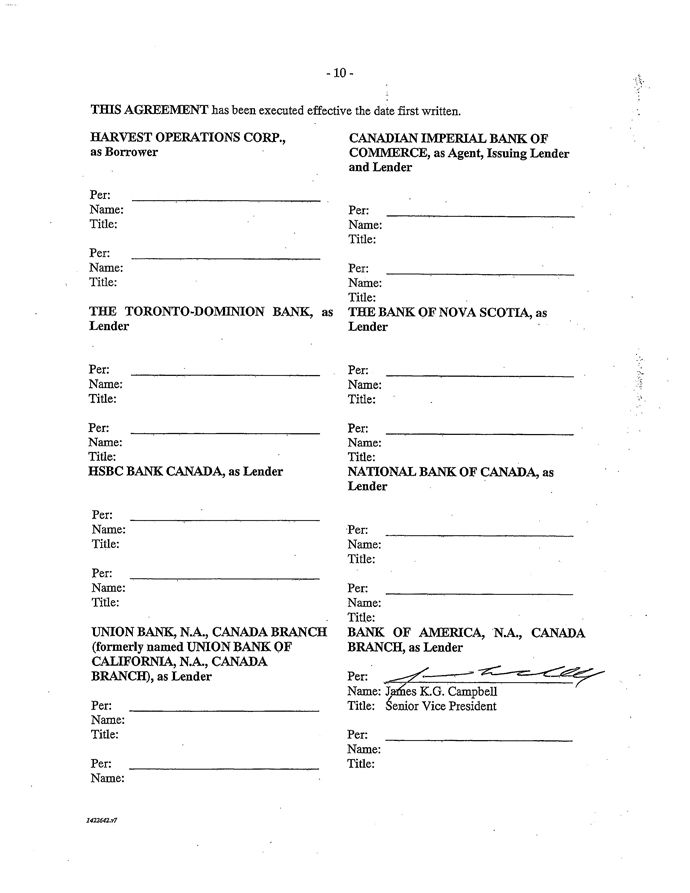
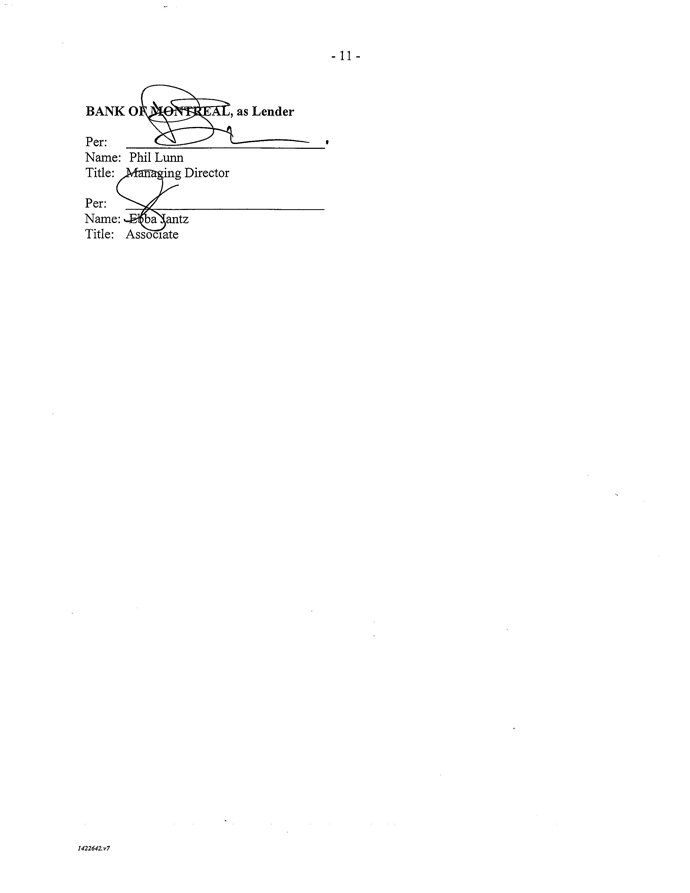
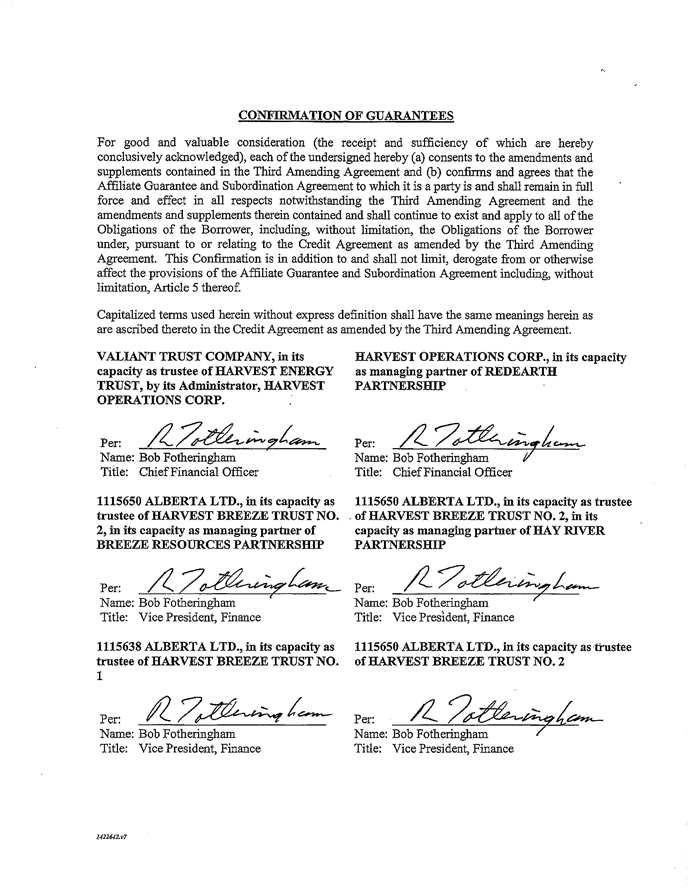

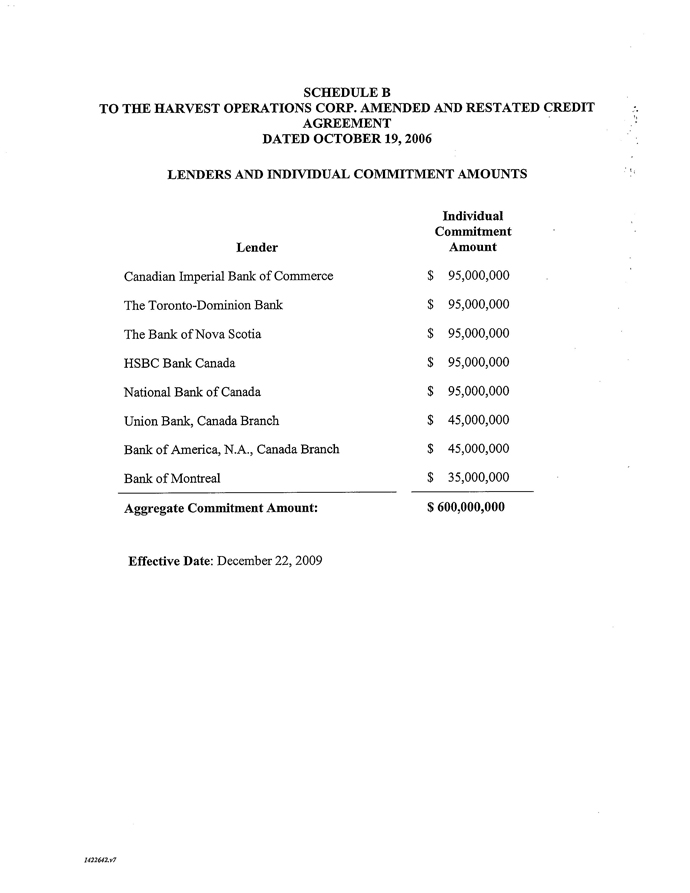

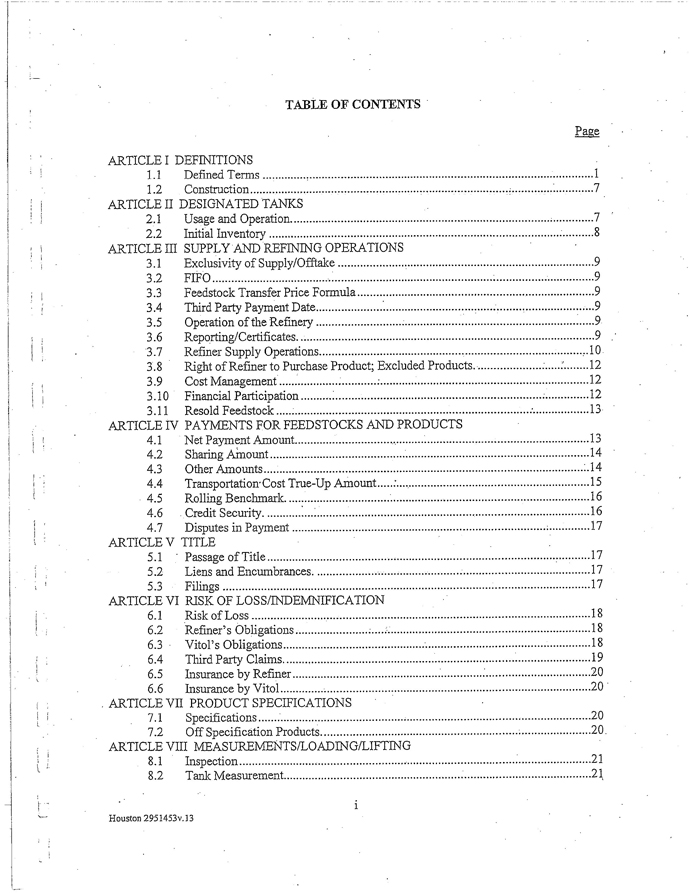



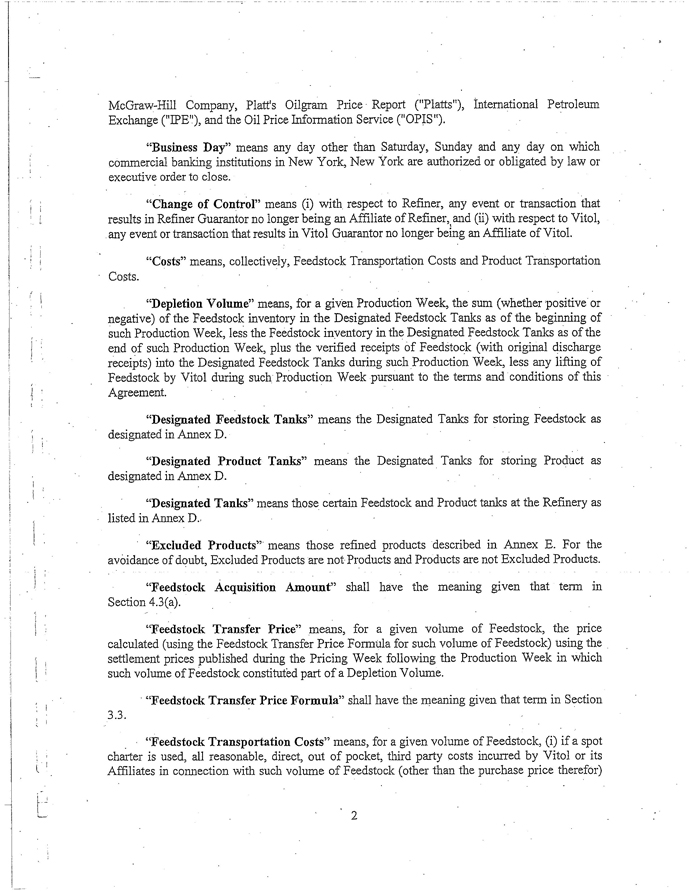
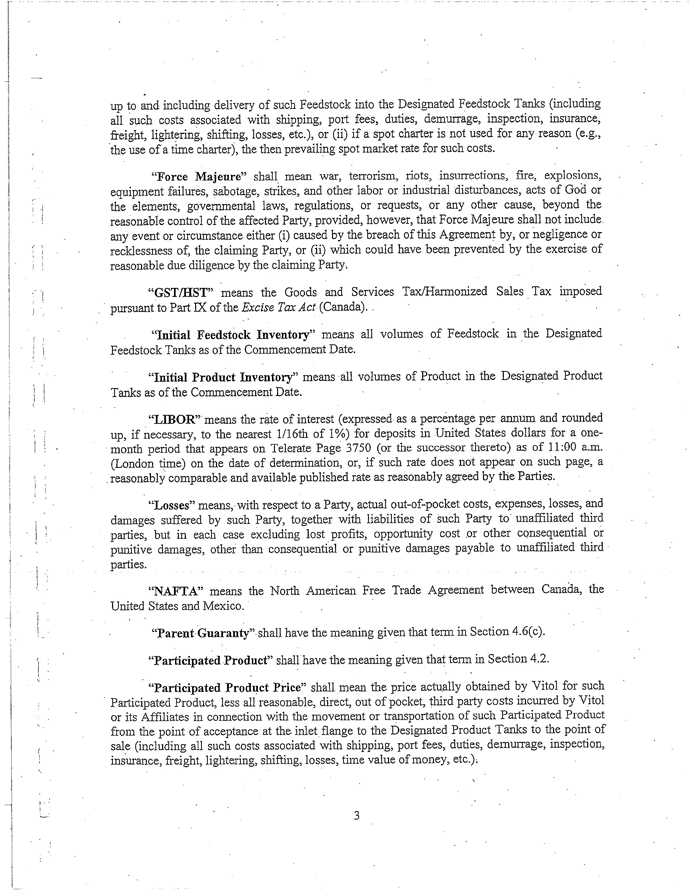
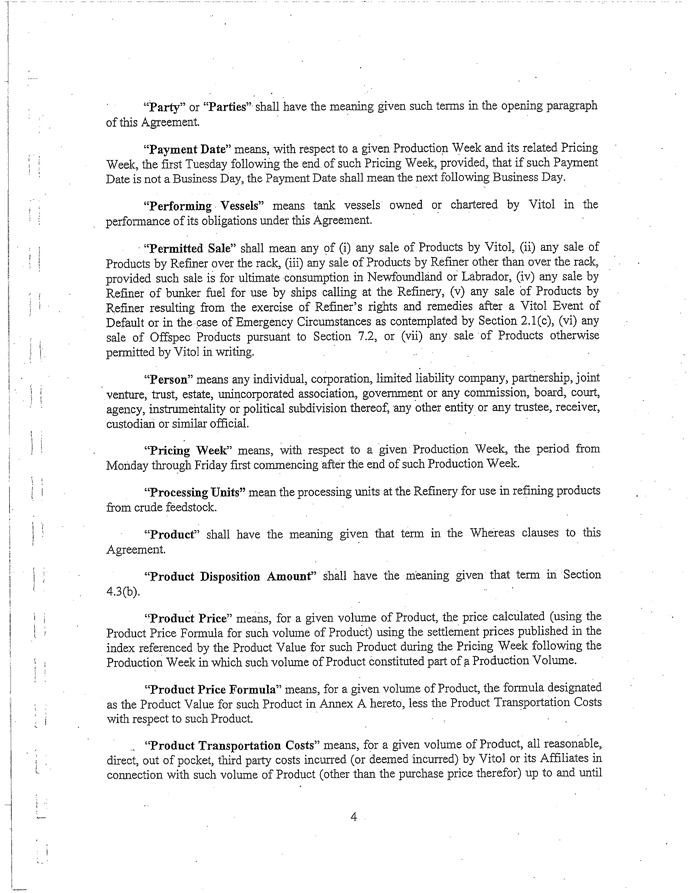

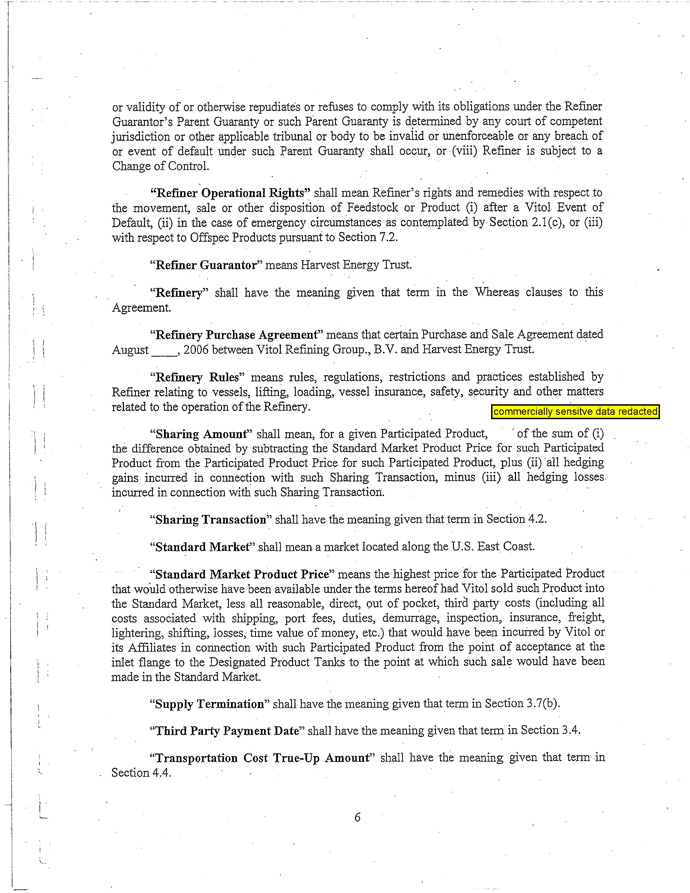

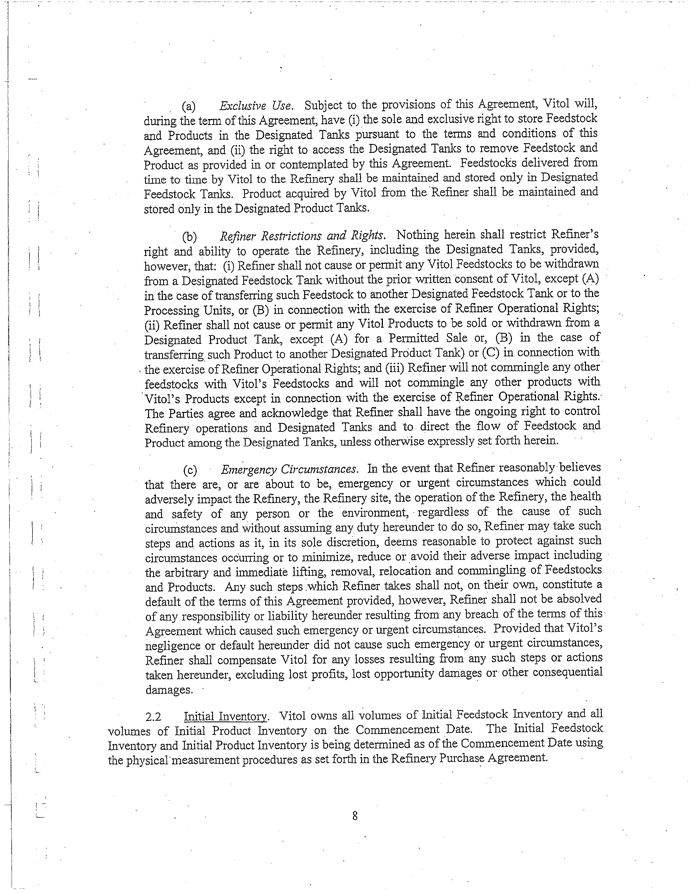
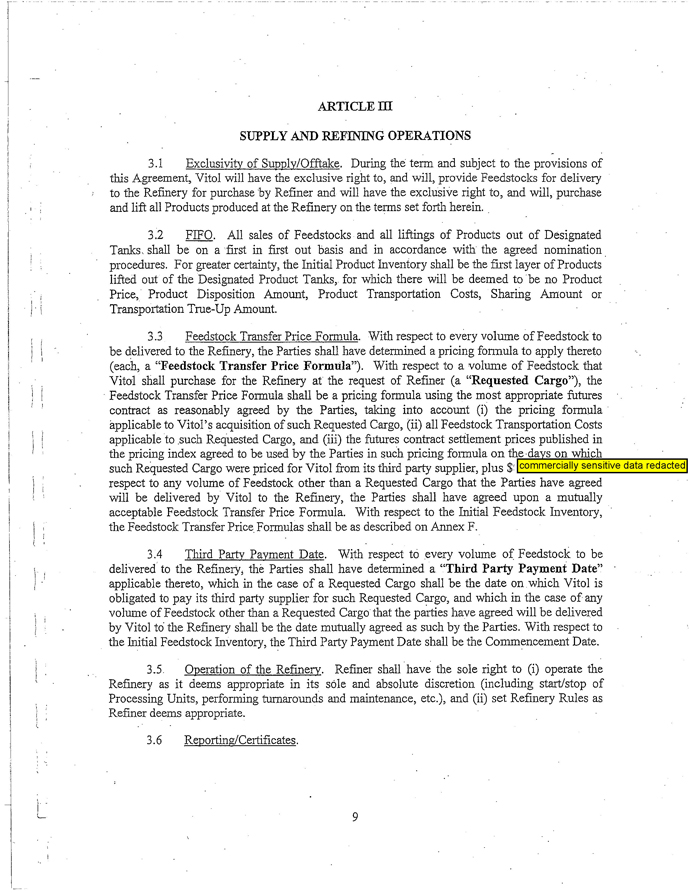
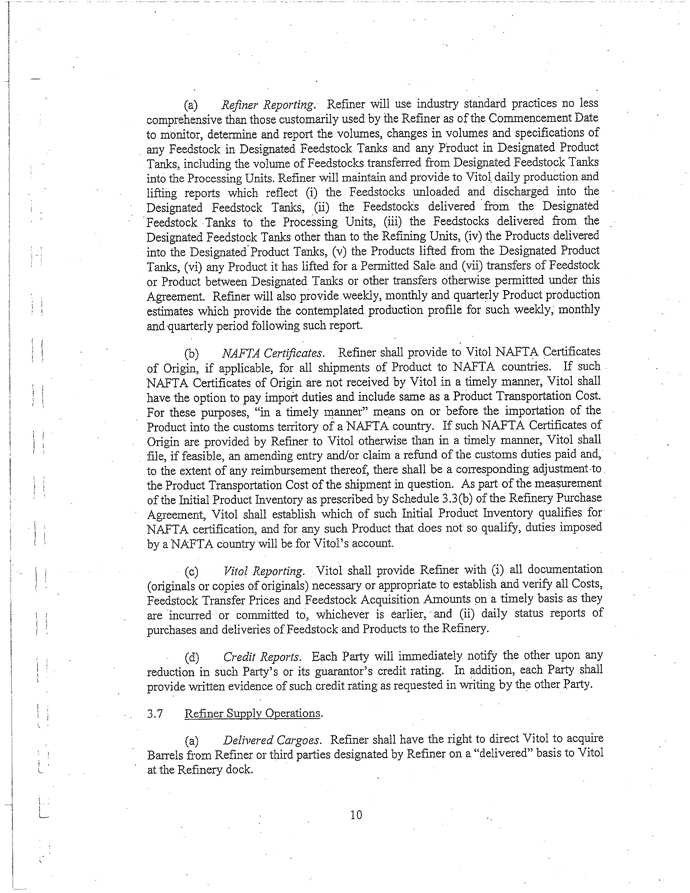
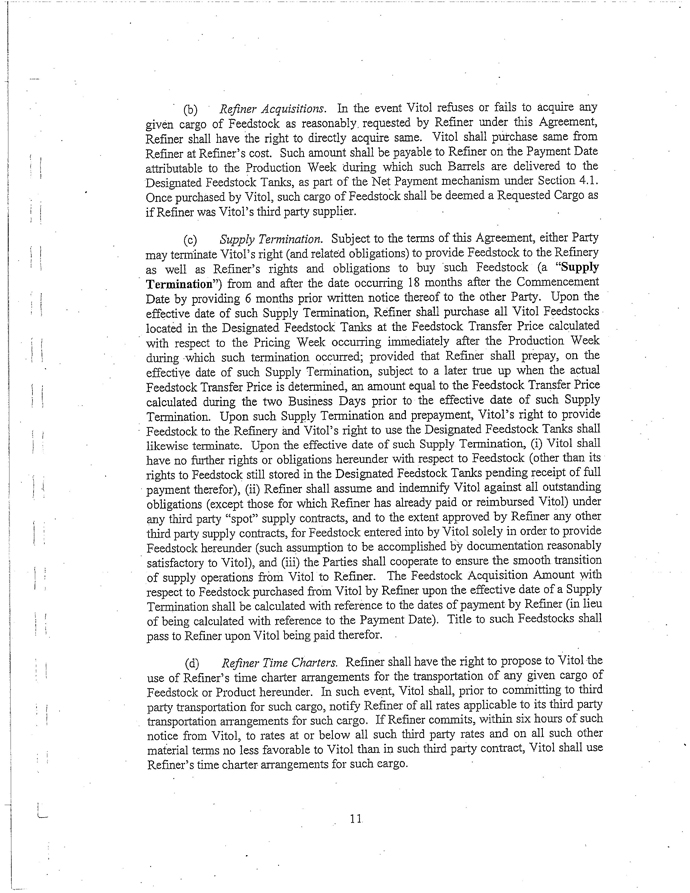
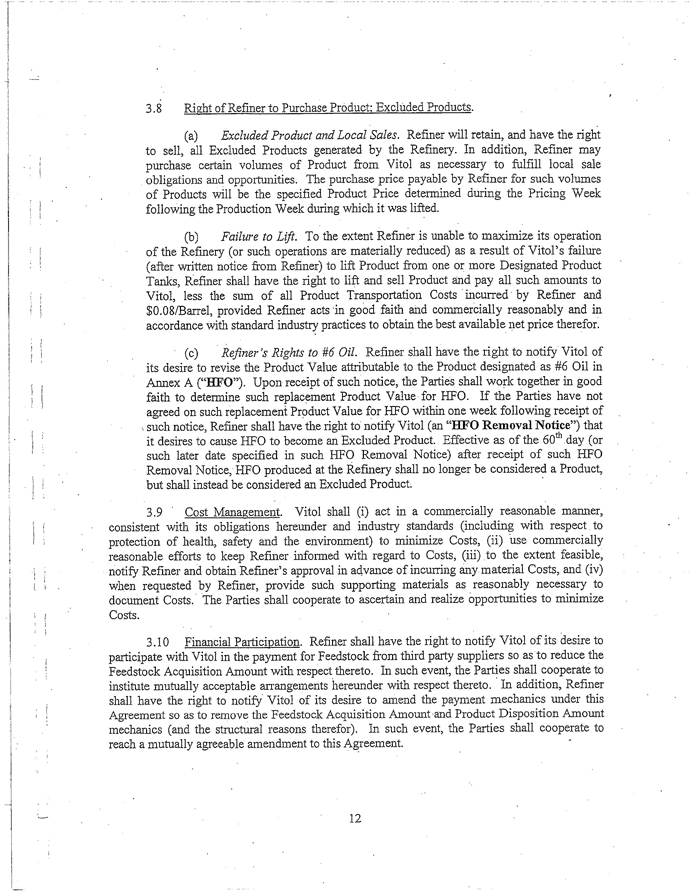

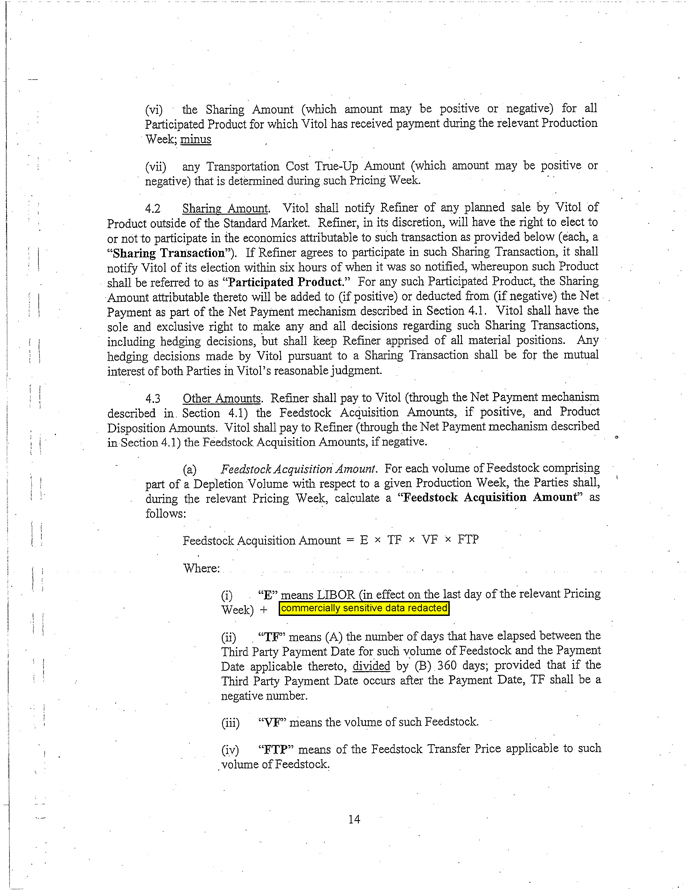
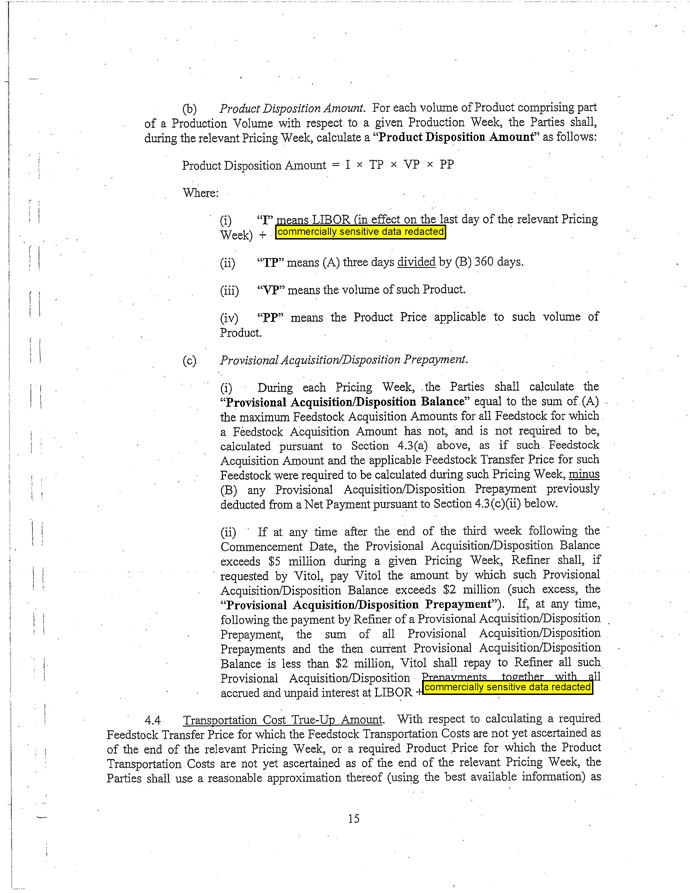
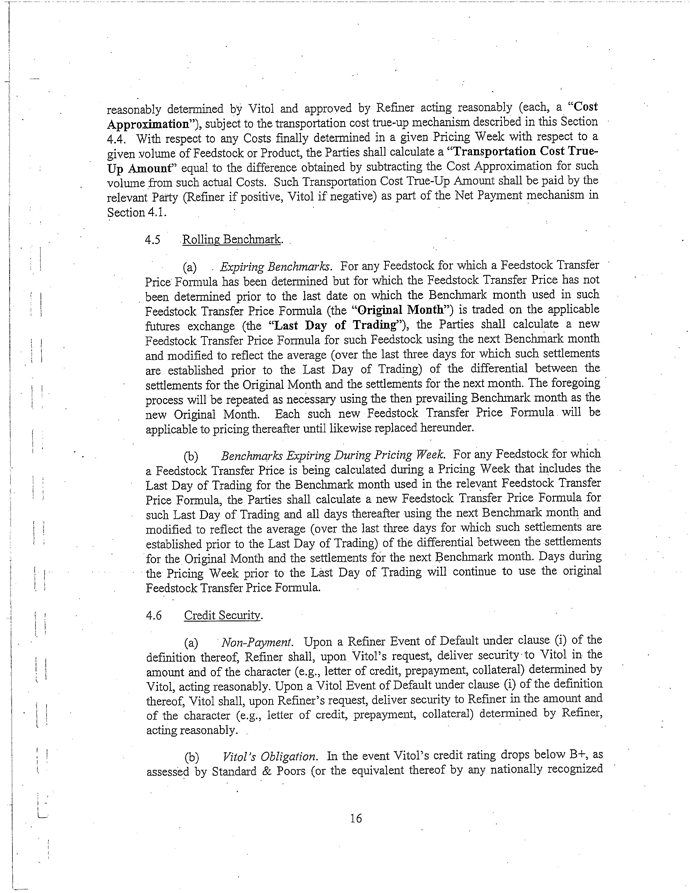
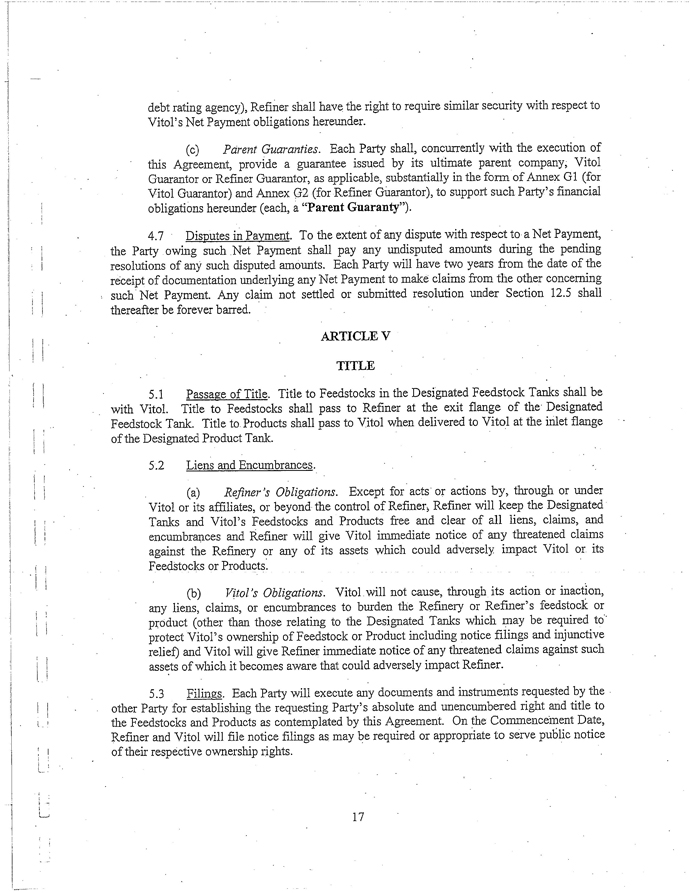


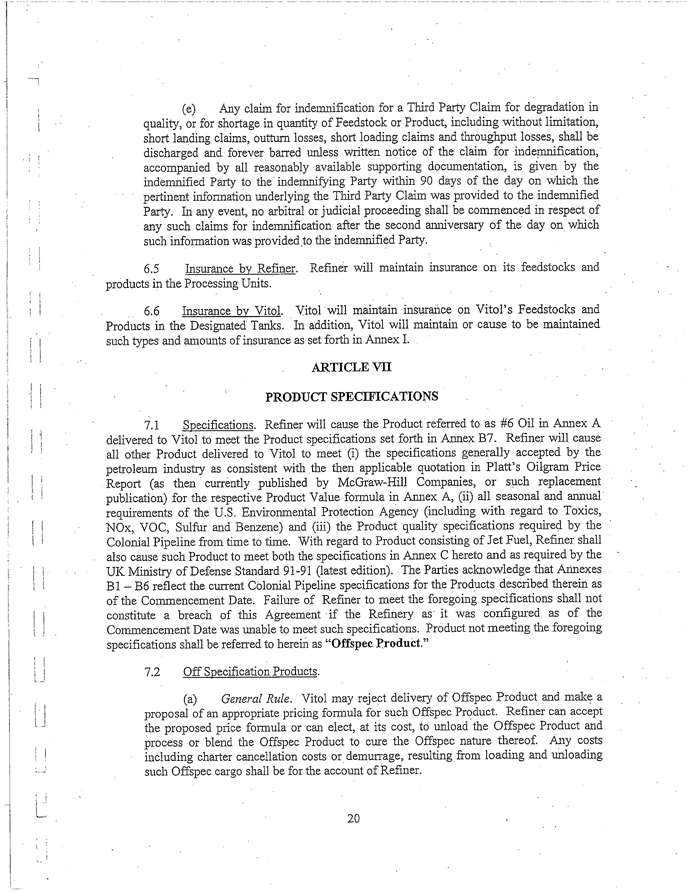
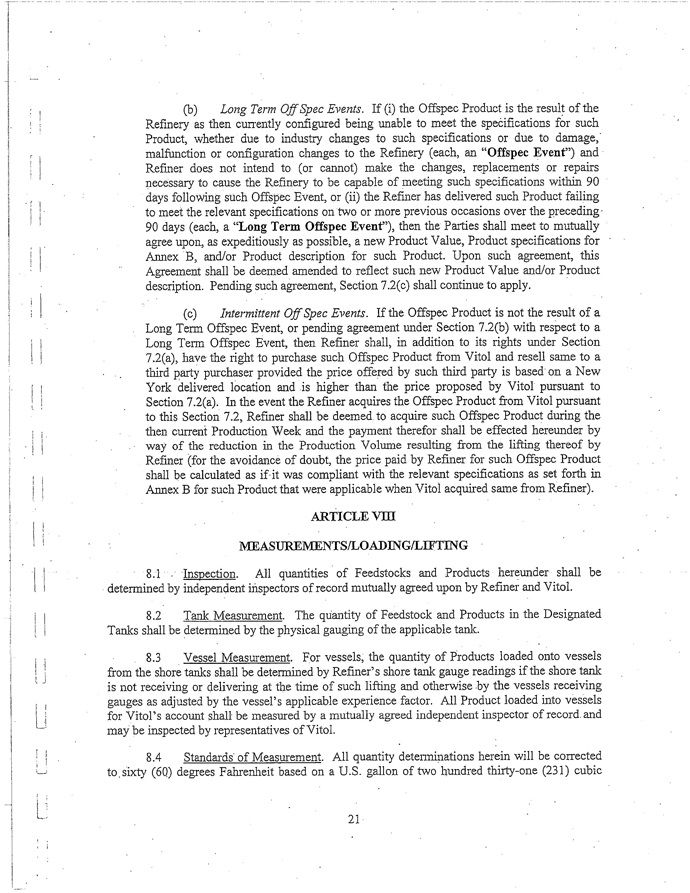

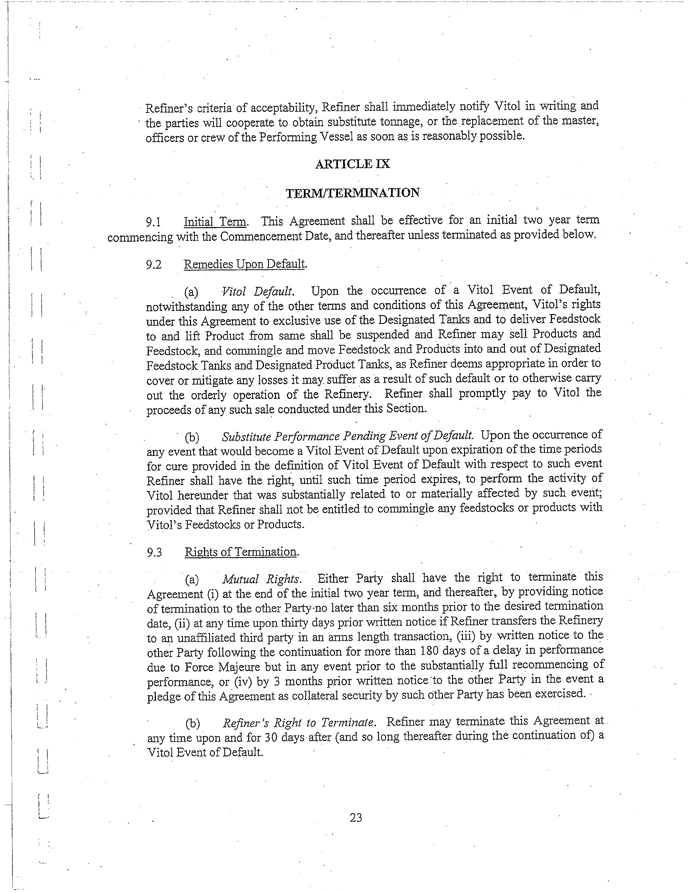
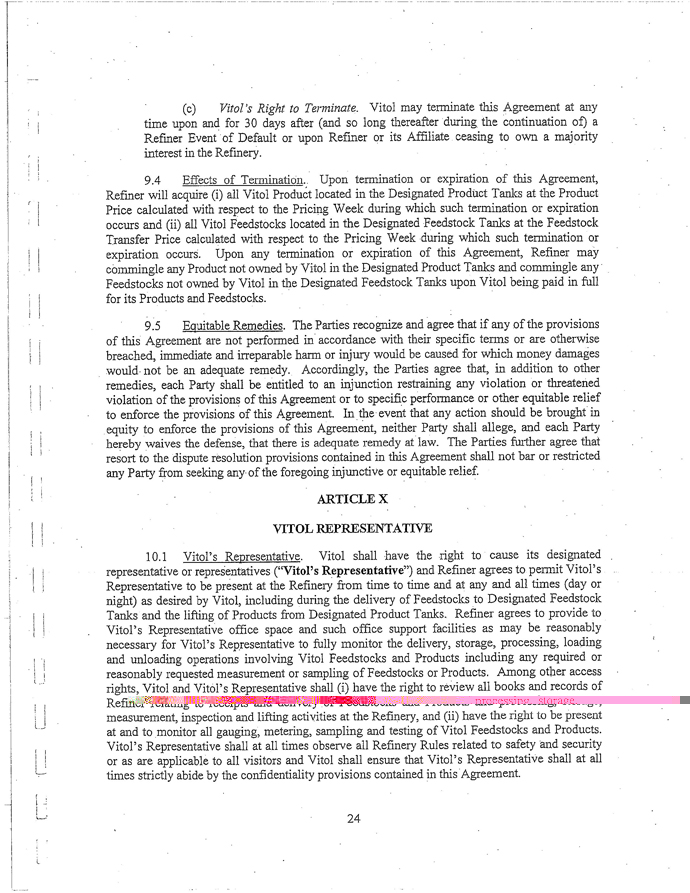


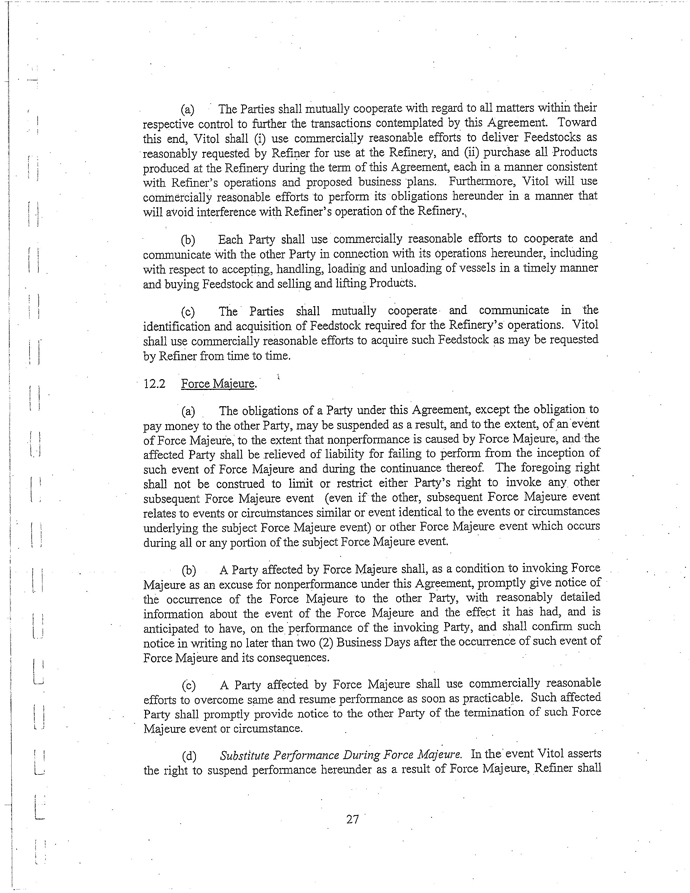
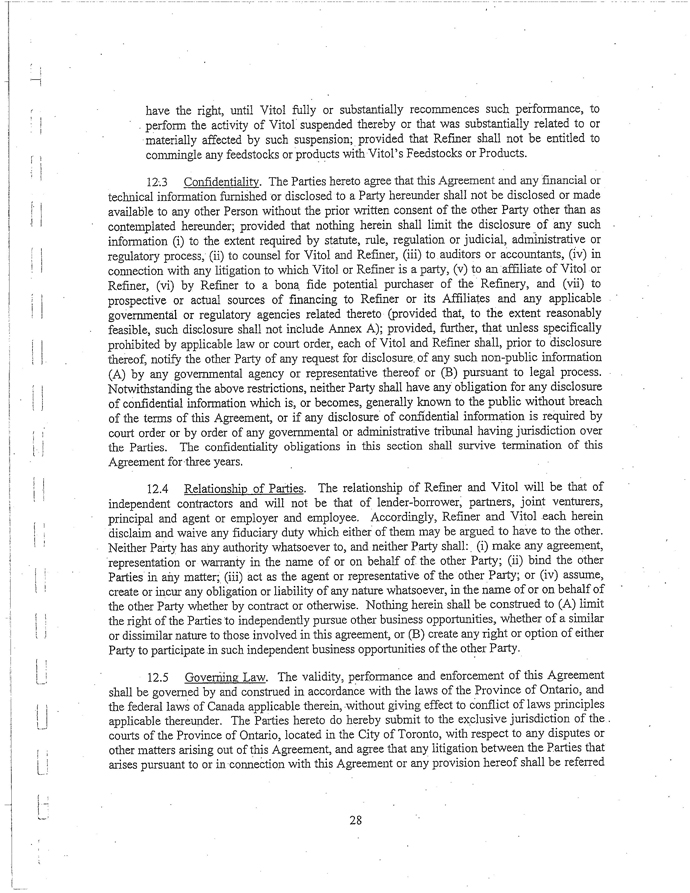
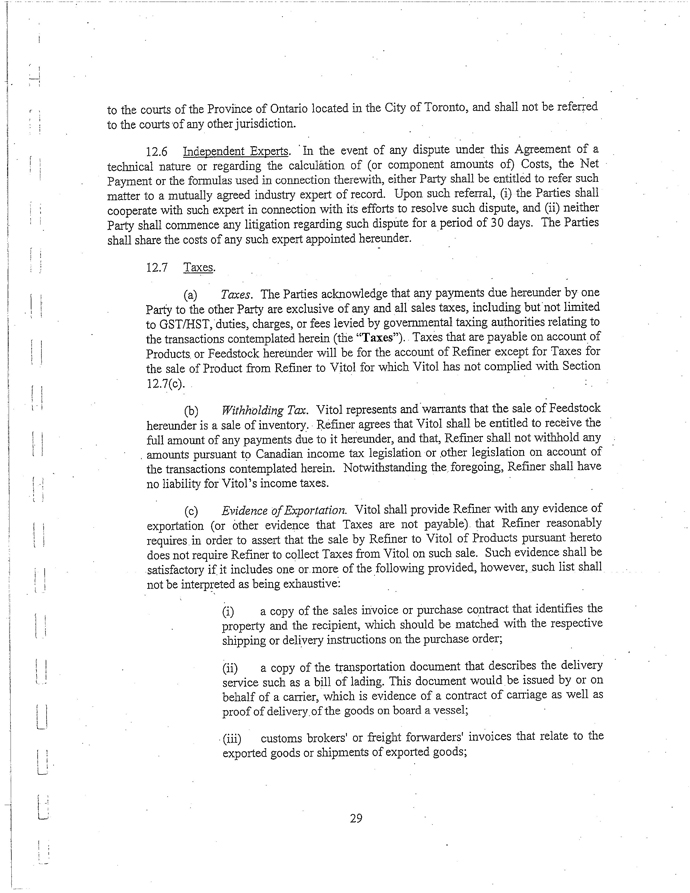

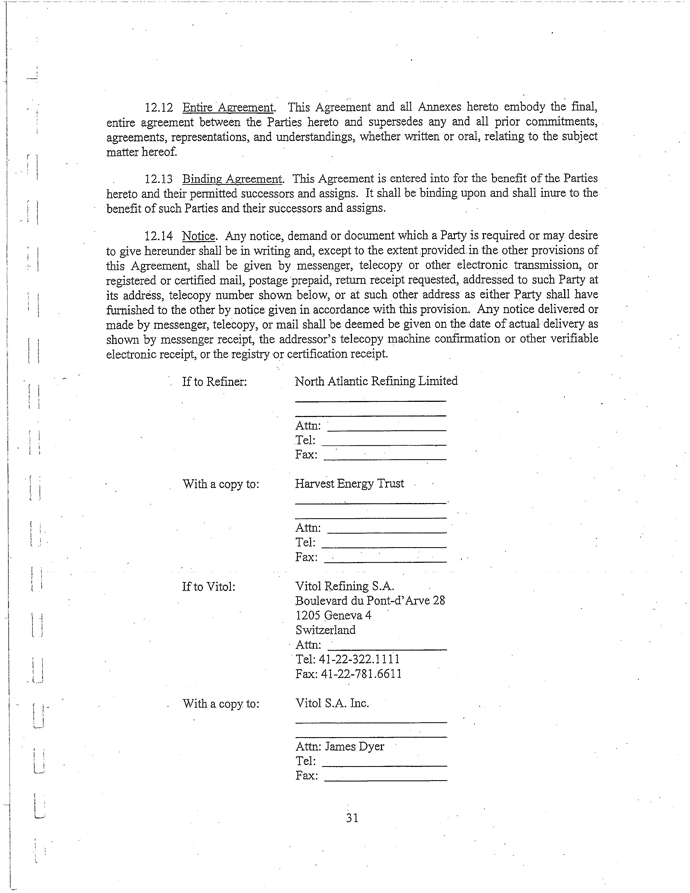
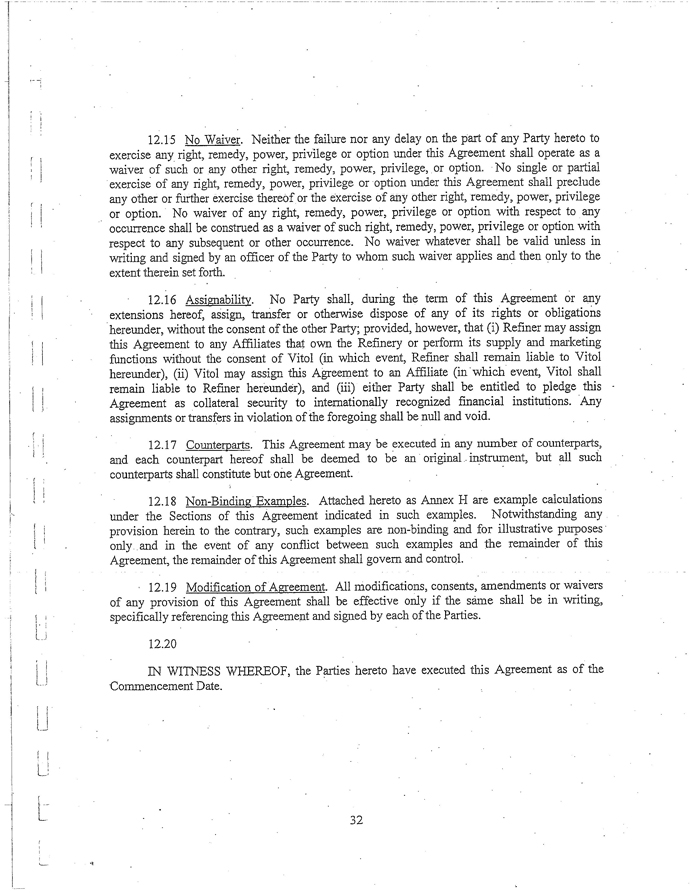
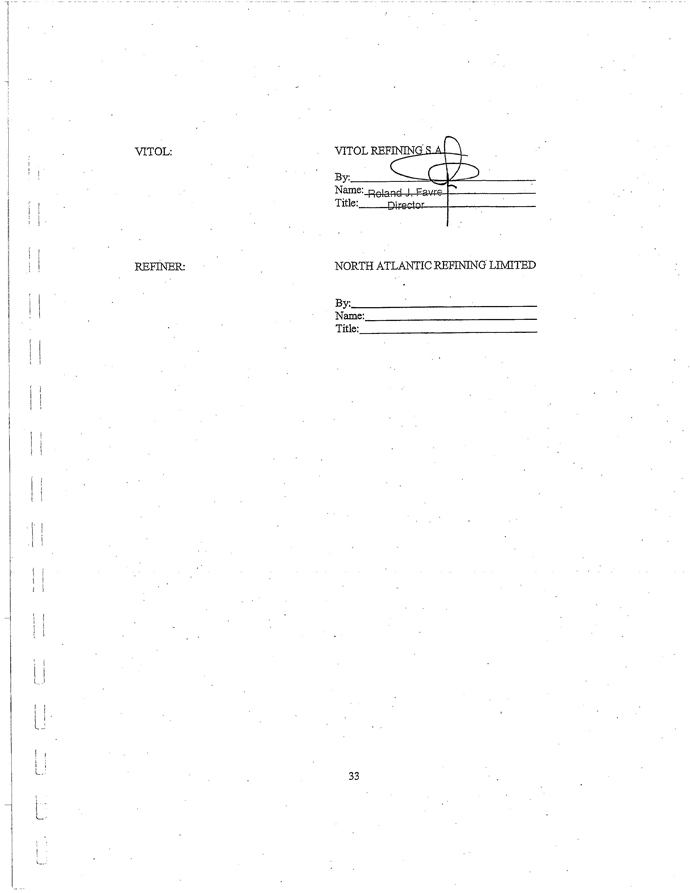


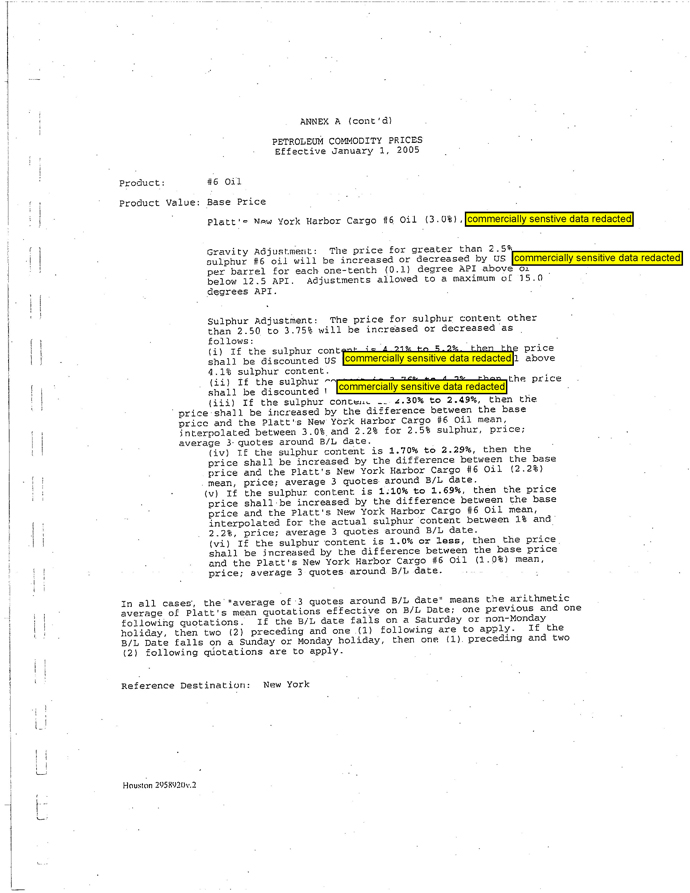

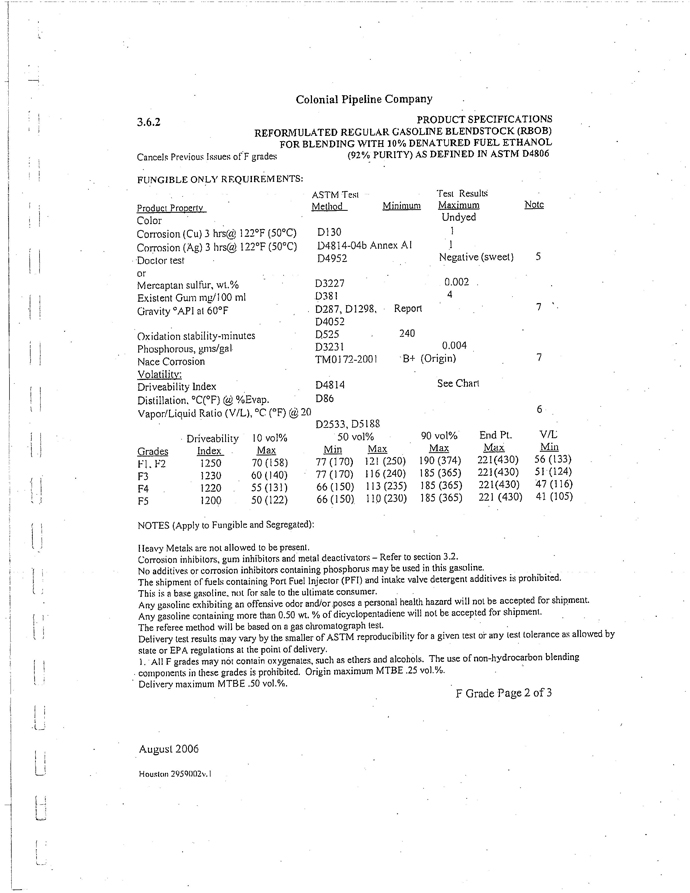


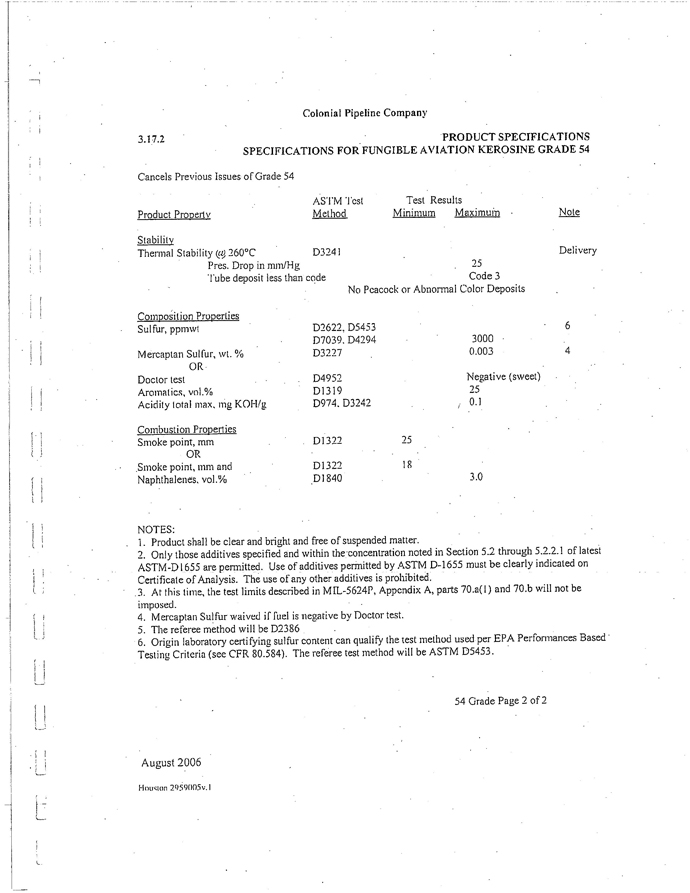
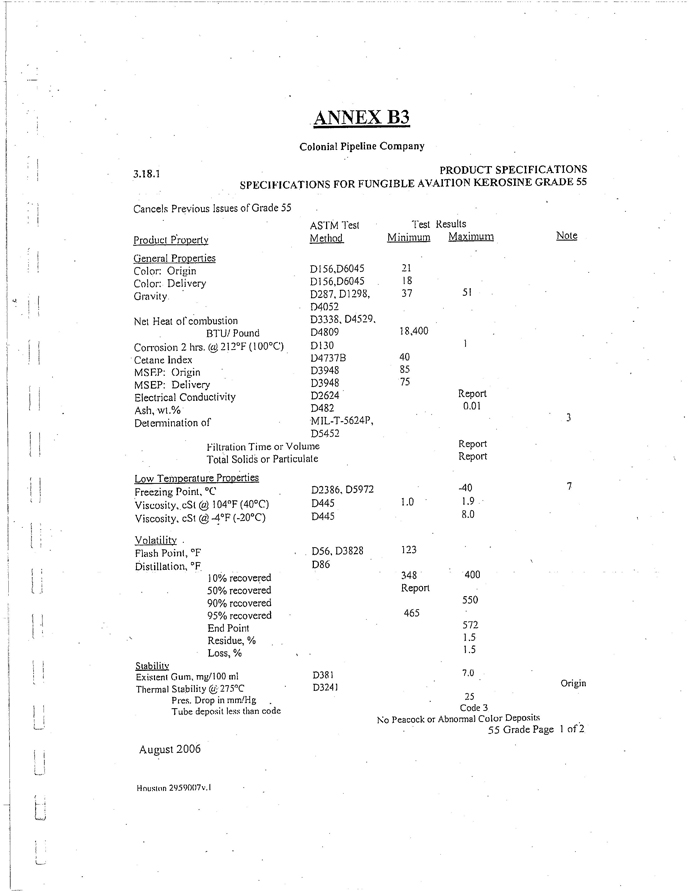

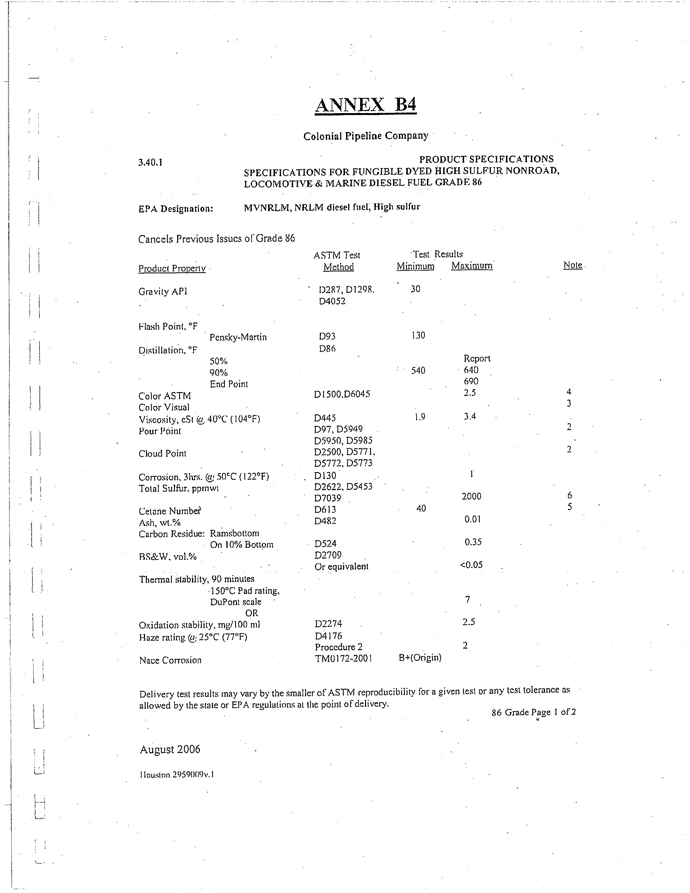

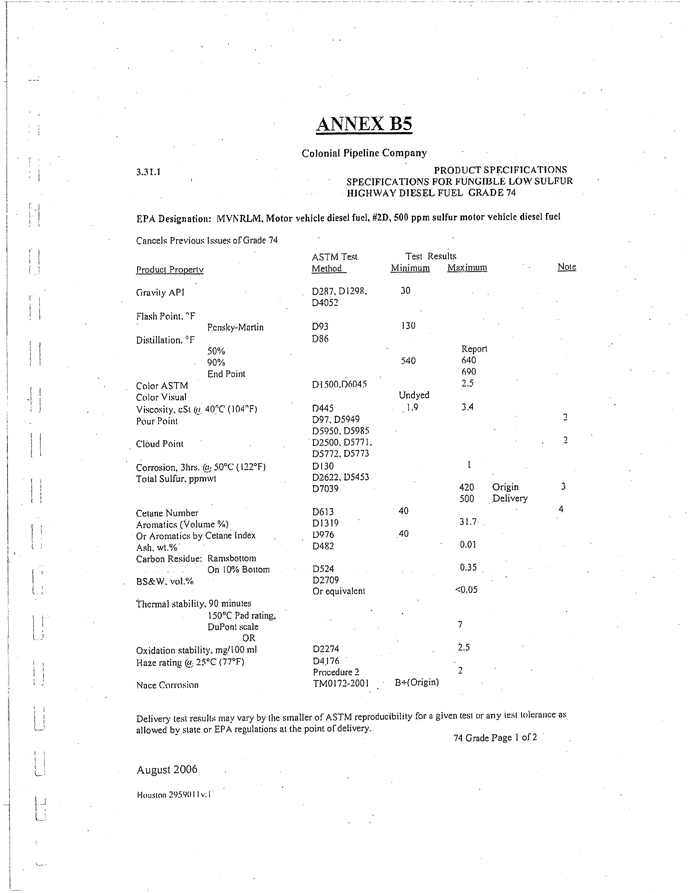
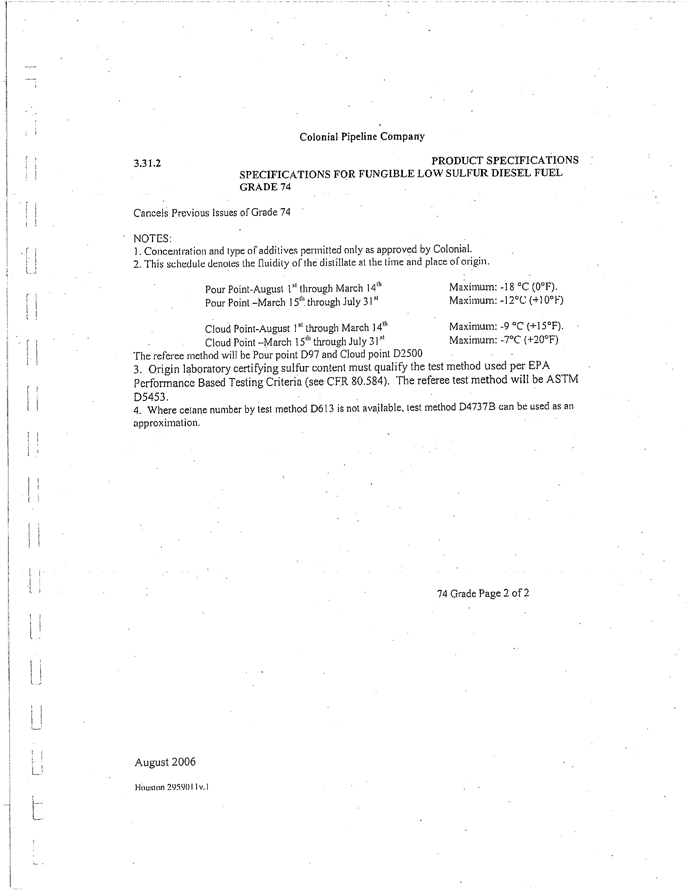


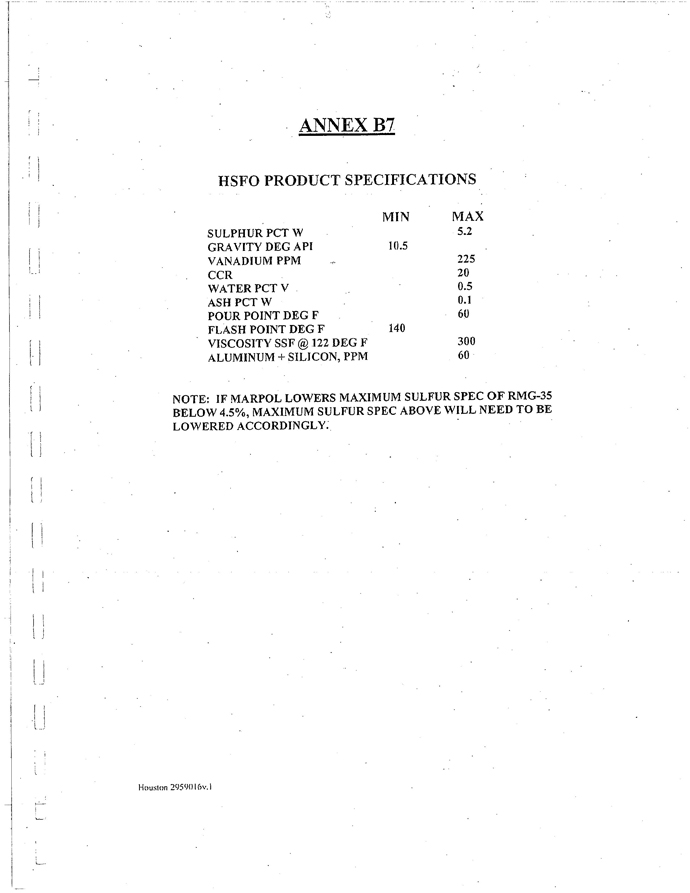
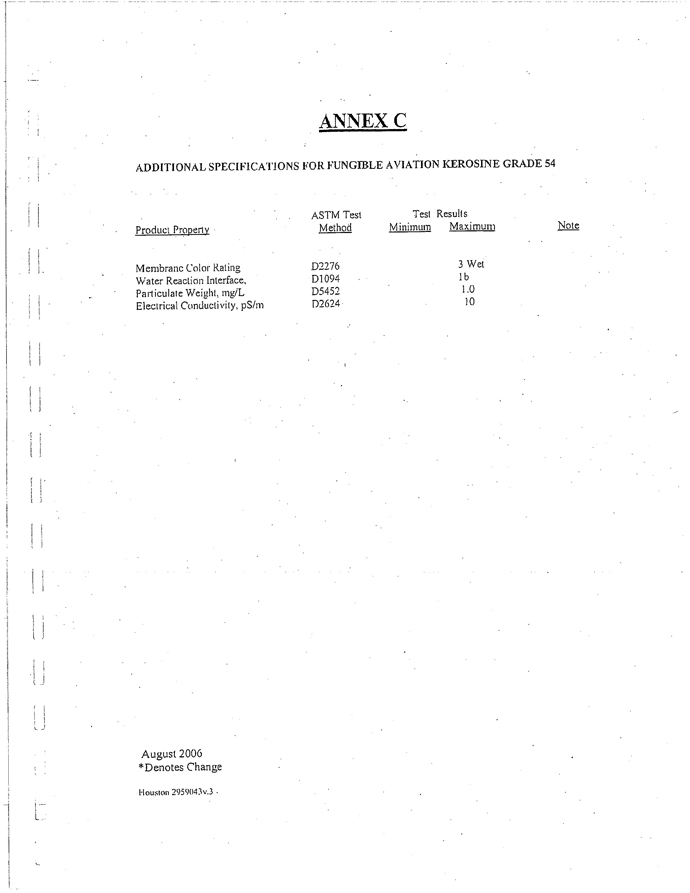
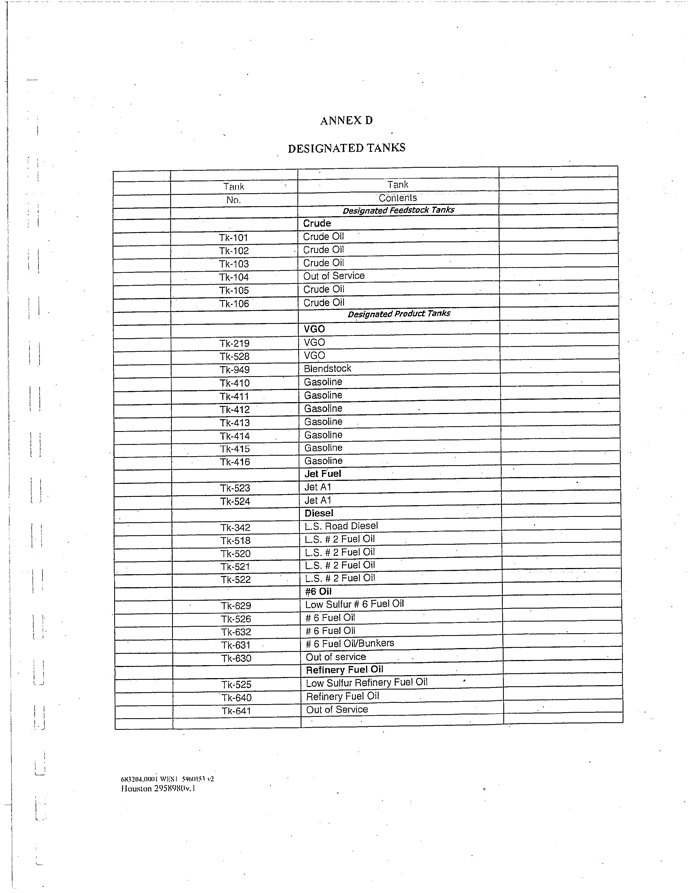
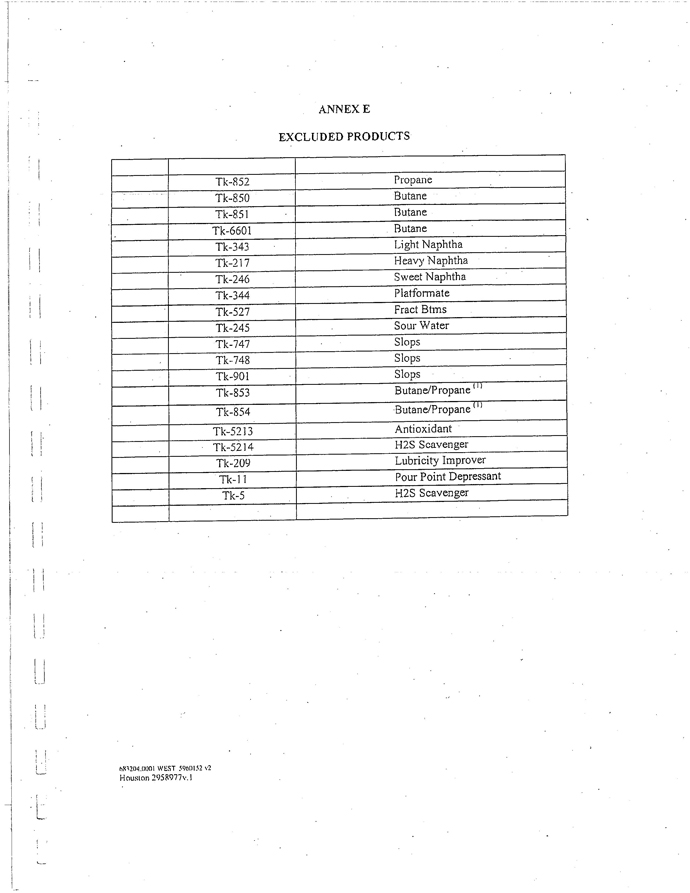

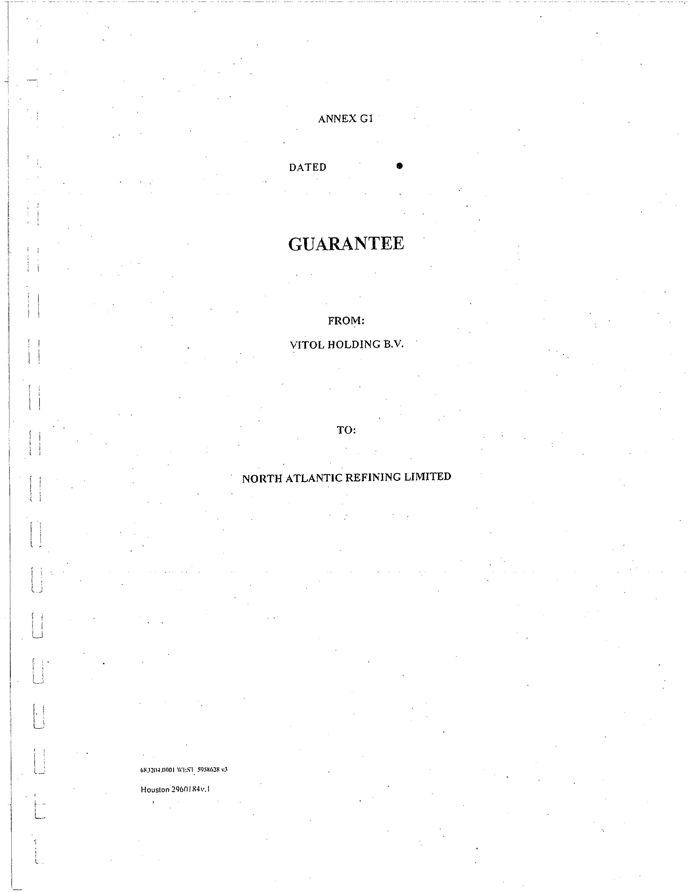

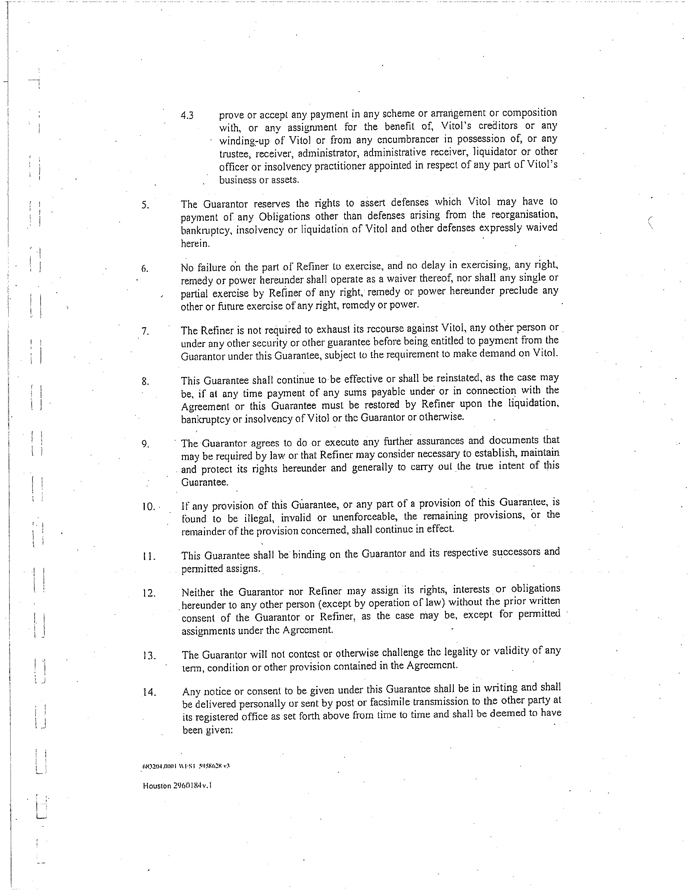
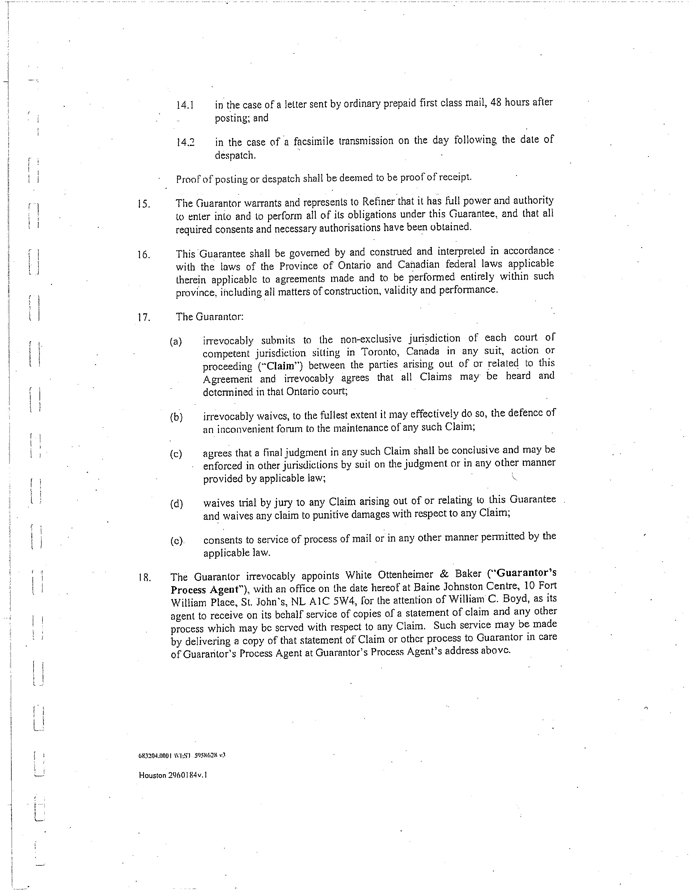

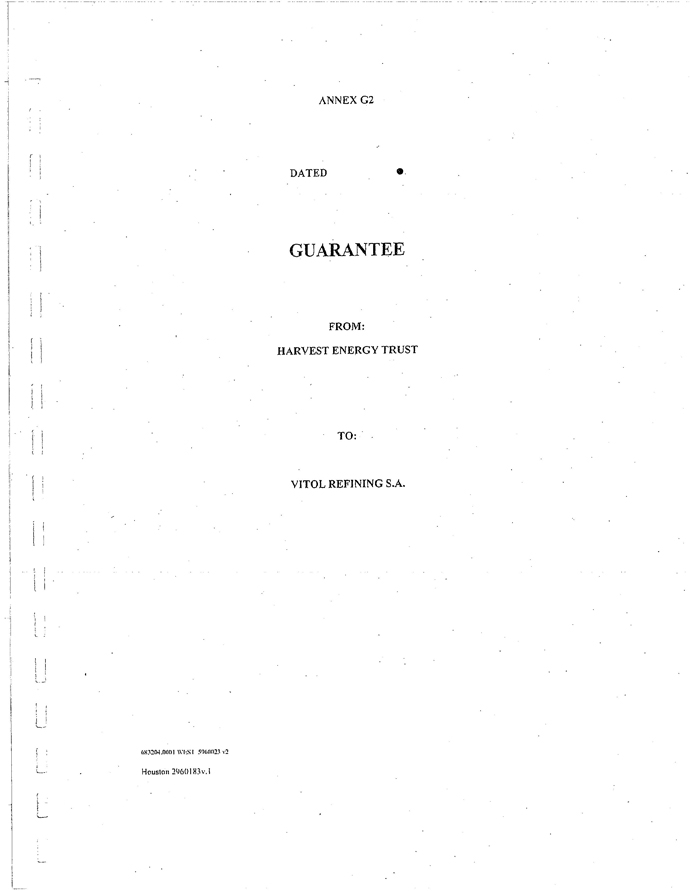
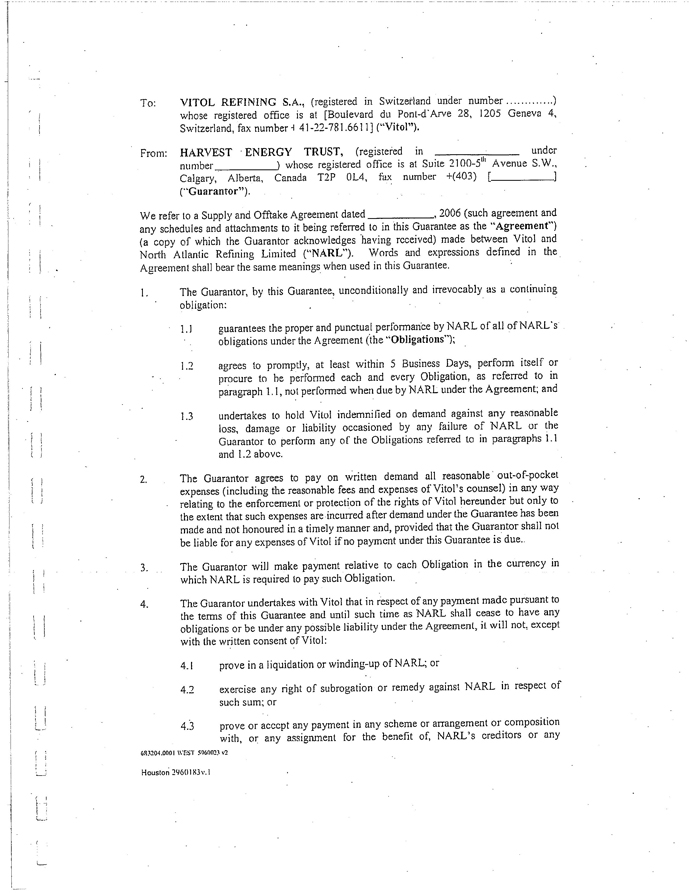

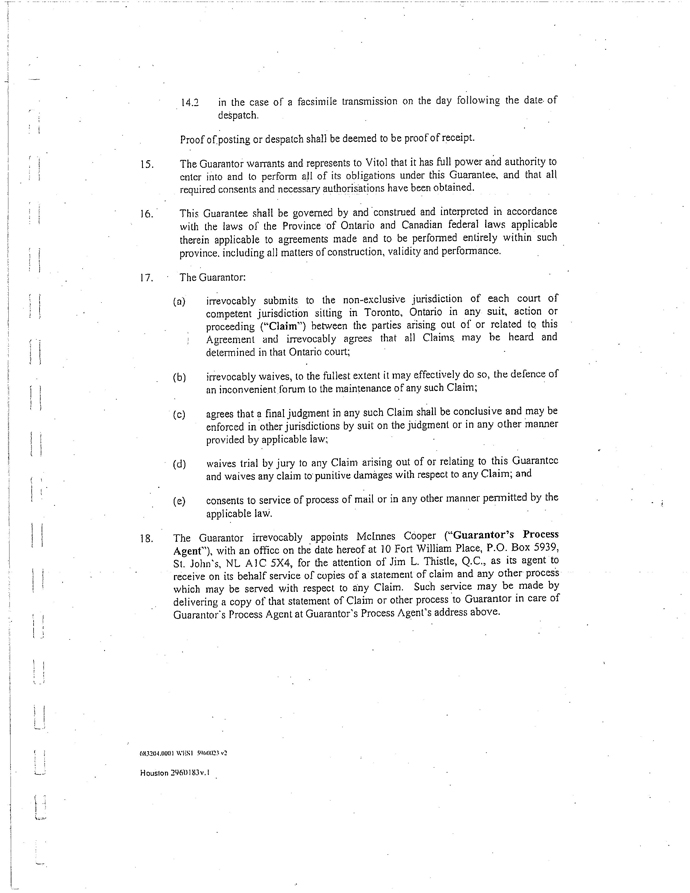
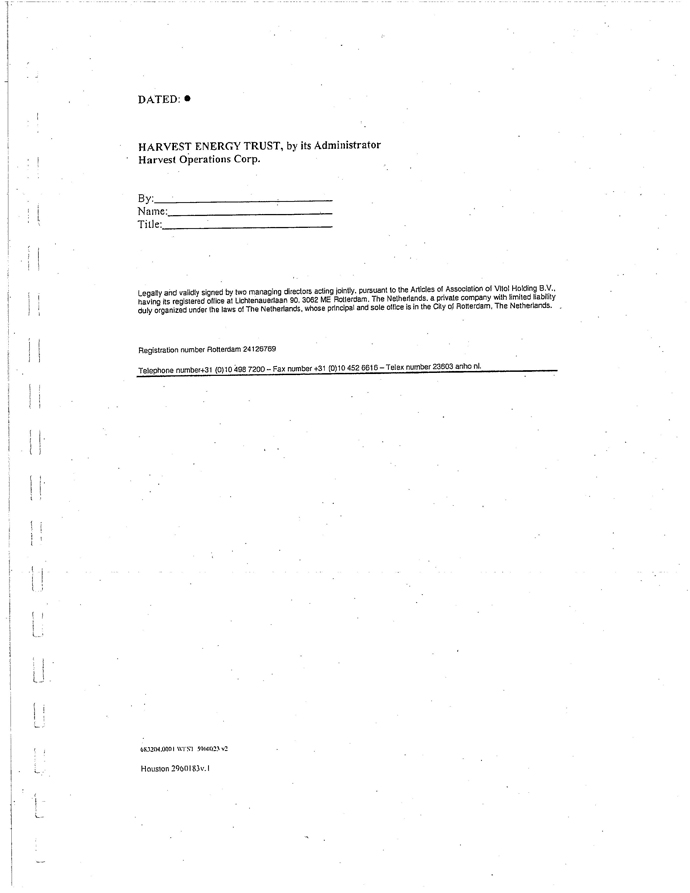


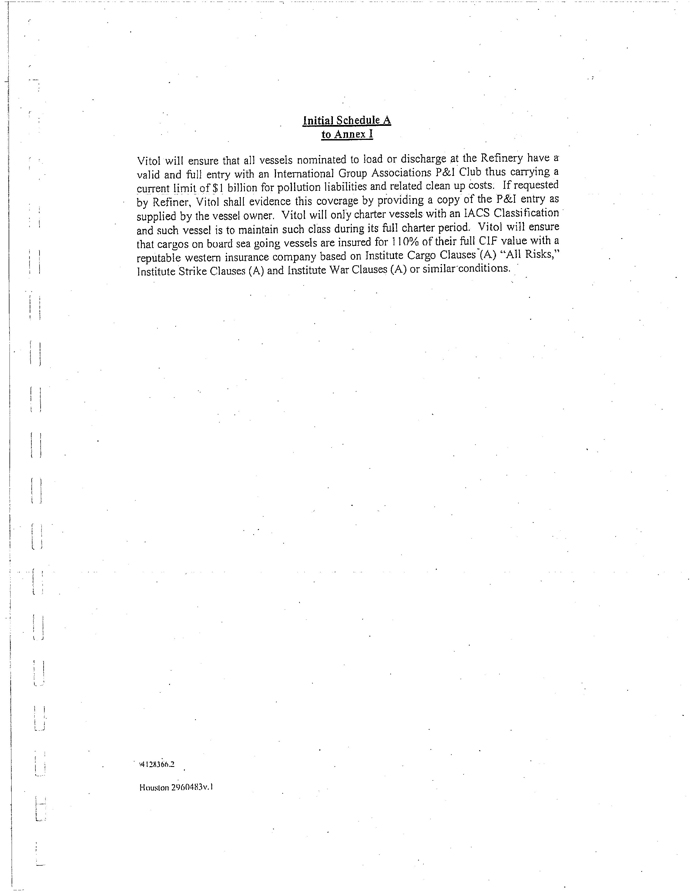

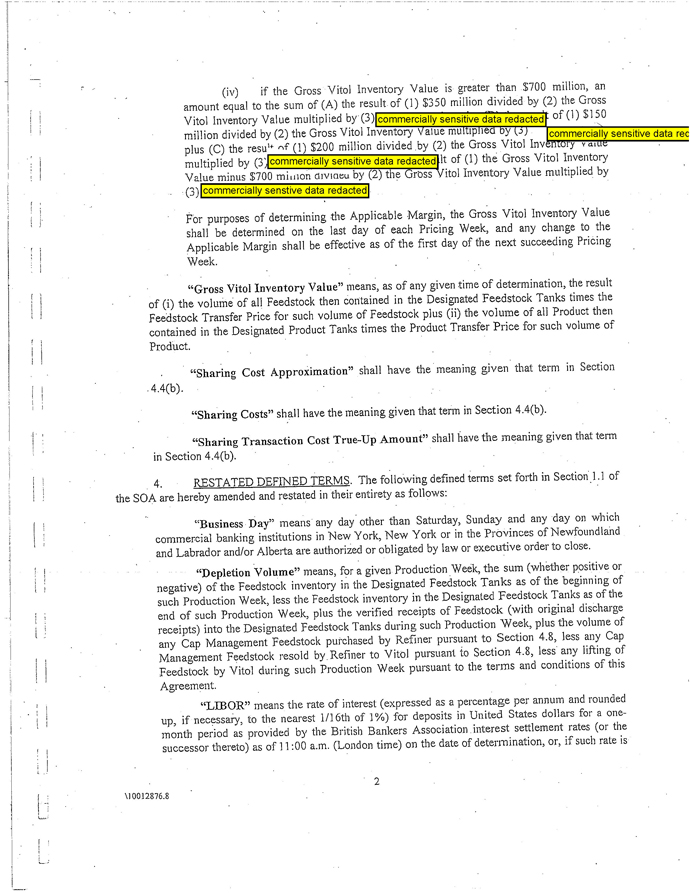

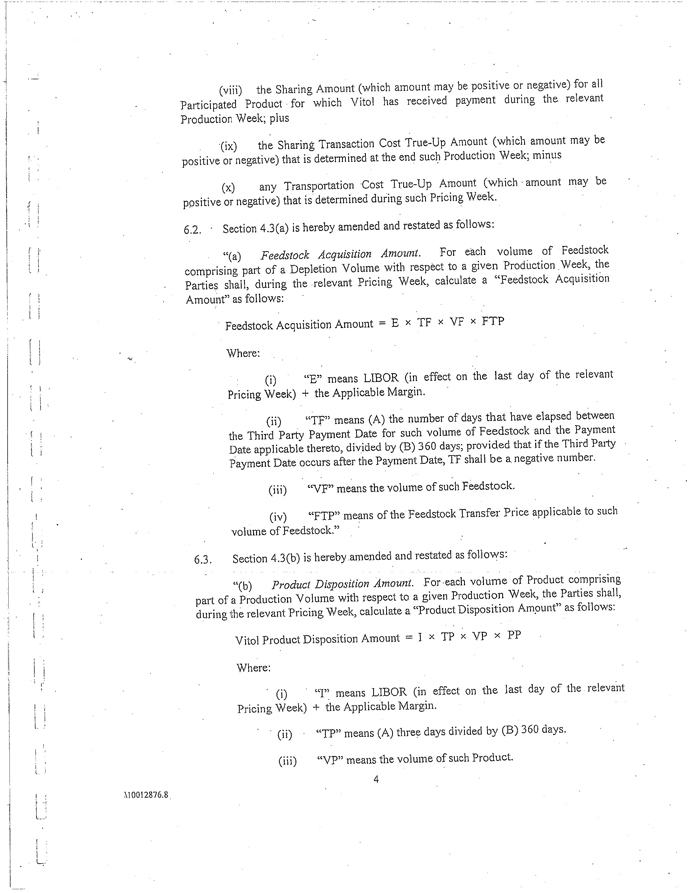
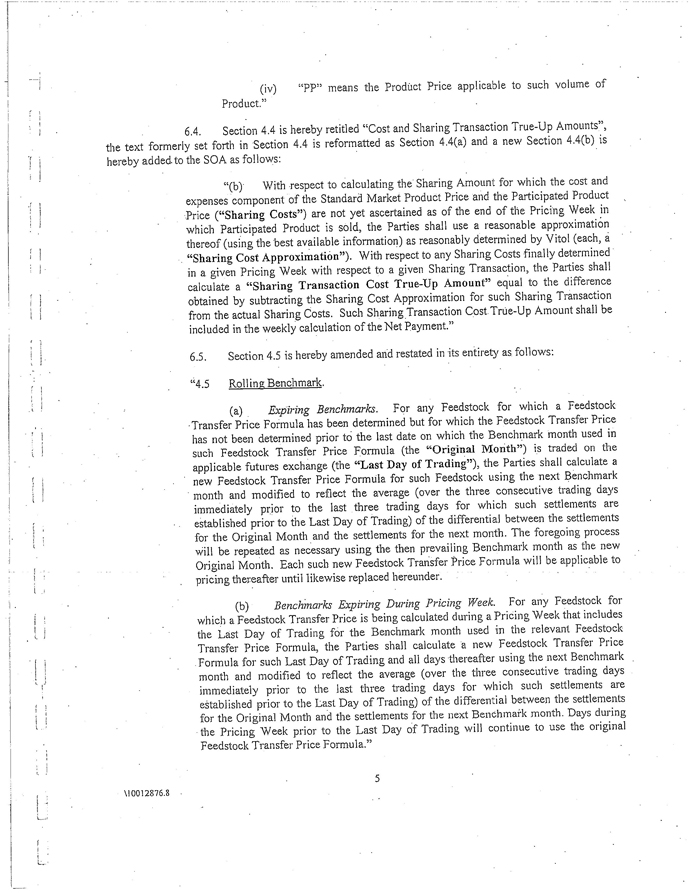

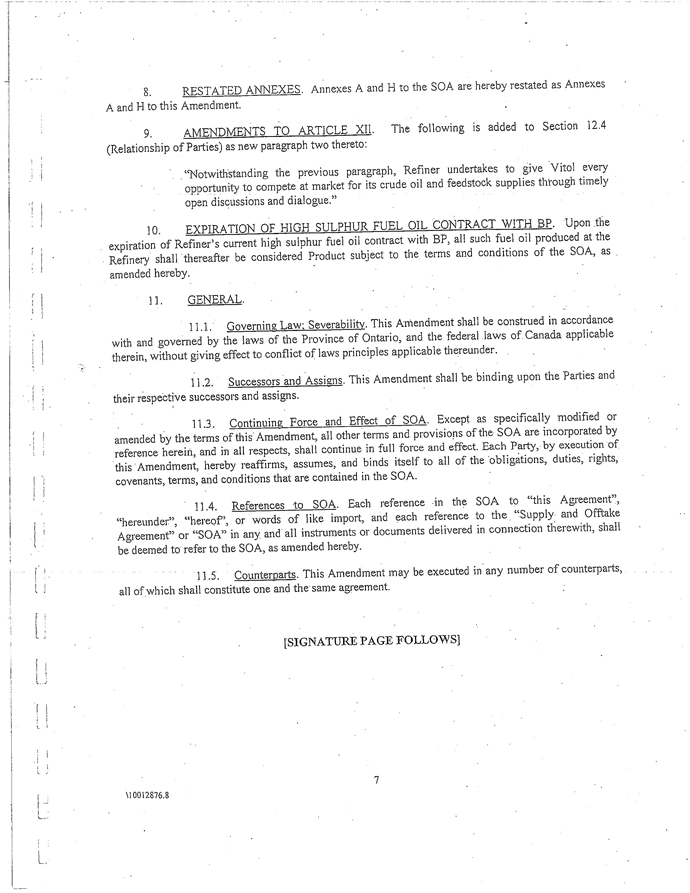

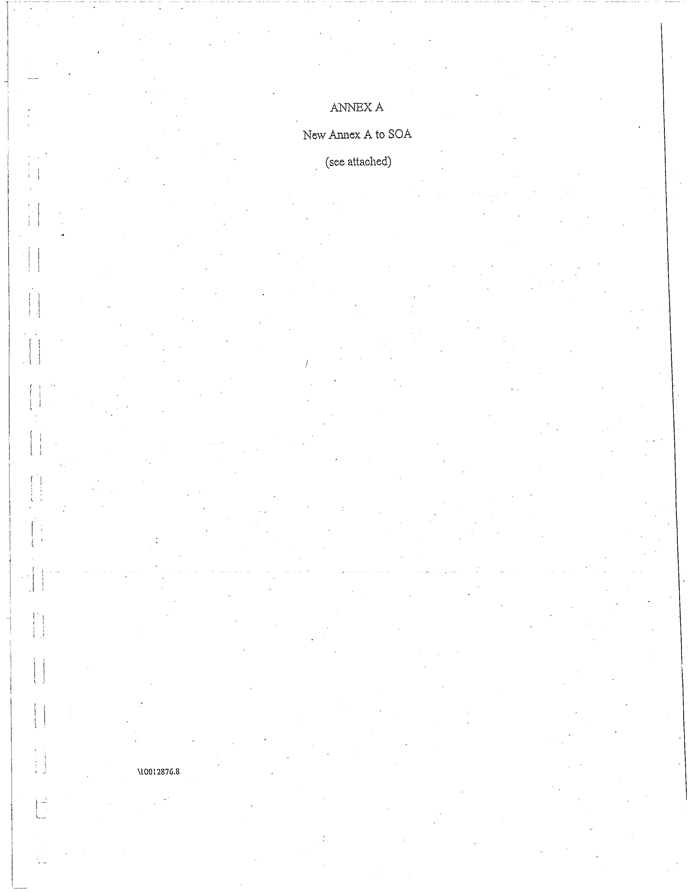
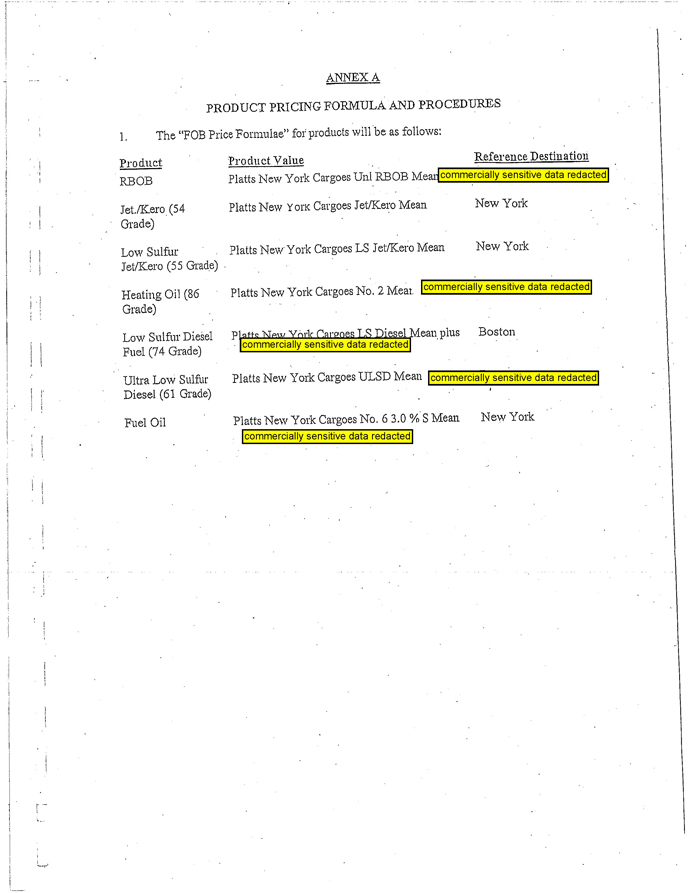
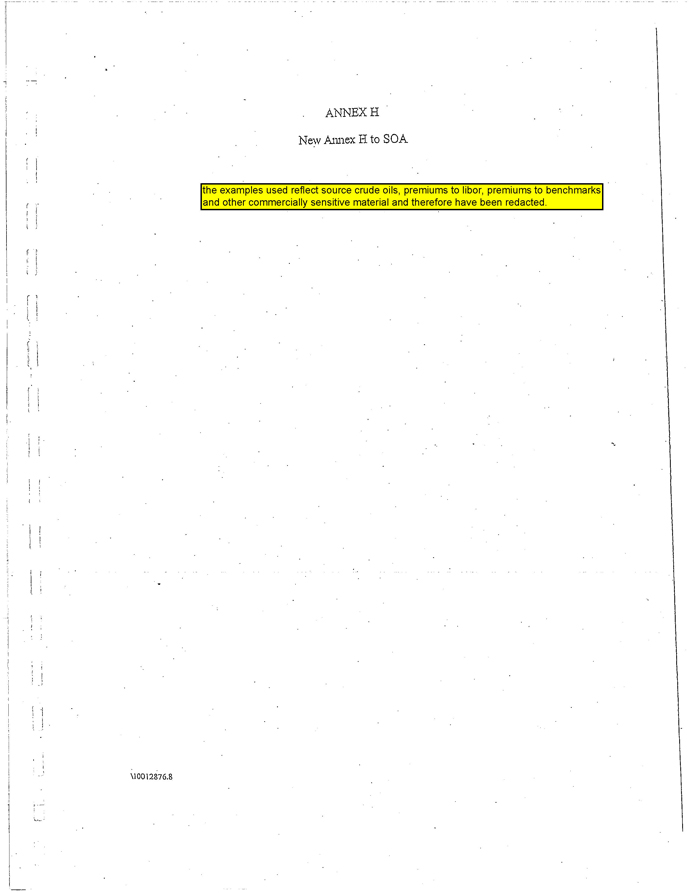

ANNUAL INFORMATION FORM
For the year ended December 31, 2009
MARCH 30, 2010
TABLE OF CONTENTS
| | Page |
| | |
| GLOSSARY OF TERMS | 2 |
| ABBREVIATIONS | 7 |
| CONVERSIONS | 7 |
| EXCHANGE RATE INFORMATION | 8 |
| SPECIAL NOTE REGARDING FORWARD-LOOKING STATEMENTS | 8 |
| NON-GAAP MEASURES | 10 |
| STRUCTURE OF HARVEST ENERGY TRUST | 11 |
| GENERAL DEVELOPMENT OF THE BUSINESS | 13 |
| GENERAL BUSINESS DESCRIPTION | 16 |
| UPSTREAM BUSINESS STATEMENT OF RESERVES DATA | 18 |
| OTHER UPSTREAM BUSINESS INFORMATION | 29 |
| DOWNSTREAM BUSINESS | 43 |
| RISK FACTORS | 50 |
| INTEREST PAID TO HOLDERS OF CONVERTIBLE DEBENTURES | 59 |
| GENERAL DESCRIPTION OF CAPITAL STRUCTURE | 59 |
| SUPPLEMENTAL CAPITAL STRUCTURE INFORMATION | 65 |
| MARKET FOR SECURITIES | 67 |
| DIRECTORS AND OFFICERS OF HARVEST OPERATIONS | 71 |
| EXECUTIVE COMPENSATION | 74 |
| CORPORATE GOVERNANCE DISCLOSURE | 81 |
| CONFLICTS OF INTEREST | 88 |
| LEGAL AND REGULATORY PROCEEDINGS | 88 |
| INTERESTS OF MANAGEMENT AND OTHERS IN MATERIAL TRANSACTIONS | 89 |
| AUDITORS | 89 |
| TRANSFER AGENT AND REGISTRAR | 89 |
| MATERIAL CONTRACTS | 89 |
| INTERESTS OF EXPERTS | 90 |
| ADDITIONAL INFORMATION | 90 |
Appendix A - Report of Management and Directors on Reserves Data and Other Information
Appendix B - Report on Reserves Data by Independent Qualified Reserves Evaluators
Appendix C - Audit Committee Information
Appendix D - Audit Committee Mandate and Terms of Reference
Appendix E – Mandate of the Harvest Board of Directors
GLOSSARY OF TERMS
In this Annual Information Form, the following terms shall have the meanings set forth below, unless otherwise indicated.
" ABCA" means the Business Corporations Act (Alberta), together with any or all regulations promulgated thereunder, as amended from time to time.
" Administration Agreement" means the agreement dated September 27, 2002 between the Trustee and Harvest Operations pursuant to which Harvest Operations provides certain administrative and advisory services in connection with the Trust.
“API” means a measure of the gravity or density of petroleum liquids expressed in terms of a scale devised by the American Petroleum Institute gravity (API), which measures how heavy or light a petroleum liquid is compared to water, and is used to compare the relative densities of petroleum liquids.
" Breeze Trust No. 1" means Harvest Breeze Trust No. 1, a trust established under the laws of the Province of Alberta, wholly owned by the Trust.
" Breeze Trust No. 2" means Harvest Breeze Trust No. 2, a trust established under the laws of the Province of Alberta, wholly owned by the Trust.
" COGE Handbook" means the Canadian Oil and Gas Evaluation Handbook prepared jointly by the Society of Petroleum Evaluation Engineers (Calgary chapter) and the Canadian Institute of Mining, Metallurgy & Petroleum.
" Credit Facility" means the $600 million credit facility provided by a syndicate of lenders to Harvest Operations as more fully described in Note 11 to the Trust’s audited consolidated financial statements for the year ended December 31, 2009 filed on www.sedar.com.
" Debentures" means, collectively, the 6.5% Debentures Due 2010, the 6.40% Debentures Due 2012, the 7.25% Debentures Due 2013, the 7.25% Debentures Due 2014 and the 7.5% Debentures Due 2015.
" Debenture Indenture" means, collectively (i) the trust indenture dated January 29, 2004 among the Trust, Harvest Operations and Valiant Trust Company, as trustee, providing for the issue of debentures, as supplemented by the, second supplemental indenture dated August 2, 2005 in respect of the 6.50% Debentures Due 2010, the third supplemental indenture dated November 22, 2006 in respect of the 7.25% Debentures Due 2013, the fourth supplemental indenture dated February 1, 2007 in respect of the 7.25% Debentures Due 2014 and the fifth supplemental indenture dated April 25, 2008 in respect of the 7.50% Debentures Due 2015; and (ii) the trust indenture dated January 15, 2003 between VERT and Computershare Trust Company of Canada as trustee, providing for the issue of debentures, as supplemented by the first supplemental indenture dated October 20, 2005 in respect of the 6.40% Debentures Due 2012.
" Debenture Trustee" means, as applicable: (i) Valiant Trust Company in its capacity as the trustee in respect of the 6.5% Debentures Due 2010, 7.25% Debentures Due 2013, 7.25% Debentures Due 2014, and 7.5% Debentures Due 2015; and (ii) Computershare Trust Company of Canada in its capacity as the trustee in respect of the 6.40% Debentures Due 2012.
" 6.5% Debentures Due 2010" means the 6.5% convertible unsecured subordinated debentures of the Trust due December 31, 2010.
" 6.40% Debentures Due 2012" means the 6.40% convertible unsecured subordinated debentures of the Trust due October 31, 2012, which were assumed by the Trust from VERT on February 3, 2006 pursuant to the plan of arrangement under the ABCA by which the Trust merged with VERT.
" 7.25% Debentures Due 2013" means the 7.25% convertible unsecured subordinated debentures of the Trust due September 30, 2013.
" 7.25% Debentures Due 2014" means the 7.25% convertible unsecured subordinated debentures of the Trust due February 28, 2014.
" 7.50% Debentures Due 2015" means the 7.50% convertible unsecured subordinated debentures of the Trust due May 31, 2015.
" 7⅞% Senior Notes" means the 7⅞% Senior Notes of Harvest Operations due October 15, 2011 unconditionally guaranteed by the Trust.
" Downstream" means our petroleum refining and marketing segment operating under the North Atlantic trade name, comprised of a medium gravity sour crude hydrocracking refinery with a 115,000 bbls/d nameplate capacity and a marketing division with 64 gasoline outlets, a retail heating fuels business and a commercial and wholesale petroleum products business, all located in the Province of Newfoundland and Labrador.
" Farmout" means an agreement whereby a third party agrees to pay for all or a portion of the drilling of a well on one or more of the Properties in order to earn an interest therein, with an Operating Subsidiary retaining a residual interest in such Properties.
" GLJ" means GLJ Petroleum Consultants Ltd., independent oil and natural gas reservoir engineers of Calgary, Alberta.
" GAAP" means accounting principles generally accepted in Canada.
" Gross" means:
| | (a) | in relation to the Operating Subsidiaries' interest in production and reserves, its "Corporation gross reserves", which are the Operating Subsidiaries' interest (operating and non-operating) share before deduction of royalties and without including any royalty interest of the Operating Subsidiaries; |
| | (b) | in relation to wells, the total number of wells in which the Operating Subsidiaries have an interest; and |
| | (c) | in relation to properties, the total area of properties in which the Operating Subsidiaries have an interest. |
" Harvest" means, collectively, the Trust and its subsidiary corporations, trusts and partnerships.
"Harvest Board" means the board of directors of Harvest Operations.
" Harvest Operations" means Harvest Operations Corp., a corporation incorporated under the laws of the Province of Alberta and a wholly owned subsidiary of the Trust, which serves as administrator of the Trust pursuant to the Administration Agreement.
" HRGP" means Harvest Refining General Partnership, a general partnership established under the laws of the Province of Alberta.
" Independent Reserve Engineering Evaluators" means McDaniel and GLJ, who evaluated the crude oil, natural gas liquids and natural gas reserves of the Operating Subsidiaries as at December 31, 2009, in accordance with the standards contained in the COGE Handbook and the reserve definitions and other requirements contained in NI 51-101.
" KNOC" means Korea National Oil Corporation.
" KNOC Arrangement" means the plan of arrangement implemented pursuant to Section 193 of the ABCA involving, among others, Harvest, Harvest Operations, KNOC Canada, KNOC and the holders of Trust Units, which became effective on December 22, 2009.
" KNOC Canada" means KNOC Canada Ltd., a corporation incorporated under the laws of the Province of Alberta and a wholly owned subsidiary of KNOC.
" McDaniel" means McDaniel & Associates Consultants Ltd., independent oil and natural gas reservoir engineers of Calgary, Alberta.
" Net" means:
| | (a) | in relation to the Operating Subsidiaries' interest in production and reserves, the Operating Subsidiaries' interest (operating and non-operating) share after deduction of royalties obligations, plus the Operating Subsidiaries' royalty interest in production or reserves; |
| | (b) | in relation to wells, the number of wells obtained by aggregating the Operating Subsidiaries' working interest in each of its gross wells; and |
| | (c) | in relation to the Operating Subsidiaries' interest in a property, the total area in which the Operating Subsidiaries have an interest multiplied by the working interest owned by the Operating Subsidiaries. |
" NI 51-101" means National Instrument 51-101 Standards of Disclosure for Oil and Gas Activities.
" North Atlantic" means North Atlantic Refining Limited, a private company, and all wholly owned subsidiaries of North Atlantic.
" NYSE" means the New York Stock Exchange.
" Operating Subsidiaries" means, collectively, Harvest Operations, Redearth Partnership, Breeze Resource Partnership, Breeze Trust No. 1, Breeze Trust No. 2, Hay River Partnership, and HRGP (and all direct and indirect wholly-owned subsidiaries of HRGP), each a direct or indirect wholly-owned subsidiary of the Trust other than Redearth Partnership in respect of which the Trust, indirectly, holds a 60% interest, and "Operating Subsidiary" means any of them.
" Person" includes an individual, a body corporate, a trust, a union, a pension fund, a government and a governmental agency.
" Production" means, with respect to the Upstream operations the produced petroleum, natural gas and natural gas liquids attributed to the Properties and with respect to the Downstream operations, the production of refined petroleum products at the Refinery.
" Properties" means the working, royalty or other interests of the Operating Subsidiaries in any petroleum and natural gas rights, tangibles and miscellaneous interests, including properties which may be acquired by the Operating Subsidiaries from time to time.
" Purchase and Sale Agreement" means the purchase and sale agreement dated August 22, 2006 between the Trust and Vitol Refining Group B.V. providing for the purchase of the outstanding shares of North Atlantic and the entering into of the Supply and Offtake Agreement.
" Refinery" means the 115,000 barrel per day medium gravity sour crude hydrocracking refinery located in the Province of Newfoundland and Labrador, owned by North Atlantic, which is described in "Downstream Business".
" Reserve Report" means, collectively, the reports prepared by the Independent Reserve Engineering Evaluators evaluating the crude oil, natural gas liquids and natural gas reserves of the Operating Subsidiaries as at December 31, 2009, in accordance with the standards contained in the COGE Handbook and the reserve definitions and other requirements contained in NI 51-101.
" Reserve Value" means, for any petroleum and natural gas property at any time, the present worth of all of the estimated pre-tax cash flow net of capital expenditures from the proved plus probable reserves shown in the Reserve Report for such property, discounted at 10% and using forecast price and cost assumptions (a common benchmark in the oil and natural gas industry).
" Special Resolution" means a resolution proposed to be passed as a special resolution at a meeting of Unitholders (including an adjourned meeting) duly convened for the purpose and held in accordance with the provisions of the Trust Indenture at which two or more holders of at least 10% of the aggregate number of Trust Units then outstanding are present in person or by proxy and passed by the affirmative votes of the holders of not less than 66 2/3% of the Trust Units represented at the meeting and voted on a poll upon such resolution.
" Supply and Offtake Agreement" or " SOA" means the supply and offtake agreement dated October 19, 2006 and as amended October 12, 2009 entered into between North Atlantic and Vitol Refining, S.A., the terms of which are summarized under the "Downstream Business – Supply and Offtake Agreement".
" Tax Act" means the Income Tax Act (Canada) and the regulations thereunder.
" Trust" means Harvest Energy Trust.
" Trust Fund" at any time, shall mean those monies, properties and assets of the type contemplated in the Trust Indenture that are at such time held by the Trustee on behalf of the Trust for the purposes of the Trust under the Trust Indenture.
" Trust Indenture" means the fifth amended and restated trust indenture dated May 20, 2008 between the Trustee and Harvest Operations, as amended on December 22, 2009 pursuant to the KNOC Arrangement, as such indenture may be further amended by supplemental indentures from time to time.
" Trust Unit" means a trust unit of the Trust and unless the context otherwise requires means ordinary trust units of the Trust.
" Trust Unit Rights" means the rights to purchase Trust Units at specified exercise prices issued by the Trust under the Trust Unit Rights Incentive Plan.
" Trust Unit Rights Incentive Plan" means the former trust unit rights incentive plan of the Trust, which ceased to be effective following completion of the KNOC Arrangement.
" Trustee" means 1496965 Alberta Ltd. (a wholly-owned subsidiary of KNOC Canada), or its successor as trustee of the Trust.
" TSX" means the Toronto Stock Exchange.
" Unit Awards" means unit awards to receive Trust Units, issued by the Trust under the Unit Award Incentive Plan.
" Unit Award Incentive Plan" means the former unit award incentive plan of the Trust, which ceased to be effective following the KNOC Arrangement.
" Unitholders" means the holders from time to time of one or more Trust Units.
" Upstream" means our petroleum and natural gas segment, consisting of the development, production and subsequent sale of petroleum, natural gas and natural gas liquids in Alberta, Saskatchewan and British Columbia.
" VERT" means Viking Energy Royalty Trust, a trust established under the laws of the Province of Alberta, wholly owned by the Trust.
" VHI" means Viking Holdings Inc., a corporation incorporated under the laws of the Province of Alberta that formerly acted as administrator of VERT, which amalgamated with Harvest Operations on July 1, 2006.
" Working Interest" means an undivided interest held by a party in an oil and/or natural gas or mineral lease granted by a Crown or freehold mineral owner, which interest gives the holder the right to "work" the property (lease) to explore for, develop, produce and market the lease substances but does not include, among other things, a royalty, overriding royalty, gross overriding royalty, net profits interest or other interest that entitles the holder thereof to a share of production or proceeds of sale of production without a corresponding right or obligation to "work" the property.
Certain other terms used herein but not defined herein are defined in NI 51-101 and, unless the context otherwise requires, shall have the same meanings herein as in NI 51-101.
ABBREVIATIONS
| Oil and Natural Gas Liquids | Natural Gas |
| | | | |
| bbl | barrel | Mcf | thousand cubic feet |
| bbls | barrels | MMcf | million cubic feet |
| Mbbls | thousand barrels | Bcf | billion cubic feet |
| bbls/d | barrels per day | Mcf/d | thousand cubic feet per day |
| MMbbls | million barrels | MMcf/d | million cubic feet per day |
| NGLs | natural gas liquids | MMBTU | million British Thermal Units |
| | |
| Other | |
| | |
| AECO | Carlyle/Riverstone Global Energy and Power Fund’s natural gas storage facility located at Suffield, Alberta. |
| ASP | alkaline surfactant polymer. |
| BOE | barrel of oil equivalent, using the conversion factor of 6 Mcf of natural gas being equivalent to one bbl of oil, unless otherwise specified. BOEs may be misleading, particularly if used in isolation. A BOE conversion ratio of 6 Mcf:1 bbl is based on an energy equivalency conversion method primarily applicable at the burner tip and does not represent a value equivalency at the wellhead. |
| BOE/d | barrels of oil equivalent per day. |
| EOR | enhanced oil recovery. |
| MBOE | thousand barrels of oil equivalent. |
| MMBOE | million barrels of oil equivalent. |
| OOIP | original oil in place. |
| WTI | West Texas Intermediate, the reference price paid in U.S. dollars at Cushing, Oklahoma for crude oil of standard grade. |
| API | The measure of the density or gravity of liquid petroleum products derived from a specific gravity. |
| MW | megawatts of electrical power. |
| 3D | three dimensional. |
| Darcies | the measure of permeability (being the ease with which a single fluid will flow through connected pore space when a pressure gradient is applied). |
| Porosity | The measure of the fraction of pore space of a reservoir. |
| $000 | thousands of dollars. |
| $millions | millions of dollars. |
CONVERSIONS
The following table sets forth certain conversions between Standard Imperial Units and the International System of Units (or metric units).
| To Convert From | | To | | Multiply By | |
| | | | | | |
| Mcf | | cubic metres | | | 28.174 | |
| cubic metres | | cubic feet | | | 35.494 | |
| bbls | | cubic metres | | | 0.159 | |
| feet | | metres | | | 0.305 | |
| metres | | feet | | | 3.281 | |
| miles | | kilometres | | | 1.609 | |
| kilometres | | miles | | | 0.621 | |
| acres | | hectares | | | 0.405 | |
| hectares | | acres | | | 2.471 | |
EXCHANGE RATE INFORMATION
All dollar amounts set forth in this Annual Information Form are expressed in Canadian dollars, except where otherwise indicated. References to Canadian dollars, Cdn$, C$ or $ are to the currency of Canada and references to U.S. dollars or US$ are to the currency of the United States.
The following table sets forth for each period indicated, the average, high, low and end of period noon buying rates in New York for cable transfers as certified for customs purposes by the Federal Reserve Bank of New York (the "noon buying rate"). Such rates are set forth as U.S. dollars per $1.00 and are the inverse of the rates quoted by the Federal Reserve Bank of New York for Canadian dollars per US$1.00.
| | | Year Ended December 31, | |
| | | 2009 | | | 2008 | | | 2007 | |
| High | | | 0.9716 | | | | 1.0289 | | | | 1.0905 | |
| Low | | | 0.7692 | | | | 0.7711 | | | | 0.8437 | |
| Period End | | | 0.9555 | | | | 0.8166 | | | | 1.0120 | |
Average (1) | | | 0.8706 | | | | 0.9332 | | | | 0.9376 | |
Note:
(1) Average represents the average of the rates on the last day of each month during the period.
SPECIAL NOTE REGARDING FORWARD-LOOKING STATEMENTS
Certain statements contained in this Annual Information Form and documents incorporated by reference herein, constitute forward-looking statements. These statements relate to future events and future performance. All statements other than statements of historical fact may be forward-looking statements. Forward-looking statements are subject to certain risks and uncertainties that could cause actual results to differ materially from those included in the forward-looking statements. Forward-looking statements are often, but not always, identified by the use of words such as "seek", "anticipate", "plan", "continue", "estimate", "expect", "may", "will", "project", "predict", "potential", "targeting", "intend", "could", "might", "should", "believe" and similar expressions. Harvest Operations believes the expectations reflected in these forward-looking statements are reasonable but no assurance can be given that these expectations will prove to be correct and such forward-looking statements included in, or incorporated by reference into, this Annual Information Form should not be unduly relied upon. These statements speak only as of the date of this Annual Information Form or as of the date specified in the documents incorporated by reference into this Annual Information Form, as the case may be.
In particular, this Annual Information Form, and the documents incorporated by reference herein, contain forward-looking statements pertaining to:
| · | expected financial performance in future periods; |
| · | expected increases in revenue attributable to development and production activities; |
| · | estimated capital expenditures; |
| · | competitive advantages and ability to compete successfully; |
| · | intention to continue adding value through drilling and exploitation activities; |
| · | emphasis on having a low cost structure; |
| · | intention to retain a portion of cash flows to repay indebtedness and invest in further development of our properties; |
| · | reserve estimates and estimates of the present value of our future net cash flows; |
| · | methods of raising capital for exploitation and development of reserves; |
| · | factors upon which to decide whether or not to undertake a development or exploitation project; |
| · | plans to make acquisitions and expected synergies from acquisitions made; |
| · | expectations regarding the development and production potential of petroleum and natural gas properties; |
| · | treatment under government regulatory regimes including without limitation, environmental and tax regulation; |
| · | overall demand for gasoline, low sulphur diesel, jet fuel, furnace oil and other refined products; and |
| · | the level of global production of crude oil feedstocks and refined products. |
With respect to forward-looking statements contained in this Annual Information Form and the documents incorporate by reference herein, Harvest has made assumptions regarding, among other things:
| · | future oil and natural gas prices and differentials between light, medium and heavy oil prices; |
| · | the cost of expanding Harvest's property holdings; |
| · | the ability to obtain equipment in a timely manner to carry out development activities; |
| · | the ability to market oil and natural gas successfully to current and new customers; |
| · | the impact of increasing competition; |
| · | the ability to obtain financing on acceptable terms; |
| · | the ability to add production and reserves through development and exploitation activities; and |
| · | the ability to produce gasoline, low sulphur diesel, jet fuel, furnace oil, and other refined products that meet customer specifications. |
Some of the risks that could affect Harvest's future results and could cause results to differ materially from those expressed in forward-looking statements include:
| · | the volatility of oil and natural gas prices, including the differential between the price of light, medium and heavy oil; |
| · | the uncertainty of estimates of petroleum and natural gas reserves; |
| · | the impact of competition; |
| · | difficulties encountered in the integration of acquisitions; |
| · | difficulties encountered during the drilling for and production of oil and natural gas; |
| · | difficulties encountered in delivering oil and natural gas to commercial markets; |
| · | foreign currency fluctuations; |
| · | the uncertainty of Harvest's ability to attract capital; |
| · | changes in, or the introduction of new, government laws and regulations relating to the oil and natural gas business including without limitation, tax, royalty and environmental law and regulation; |
| · | costs associated with developing and producing oil and natural gas; |
| · | compliance with environmental and tax regulations; |
| · | liabilities stemming from accidental damage to the environment; |
| · | loss of the services of any of Harvest's senior management or directors; |
| · | adverse changes in the economy generally; |
| · | the volatility of refining gross margins including the price of feedstocks as well as the prices for refined products; and |
| · | the stability of the Refinery throughput performance. |
Statements relating to "reserves" are deemed to be forward-looking statements, as they involve the implied assessment, based on certain estimates and assumptions, that the resources and reserves described can be profitably produced in the future. Readers are cautioned that the foregoing lists of factors are not exhaustive. The forward- looking statements contained in this Annual Information Form and the documents incorporated by reference herein are expressly qualified by this cautionary statement. Except as required by law, neither the Trust nor Harvest Operations undertakes any obligation to publicly update or revise any forward-looking statements and readers should also carefully consider the matters discussed under the heading "Risk Factors" in this Annual Information Form.
NON-GAAP MEASURES
Harvest uses certain financial reporting measures that are commonly used as benchmarks within the petroleum and natural gas industry. These measures include: "Payout Ratio", "Cash G&A", "Operating Netbacks", "Earnings from Operations" and "Gross Margin". These measures are not defined under Canadian generally accepted accounting principles and should not be considered in isolation or as an alternative to conventional Canadian GAAP measures. Certain of these measures are not necessarily comparable to a similarly titled measure of another company or trust. When these measures are used, they have been footnoted and the footnote to the applicable measure notes that the measure is "non-GAAP" and contains a description of how to reconcile the measure to the applicable financial statements. These measures should be given careful consideration by the reader.
Specifically, management uses “Payout Ratio”, “Cash G&A” and “Operating Netbacks” as they are non-GAAP measures used extensively in the Canadian energy trust sector for comparative purposes. Payout Ratio is the ratio of distributions to total Cash from Operating Activities. Operating Netbacks are always reported on a per BOE basis, and include gross revenue, royalties, transportation and operating expenses. Cash G&A are G&A expenses, excluding the effect of unit based compensation plans. “Gross Margin” is also a non-GAAP measure commonly used in the refining industry to reflect the net cash received from the sale of refined product after considering the cost to purchase the feedstock and is calculated by deducting purchased products for resale and processing from total revenue. “Earnings from Operations” is also a non-GAAP measure commonly used in the petroleum and natural gas and in the refining and marketing industries to reflect operating results before items not directly related to operations.
Unless otherwise specified, information in this Annual Information Form is as at the end of the Trust's most recently completed financial year, being the year ended December 31, 2009.
STRUCTURE OF HARVEST ENERGY TRUST
Harvest Energy Trust
Harvest Energy Trust (the “Trust”) is an open-ended, unincorporated investment trust established under the laws of the Province of Alberta and is governed pursuant to the Amended and Restated Trust Indenture dated December 22, 2009 between Harvest Operations Corp. (“Harvest Operations”), a wholly owned subsidiary and manager of the Trust, and 1496965 Alberta Ltd. as Trustee (the “Trust Indenture”). The beneficiary of the Trust is the holder of its Trust Units (the “Unitholder”). On December 22, 2009, Korea National Oil Corporation Canada Ltd. (“KNOC Canada”), a wholly owned subsidiary Korea National Oil Corporation (“KNOC”), purchased all of the issued and outstanding Trust Units of the Trust.
It is expected that Harvest will reorganize its structure in 2010 so as to, effectively convert from an investment trust issuer to a corporate issuer. The reorganization is anticipated to result in Harvest Operations becoming the parent entity of the remaining Operating Subsidiaries.
The head and principal office of the Trust and Harvest Operations is located at Suite 2100, 330 - 5th Avenue S.W., Calgary, Alberta T2P 0L4 while the registered office of Harvest Operations is located at Suite 4500, Bankers Hall East 855 – 2 nd Street S.W., Calgary, Alberta T2P 4K7.
The business of Harvest is to, indirectly through Harvest Operations and its other Operating Subsidiaries, exploit, develop and hold interests in petroleum and natural gas properties in its upstream segment as well as conduct petroleum refining and marketing operations in its downstream segment.
Operating Subsidiaries
Each of the subsidiary entities identified below is a direct or indirect wholly-owned subsidiary of the Trust other than Redearth Partnership, in respect of which the Trust indirectly holds a 60% interest.
Harvest Operations, a taxable corporation
Harvest Operations was incorporated under the ABCA on May 14, 2002. Subsequently, Harvest Operations has been amalgamated with numerous corporate subsidiaries of Harvest and continued in each case as "Harvest Operations Corp". All of the issued and outstanding common shares of Harvest Operations are by the Trust.
In addition to administering the affairs of the Trust, Harvest Operations manages the affairs of the other Operating Subsidiaries and is responsible for providing all of the technical, engineering, geological, land management, financial, administrative and commodity marketing services relating to Harvest's upstream operations.
Redearth Partnership, a general partnership
Redearth Partnership is a general partnership formed on August 23, 2002 under the laws of the Province of Alberta. In June 2004, Harvest Operations acquired its 60% ownership interest in Redearth Partnership. Redearth Partnership's assets consist of direct ownership interest in properties located in north central Alberta.
Harvest Breeze Trust No. 1, a commercial trust
Breeze Trust No. 1 is an unincorporated commercial trust established under the laws of the Province of Alberta on July 8, 2004. Breeze Trust No. 1 is wholly owned by the Trust and its assets consist of the intangible portion of direct ownership interests in petroleum and natural gas properties purchased from the Breeze Resources Partnership and the Hay River Partnership and a 99% interest in each of those partnerships.
Harvest Breeze Trust. No. 2, a commercial trust
Breeze Trust No. 2 is an unincorporated commercial trust established under the laws of the Province of Alberta on July 8, 2004. Breeze Trust No. 2 is wholly owned by the Trust and its assets consist of a 1% interest in each of the Breeze Resources Partnership and the Hay River Partnership.
Breeze Resources Partnership, a general partnership
Breeze Resources Partnership (indirectly wholly-owned by the Trust) is a general partnership formed on June 30, 2004 under the laws of the Province of Alberta. Breeze Resources Partnership was acquired in September 2004. Its assets consist of the tangible portion of direct ownership interest in petroleum and natural gas properties located in east central Alberta and southern Alberta and a promissory note due from Breeze Trust No. 1.
Hay River Partnership, a general partnership
Hay River Partnership (indirectly wholly-owned by the Trust) is a general partnership formed on December 20, 2004 under the laws of the Province of Alberta. Hay River Partnership was acquired in August 2005. Its assets consist of the tangible portion of direct ownership interests in petroleum and natural gas properties located in northeastern British Columbia and a promissory note due from Breeze Trust No. 1.
Harvest Refining General Partnership, a general partnership
Harvest Refining General Partnership is a general partnership formed on September 27, 2006 under the laws of the Province of Alberta. The Trust holds a 99% partnership interest and Calpine Natural Gas Trust, an Alberta commercial trust wholly owned by the Trust, holds the residual 1% partnership interest. Harvest Refining General Partnership's assets consist of unsecured debt owing from each of VERT and North Atlantic as well as a 100% equity interest in both VERT and North Atlantic.
North Atlantic Refining Limited, a taxable corporation
North Atlantic Refining Limited (is a wholly-owned subsidiary of HRGP amalgamated under the laws of the Province of Newfoundland and Labrador on October 19, 2006. North Atlantic's assets consist of preferred partnership units representing 75% of the total preferred partnership interest in the North Atlantic Refining Limited Partnership as well as common partnership units representing 5% of the total common partnership interest in the same partnership.
North Atlantic manages the affairs of North Atlantic Refining Limited Partnership and is responsible for providing the engineering, operations and administrative services related to Harvest's refining operations. The feedstock supply management and marketing of refined products has been contracted to Vitol Refining, S.A. pursuant to the Supply and Offtake Agreement.
Viking Energy Royalty Trust, a commercial trust
Viking Energy Royalty Trust (a, wholly-owned subsidiary of North Atlantic Refining Limited) is a trust established under the laws of the Province of Alberta on November 5, 1996. VERT's assets consist of preferred partnership units representing 25% of the total preferred partnership interest in the North Atlantic Refining Limited Partnership as well as common partnership units representing 95% of the total common partnership interest in the same partnership.
North Atlantic Refining Limited Partnership, a limited partnership
North Atlantic Refining Limited Partnership is a limited partnership formed on October 13, 2006 under the laws of the Province of Newfoundland and Labrador. North Atlantic Refining Limited Partnership's assets consist of the Refinery and related retail marketing assets.
Organizational Structure of the Trust
The structure of the Trust and its significant subsidiaries is set forth below:
Notes:
| (1) | All operations and management of the Trust and the Operating Subsidiaries are conducted through Harvest Operations except for the operations of the North Atlantic Refining Limited Partnership which is conducted by the management and employees of North Atlantic Refining Limited. |
| (2) | Breeze Trust No. 1 and Breeze Trust No. 2 have also issued priority trust units to Harvest Operations. |
GENERAL DEVELOPMENT OF THE BUSINESS
Harvest was formed in July 2002 and acquired 8,500 BOE/d of production in the same year. Harvest acquired 7,475 BOE/d in 2003, 24,000 BOE/d in 2004, and 5,200 BOE/d in 2005 for aggregate consideration of $1,127.7 million. In late 2005, Harvest agreed to a plan of arrangement with VERT to create a stronger entity with a more balanced portfolio of assets as well as providing its security holders with greater liquidity and participation in one of the largest oil and natural gas trusts in Canada. During 2006, Harvest's upstream production averaged approximately 59,729 BOE/d with a year end exit rate of approximately 65,023 BOE/d comprised of approximately 45% light and medium oil, 25% heavy oil and 30% natural gas. The acquisition of the North Atlantic refinery was completed in October 2006 and for the month of December 2006, being the first month of full operations since acquiring the Refinery, the throughput of the North Atlantic refinery totalled 101,679 BOE/d.
Year ended December 31, 2007
In August 2007, Harvest acquired all of the issued and outstanding shares of Grand Petroleum Inc. ("Grand") for an aggregate transaction cost of $139.3 million comprised of $109.7 million in cash to acquire the shares of Grand, $28.8 million to repay Grand’s bank debt and $0.8 million in respect of related acquisition costs. During the three months ended March 31, 2007, Grand’s production averaged 3,409 BOE/d comprised of 68% light oil and 32% natural gas.
During 2007, Harvest's upstream production averaged approximately 60,336 BOE/d comprised of approximately 49% light and medium oil, 24% heavy oil and 27% natural gas. Capital spending on internal development in our upstream business aggregated to $300.7 million, a decrease of $76.2 million over the prior year while capital spending in our downstream business totalled $44.1 million. For 2007, the daily throughput of feedstock for the Refinery averaged 98,617 bbls/d reflecting two planned shutdowns in the fourth quarter for turnaround and scheduled maintenance activities.
Year ended December 31, 2008
On July 24, 2008, Harvest acquired all of the issued and outstanding shares of a private corporation with production of approximately 390 bbl/d of light oil and 2,300 mcf/d of natural gas for cash consideration of $36.8 million. On September 8, 2008, Harvest acquired petroleum and natural gas producing properties in the Peace River Arch area of northern Alberta with approximately 1,250 bbl/d of light oil and 3,900 mcf/d of natural gas for cash consideration of $130.8 million plus some minor property interests which produced approximately 85 BOE/d.
During 2008, Harvest's upstream production averaged approximately 55,932 BOE/d comprised of approximately 50% light and medium oil, 22% heavy oil and 28% natural gas. Capital spending on internal development in our upstream business aggregated to $271.3 million, a reduction of $29.4 million as compared to the prior year while capital spending in our downstream business totalled $56.2 million as compared to $44.1 million in 2007. For 2008, the daily throughput of feedstock for the Refinery averaged 103,497 bbls/d as compared to 98,617 bbls/d in the prior year.
Year ended December 31, 2009
On June 15, 2009, Harvest and Pegasus Oil & Gas Inc. ("Pegasus") entered into a pre-acquisition agreement pursuant to which Harvest agreed to make an offer to purchase all of the outstanding shares of Pegasus in consideration for 0.015 of a Trust Unit for each Pegasus share. The total transaction value was composed of $4.6 million of Harvest Trust Units, $13.9 million of assumed Pegasus debt and $1.0 million of acquisition costs. Harvest completed the acquisition of 100% of the outstanding shares of Pegasus on August 12, 2009.
On October 21, 2009, Harvest and KNOC entered into a definitive arrangement agreement pursuant to which KNOC agreed to acquire the Trust in a transaction valued at approximately $4.1 billion (including debt) pursuant to a plan of arrangement under Section 193 of the ABCA. A special meeting of the holders of the outstanding Trust Units, Trust Unit Rights and Unit Awards to consider the KNOC Arrangement was held on December 15, 2009. A special resolution approving the KNOC Arrangement was passed by a majority vote of over 90% of such securityholders. The KNOC Arrangement was subsequently approved by the Court of Queen's Bench of Alberta on December 16, 2009 and became effective on December 22, 2009, whereupon the Trust become an indirect wholly-owned subsidiary of KNOC.
Pursuant to the KNOC Arrangement, all of the issued and outstanding Trust Units were acquired by KNOC Canada for cash consideration of $10.00 per Trust Unit. In addition, all outstanding Trust Unit Rights and Unit Awards of Harvest were cancelled in exchange for a cash payment equal to, for each Trust Unit Right, the greater of $0.01 and the amount, if any, by which $10.00 exceeded the exercise price thereof and, for each Unit Award, $10.00 for each Trust Unit issuable on the exercise thereof. The Trust Units were subsequently delisted from both the TSX and the NYSE.
The Debentures and the 7⅞% Senior Notes continued as obligations of the Trust and Harvest Operations, as applicable, following completion of the KNOC Arrangement. See "General Description of Capital Structure" and "Supplemental Capital Structure Information - 7⅞% Senior Notes ". The outstanding Debentures remain listed on the TSX. See "Market for Securities".
Concurrent with closing of the KNOC Arrangement, Harvest Operations repaid approximately $600 million of then existing bank indebtedness and entered into an amended $600 million credit facility with a syndicate of lenders. See "Supplemental Capital Structure Information – Credit Facility".
During 2009, Harvest's upstream production averaged approximately 51,646 BOE/d comprised of approximately 51% light and medium oil, 20% heavy oil and 29% natural gas. Capital spending on internal development in our Upstream business aggregated to $186.3 million, a reduction of $85.0 million as compared to the prior year while capital spending in our Downstream business totalled $43.9 million as compared to $56.2 million in 2008.
In the Downstream operations the Refinery averaged 83,939 bbls/d in 2009, down from 103,497 bbls/d in the prior year. A major planned turnaround was successfully completed during the second quarter, expanding our hydrocracking capacity by an additional 1,000 barrels per stream-day. Operations in the third quarter resulted in throughputs similar to the first quarter; however, margins were considerably reduced. Fourth quarter margins were also weak, and North Atlantic took advantage of this to reduce throughputs and complete maintenance activities.
Recent Developments
As completion of the KNOC Arrangement constituted a "change of control" under the Debenture Indenture, the Trust was required to make, and did on January 19, 2010 make offers to purchase all outstanding Debentures for cash consideration equal to 101% of the principal amount thereof plus accrued and unpaid interest. As at March 4, 2010 all of the offers to purchase expired and the following redemptions were made: (a) $13.3 million principal amount was tendered in respect of the 6.5% Debentures Due 2010, leaving a principal balance of $23.8 million outstanding; (b) $67.8 million principal amount was tendered in respect of the 6.40% Debentures Due 2012, leaving a principal balance of $106.8 million outstanding; (c) $48.7 million principal amount was tendered in respect of the 7.25% Debentures Due 2013, leaving a principal balance of $330.5 million outstanding; (d) $13.2 million principal amount was tendered in respect of the 7.25% Debentures Due 2014, leaving a principal balance of $60.1 million outstanding; and (e) $13.4 million principal amount was tendered in respect of the 7.50% Debentures Due 2015, leaving a principal balance of $236.6 million outstanding. See "General Description of Capital Structure – Debentures and Debenture Indenture – Change of Control of the Trust".
The indenture pursuant to which the 7⅞% Senior Notes were issued contains a similar "change of control" provision. Accordingly, on January 20, 2010, the Harvest Operations made an offer to purchase all of the outstanding 7⅞% Senior Notes for cash consideration of 101% of the principal amount thereof plus accrued and unpaid interest. On February 16, 2010, that offer expired with US$40.4 million principal amount having been tendered in acceptance of the offer, leaving a principal balance of US$209.6 million outstanding.
In early 2010, we issued an incremental $466 million of equity to KNOC Canada, which was used to further reduce bank debt in advance of the required change-of-control offers to holders of the 7⅞% Senior Notes and Debentures.
In March 2010, Harvest closed an acquisition of certain petroleum and natural gas assets for $31.0 million.
GENERAL BUSINESS DESCRIPTION
Overview
With its acquisition of North Atlantic in October 2006, Harvest became an integrated petroleum and natural gas producer with downstream operations located in Newfoundland and Labrador and upstream operations located in Alberta, Saskatchewan and British Columbia.
In the upstream operations, Harvest employs a disciplined approach to acquiring high working interest, large resource-in-place, producing properties and uses "best practice" technical and field operational processes to extract maximum value from its assets. These operational processes include hands-on approach to management with a focus on optimizing production rates, the application of enhanced oil recovery and other technologies and selective capital investment to maximize reservoir recovery while stressing operational efficiencies to control operating costs. As at March 23, 2010, Harvest employed 365 full-time employees in its upstream business 237 of which are located in the head office and 128 of which are located in the field.
Harvest's downstream business consists of a medium gravity sour crude oil hydrocracking refinery with 115,000 barrels per stream day nameplate capacity and with related docking and storage facilities as well as a marketing division with retail gasoline, home heating, commercial, wholesale and bunkers business all operated in Province of Newfoundland and Labrador. As at March 23, 2010, Harvest employed 450 full-time employees and 72 part-time employees in its downstream business, all of which are located in the Province of Newfoundland and Labrador.
Business Strategies, Policies & Practices
Harvest's business strategy is focused on cash flow generation, acquiring assets with identified operational and development opportunities and increasing the long-term value of its assets with proven development strategies. Prior to 2006, Harvest had applied its strategies to opportunities in the petroleum and natural gas industry in western Canada. With the valuation of petroleum and natural gas assets in western Canada ever increasing through 2005 and into 2006, the opportunities to acquire such assets with significant upside potential became difficult. As a result, in 2006 Harvest changed its focus in western Canada to aggressively pursuing development opportunities within our existing asset base and in 2007, implemented three enhanced oil recovery projects with modest capital requirements but the potential to add significant reserves.
In 2006, Harvest expanded its core business to include crude oil refining and a retail petroleum marketing business. This initiative was undertaken to diversify our business with a long-life asset that has considerable growth potential by increasing the throughput, shifting the yield to higher-valued refined products as well as enhancing capacity to handle a heavier, more-sour crude oil feedstock.
Upstream Segment
Within the upstream segment, Harvest employs the following operating strategies:
| 1. | Acquire Properties with Operational and Development Opportunities - Harvest will continue to selectively acquire properties with an established production history and once acquired, focus on improving resource recovery, reducing costs and extending reserve life thereby creating additional value for its securityholders. Harvest will continue to evaluate future acquisitions on the basis of their net present value. |
| 2. | Enhanced Oil Recovery Projects - Harvest will continue to promote its enhanced oil recovery projects. At Wainwright, we implemented a polymer flood pilot to improve recovery rates. With the success of this pilot, we expect to expand the project to impact a larger portion of the reservoir at Wainwright. At both Bellshill Lake and Suffield, we have increased our injected water by introducing water produced at adjacent properties to re-pressurize the reservoir. Future enhanced oil recovery opportunities have been identified in Hayter, Hay River, Kindersley and southeast Saskatchewan, while carbon dioxide (CO2) flooding and sequestration, oilsands and coal bed methane (CBM) represent longer term recovery opportunities for Harvest. |
| 3. | Increase Operating Netbacks - Harvest focuses on reducing operating costs and optimizing marketing alternatives to increase its operating netback and thereby extending the life and increasing the value of its proved reserves. Cost reduction initiatives include continuous improvements to water handling and disposal alternatives and contracting for volume discounts on well servicing and purchased materials. Optimizing marketing alternatives includes blending crude oil production to meet pricing specifications and reviewing transportation alternatives to achieve the highest prices available at the wellhead. |
| 4. | Insurance Coverage - In addition to preventative maintenance operating practices, Harvest maintains property damage and business interruption insurance to mitigate the risk associated with its practice of controlling operations and future development by maintaining a high working interest in its petroleum and natural gas properties. Harvest's property damage coverage is subject to a $500,000 deductible per occurrence and a claim limit of $130 million while the business interruption insurance covers its five highest revenue generating properties subject to a 30 day deductible period and claim limit of $130 million. Harvest also maintains an industry standard environmental, health and safety program – See "Environmental, Health & Safety Policies & Practices" below under "Other Upstream Information". |
Downstream Segment
Within the downstream segment, Harvest employs the following operating strategies:
| 1. | Acquire Established Operating Facilities – The North Atlantic operations acquired by Harvest in 2006 had over ten years of continuous operations with a committed workforce and operating plan. In respect of the related feedstock procurement and marketing of refined products, Harvest has contracted with Vitol Refining S.A. to provide these services as well as the related working capital financing subject to a mutual six month termination clause after November 1, 2011. The Refinery is currently configured to produce high quality gasoline and distillates that meet or exceed the ever increasing environmental requirements, from a medium gravity sour feedstock. |
| 2. | Profitability Improvement and Expansion – We have identified a "Debottlenecking Project" involving an increase in the design capacity from 115,000 bbl/d to 130,000 bbl/d, improving the yield of gasoline and distillate products, enhancing feedstock receiving and storage facilities and improving process heating design and combustion technologies. In 2009, we made considerable progress toward the Debottleneck Projects. This suite of investments is estimated to cost a total of approximately US$310 million through 2010 and 2011 and has compelling economics. It involves the licensing and incorporation of demonstrated and mature process technologies into existing processes to capture additional capacities, enhanced yields and reduced expenses. We spent approximately US$11 million advancing these projects during 2009. |
| 3. | Insurance Coverage – North Atlantic maintains property damage and business interruption insurance on its refinery operations to a maximum annual loss limit of US$1 billion subject to a property damage deductible of US$7.5 million and a 45 day deductible period for the business interruption coverage subject to a minimum of US$20 million for any one occurrence. North Atlantic receives its crude oil feedstock via water born vessels and protects its exposure to marine pollution and related clean-up by requiring any vessel delivering feedstock to the Refinery or shipping refined products from the Refinery to carry US$1 billion of coverage per vessel and to insure the cargo for 110% of its value. In addition, North Atlantic maintains sudden and accidental pollution insurance in the amount of US$200 million subject to a deductible of US$0.5 million. |
Cash Flow Risk Management
Harvest’s cash flow risk management strategies are financially integrated, reflecting that the commodity price risk of our cash flow from producing crude oil in western Canada is financially offset partially by our requirement to purchase crude oil feedstock for our downstream operations even though the crude oil produced in western Canada does not physically flow to our refinery in Newfoundland. As a result, our 2010 cash flow at risk is comprised of approximately net 33,000 bbls/d of refined product price exposure, 82,000 bbls/d of refined product crack spread exposure and 79,000 mcf/d of western Canadian natural gas price exposure.
Commencing in 2006, we limited our financial hedge counterparties to lenders in our syndicated Credit Facility as the security provided under our Credit Facility will extend to our price risk management contracts. This eliminates the requirement for margin calls and the pledging of collateral as well as enables the negotiation of a more limited number of events of default which limits the potential that these contracts could exacerbate credit concerns.
UPSTREAM BUSINESS
STATEMENT OF RESERVES DATA
The statement of reserves data and other oil and natural gas information set forth below (the " Statement") is dated March 23, 2010. The effective date of the Statement is December 31, 2009 and the preparation date of the Statement is March 23, 2010.
Disclosure of Reserves Data
Harvest retained qualified, Independent Reserves Engineering Evaluators to evaluate and prepare reports on 100% of Harvest's crude oil and natural gas reserves as of December 31, 2009. Harvest's reserves were evaluated by McDaniel (who evaluated approximately 40% of Harvest's total proved plus probable reserves), and GLJ (who evaluated approximately 60% of Harvest's total proved plus probable reserves). All of Harvest's reserves were evaluated using the price and cost assumptions of McDaniel as at January 1, 2010.
The Statement summarizes the crude oil, natural gas liquids and natural gas reserves of the Operating Subsidiaries and the net present values of future net revenue for these reserves using forecast prices and costs. The Reserve Report has been prepared by the Independent Reserve Engineering Evaluators in accordance with the standards contained in the COGE Handbook and the reserve definitions and other requirements contained in NI 51-101. Additional information not required by NI 51-101 has been presented to provide continuity and additional information which we believe is important to the readers of this information. Harvest engaged the Independent Reserve Engineering Evaluators to provide an evaluation of proved and proved plus probable reserves and no attempt was made to evaluate possible reserves.
All of the Operating Subsidiaries' reserves are in Canada and, specifically, in the provinces of Alberta, British Columbia and Saskatchewan.
Disclosure provided herein in respect of BOEs may be misleading, particularly if used in isolation. A BOE conversion ratio of 6 Mcf:1 bbl is based on an energy equivalency conversion method primarily applicable at the burner tip and does not represent a value equivalency at the wellhead.
It should not be assumed that the estimates of future net revenues presented in the tables below represent the fair market value of the reserves. There is no assurance that the forecast prices and costs assumptions will be attained and variances could be material. The recovery and reserve estimates of the Operating Subsidiaries' crude oil, natural gas liquids and natural gas reserves provided herein are estimates only and there is no guarantee that the estimated reserves will be recovered. Actual crude oil, natural gas and natural gas liquid reserves may be greater than or less than the estimates provided herein.
Reserves Data (Forecast Prices and Costs) – December 31, 2009
SUMMARY OF OIL AND NATURAL GAS RESERVES
AND NET PRESENT VALUES OF FUTURE NET REVENUE
as of December 31, 2009
FORECAST PRICES AND COSTS
| | | | |
| | | | | | | | | | |
| | | | | | | | | | | | | | | | | | |
| | | | | | | | | | | | | | | | | | | |
| PROVED | | | | | | | | | | | | | | | | | | |
Developed Producing | | | 52,299 | | | | 47,125 | | | | 30,612 | | | | 27,095 | | | | 163,734 | | | | 143,896 | |
Developed Non-Producing | | | 872 | | | | 734 | | | | 2,030 | | | | 1,601 | | | | 13,562 | | | | 11,857 | |
Undeveloped | | | 8,703 | | | | 7,392 | | | | 4,540 | | | | 3,668 | | | | 29,241 | | | | 23,763 | |
| TOTAL PROVED | | | 61,874 | | | | 55,251 | | | | 37,182 | | | | 32,364 | | | | 206,537 | | | | 179,516 | |
| | | | | | | | | | | | | | | | | | | | | | | | | |
| PROBABLE | | | 25,161 | | | | 22,127 | | | | 17,915 | | | | 14,920 | | | | 79,559 | | | | 67,482 | |
| | | | | | | | | | | | | | | | | | | | | | | | | |
| TOTAL PROVED PLUS PROBABLE | | | 87,035 | | | | 77,378 | | | | 55,097 | | | | 47,284 | | | | 286,096 | | | | 246,998 | |
| | | | |
| | | | | | | |
| | | | | | | | | | | | |
| | | | | | | | | | | | | |
| PROVED | | | | | | | | | | | | |
Developed Producing | | | 5,811 | | | | 4,265 | | | | 116,010 | | | | 102,468 | |
Developed Non-Producing | | | 392 | | | | 269 | | | | 5,554 | | | | 4,580 | |
Undeveloped | | | 627 | | | | 473 | | | | 18,744 | | | | 15,493 | |
| TOTAL PROVED | | | 6,830 | | | | 5,007 | | | | 140,309 | | | | 122,541 | |
| | | | | | | | | | | | | | | | | |
| PROBABLE | | | 2,819 | | | | 2,025 | | | | 59,155 | | | | 50,319 | |
| | | | | | | | | | | | | | | | | |
| TOTAL PROVED PLUS PROBABLE | | | 9,649 | | | | 7,032 | | | | 199,463 | | | | 172,860 | |
| | | | | | Value Per | |
| | | | | | Boe Before | |
| | | NET PRESENT VALUES OF FUTURE NET REVENUE | | | Income Tax | |
| | | BEFORE INCOME TAXES DISCOUNTED AT (%/year) (2) | | | Discounted | |
| | | 0% | | | 5% | | | 10% | | | 15% | | | 20% | | | At 10%/year | |
| | | | | | | | | | | | | | | | | | |
| | | | | | | | | | | | | | | | | | | |
| PROVED | | | | | | | | | | | | | | | | | | |
Developed Producing | | | 4,374,392 | | | | 3,215,812 | | | | 2,573,005 | | | | 2,160,755 | | | | 1,873,176 | | | | 25.11 | |
Developed Non-Producing | | | 161,211 | | | | 120,018 | | | | 92,936 | | | | 74,578 | | | | 61,509 | | | | 20.29 | |
Undeveloped | | | 519,311 | | | | 343,482 | | | | 239,289 | | | | 172,512 | | | | 127,176 | | | | 15.45 | |
| TOTAL PROVED | | | 5,054,914 | | | | 3,679,312 | | | | 2,905,230 | | | | 2,407,845 | | | | 2,061,861 | | | | 23.71 | |
| | | | | | | | | | | | | | | | | | | | | | | | | |
| PROBABLE | | | 2,540,437 | | | | 1,419,771 | | | | 921,405 | | | | 653,517 | | | | 491,192 | | | | 18.31 | |
| | | | | | | | | | | | | | | | | | | | | | | | | |
| TOTAL PROVED PLUS PROBABLE | | | 7,595,351 | | | | 5,099,083 | | | | 3,826,635 | | | | 3,061,362 | | | | 2,553,053 | | | | 22.14 | |
| | | NET PRESENT VALUES OF FUTURE NET REVENUE | |
| | | AFTER INCOME TAXES DISCOUNTED AT (%/year) (2) | |
| | | 0% | | | 5% | | | 10% | | | 15% | | | 20% | |
| RESERVES CATEGORY | | ($M) | | | ($M) | | | ($M) | | | ($M) | | | ($M) | |
| | | | | | | | | | | | | | | | |
| PROVED | | | | | | | | | | | | | | | |
| Developed Producing | | | 3,972,534 | | | | 2,976,906 | | | | 2,415,640 | | | | 2,050,517 | | | | 1,792,523 | |
| Developed Non-Producing | | | 122,150 | | | | 92,362 | | | | 72,708 | | | | 59,292 | | | | 49,645 | |
| Undeveloped | | | 392,228 | | | | 254,922 | | | | 174,020 | | | | 122,490 | | | | 87,712 | |
| TOTAL PROVED | | | 4,486,912 | | | | 3,324,190 | | | | 2,662,368 | | | | 2,232,299 | | | | 1,929,880 | |
| | | | | | | | | | | | | | | | | | | | | |
| PROBABLE | | | 1,900,340 | | | | 1,063,836 | | | | 691,516 | | | | 491,395 | | | | 370,180 | |
| | | | | | | | | | | | | | | | | | | | | |
| TOTAL PROVED PLUS PROBABLE | | | 6,387,252 | | | | 4,388,026 | | | | 3,353,884 | | | | 2,723,694 | | | | 2,300,060 | |
TOTAL FUTURE NET REVENUE
(UNDISCOUNTED)
as of December 31, 2009
FORECAST PRICES AND COSTS
RESERVES | | REVENUE | | | ROYALTIES | | | OPERATING COSTS | | | DEVELOP- MENT COSTS | | | WELL ABANDON- MENT COSTS | | | FUTURE NET REVENUE BEFORE INCOME TAXES (2) | | | INCOME | | | FUTURE NET REVENUE AFTER INCOME | |
CATEGORY | | ($M) | | | ($M) | | | ($M) | | | ($M) | | | ($M) | | | ($M) | | | TAXES | | | TAXES (2) | |
| | | | | | | | | | | | | | | | | | | | | | | | | |
| Proved Reserves | | | 10,710,153 | | | | 1,379,054 | | | | 3,659,152 | | | | 438,711 | | | | 178,324 | | | | 5,054,914 | | | | 568,001 | | | | 4,486,912 | |
| | | | | | | | | | | | | | | | | | | | | | | | | | | | | | | | | |
| Proved Plus Probable Reserves | | | 15,950,806 | | | | 2,143,867 | | | | 5,352,942 | | | | 659,518 | | | | 199,130 | | | | 7,595,350 | | | | 1,208,099 | | | | 6,387,252 | |
FUTURE NET REVENUE
BY PRODUCTION GROUP
as of December 31, 2009
FORECAST PRICES AND COSTS
| | | | | FUTURE NET REVENUE BEFORE INCOME TAXES (discounted at 10%/year) | | | UNIT VALUE ($/bbl or | |
| RESERVES CATEGORY | | PRODUCTION GROUP | | ($M) (2) | | | $/mcf) | |
| | | | | | | | | |
| Proved Reserves | | Light and Medium Crude Oil (including solution gas and associated by-products) | | | 1,109,181 | | | | 26.20 | |
| | | Heavy Crude Oil (including solution gas and associated by-products) | | | 1,268,141 | | | | 26.05 | |
| | | Associated and Non-Associated Natural Gas (including associated by-products) | | | 523,480 | | | | 3.25 | |
| | | Non-conventional Oil & Gas Activities | | | 4,428 | | | | 1.88 | |
| | | | | | 2,905,230 | | | | 24.58 | |
| Proved Plus Probable Reserves | | Light and Medium Crude Oil (including solution gas and associated by-products) | | | 1,444,367 | | | | 23.87 | |
| | | Heavy Crude Oil (including solution gas and associated by-products) | | | 1,683,693 | | | | 24.37 | |
| | | Associated and Non-Associated Natural Gas (including associated by-products) | | | 692,311 | | | | 3.13 | |
| | | Non-conventional Oil & Gas Activities | | | 6,264 | | | | 1.87 | |
| | | | | | 3,826,635 | | | | 22.90 | |
Notes to Reserves Data Tables
| 1. | The reserves attributable to Harvest's Hay River property, which is an area that produces medium gravity crude oil (average 24° API), are subject to a heavy oil royalty regime in British Columbia and would be required, under NI 51-101, to be classified as heavy oil for that reason. We have presented Hay River reserves as medium gravity crude in the reserve tables above as they would otherwise be classified in this fashion were it not for the lower rate royalty regime applied in British Columbia. If the Hay River reserves were included in the heavy crude oil category, it would increase the gross heavy oil reserves and reduce the light/medium oil reserves by the following amounts: Proved Developed Producing: 11.9 MMbbl, Proved Undeveloped: 5.2 MMbbl, Total Proved: 17.1 MMbbl, Probable: 5.5 MMbbl and Proved plus Probable: 22.6 MMbbl, and would increase the net heavy oil reserves and reduce the light/medium oil reserves by the following amounts: Proved Developed Producing: 10.5 MMbbl, Proved Undeveloped: 4.3 MMbbl, Total Proved: 14.8 MMbbl, Probable: 4.9 MMbbl, and Proved plus Probable: 19.7 MMbbl. |
| 2. | Columns may not add due to rounding. |
| 3. | The crude oil, natural gas liquids and natural gas reserve estimates presented in the Reserve Report are based on the definitions and guidelines contained in the COGE Handbook. A summary of those definitions are set forth below. |
| 4. | The crude oil, natural gas liquids and natural gas reserve estimates presented in the Reserve Report are based on the definitions and guidelines contained in the COGE Handbook. A summary of these definitions are set forth below: |
Reserve Categories
Reserves are estimated remaining quantities of oil and natural gas and related substances anticipated to be recoverable from known accumulations, from a given date forward, based on
| | · | analysis of drilling, geological, geophysical and engineering data; |
| | · | the use of established technology; and |
| | · | specified economic conditions. |
Reserves are classified according to the degree of certainty associated with the estimates.
| | (a) | Proved reserves are those reserves that can be estimated with a high degree of certainty to be recoverable. It is likely that the actual remaining quantities recovered will exceed the estimated proved reserves. |
| (b) | Probable reserves are those additional reserves that are less certain to be recovered than proved reserves. It is equally likely that the actual remaining quantities recovered will be greater or less than the sum of the estimated proved plus probable reserves. |
Other criteria that must also be met for the categorization of reserves are provided in the COGE Handbook.
Each of the reserve categories (proved and probable) may be divided into developed and undeveloped categories:
| (c) | Developed reserves are those reserves that are expected to be recovered from existing wells and installed facilities or, if facilities have not been installed, that would involve a low expenditure (for example, when compared to the cost of drilling a well) to put the reserves on production. The developed category may be subdivided into producing and non-producing. |
| (d) | Developed producing reserves are those reserves that are expected to be recovered from completion intervals open at the time of the estimate. These reserves may be currently producing or, if shut-in, they must have previously been on production, and the date of resumption of production must be known with reasonable certainty. |
| (e) | Developed non-producing reserves are those reserves that either have not been on production, or have previously been on production, but are shut-in, and the date of resumption of production is unknown. |
| (f) | Undeveloped reserves are those reserves expected to be recovered from known accumulations where a significant expenditure (for example, when compared to the cost of drilling a well) is required to render them capable of production. They must fully meet the requirements of the reserves classification (proved, probable) to which they are assigned. |
In multi-well pools it may be appropriate to allocate total pool reserves between the developed and undeveloped categories or to subdivide the developed reserves for the pool between developed producing and developed non-producing. This allocation should be based on the estimator's assessment as to the reserves that will be recovered from specific wells, facilities and completion intervals in the pool and their respective development and production status.
Levels of Certainty for Reported Reserves
The qualitative certainty levels referred to in the definitions above are applicable to individual reserve entities (which refers to the lowest level at which reserves calculations are performed) and to reported reserves (which refers to the highest level sum of individual entity estimates for which reserves are presented). Reported reserves should target the following levels of certainty under a specific set of economic conditions:
| | (a) | at least a 90 percent probability that the quantities actually recovered will equal or exceed the estimated proved reserves; and |
| | (b) | at least a 50 percent probability that the quantities actually recovered will equal or exceed the sum of the estimated proved plus probable reserves. |
A qualitative measure of the certainty levels pertaining to estimates prepared for the various reserves categories is desirable to provide a clearer understanding of the associated risks and uncertainties. However, the majority of reserves estimates will be prepared using deterministic methods that do not provide a mathematically derived quantitative measure of probability. In principle, there should be no difference between estimates prepared using probabilistic or deterministic methods.
Additional clarification of certainty levels associated with reserves estimates and the effect of aggregation is provided in the COGE Handbook.
Forecast Prices and Costs – January 1, 2010
Forecast prices and costs are those:
| | (a) | generally acceptable as being a reasonable outlook of the future; and |
| (b) | if, and only to the extent that, there are fixed or presently determinable future prices or costs to which the Operating Subsidiaries is legally bound by a contractual or other obligation to supply a physical product, including those for an extension period of a contract that is likely to be extended, those prices or costs rather than the prices and costs referred to in paragraph (a). |
The forecast cost and price assumptions assume increases in wellhead selling prices and take into account inflation with respect to future operating and capital costs. Crude oil and natural gas benchmark reference pricing, inflation and exchange rates utilized in the Reserve Report, based on McDaniel's then current forecasts at the date of the Report, were as follows:
SUMMARY OF PRICING AND INFLATION RATE ASSUMPTIONS
as of January 1, 2010
FORECAST PRICES AND COSTS
| | | | | | | | | | | | | | | U.S./ CAN EXCHANGE RATE (7) | |
| Year | | WTI Crude Oil (1) ($US/ bbl) | | | Edmonton Light Crude Oil (2) ($Cdn/ bbl) | | | Alberta Heavy Crude Oil (3) ($Cdn/ bbl) | | | Alberta Bow River Hardisty Crude Oil (4) ($Cdn/ bbl) | | | Sask Cromer Medium Crude Oil (5) ($Cdn/ bbl) | | | Alberta AECO Spot Price ($Cdn/ GJ) | | | Edmonton Cond. and Natural Gasolines ($Cdn/ bbl) | | | | | | | |
| Forecast | | | | | | | | | | | | | | | | | | | | | | | | | | | |
| 2010 | | | 80.0 | | | | 83.2 | | | | 68.1 | | | | 72.3 | | | | 76.5 | | | | 6.05 | | | | 85.2 | | | | 2.0 | | | | 0.95 | |
| 2011 | | | 83.6 | | | | 87.0 | | | | 67.6 | | | | 73.8 | | | | 79.1 | | | | 6.75 | | | | 89.0 | | | | 2.0 | | | | 0.95 | |
| 2012 | | | 87.4 | | | | 91.0 | | | | 68.0 | | | | 74.4 | | | | 81.8 | | | | 7.15 | | | | 93.1 | | | | 2.0 | | | | 0.95 | |
| 2013 | | | 91.3 | | | | 95.0 | | | | 68.1 | | | | 75.8 | | | | 85.4 | | | | 7.45 | | | | 97.1 | | | | 2.0 | | | | 0.95 | |
| 2014 | | | 95.3 | | | | 99.2 | | | | 71.1 | | | | 79.2 | | | | 89.2 | | | | 7.80 | | | | 101.4 | | | | 2.0 | | | | 0.95 | |
| 2015 | | | 99.4 | | | | 103.5 | | | | 74.2 | | | | 82.6 | | | | 93.1 | | | | 8.15 | | | | 105.7 | | | | 2.0 | | | | 0.95 | |
| 2016 | | | 101.4 | | | | 105.6 | | | | 75.7 | | | | 84.3 | | | | 94.9 | | | | 8.40 | | | | 107.9 | | | | 2.0 | | | | 0.95 | |
| 2017 | | | 103.4 | | | | 107.7 | | | | 77.2 | | | | 85.9 | | | | 96.8 | | | | 8.55 | | | | 110.0 | | | | 2.0 | | | | 0.95 | |
| 2018 | | | 105.4 | | | | 109.8 | | | | 78.7 | | | | 87.6 | | | | 98.7 | | | | 8.70 | | | | 112.1 | | | | 2.0 | | | | 0.95 | |
| 2019 | | | 107.6 | | | | 112.1 | | | | 80.4 | | | | 89.4 | | | | 100.7 | | | | 8.90 | | | | 114.5 | | | | 2.0 | | | | 0.95 | |
| 2020 | | | 109.7 | | | | 114.3 | | | | 81.9 | | | | 91.2 | | | | 102.7 | | | | 9.05 | | | | 116.7 | | | | 2.0 | | | | 0.95 | |
| 2021 | | | 111.9 | | | | 116.5 | | | | 83.6 | | | | 93.0 | | | | 104.8 | | | | 9.25 | | | | 119.0 | | | | 2.0 | | | | 0.95 | |
| 2022 | | | 114.1 | | | | 118.8 | | | | 85.2 | | | | 94.8 | | | | 106.8 | | | | 9.45 | | | | 121.3 | | | | 2.0 | | | | 0.95 | |
| 2023 | | | 116.4 | | | | 121.2 | | | | 86.9 | | | | 96.7 | | | | 109.0 | | | | 9.65 | | | | 123.8 | | | | 2.0 | | | | 0.95 | |
| 2024 | | | 118.8 | | | | 123.7 | | | | 88.7 | | | | 98.7 | | | | 111.2 | | | | 9.85 | | | | 126.3 | | | | 2.0 | | | | 0.95 | |
There-after | | +2%/yr | | | +2%/yr | | | +2%/yr | | | +2%/yr | | | +2%/yr | | | +2%/yr | | | +2%/yr | | | | 2.0 | | | | 0.95 | |
Notes:
| (1) | West Texas Intermediate at Cushing Oklahoma 40 degrees API/0.5% sulphur. |
| (2) | Edmonton Light Sweet 40 degrees API, 0.3% sulphur. |
| (3) | Heavy crude oil 12 degrees API at Hardisty Alberta (after deduction of blending costs to reach pipeline quality). |
| (4) | Bow River at Hardisty Alberta (Heavy stream). |
| (5) | Midale Cromer crude oil 29 degrees API, 2.0% sulphur. |
| (6) | Inflation rates for forecasting prices and costs. |
| (7) | Exchange rates used to generate the benchmark reference prices in this table. |
Weighted average historical prices realized by the Operating Subsidiaries for the year ended December 31, 2009, were $4.29/mcf for natural gas, $45.03/bbl for natural gas liquids, $58.18/bbl for light/medium oil, and $52.91/bbl for heavy oil.
| 6. | Future Development Costs |
The following table sets forth development costs deducted in the estimation of the Operating Subsidiaries' future net revenue attributable to the reserve categories noted below.
| | | Forecast Prices and Costs | |
| | | ($M) | |
| Year | | Proved Reserves | | | Proved Plus Probable Reserves | |
| 2010 | | $ | 119,221 | | | $ | 199,782 | |
| 2011 | | $ | 114,181 | | | $ | 176,598 | |
| 2012 | | $ | 63,841 | | | $ | 95,615 | |
| 2013 | | $ | 5,440 | | | $ | 22,802 | |
| 2014 | | $ | 4,974 | | | $ | 12,687 | |
| Thereafter | | $ | 139,127 | | | $ | 167,608 | |
| Total Undiscounted | | $ | 446,784 | | | $ | 675,092 | |
| Total Discounted at 10% | | $ | 328,177 | | | $ | 511,348 | |
Future development costs will be funded through cash flow and the Trust's Credit Facility.
| 7. | Estimated future abandonment costs related to a property have been taken into account by the Independent Reserve Engineering Evaluators in determining reserves that should be attributed to a property and in determining the aggregate future net revenue there from. No allowance was made; however, for reclamation of well sites or the abandonment and reclamation of any facilities. See "Other Upstream Business Information – Additional Information Concerning Abandonment and Reclamation Costs" for more information. |
| | |
| 8. | The forecast price and cost assumptions assume the continuance of current laws and regulations. |
| 9. | The extent and character of all factual data supplied to the Independent Reserve Engineering Evaluators were accepted by the Independent Reserve Engineering Evaluators as represented. No field inspection was conducted. |
Reconciliations of Changes in Reserves
RECONCILIATION OF
OPERATING SUBSIDIARIES COMPANY GROSS
BY PRINCIPAL PRODUCT TYPE
FORECAST PRICES AND COSTS
| | | LIGHT AND MEDIUM OIL | | | HEAVY OIL | | | ASSOCIATED AND NON- ASSOCIATED NATURAL GAS | |
| | | Gross Proved | | | Gross Probable | | | Gross Proved Plus Probable | | | Gross Proved | | | Gross Probable | | | Gross Proved Plus Probable | | | Gross Proved | | | Gross Probable | | | Gross Proved Plus Probable | |
FACTORS | | (Mbbl) | | | (Mbbl) | | | (Mbbl) | | | (Mbbl) | | | (Mbbl) | | | (Mbbl) | | | (MMcf) | | | (MMcf) | | | (MMcf) | |
| | | | | | | | | | | | | | | | | | | | | | | | | | | | |
| 31-Dec-08 | | | 68,505 | | | | 28,788 | | | | 97,293 | | | | 40,245 | | | | 18,977 | | | | 59,224 | | | | 231,973 | | | | 90,175 | | | | 322,148 | |
| | | | | | | | | | | | | | | | | | | | | | | | | | | | | | | | | | | | | |
| Extensions/ Improved Recovery | | | 411 | | | | 1,435 | | | | 1,846 | | | | 401 | | | | 329 | | | | 730 | | | | 5,017 | | | | (1,141 | ) | | | 3,876 | |
| Technical Revisions | | | 2,220 | | | | (4,761 | ) | | | (2,541 | ) | | | 244 | | | | (1,402 | ) | | | (1,160 | ) | | | 6,738 | | | | (9,847 | ) | | | (3,109 | ) |
| Discoveries | | | 0 | | | | 0 | | | | 0 | | | | 0 | | | | 0 | | | | 0 | | | | 0 | | | | 0 | | | | 0 | |
| Acquisitions | | | 77 | | | | 19 | | | | 96 | | | | 37 | | | | 10 | | | | 47 | | | | 11,120 | | | | 5,605 | | | | 16,725 | |
| Dispositions | | | (707 | ) | | | (319 | ) | | | (1,026 | ) | | | 0 | | | | 0 | | | | 0 | | | | (15,426 | ) | | | (5,233 | ) | | | (20,659 | ) |
Production | | | (8,633 | ) | | | 0 | | | | (8,633 | ) | | | (3,745 | ) | | | 0 | | | | (3,745 | ) | | | (32,885 | ) | | | 0 | | | | (32,885 | ) |
| | | | | | | | | | | | | | | | | | | | | | | | | | | | | | | | | | | | | |
31-Dec-09 | | | 61,873 | | | | 25,162 | | | | 87,035 | | | | 37,182 | | | | 17,914 | | | | 55,096 | | | | 206,537 | | | | 79,559 | | | | 286,096 | |
| | | NATURAL GAS LIQUIDS | | | TOTAL (BOE) | |
| | | Gross Proved | | | Gross Probable | | | Gross Proved Plus Probable | | | Gross Proved | | | Gross Probable | | | Gross Proved Plus Probable | |
FACTORS | | (Mbbl) | | | (Mbbl) | | | (Mbbl) | | | (MBOE) | | | (MBOE) | | | (MBOE) | |
| | | | | | | | | | | | | | | | | | | |
| 31-Dec-08 | | | 6,847 | | | | 2,865 | | | | 9,712 | | | | 154,260 | | | | 65,660 | | | | 219,919 | |
| | | | | | | | | | | | | | | | | | | | | | | | | |
| Extensions/ Improved Recovery | | | 243 | | | | (140 | ) | | | 103 | | | | 1,889 | | | | 1,434 | | | | 3,323 | |
| Technical Revisions | | | 509 | | | | (30 | ) | | | 479 | | | | 4,097 | | | | (7,836 | ) | | | (3,739 | ) |
| Discoveries | | | 0 | | | | 0 | | | | 0 | | | | 0 | | | | 0 | | | | 0 | |
| Acquisitions | | | 344 | | | | 171 | | | | 515 | | | | 2,312 | | | | 1,134 | | | | 3,446 | |
| Dispositions | | | (121 | ) | | | (47 | ) | | | (168 | ) | | | (3,398 | ) | | | (1,238 | ) | | | (4,636 | ) |
Production | | | (992 | ) | | | 0 | | | | (992 | ) | | | (18,851 | ) | | | 0 | | | | (18,851 | ) |
| | | | | | | | | | | | | | | | | | | | | | | | | |
31-Dec-09 | | | 6,830 | | | | 2,819 | | | | 9,649 | | | | 140,309 | | | | 59,154 | | | | 199,462 | |
Note:
| (1) | Columns may not add due to rounding. |
Additional Information Relating to Reserves Data
Undeveloped Reserves
Proved and probable undeveloped reserves have been estimated in accordance with procedures and standards contained in the COGE Handbook.
As at January 1, 2010, Harvest has a total of 24.3 MMBOE of gross reserves that are classified as proved non-producing, of these non-producing reserves approximately 77% are undeveloped reserves. The balance are developed non-producing reserves which would be wells that are not currently producing and are eligible to be brought on production given economics and production information as at January 1, 2010. Substantially all of the undeveloped reserves are based on Harvest's then current 2010 budget and long range development plans for the major assets noted elsewhere in this document. Approximately 80% of these reserves are expected to be developed within the next two years. The remaining undeveloped reserves are expected be developed over the next five years, in most cases due to processing facility capacity restrictions. The capital cost has been taken into account for these programs in the estimated future net revenue.
TIMING OF INITIAL UNDEVELOPED
RESERVES ASSIGNMENT
| | Gross Reserves First Attributed by Year | |
| PRODUCT TYPE | Units | | Prior | | | 2007 | | | 2008 | | | 2009 | | | Total | |
| Proved Undeveloped | | | | | | | | | | | | | | | | |
| Light and Medium Crude Oil | Mbbl | | | 1,621 | | | | 1,826 | | | | 65 | | | | 417 | | | | 3,929 | |
| Heavy Crude Oil | Mbbl | | | 2,028 | | | | 5,290 | | | | 3,663 | | | | 429 | | | | 11,410 | |
| Natural Gas | MMcf | | | 6,229 | | | | 22,494 | | | | (2,840 | ) | | | 1,337 | | | | 27,221 | |
| Natural Gas Liquids | Mbbl | | | 242 | | | | 202 | | | | 6 | | | | 22 | | | | 472 | |
| Total Oil Equivalent | MBOE | | | 4,929 | | | | 11,067 | | | | 3,261 | | | | 1,091 | | | | 20,348 | |
| | | | | | | | | | | | | | | | | | | | | | |
| Probable Undeveloped | | | | | | | | | | | | | | | | | | | | | |
| Light and Medium Crude Oil | Mbbl | | | 1,893 | | | | 7,837 | | | | (48 | ) | | | 1,410 | | | | 11,092 | |
| Heavy Crude Oil | Mbbl | | | 4,233 | | | | 5,802 | | | | (1,179 | ) | | | 492 | | | | 9,348 | |
| Natural Gas | MMcf | | | 5,068 | | | | 21,972 | | | | (3,260 | ) | | | 2,148 | | | | 25,929 | |
| Natural Gas Liquids | Mbbl | | | 215 | | | | 775 | | | | 93 | | | | 41 | | | | 1,124 | |
Total Oil Equivalent | MBOE | | | 7,186 | | | | 18,076 | | | | (1,677 | ) | | | 2,302 | | | | 25,886 | |
| | (1) | Hay River reserves are considered to be heavy crude oil for this analysis. |
| | (2) | First attributed volumes include additions during the year and do not include revisions to previous undeveloped reserves. |
Significant Factors or Uncertainties
Information in this Annual Information Form contains forward-looking information and estimates with respect to Harvest. This information addresses future events and conditions, and as such involves risks and uncertainties that could cause actual results to differ materially from those contemplated by the information provided. These risks and uncertainties include but are not limited to factors intrinsic in domestic and international politics and economics, general industry conditions including the impact of environmental laws and regulations, imprecision of reserves estimates, fluctuations in commodity prices, interest rates or foreign exchange rates and stock market volatility. The information and opinions concerning the Trust's future outlook are based on information available at March 29, 2010.
Important economic factors that should be taken into consideration that may affect particular components of the reserve data include: oil pricing, power costs and operating expenses.
Oil and Gas Wells
The following table sets forth the number of wells in which Harvest held a working interest as at December 31, 2009:
| | | | | | | |
| | | | | | | | | | | | | |
| | | | | | | | | | | | | | | | | | | | | | | | | |
| | | | | | | | | | | | | | | | | | | | | | | | | |
| Alberta | | | 2,980 | | | | 2,254 | | | | 1,811 | | | | 1238.6 | | | | 1,241 | | | | 516 | | | | 790 | | | | 336 | |
| British Columbia | | | 147 | | | | 147 | | | | 35 | | | | 35 | | | | 5 | | | | 3.8 | | | | 28 | | | | 19 | |
| Saskatchewan | | | 1,089 | | | | 866.7 | | | | 443 | | | | 389.8 | | | | 35 | | | | 23.5 | | | | 11 | | | | 6.6 | |
| Total | | | 4,216 | | | | 3,268 | | | | 2,289 | | | | 1,663 | | | | 1,281 | | | | 543 | | | | 829 | | | | 361 | |
| | | Service Wells | |
| | | Active | | | Suspended | |
| | | | | | | | | | | | | |
| Alberta | | | 615 | | | | 493 | | | | 73 | | | | 49.2 | |
| British Columbia | | | 146 | | | | 146 | | | | 5 | | | | 4 | |
| Saskatchewan | | | 137 | | | | 132 | | | | 74 | | | | 56.2 | |
| Total | | | 898 | | | | 770 | | | | 152 | | | | 110 | |
Note:
| (1) | "Gross Wells" are wells in which Harvest has an interest (operating or non-operating). |
| (2) | "Net Wells" are Harvest's interest share of the gross wells (operating or non-operating). |
Exploration and Development Activities
The following table sets forth the number of exploratory and development wells which Harvest completed during its 2009 financial year:
| | | | | | | |
| | | | | | | | | | | | | |
| | | | | | | | | | | | | |
| Oil Wells | | | | | | | | | 42 | | | | 35.1 | |
| Gas Wells | | | | | | | | | 38 | | | | 15.7 | |
| Service Wells | | | 1 | | | | 1 | | | | 25 | | | | 24.5 | |
| Dry Holes | | | - | | | | - | | | | 1 | | | | 0.3 | |
| Total Wells | | | 1 | | | | 1 | | | | 106 | | | | 75.6 | |
Note:
| (1) | "Gross Wells" are wells in which Harvest has an interest (operating or non-operating). |
| (2) | "Net Wells" are Harvest's interest share of the gross wells (operating or non-operating). |
For a discussion of Harvest's exploration and development activities refer to the "2009 Capital Expenditures Plan" section under "Other Upstream Information".
Properties with No Attributed Reserves
The following table sets out Harvest's undeveloped land holdings as at December 31, 2009.
| | | | |
| | | | | | | |
| | | | | | | |
| Alberta | | | 512,522 | | | | 366,763 | |
| British Columbia | | | 44,630 | | | | 36,653 | |
| Saskatchewan | | | 99,146 | | | | 77,484 | |
| Total | | | 656,298 | | | | 480,900 | |
| | | Undeveloped Acres for which rights expire within one year | |
| | | | | | | |
| Alberta | | | 92,074 | | | | 69,034 | |
| British Columbia | | | 3,003 | | | | 2,067 | |
| Saskatchewan | | | 12,873 | | | | 7,456 | |
| Total | | | 107,950 | | | | 78,557 | |
Harvest conducts ongoing development activity to retain land that would otherwise expire. As a result of this activity, the actual land holdings that will expire within one year will be less than indicated above.
Production Estimates
The following table sets forth the volume of production from the company’s gross reserves estimated for 2010 as found in the Reserve Report:
| | | 2009 Production Forecast | |
| | | Light and Medium Oil (bbl/d) | | | Heavy Oil (bbl/d) | | | Natural Gas (Mcf/d) | | | Natural Gas Liquids (bbls/d) | | | Total (BOE/d) | |
| Proved Producing | | | 13,052 | | | | 17,548 | | | | 74,747 | | | | 2,462 | | | | 45,519 | |
| Proved Developed Non-Producing | | | 133.3 | | | | 221 | | | | 3,280 | | | | 103.7 | | | | 1,004 | |
| Proved Undeveloped | | | 473 | | | | 1,069 | | | | 3,682 | | | | 122.1 | | | | 2,278 | |
| Total Proved | | | 13,659 | | | | 18,837 | | | | 81,710 | | | | 2,688 | | | | 48,800 | |
| Total Probable | | | 1,171 | | | | 1,102 | | | | 6,293 | | | | 187.2 | | | | 3,509 | |
| Total Proved Plus Probable | | | 14,830 | | | | 19,939 | | | | 88,003 | | | | 2,875 | | | | 52,311 | |
OTHER UPSTREAM BUSINESS INFORMATION
Oil and Natural Gas Properties
The Operating Subsidiaries’ portfolio of significant Properties is discussed below. Reserve amounts discussed are gross reserves and are stated at December 31, 2009 based on forecast prices and cost assumptions.
In general, the Properties include major oil accumulations which benefit from active pressure support due to an underlying regional aquifer. Generally, the Properties have predictable decline rates with costs of production and oil price key to determining the economic limits of production. Harvest Operations is actively engaged in cost reduction, production and reserve replacement optimization efforts directed at reserve addition through extending the economic life of these producing properties beyond the limits used in the Reserve Report and developing new proven reserves previously not evaluated by the Independent Reserve Engineering Evaluators. The estimates of reserves and future net revenue for individual properties may not reflect the same confidence levels as estimates of reserves and future net revenue for all properties, due to the effects of aggregation.
2009 Historical Production by Material Property
| | Light, Medium and Heavy Crude Oil (bbls/d) | | | | | | | | | Average Daily Production (BOE/d) | |
| | | | | | | | | | | | | |
| Hay River | | | 5,143 | | | | 1,618 | | | | 13 | | | | 5,425 | |
| Markerville | | | 822 | | | | 20,607 | | | | 667 | | | | 4,923 | |
| Rimbey | | | 150 | | | | 17,527 | | | | 1,012 | | | | 4,083 | |
| Southeast Saskatchewan | | | 3,911 | | | | 227 | | | | 38 | | | | 3,987 | |
| Suffield | | | 2,835 | | | | 466 | | | | 32 | | | | 2,945 | |
| Hayter | | | 2,491 | | | | 320 | | | | 20 | | | | 2,564 | |
| Bellshill Lake | | | 2,083 | | | | 645 | | | | 40 | | | | 2,230 | |
| Red Earth | | | 2,086 | | | | 169 | | | | 58 | | | | 2,171 | |
| Wainwright | | | 1,951 | | | | - | | | | - | | | | 1,951 | |
| Crossfield | | | 3 | | | | 6,990 | | | | 375 | | | | 1,543 | |
| Lloydminster | | | 1,250 | | | | 433 | | | | - | | | | 1,322 | |
| Other | | | 11,189 | | | | 41,096 | | | | 464 | | | | 18,502 | |
| Total | | | 33,912 | | | | 90,097 | | | | 2,718 | | | | 51,646 | |
Principal Producing Properties at December 31, 2009
Hay River : Hay River was acquired by Harvest on August 2, 2005 and is located approximately 125 miles NW of Grande Prairie in northeastern British Columbia. In 2009, Hay River produced 5,143 bbl/d of medium gravity 24 ° API crude oil and 1.6 mmcf /day of natural gas from the Bluesky Formation located at a depth of approximately 450m. Produced emulsion is processed at our central emulsion processing facility with the clean oil transported via pipeline to sales points. Natural gas produced in conjunction with the oil is processed at the central facility and is either re-injected into the reservoir for pressure maintenance, or sold through a sales gas pipeline connected to the facility. Hay River is a winter only access area in that drilling operations can only be undertaken when the ground is frozen (typically between late December and late March). The Hay River medium gravity oil production is priced at a discount to the Edmonton Light oil benchmark, contributing to stronger netbacks when compared to other similar gravity crudes. Harvest has an average 100% working interest in this operated property. In 2009, Harvest drilled 45 wells including 22 producing horizontal wells and 23 water source and water injection wells with a total capital expenditure of $88 million. Since 2007, Harvest has focused on increasing water injection into the producing Bluesky Formation to improve overall production and recovery of oil from the reservoir. A gas plant constructed in 2007 was commissioned in the spring of 2008 to eliminate flaring at the site and to manage production of associated gas. Connection of commercial power to the site was also completed in 2008 which allowed for optimization of the production in the field.
Markerville : The Markerville area is located approximately 35 kilometres southwest of Red Deer, Alberta. Harvest is the operator for a majority of the production in the area and has a working interest varying from 50 to 90% in the majority of the area’s wells. Markerville averaged 4,923 BOE/d (70 % natural gas) for the 12 months ending December 31, 2009. The area offers multi-zone potential with a number of producing horizons. The Pekisko Formation, at a well depth of approximately 2,200 metres, contains sweet natural gas along with associated liquids. The formation is developed using both vertical and horizontal wells. The Edmonton sands are a tight gas reservoir located at a depth of approximately 800 metres that contains sweet natural gas that is developed exclusively with vertical wells. Harvest also has a 25 to 50% working interest in Leduc Pinnacle Reef formations that produce light oil and associated natural gas. In 2009, the company had capital expenditures of $5.6 million primarily to complete, equip and tie-in wells drilled in the latter part of 2008. Harvest has ownership in various pipelines, compressors, and gas processing facilities that service the wells in this area.
Rimbey : The Rimbey area is located approximately 50 miles NW of Red Deer. In 2009, the Rimbey area produced 4,083 BOE/d of primarily natural gas (approximately 75%) from various formations including the Rock Creek, Viking, Ostracod, and Cardium. Harvest’s working interest in this area ranges from 25% to 100%. In 2009, Harvest drilled 11gross (3.3 net) wells. Harvest continued to build on a successful exploration program into 2009 at Chedderville by drilling an additional 3 delineation wells into the Basal Mannville (Ostracod) Formation. Production from the Chedderville property accounted for 50% of the total Rimbey production on a BOE basis. Total capital expenditures in Rimbey were $10.2 million for the year ending December 31, 2009. Gas produced from this area is generally transported on company owned and third party owned infrastructure to five company owned compression facilities at Wilson Creek and Rose Creek, Willesden Green and Ferrier as well as third party gas processing facilities.
Southeast Saskatchewan : Our southeast Saskatchewan properties are located approximately 110 miles southeast of Regina. Production from southeast Saskatchewan averaged 3,987 bbl/d of average 33 ° API crude oil in 2009, primarily produced from the Tilston and Souris Valley Formations of Mississippian age. Harvest has an average working interest of over 90% in this primarily operated property. In 2009, Harvest drilled 9 gross (6 net) wells, primarily horizontal development and infill wells into defined pools. Fluid produced from the area is processed at our 100% owned Hazelwood facility and is pipeline connected to the Enbridge system . Harvest has extensive proprietary 3D seismic coverage which offers control of the opportunity, and will be used to identify further opportunities on and off our land base.
Suffield : Suffield is located 160 miles SE of Calgary and is located on the site of the Canadian Forces Base Suffield. Production from this region averaged 2,945 BOE/d of primarily heavy oil in 2009, averaging 11 to 18 ° API from the Upper Mannville Glauconitic Formation. Harvest has an average 99% working interest in this operated property. Fluid produced from the area is processed at three emulsion processing facilities located at Caen, Lark and Batus with clean oil transported via pipeline to sales points. In 2009, Harvest drilled 1 gross (1 net) water injection well as part of our enhanced water injection into this reservoir. By increasing injection, Harvest believes the ultimate recovery of oil will be increased. Harvest’s capital investment in 2009 was $5.2 million including additional pipeline infrastructure to re-distribute produced water for injection. Future development at Suffield may include step-out, extension and infill drilling in the established pools. Pool optimization and enhanced recovery projects will target increased water injection into under-injected reservoirs that have not received adequate pressure maintenance.
Hayter : Harvest acquired the Hayter property in November 2002. Production in 2009 averaged approximately 2,564 bbl/d of 14 ° to 15 ° API oil, producing from the Lower Cretaceous Cummings/Dina Formation. Harvest has an average 94% working interest in this operated property. Emulsion produced from the wells is processed at one of two central processing facilities and then transported via pipeline to sales points. In 2009, Harvest had capital expenditures of $5.5 million to complete upgrades to the infrastructure as part of a production optimization project identified in 2008. Future development at Hayter may include additional infill and step-out drilling, as well as enhanced oil recovery projects. Harvest has identified the Hayter area as being amenable for enhanced recovery and will undergo additional testing of enhanced oil recovery techniques. Operating expense reduction projects such as low pressure water disposal wells, horizontal disposal wells, and battery optimization are ongoing.
Bellshill Lake : Harvest holds an average 98% working interest in this area, including a 100% working interest in the Bellshill Lake Ellerslie Unit, as well as working interests ranging from 6.5% to 100% in non-unit leases located next to the unit, all of which is operated by Harvest. Production consists of 26° to 28° API oil produced from the Ellerslie, and Dina formations, and totalled 2,230 BOE/d in 2009 weighted 95% towards oil and liquids. The Unit and area comprises 707 gross wells of which 580 are producing oil wells. The majority of these wells are tied-in to one central facility consisting of an oil processing facility, a water injection plant and a gas processing facility. Oil is transported to market via Gibson's pipeline and the gas is sold on the spot market. In 2008 Harvest constructed a water transfer line to bring incremental injection water to improve the ultimate recovery of oil from this large oil pool. In 2009, there was evidence of the benefit of this injection as the pool Gas Oil Ratio decreased indicating the reservoir pressure was increasing, which Harvest believes will ultimately result in increased oil recovery.
Red Earth : Production in 2009 from Red Earth averaged 2,171 BOE/d (98% oil) with an average oil quality of 37 ° to 39 ° API from the Devonian Slave Point, Granite Wash and Gilwood Formations. Harvest has an average 80% working interest in this primarily operated area. In 2009, Harvest drilled 8 gross (5.7 net) wells with total capital expenditures of $11.2 million. The Slave Point has typically been exploited using vertical wells, and the application of mutlistage fractured horizontal wells has the potential to allow Harvest to access hydrocarbon previously not considered economic. Future development at Red Earth may include downspace drilling in the Slave Point G pool, application of horizontal well technology as well as potential water injection to increase the recovery factor in a number of smaller Slave Point pools by offsetting production decline. Harvest has an extensive seismic database in the Red Earth area which was instrumental in the discovery of a new oil pool in the area, and will assist our plans to infill drill our identified Granite Wash and Slave Point pools.
Wainwright : Harvest acquired the Wainwright properties in September 2004. Production in 2009 from this pool averaged approximately 1,951 BOE/d of 22 ° to 24 ° API medium gravity oil, produced from the Cretaceous Upper Mannville Sparky Formation. Harvest has an average 99% working interest in these operated properties. In 2009, Harvest completed the construction and start-up of a polymer injection facility. This was a follow-up to a 2007 engineering study to evaluate the feasibility of using a polymer based injection fluid to increase waterflood sweep efficiencies and ultimate recoveries in this large oil pool. Total capital expenditures at Wainwright in 2009 were $8.0 million including approximately $6.0 million on the polymer facility alone.
Crossfield : Crossfield is located approximately 20 miles NW of Calgary. Production in 2009 from this region was primarily natural gas (75%) with some liquids and averaged approximately 1,543 BOE/d from the Lower Cretaceous Basal Quartz Formation. Harvest has an average 75% working interest in this operated and non-operated property. Harvest continues to evaluate opportunities to downspace and drill additional locations at Crossfield including the application of multi-stage fractured horizontal wells which have been successfully applied in similar geological formations. Capital expenditures in 2009 were $1.6 million to install a gas liquids separator package as part of a production optimization project.
Lloydminster : Harvest has an approximately 95% working interest in this heavy oil field located 10 miles south of the town of Lloydminster. Production of 12 ° to 14 ° API heavy crude oil is from the Lloydminster Sandstone Formation, and averaged 1,322 BOE/d (98% oil) in 2009. Harvest drilled 3 gross (1.5 net) horizontal wells in 2009 with total capital expenditures of $3.1 million. Production from the area wells is processed at a central processing facility with solution gas conservation and then trucked to Harvest’s Bellshill Lake pipeline terminal sales point. Future plans include downspacing the pool with additional horizontal wells and assessing the potential impact of water injection for pressure maintenance and enhanced recovery.
Capital Expenditures
The following table summarizes capital expenditures (net of incentives and net of certain proceeds and including capitalized general and administrative expenses) related to Harvest's activities for the year ended December 31, 2009:
| Property acquisition costs | | ($millions) | |
| Proved properties | | | (62.1 | ) |
| Undeveloped properties | | | 3.5 | |
| Total property acquisition costs | | | (58.6 | ) |
| Exploration costs | | | - | |
| Development costs | | | 182.8 | |
| Total Capital Expenditures | | | 124.2 | |
2010 Capital Expenditure Plan
Harvest’s expected total capital spending on its oil and natural gas properties for 2010 is expected to be approximately $ 320 million. The primary areas of focus for Harvest’s capital program during 2010 are the following:
| · | Hay River – Expenditures of approximately $28 million to drill 11 producing multi-leg horizontal oil wells and water injection wells as well as upgrading our processing infrastructure |
| · | Red Earth – Drill 18 gross light oil wells for a net expenditure of $34 million with up to 10 multistage fractured horizontal wells for the Slave Point Formation |
| · | SE Saskatchewan – Drill 31 gross wells for a total expenditure of $48 million pursuing infill and step out horizontal wells in the Tilston, Souris Valley and Bakken Formations |
| · | Kindersley, Saskatchewan – Drill 10 multistage fractured horizontal wells into the Viking Formation for a total expenditure of $17 million |
| · | Lloydminster – Drill 18 gross horizontal wells for a total expenditure of $15 million |
| · | Various Areas – Expenditures of approximately $51 million to pursue production optimization including pump upsizing, facility debottlenecking and zonal recompletion. |
Incremental Exploitation and Development Potential
Management of Harvest Operations has identified numerous development opportunities, many of which provide the potential for capital investment and incremental production beyond that identified in the Reserve Report. Opportunities being considered include:
| · | Implementation or optimization of enhanced waterfloods in selected pools such as Hay River and Kindersley resulting in increased production and recovery; |
| · | Increasing water handling and water disposal capacity at key fields such as Hayter, Suffield and Bellshill Lake to add incremental oil volumes. This includes additional use of free water knock-outs and additional disposal wells; |
| · | De-bottlenecking existing fluid handling facilities and surface infrastructure; |
| · | Optimizing field oil cut management through the shut-in of select wells and increased total fluid from offset higher oil cut wells. Shut-in wells would be available for restart as oil cuts vary; |
| · | Uphole completions of bypassed or untested reserves in existing wellbores, including recompletion of existing shut-in wells to access undrained reserves; |
| · | Selected infill and step-out development drilling opportunities for various proven targets generally defined by 3D seismic; |
| · | Numerous exploratory opportunities defined by seismic from which value might be extracted by sale, Farmout or joint venture; |
| · | Opportunity to increase recovery factors in established pools using available and evolving enhanced recovery technologies such as Alkaline Surfactant Polymer at Wainwright, carbon dioxide injection at Bashaw and acid gas injection at Hayter; |
| · | Utilizing multistage fracture technology in horizontal wells to increase oil recovery from tight oil and gas formations at Red Earth (Slave Point Formation), Crossfield (Basal Quartz), Kindersley (Viking), Rimbey (Cardium) and SE Saskatchewan (Bakken). |
Marketing Arrangements
Crude Oil and Natural Gas Liquids (NGL’s)
Harvest's crude oil and NGL production is marketed to a diverse portfolio of intermediaries and end users with the majority of contracts on 30 day continuously renewing basis and the NGL contracts on one year terms with both commodities receiving the prevailing monthly market prices. Harvest has a small number of condensate purchase contracts, required for blending heavy oil to meet pipeline specifications, that are a combination of one year and monthly spot contracts both at the prevailing monthly price.
Harvest received an average sales price, excluding the effects of commodity price risk management contracts, of $58.18/bbl for its light and medium crude oil, $52.91/bbl for its heavy crude oil and $45.03/bbl for its NGL’s for the year ending December 31, 2009 compared to $89.72/bbl, $77.22/bbl and $75.16/bbl for the year ending December 31, 2008, respectively.
Natural Gas
Approximately 95% of Harvest's natural gas production is currently being sold at the prevailing daily spot market price in Alberta with the remaining 5% of its production dedicated to aggregator contracts which are also reflective of market prices and are under contract until 2015.
Harvest received an average sales price, excluding the effects of commodity price risk contracts, of $4.29/mcf for its natural gas for the year ending December 31, 2009 compared to $8.60/mcf in 2008.
Additional Information Concerning Abandonment and Reclamation Costs
The following table sets forth information respecting future abandonment and reclamation costs for surface leases, wells, facilities and pipelines which are expected to be incurred by Harvest and for the periods indicated:
| | Abandonment & Reclamation costs (undiscounted and using a 2% inflation rate) ($000) | | | Abandonment & Reclamation costs (discounted at 10% using a 2% inflation rate) ($000) | |
| | | | | | | |
| Total as at December 31, 2009 | | | 1,281,802 | | | | 255,170 | |
| Anticipated to be paid in 2010 | | | 10,907 | | | | 9,915 | |
| Anticipated to be paid in 2011 | | | 22,872 | | | | 18,902 | |
| Anticipated to be paid in 2012 | | | 14,913 | | | | 11,204 | |
The number of net wells for which the Independent Reserve Engineering Evaluators estimated that Harvest would incur abandonment and reclamation costs is 4,806.5 wells (Proved plus Probable).
Abandonment costs (excluding salvage values) associated only with wells to which reserves were attributed were deducted by the Independent Reserve Engineering Evaluators in estimating future net revenue in the Reserve Report. The estimated future undiscounted expense related to facilities, pipelines and no reserve addition wells is 1,082.7 million ($204.9 million discounted at 10%). The nature of these expenses are not expected to change the anticipated costs for the next three years as they will not be incurred until the end of a field's reserve life profile.
Production History
The following tables summarize certain information in respect of production, product prices received, royalties paid, operating expenses and resulting netback for the periods indicated below:
| Average Daily Production Volumes | | | |
| (before the deduction of royalties) | | | Q1 | | | | Q2 | | | | Q3 | | | | Q4 | | | | |
| | | | | | | | | | | | | | | | | | | | |
Light & Medium Oil (bbls/d) (1) | | | 24,233 | | | | 24,316 | | | | 22,793 | | | | 23,281 | | | | 23,651 | |
Heavy Oil (bbls/d) | | | 11,141 | | | | 10,365 | | | | 10,066 | | | | 9,491 | | | | 10,261 | |
Total Oil (bbls/d) | | | 35,374 | | | | 34,681 | | | | 32,859 | | | | 32,772 | | | | 33,912 | |
NGL (bbls/d) | | | 2,837 | | | | 2,675 | | | | 2,648 | | | | 2,714 | | | | 2,718 | |
| | | | | | | | | | | | | | | | | | | | | |
Natural Gas(Mcf/d) | | | 95,421 | | | | 92,335 | | | | 89,163 | | | | 83,610 | | | | 90,097 | |
Total Daily Production (BOE/d) | | | 54,115 | | | | 52,745 | | | | 50,368 | | | | 49,421 | | | | 51,646 | |
| Total Sales Production | | | |
| | | | Q1 | | | | Q2 | | | | Q3 | | | | Q4 | | | | |
| | | | | | | | | | | | | | | | | | | | |
Light and Medium Oil (bbls) (1) | | | 2,180,993 | | | | 2,212,779 | | | | 2,096,979 | | | | 2,141,864 | | | | 8,632,615 | |
| Heavy Oil (bbls) | | | 1,002,713 | | | | 943,238 | | | | 926,095 | | | | 873,219 | | | | 3,745,265 | |
| Total Oil (bbls) | | | 3,183,706 | | | | 3,156,017 | | | | 3,023,074 | | | | 3,015,083 | | | | 12,377,880 | |
| NGL (bbls) | | | 255,330 | | | | 243,425 | | | | 243,616 | | | | 249,699 | | | | 992,070 | |
| | | | | | | | | | | | | | | | | | | | | |
| Natural Gas (Mcf) | | | 8,587,867 | | | | 8,402,462 | | | | 8,202,973 | | | | 7,692,103 | | | | 32,885,405 | |
| Total Production (BOE) | | | 4,870,347 | | | | 4,799,852 | | | | 4,633,852 | | | | 4,546,799 | | | | 18,850,851 | |
| Average Sales Prices Received | | | |
| | | | Q1 | | | | Q2 | | | | Q3 | | | | Q4 | | | | |
| | | | | | | | | | | | | | | | | | | | |
Light & Medium oil ($/bbl) (1) | | | 40.99 | | | | 57.54 | | | | 64.57 | | | | 70.09 | | | | 58.18 | |
Heavy Oil ($/bbl) | | | 37.16 | | | | 55.12 | | | | 58.57 | | | | 62.62 | | | | 52.91 | |
Total Oil ($/bbl) | | | 39.78 | | | | 56.82 | | | | 62.73 | | | | 67.93 | | | | 56.59 | |
| | | | | | | | | | | | | | | | | | | | | |
Natural Gas ($/Mcf) | | | 41.22 | | | | 42.26 | | | | 44.71 | | | | 51.95 | | | | 45.03 | |
NGL ($/bbl) | | | 5.33 | | | | 3.87 | | | | 3.22 | | | | 4.76 | | | | 4.29 | |
Total BOE ($/BOE) | | | 37.56 | | | | 46.28 | | | | 48.97 | | | | 55.94 | | | | 47.02 | |
| Royalties Paid | | | |
| | | | Q1 | | | | Q2 | | | | Q3 | | | | Q4 | | | | |
| | | | | | | | | | | | | | | | | | | | |
Light & Medium Oil ($000) (1) | | | 11,666 | | | | 17,972 | | | | 21,085 | | | | 27,817 | | | | 78,540 | |
Heavy Oil ($000) | | | 4,353 | | | | 6,972 | | | | 9,759 | | | | 7,091 | | | | 28,175 | |
Natural gas & NGL's ($000) | | | 8,510 | | | | 3,255 | | | | 4,950 | | | | 5,430 | | | | 22,145 | |
Total BOE ($000) | | | 24,529 | | | | 28,199 | | | | 35,794 | | | | 40,338 | | | | 128,860 | |
| | | | | | | | | | | | | | | | | | | | | |
Light & Medium Oil ($/bbl) (1) | | | 5.35 | | | | 8.12 | | | | 10.05 | | | | 12.99 | | | | 9.10 | |
Heavy Oil ($/bbl) | | | 4.34 | | | | 7.39 | | | | 10.54 | | | | 8.12 | | | | 7.52 | |
Natural gas & NGL's ($/BOE) | | | 5.05 | | | | 1.98 | | | | 3.07 | | | | 3.55 | | | | 3.42 | |
Total BOE ($/BOE) | | | 5.04 | | | | 5.88 | | | | 7.72 | | | | 8.87 | | | | 6.84 | |
Operating Expenses (2) | | | |
| | | | Q1 | | | | Q2 | | | | Q3 | | | | Q4 | | | | |
| | | | | | | | | | | | | | | | | | | | |
Light & Medium Oil ($000) (1) | | | 39,937 | | | | 32,413 | | | | 31,663 | | | | 32,013 | | | | 136,026 | |
Heavy Oil ($000) | | | 14,725 | | | | 12,211 | | | | 12,459 | | | | 12,623 | | | | 52,018 | |
Natural gas & NGL's ($000) | | | 20,673 | | | | 16,693 | | | | 16,208 | | | | 17,057 | | | | 70,631 | |
Total BOE ($000) | | | 75,335 | | | | 61,317 | | | | 60,330 | | | | 61,693 | | | | 258,675 | |
| | | | | | | | | | | | | | | | | | | | | |
Light & Medium Oil ($/bbl) (1) | | | 18.31 | | | | 14.65 | | | | 15.10 | | | | 14.95 | | | | 15.76 | |
Heavy Oil ($/bbl) | | | 14.69 | | | | 12.95 | | | | 13.45 | | | | 14.46 | | | | 13.89 | |
Natural gas & NGL's ($/BOE) | | | 12.26 | | | | 10.15 | | | | 10.06 | | | | 11.14 | | | | 10.91 | |
Total BOE ($/BOE) | | | 15.47 | | | | 12.77 | | | | 13.02 | | | | 13.57 | | | | 13.72 | |
Netback Received (3) | | | |
| | | | Q1 | | | | Q2 | | | | Q3 | | | | Q4 | | | | |
| | | | | | | | | | | | | | | | | | | | |
Light & Medium Oil ($/bbl) (1) | | | 17.33 | | | | 34.77 | | | | 39.42 | | | | 42.15 | | | | 33.32 | |
Heavy Oil ($/bbl) | | | 18.13 | | | | 34.78 | | | | 34.58 | | | | 40.04 | | | | 31.50 | |
Natural gas & NGL's ($/BOE) | | | 16.07 | | | | 13.91 | | | | 10.03 | | | | 17.68 | | | | 14.37 | |
Total BOE ($/BOE) | | | 17.05 | | | | 27.63 | | | | 28.23 | | | | 33.50 | | | | 26.46 | |
Notes:
| (1) | Medium oil production includes production from our Hay River property. The crude oil from this property has an average API of 24 o (medium grade); however, it benefits from a heavy oil royalty regime and therefore, would be classified as heavy oil according to NI 51-101. |
| (2) | Before gains or losses on commodity derivatives. |
| (3) | Netbacks are calculated by subtracting royalties and operating expenses before gains or losses on commodity derivatives and transportation expenses. |
Potential Acquisitions
Harvest continues to evaluate potential acquisitions of all types of petroleum and natural gas and other energy-related assets as part of its ongoing acquisition program. Harvest is normally in the process of evaluating several potential acquisitions at any one time which individually or together could be material. Except as otherwise disclosed herein, of the date hereof, Harvest has not reached an agreement on the price or terms of any potential material acquisitions and cannot predict whether any current or future opportunities will result in one or more acquisitions for Harvest.
Tax Horizon
In our structure, taxable income from the Operating Subsidiaries is transferred to the Trust on an annual basis and taxable income of the Trust was transferred to our Unitholders with the payment of distributions. The transfer of taxable income from the Operating Subsidiaries was primarily accomplished with the payment of the various net profits interests and the interest on the unsecured debt obligations owing to the Trust which are both deductible by the Operating Subsidiaries for income tax purposes. No material income taxes were paid by either the Trust or its subsidiaries in 2009. See "Risk Factors – Risks Related to Harvest’s Structure - Re-assessment of Prior Years’ Income Tax Returns."
Harvest is expected to convert to a corporate structure in 2010. Harvest currently has $3 billion of tax pools to shelter its taxable income. Harvest anticipates that there will be no income tax liability payable prior to 2013. Harvest’s future capital spending will further delay the tax horizon while a strengthening of commodity prices beyond that anticipated by the forward curve would result in tax pools being utilized earlier and the tax horizon accelerated. However, providing guidance on the timing of future cash income taxes is difficult in an industry with highly volatile commodity prices and significant fluctuations in the level of capital spending, both of which impact the tax horizon.
Environment, Health and Safety Policies and Practices
Harvest continues to maintain its Platinum-level status in the Canadian Association of Petroleum Producers’ (CAPP) Stewardship program. In 2009, Harvest was an active member of the CAPP Stewardship Redesign Committee making important contributions to this collaborated industry effort that has resulted in more meaningful stewardship benchmarks and metrics. The Stewardship reporting framework focuses on continuous improvement, Environment, Health and Safety (EH&S) management systems and reporting of environmental, health, safety and social performance.
Harvest continues to evolve and develop the existing environmental, health and safety management system as a means for mitigating the risk to our personnel, assets, the environment and the public. In 2009, updates to the EH&S management system included revisions to the existing system and the addition of key safe work practices, the medium for the delivery of the EH&S program manual hard copy to electronic and the formalization of contractor selection, engagement and safety performance tracking.
Harvest’s Upstream Manager of Environment, Health and Safety is responsible for monitoring regulatory requirements and when required, implementing appropriate compliance procedures and causing our operations practices to be carried out in accordance with the applicable environmental requirements with adequate safety precautions. At the conclusion of 2009 Harvest had implemented its Fugitive Emissions Program in accordance with the requirements set forth by the regulatory agencies.
In 2009, Harvest spent $7 million on the management and retirement of environmental liabilities. This work included: the restoration of recent and historic spill sites; the assessment, monitoring and remediation of sites with identified environmental impacts; and the reclamation of abandoned well sites and unused access roads. In 2009, Harvest had 268 active (operated) reclamation sites and 25 of these sites were submitted to regulators for reclamation certification. In 2010, it is expected that Harvest will have 300 active reclamation sites and will submit approximately 40 for reclamation certification.
Impact of Volatility in Commodity Prices
Harvest's operational results and financial condition will be dependent on the prices received for petroleum and natural gas production. Petroleum and natural gas prices have fluctuated widely during recent years and are determined by supply and demand factors, which are influenced by weather and general economic conditions. Any decline in petroleum and natural gas prices could have an adverse effect on Harvest's financial condition. Harvest mitigates such price risk through closely monitoring the various commodity markets and establishing commodity price risk management programs, as deemed necessary, to provide stability to its cash flows.
A summary of financial and physical contracts in respect of price risk management activities can be found in Note 20 to Harvest's consolidated financial statements for the year ended December 31, 2009 and under the heading "Cash Flow Risk Management" in Harvest's management’s discussion and analysis for the year ended December 31, 2009, both of which are filed on SEDAR at www.sedar.com. Both Note 20 of Harvest's audited consolidated financial statements for the year ended December 31, 2009 and the "Risk Management, Financing and Other" discussion in Harvest's management’s discussion and analysis for the year ended December 31, 2009 are incorporated herein by reference.
Industry Conditions
The petroleum and natural gas industry is subject to extensive controls and regulations governing its operations (including land tenure, exploration, development, production, refining, transportation and marketing) imposed by legislation enacted by various levels of government and with respect to pricing and taxation of petroleum and natural gas by agreements among the governments of Canada, Alberta, British Columbia and Saskatchewan, all of which should be carefully considered by investors in the petroleum and gas industry. It is not expected that any of these controls or regulations will affect Harvest's operations in a manner materially different than they would affect other petroleum and natural gas entities of similar size. All current legislation is a matter of public record and we are unable to predict what additional legislation or amendments may be enacted. Outlined below are some of the principal aspects of legislation, regulations and agreements governing the petroleum and natural gas industry.
Pricing and Marketing – Petroleum, Natural Gas and Associated Products
In the provinces of Alberta, British Columbia and Saskatchewan, petroleum, natural gas and associated products are generally sold at market index based prices. These indices are generated at various sales points depending on the commodity and are reflective of the current value of the commodity adjusted for quality and location differentials. While these indices tend to track industry reference prices (i.e. West Texas Intermediate crude oil at Cushing, Oklahoma or natural gas at Henry Hub, Louisiana), some variances can occur due to specific supply-demand imbalances. These differentials can change on a monthly or daily basis depending on the supply-demand fundamental at each location as well as other non-related changes such as the value of the Canadian dollar and the cost of transporting the commodity to the pricing point of the particular index.
The producers of crude oil are entitled to negotiate sales contracts directly with purchasers, with the result that the market determines the price of crude oil. Crude oil prices are primarily based on worldwide supply and demand. The specific price depends in part on quality, prices of competing fuels, distance to market, the value of refined products, the supply/demand balance and other contractual terms. Crude oil exporters are also entitled to enter into export contracts with terms not exceeding one year in the case of light crude oil and two years in the case of heavy crude oil, provided that an order approving such exports has been obtained from the National Energy Board of Canada (the " NEB"). Any crude oil export to be made pursuant to a contract of longer duration (to a maximum of 25 years) requires an exporter to obtain an export license from the NEB and the issuance of such license requires the approval of the Governor in Council.
The price of natural gas is determined by negotiation between buyers and sellers. Natural gas exported from Canada is subject to regulation by the NEB and the Government of Canada. Exporters are free to negotiate prices and other terms with purchasers, provided that the export contracts must continue to meet certain other criteria prescribed by the NEB and the Government of Canada. Natural gas exports for a term of less than 2 years or for a term of 2 to 20 years (in quantities of not more than 30,000 m 3/day) must be made pursuant to an NEB order. Any natural gas export to be made pursuant to a contract of longer duration (to a maximum of 25 years) or a larger quantity requires an exporter to obtain an export license from the NEB and the issuance of such license requires the approval of the Governor in Council.
The governments of Alberta, British Columbia and Saskatchewan also regulate the volume of natural gas that may be removed from those provinces for consumption elsewhere based on such factors as reserve availability, transportation arrangements and market considerations.
Pipeline Capacity
Although pipeline expansions are ongoing, pipeline capacity is an important consideration and may impact the oil and natural gas industry by limiting the ability to export oil and natural gas.
Provincial Royalties and Incentives
In addition to federal regulation, each province has legislation and regulations which govern land tenure, royalties, production rates, environmental protection and other matters. The royalty regime is a significant factor in the profitability of crude oil, natural gas liquids, sulphur and natural gas production. Royalties payable on production from lands other than Crown lands are determined by negotiations between the mineral owner and the lessee, although production from such lands is also subject to certain provincial taxes and royalties. Crown royalties are determined by governmental regulation and are generally calculated as a percentage of the value of the gross production. The rate of royalties payable generally depends in part on prescribed reference prices, well productivity, geographical location, field discovery date, method of recovery and the type or quality of the petroleum product produced. Other royalties and royalty-like interests are from time to time carved out of the Working Interest owner's interest through non-public transactions. These are often referred to as overriding royalties, gross overriding royalties, net profits interests or net carried interests.
From time to time, the federal and provincial governments in Canada have established incentive programs which have included royalty rate reductions (including for specific wells), royalty holidays and tax credits for the purpose of encouraging oil and natural gas exploration or enhanced planning projects. However, the trend in recent years has been to eliminate these types of programs in favour of long term programs which enhance predictability for producers. If applicable, oil and natural gas royalty holidays and reductions would reduce the amount of Crown royalties paid by oil and gas producers to the provincial governments.
Alberta
The Government of Alberta (the “Government”) implemented its New Royalty Framework (the “NRF”) effective January 1, 2009. Conventional oil royalties are set by a single sliding rate formula containing separate elements that account for oil price and well production, with royalty rates ranging up to 50% and rates capped when oil prices reach $120 Cdn per barrel. Natural gas royalties are also set by a single sliding rate formula, with royalty rates ranging from 5% to 50% and rates capped when natural gas prices reach $17.50 Cdn/MMBtu. Oil sands base royalty rates start at 1%, and increase for every dollar when oil is priced above $55 per barrel to a maximum of 9% when oil prices reach $120 Cdn per barrel. Once the oil sands project has recovered specified allowed costs, the royalty rate will range from 25% to 40%.
In November 2008, the Government announced that companies drilling new natural gas and conventional oil wells at depths between 1,000 and 3,500 metres, which are spudded between November 19, 2008 and December 31, 2013, will have a one-time option of selecting new transitional royalty rates or new royalty framework rates. The transition option provides lower royalties in the initial years of a well's life. For example, under the transition option, royalty rates for natural gas wells will range from 5% to 30%. The election must be made prior to the end of the first calendar month in which the leased substance is produced.
The Deep Oil Exploration Program ("DOEP") and the Natural Gas Deep Drilling Program ("NGDDP") are new programs that began January 1, 2009. These programs provide upfront royalty adjustments to new wells. To qualify for such royalty adjustments under the DOEP, exploration wells must have a vertical depth greater than 2,000 metres with a Crown interest and must be spudded after January 1, 2009. These oil wells qualify for a royalty exemption on either the first $1 million of royalty or the first 12 months of production. The NGDDP applies to wells producing at a true vertical depth greater than 2,500 metres. The NGDDP will have an escalating royalty credit in line with progressively deeper wells from $625 per metre to a maximum of $3,750 per metre. There are additional benefits for the deepest wells. Both the DOEP and the NGDDP are five year programs. Any wells spud after December 31, 2013, or any wells that choose the transition option, will not qualify under either program. No royalty adjustments will be granted under either the DOEP or the NGDDP after December 31, 2018.
On March 3, 2009, the Government of Alberta announced a new three-point stimulus plan. On June 25, 2009 the Government extended the first two points by one year to March 2011:
| · | Drilling royalty credit for new conventional oil and natural gas wells – effective for wells spud on or after April 1, 2009, this two-year program will provide a $200 per-metre-drilled royalty credit, with the maximum credit determined on a sliding scale based on the individual company’s total Alberta-based 2008 Crown oil and gas production. |
| · | Royalty rate cap for new conventional oil and natural gas wells – effective April 1, 2009, this program will provide a maximum 5% royalty rate for the first 12 months of production, to a maximum of 50,000 barrels of oil or 500 million cubic feet of natural gas per well, to all new wells that begin producing conventional oil or natural gas between April 1, 2009 and March 31, 2011. |
| · | Abandonment and reclamation fund – the province will provide $30 million to be invested by the Orphan Well Association to abandon and reclaim old well sites where there is no legally responsible or financially able party available. |
On March 11, 2010, the Alberta Government announced its intention to adjust royalty rates effective January 1st, 2011. This adjustment includes making the current incentive program royalty rate of 5% on new natural gas and conventional oil wells a permanent feature of the royalty system with current time and volume limits. The maximum royalty rate will be reduced from the current levels of 50% to 40% for conventional oil and to 36% for natural gas. The transitional royalty framework for oil and gas will continue until December 31, 2013 as announced and no new wells will be allowed to select transitional royalty rates effective January 1, 2011; wells that have selected the transitional royalty rates will be allowed to switch to the new rates effective January 1, 2011. All royalty curves will be finalized and announced by May 31, 2010. The implementation of the royalty adjustments is subject to certain risks and uncertainties, including changes to existing legislation and the regulation and development of proprietary software to support the calculation and collection of royalties. Certain proposed changes may require further consultation and there may be modifications introduced prior to implementation of the royalty adjustments on January 1, 2011.
Saskatchewan
Crown natural gas royalty rates are sensitive to the individual productivity of each well. The rates are applied to the respective portions of each classification of gas ("fourth tier gas", "third tier gas", "new gas" and "old gas") produced from a well.
Each month, the royalty rates are adjusted based on the level of the Provincial Average Gas Price ("PGP") established by the Province monthly. The PGP represents the weighted average fieldgate price (expressed in $/103m3) received by producers during the month for the sale of all gas subject to royalty. Crown royalty of the production volume is calculated on each individual well using the applicable royalty rate to the volume of gas produced by each well on a monthly basis. The operator must elect to use either the PGP or the Operator Average Gas Price ("OGP") for purposes of valuing the Crown's royalty share of the production volume from each well. The OGP is determined each month by the operator and represents the weighted average fieldgate price ($/103m3) received by the operator for sales of gas during the month. The Crown royalty share is calculated by multiplying the Crown royalty volume determined for each well by the wellhead value of the gas for the month.
Crown royalty rates for conventional oil are sensitive to the individual productivity of each well and the type of oil produced from the well. Each month, royalty rates are adjusted based on the level of the reference price established by the Province for each type of oil. For Crown royalty purposes, crude oil is classified as "heavy oil", "southwest designed oil" or "non-heavy oil other than southwest designated oil". There are separate reference prices established for each type of oil which represent the average wellhead price (in $/m3) received by producers during the month for sales of that oil type in Saskatchewan.
The Crown royalty share of production volume is calculated on each individual well using the applicable royalty rate to the volume of oil produced from the well each month. The Crown royalty share is calculated by multiplying the Crown royalty volume determined for each well by the wellhead value of the oil for the month. A separate cost sensitive royalty structure applies to incremental production from enhanced oil recovery projects, which incorporates lower royalty and freehold production tax rates before the project reaches payout of investment and operating expenditures.
Saskatchewan has introduced a new orphan oil and gas well and facility program, solely funded by oil and gas companies to cover the cost of cleaning up abandoned wells and facilities where the owner cannot be located or has gone out of business. The program is composed of a security deposit, based upon a formula considering assets of the well and the facility licensee against the estimated cost of decommissioning the well and facility once it is no longer producing, and an annual levy assessed to each licensee.
British Columbia
The British Columbia natural gas royalty regime is price-sensitive, using a "select price" as a parameter in the royalty rate formula. When the reference price, being the greater of the producer price or the Crown set posted minimum price ("PMP"), is below the select price, the royalty rate is fixed. The rate increases as prices increase above the select price. The Government of British Columbia determines the producer prices by averaging the actual selling prices for gas sales with shared characteristics for each company minus applicable costs. If this price is below the PMP, the PMP will be the price of the gas for royalty purposes.
Natural gas is classified as either "conservation gas" or "non-conservation gas". There are three royalty categories applicable to non-conservation gas, which are dependent on the date on which title was acquired from the Crown and on the date on which the well was drilled. The base royalty rate for non-conservation gas ranges from 9% to 15%. A lower base royalty rate of 8% is applied to conservation gas. However, the royalty rate may be reduced for low productivity wells.
The royalty regime for oil is dependent on age and production. Oil is classified as "old", "new" or "third tier" and a separate formula is used to determine the royalty rate depending on the classification. The rates are further varied depending on production. Lower royalty rates apply to low productivity wells and third tier oil to reflect the increased cost of exploration and extraction. There is no minimum royalty rate for oil.
In May 2008, the Government of British Columbia introduced the Net Profit Royalty Program to stimulate development of high risk and high cost natural gas and oil resources in British Columbia that are not economic under other royalty programs. The program allows for the calculation of royalties based on the net profits of a particular project and is governed under the Net Profit Royalty Regulation, which came into effect in May 2008.
On August 6, 2009, the Province of British Columbia announced an Oil and Gas Stimulus package providing for:
| | · | A one-year, two per cent royalty rate for all natural gas wells drilled in a 10 month window (September 2009 - June 2010). |
| | · | An increase of 15 per cent in the existing royalty deductions for natural gas deep drilling. |
| | · | Qualification of horizontal wells drilled between 1,900 and 2,300 metres into the Deep Royalty Credit Program. |
An additional $50 million was allocated in the fall of 2009 for the Infrastructure Royalty Credit Program to stimulate investment in oil and gas roads and pipelines.
Land Tenure
Crude oil and natural gas located in western Canada is owned predominantly by the respective provincial governments. Provincial governments grant rights to explore for and produce oil and natural gas pursuant to leases, licences and permits for varying terms from 2 years and on conditions set forth in provincial legislation including requirements to perform specific work or make payments. Oil and natural gas located in such provinces can also be privately owned and rights to explore for and produce such oil and natural gas are granted by lease on such terms and conditions as may be negotiated.
Environmental Regulation
The oil and natural gas industry is subject to environmental regulations pursuant to a variety of provincial and federal legislation. Such legislation provides for restrictions and prohibitions on the release or emission of various substances produced in association with certain oil and gas industry operations. In addition, such legislation requires that well and facility sites be abandoned and reclaimed to the satisfaction of provincial authorities. Compliance with such legislation can require significant expenditures and a breach of such requirements may result in suspension or revocation of necessary licenses and authorizations, civil liability for pollution damage, and the imposition of material fines and penalties.
In Alberta, environmental compliance is governed by the Alberta Environmental Protection and Enhancement Act. In British Columbia, environmental compliance is governed by the Environmental Assessment Act and in Saskatchewan by the Environmental Assessment Act.
Canada is a signatory to the United Nations Framework Convention on Climate Change. The Canadian federal government previously released the Regulatory Framework for Air Emissions, updated March 10, 2008 entitled Turning the Corner: Regulatory Framework for Industrial Greenhouse Gas Emissions (collectively, the "Regulatory Framework"), for regulating greenhouse gas ("GHG") emissions by proposing mandatory emissions intensity reduction obligations on a sector by sector basis. Legislation to implement the Regulatory Framework had been expected to be put in place this year, but the federal government has delayed the release of any such legislation and potential federal requirements in respect of GHG emissions are unclear. On January 30, 2010, the Canadian federal government announced its new target to reduce overall Canadian GHG emissions by 17% below 2005 levels by 2020, from the previous target of 20% from 2006 levels by 2020, to align itself with U.S. policy. In 2009, the Canadian federal government announced its commitment to work with the provincial governments to implement a North American-wide cap and trade system for GHG emissions, in cooperation with the United States. Canada would have its own cap-and-trade market for Canadian-specific industrial sectors that could be integrated into a North American market for carbon permits.
The Canadian federal government currently proposes to enter into equivalency agreements with provinces to establish a consistent regulatory regime for GHGs, but the success of any such plan is uncertain, possibly leaving overlapping levels of regulation. It is uncertain whether either federal GHG regulations or an integrated North American cap and trade system will or will not be implemented, or what obligations might be imposed under any such system.
As the details of the implementation of any federal legislation for GHGs have not been announced, the effect on Harvest's operations cannot be determined at this time.
Alberta regulates GHG emissions under the Climate Change and Emissions Management Act, the Specified Gas Reporting Regulation (the "SGRR"), which imposes GHG emissions reporting requirements, and the Specified Gas Emitters Regulation (the "SGER") which imposes GHG emissions limits. Under the SGRR, Harvest must report if it has GHG emissions of 100,000 tonnes or more from a facility in any year. Under the SGER, GHG emission limits apply once a facility has direct GHG emissions in a year of 100,000 tonnes or more. Under the SGER, any facility coming into commercial production after 2000 will be considered a new facility and will be required to reduce its emission intensity (e.g. tonnes of GHGs emitted per unit of production) by 2% per year beginning in its fourth year of commercial operation. The SGER permits Harvest to meet the applicable emission limits by making emissions intensity improvements at facilities, offsetting GHG emissions by purchasing offset credits or emission performance credits in the open market, or acquiring 'fund credits' by making payments of $15/per tonne to the Alberta Climate Change and Management Fund. The Alberta government recently announced its intention to raise the price of fund credits and increase the required reductions in GHG emissions intensity to unspecified levels. In addition, Alberta facilities must currently report emissions of industrial air pollutants and comply with obligations imposed in permits and under environmental regulations.
The Province of British Columbia intends to reduce its GHG emissions to 33% below 2007 levels by 2020 and has set interim targets of 6% below 2007 levels by 2012 and 18% below 2007 levels by 2016 and, accordingly, has implemented the Greenhouse Gas Reduction Targets Act. The Crown is obligated to report every second year on the amount of reductions achieved in the province, although there is no mechanism in place to measure compliance nor is there any consequence for failing to reach the target. A carbon tax was implemented on the purchase or use of fossil fuels within the Province of British Columbia, starting at $10/ton on July 1, 2008 and rising by $5 per year to $30/ton in 2012. Fuel sellers are required to pay a security equal to the tax payable on the final sale to end purchasers, and end purchasers are required to pay the tax. Fuel sellers collect carbon tax at the time fuel is sold at retail to the end purchaser. Carbon capture and storage is required for all new coal-fired electricity generation facilities and a 0.4% levy tax has been implemented at the consumer level on electricity, natural gas, grid propane and heating oil that goes towards establishing the Innovative Clean Energy Fund.
On May 11, 2009, the Province of Saskatchewan introduced Bill 95 an Act Respecting the Management and Reduction of Greenhouse Gases and Adaptation to Climate Change. The new legislation will establish a provincial plan for reducing GHG emissions to meet provincial targets and promote investments in low-carbon technologies. The Province has indicated that it intends to enter into an equivalency agreement with the federal government to achieve equivalent environmental outcomes under provincial regulation.
In 2009, following the United Nations Climate Change Conference (the “Copenhagen Summit”) Canada committed to reducing its greenhouse gas emissions by 17% below 2005 levels by 2020. However, the Federal government has not indicated how it will achieve the greenhouse gas reductions.
DOWNSTREAM BUSINESS
Harvest’s downstream business, operating under the North Atlantic trade name, is composed of a medium gravity sour crude oil hydrocracking refinery with a 115,000 barrels per stream day nameplate capacity, and a marketing division with 64 gasoline outlets, a retail heating fuels business and a commercial and wholesale petroleum products business, all located in the Province of Newfoundland and Labrador. The daily sales volume of our retail and wholesale marketing division averages over 14,000 barrels, representing approximately 43% of the Newfoundland market.
Brief History
The construction of the Refinery commenced in 1971 with the crude oil distillation unit commissioned in late 1973 and most other process units in 1974. The Refinery was shut down two years later as the owner filed for bankruptcy protection during the oil price shock. In 1980, Petro-Canada purchased the Refinery but did not operate it, and in late 1986, sold the Refinery to a third-party private company. From 1986 through 1994, the new owner invested approximately $132 million in the Refinery including the construction of a new hydrogen unit. On April 24, 1994, the Refinery experienced a fire at the vacuum tower and, as a consequence, the entire facility was again shut down as the owner was unable to finance the restoration of the Refinery.
The Vitol Refining Group B.V. (“ Vitol Group”) acquired the Refinery in August 1994 and commenced a major restoration and successfully recommissioned the Refinery in late 1994. More than US$400 million was invested to maintain, upgrade and expand the facility prior to our acquisition of the Refinery on October 19, 2006. These investments significantly improved the Refinery's operating performance in terms of refinery throughput, reliability, saleable yield, product quality, safety and environmental performance.
In 2009, the Refinery averaged 83,939 bbls/d, down from 103,497 bbls/d in the prior year. A major planned turnaround was successfully completed during the second quarter, expanding our hydrocracking capacity by an additional 1,000 barrels per stream-day. Operations in the third quarter resulted in throughputs similar to the first quarter; however, margins were considerably reduced. Fourth quarter margins were also weak and North Atlantic took advantage of this to reduce throughputs and complete maintenance activities.
Overview of Refinery Operations
The Refinery's crude oil and other feedstocks are waterborne cargos originating primarily from Iraq, Russia and Venezuela. The Refinery produces high quality gasoline, ultra low sulphur diesel, jet fuel, and furnace oil, and high sulphur fuel oil (" HSFO"). Approximately 10% of our refined products are sold in the Province of Newfoundland and Labrador while approximately 90% are export cargos sold in U.S. east coast markets, such as Boston, New York City, and Europe or farther abroad when economics justify the increased shipping charges. The Refinery enjoys a significant transportation advantage as a result of its ice-free, deep water docking facility and it has approximately seven million barrels of tankage, including six 575,000 barrel crude tanks enabling the receipt of crude oil transported on very large crude carriers which typically result in significantly lower per barrel transportation charges. North Atlantic’s dock facilities are used for off-loading refinery feedstocks and for loading refined products. The dock facilities handle approximately 220 vessels each year with North Atlantic owning and operating two tugboats to assist with berthing and unberthing tankers.
The following map illustrates the refinery’s proximity to the key Atlantic crude oil and product shipping lanes.
Refinery Feedstock
Crude oil and other feedstocks are delivered to the Refinery via waterborne cargos. Typically, there are approximately 20 days of crude oil feedstock in tankage at the Refinery to mitigate the effects of any supply disruptions. Over the past three years, the country of origin of the feedstock has been as follows:
| | | | | | | | | | |
| | | (Mbbls) | | | (Mbbls) | | | (Mbbls) | |
| | | | | | | | | | |
| Iraq | | | 18,098 | | | | 21,218 | | | | 23,230 | |
| Venezuela | | | 4,690 | | | | 7,102 | | | | 5,180 | |
| Russia | | | 5,816 | | | | 5,973 | | | | 3,367 | |
| Other | | | 2,033 | | | | 3,586 | | | | 4,218 | |
| Total Feedstock | | | 30,637 | | | | 37,879 | | | | 35,995 | |
| As % of nameplate capacity | | | 73 | % | | | 90 | % | | | 86 | % |
Refined Products
Over the past three years, the Refinery has produced the following refined products:
| | | 2009 | | | 2008 | | | 2007 | |
| | | (Mbbls) | | | (Mbbls) | | | (Mbbls) | |
| | | | | | | | | | |
| Gasoline products | | | 10,499 | | | | 12,068 | | | | 11,515 | |
| Distillate products | | | 12,196 | | | | 15,668 | | | | 14,406 | |
| High sulphur fuel oil( "HSFO") | | | 7,538 | | | | 9,952 | | | | 9,843 | |
| | | | | | | | | | | | | |
| Total Products | | | 30,233 | | | | 37,688 | | | | 35,764 | |
| Total Liquid Yield (as a % of feedstock) | | | 99 | % | | | 100 | % | | | 99 | % |
Refinery Processing
The following is a simplified schematic of the primary process flow of the Refinery.
Operations Reliability
Improving the reliability of the Refinery has been a major focus with significant capital expenditures and a change in maintenance philosophy. Our maintenance philosophy has evolved to one that emphasizes long term solutions to reliability issues through the conduct of rigorous analysis regarding the root cause of reliability issues. Of particular note, we have developed an advanced Equipment Integrity Program whereby remaining equipment life calculations are utilized to determine equipment turnaround schedules and with the intent that equipment is repaired or replaced before failure occurs.
Supply and Offtake Agreement
Concurrent with the acquisition of North Atlantic by Harvest in 2006, North Atlantic entered into a Supply and Offtake Agreement (the “ SOA”) with Vitol Refining S.A. (" Vitol"), and this agreement was amended and extended October 12, 2009; effective November 1, 2009. The SOA provides that the ownership of substantially all crude oil and other feedstocks and refined product inventories at the Refinery be retained by Vitol and that Vitol be granted the exclusive right and obligation to provide crude oil feedstock and other feedstocks for delivery to the Refinery as well as the exclusive right and obligation to purchase virtually all refined products produced by the Refinery for export. The SOA also provides that Vitol will receive a time value of money amount (the " TVM") reflecting the cost of financing the working capital associated with the purchase of crude oil and other feedstocks and sale of refined products, as the SOA requires that Vitol retain ownership of the crude oil and other feedstocks until delivered through the inlet flange to the Refinery as well as immediately take title to the refined products as they are delivered by the Refinery through the inlet flange to designated storage tanks. Further, the SOA provides North Atlantic with the opportunity to share the incremental profits and losses resulting from the sale of products beyond the U.S. east coast markets.
Pursuant to the SOA, we, in consultation with Vitol, request a certain slate of crude oil and other feedstocks and Vitol is obligated to provide the feedstocks in accordance with the request. The SOA includes a feedstock transfer pricing formula that aggregates the pricing for the feedstocks purchased as correlated to published future contract settlement prices, the cost of transportation from the source of supply to the Refinery and the settlement cost or proceeds for related operational price risk management contracts plus a marketing fee. The purpose of these operational price risk management contracts is to convert the fixed price of crude oil and other feedstock purchases to floating prices for the period from the purchase date through to the date the refined products are sold to North Atlantic to allow "matching" of feedstock purchases to refined product sales, thereby mitigating the gross margin risk between the time feedstocks are purchased and the time refined products are sold.
The SOA requires that Vitol purchase and lift all refined products produced by the Refinery, except for certain excluded refined products to be marketed by North Atlantic in the local Newfoundland market, and provides a product purchase pricing formula that aggregates a price based on the current Boston and New York City markets less the costs of transportation, insurance, port fees, inspection charges and similar costs incurred by Vitol, plus the TVM component.
The SOA is effective until November 1, 2011 and may be terminated by either party at any time thereafter by providing notice of termination no later than six months prior to the desired termination date or if the Refinery is sold in an arm’s length transaction, upon 30 days notice prior to the desired termination date. Further, the SOA may be terminated upon the continuation for more than 180 days of a delay in performance due to force majeure but prior to the recommencing of performance. Upon termination of the entire agreement or the right and obligation to provide feedstocks, North Atlantic will be required to purchase the related feedstocks and refined product inventories, respectively, at the prevailing market prices.
Vitol is an indirect wholly-owned subsidiary of the Vitol Group, a privately owned worldwide marketer of crude oil providing oil trading and marketing services to upstream producers through to downstream retailers of petroleum products. The Vitol Group is one of the largest independent gasoline traders in the world. With headquarters in Rotterdam, the Netherlands and Geneva Switzerland, with trading entities in Houston, London, Bahrain and Singapore the Vitol Group has 24 hour coverage of all the world's oil markets. In the crude oil sector, the Vitol Group has developed a worldwide reputation as a reliable business partner.
Marketing Division
Our marketing division (the " Marketing Division") is headquartered in St. John's, Newfoundland and is composed of five business segments: retail gasoline, retail heating fuels, commercial, wholesale and bunkers. Since 2001, the sales price of residential home heating fuels and automotive gasoline and diesel fuel sold for consumption within the Province of Newfoundland and Labrador is subject to regulation under the Petroleum Product Act (Newfoundland), administered by the Public Utilities Board. Under this act, the Pricing Commissioner has the authority to set the maximum wholesale and retail prices that a wholesaler and a retailer may charge and to determine the minimum and maximum mark-up between the wholesale price to the retailer and the retail price to the consumer in the Province of Newfoundland and Labrador. The wholesale and retail prices of petroleum products are adjusted weekly based on the New York Harbour benchmark price for these products.
Retail Gasoline Business
Our retail gasoline business operates 61 retail gasoline stations and 3 commercial cardlock locations with 38 locations branded as "North Atlantic" and 15 locations branded as "Home Town" (a secondary brand for small market areas) with the remaining 11 locations unbranded. Most locations include a convenience store which is independently operated. In 2009, the volume of gasoline sold at these retail locations represented a market share of approximately 20% of the Newfoundland market. The major competitors in the Newfoundland market are Irving Oil, Imperial Oil and Ultramar.
Retail Heating Fuels Business
Our retail heating fuels business delivers furnace oil and propane to approximately 20,000 residential heating and commercial customers throughout Newfoundland with about 75% of the demand for furnace oil, 23% for propane and 1% for kerosene
Commercial Business
North Atlantic delivers distillates, jet fuel, propane and No. 6 fuel oil to commercial heating, marine, aviation, trucking and construction industries from seven storage terminals.
Wholesale Business
North Atlantic provides distillates, jet fuel and propane to a number of wholesale customers from both its wharf and truck rack facilities.
Bunker Business
North Atlantic sells bunkers to crude oil and refined product vessels at its wharf facilities.
Employees and Labour Relations
Our downstream operations have approximately 450 full-time employees of which 67% are unionized and approximately 72 part-time employees of which 97% are unionized and represented by the United Steel Workers of America in four collective bargaining agreements. North Atlantic has had a history of good relations with its union which is evidenced by the lack of any work stoppage at the Refinery. Three of these collective bargaining agreements have a three year term ending December 2010 and the fourth expires March 2010. See " Risk Factors".
We maintain a number of benefit programs for our employees including basic life insurance and accidental death and dismemberment insurance, extended healthcare and dental coverage, as well as a defined benefit and defined contribution pension plans and we provide certain post retirement health care benefits which cover substantially all employees and their surviving spouses. At December 31, 2009, the pension plan and other benefit plan obligations exceeded the pension plan and other benefit plan funding by approximately $17.5 million. For additional information, refer to Note 19 in our audited consolidated financial statements for the year ended December 31, 2009 filed on SEDAR at www.sedar.com.
Environment, Health and Safety Policies and Practices
Our downstream business has an active and comprehensive Integrated Management System to promote the integration of safety, health and environmental awareness into our refinery and related businesses. The Refinery is continuing to benefit from previous Workplace Health, Safety and Compensation Commission audits and claims history with workers' compensation assessment rates reduced again for the seventh consecutive year. In 2009, the Refinery was in compliance with Provincial Air Quality and Federal Effluent Regulations.
Industry Conditions
The petroleum refining industry is subject to extensive controls and regulations governing its operations (including marine transportation, product specifications, refining emissions and market pricing) imposed by legislation enacted by various levels of government all of which should be carefully considered by investors. It is not expected that any of these controls or regulations will affect our downstream operations in a manner materially different than they would affect other petroleum refining entities of similar size. All current legislation is a matter of public record and we are unable to predict what additional legislation or amendments may be enacted.
An oil refinery is a manufacturing facility that uses crude oil and other feedstocks as a raw material and produces a variety of refined products. The actual mix of refined products from a particular refinery varies according to the refinery's processing units, the specific refining process utilized and the nature of the feedstocks. The refinery processing units generally perform one of three functions: the different types of hydrocarbons in crude oil are separated, the separated hydrocarbons are converted into more desirable or higher value products, or chemicals treat the products to remove unwanted elements and components such as sulphur, nitrogen and metals. Refined products are typically differing grades of gasoline, diesel fuel, jet fuel, furnace oil and heavier fuel oil.
Refining is primarily a margin based business in which the feedstocks and the refined products are commodities. Both crude oil and refined products in each regional market react to a different set of supply/demand and transportation pressures and refiners must balance a number of competing factors in deciding what type of crude oil to process, what kind of equipment to invest in and what range of products to manufacture. As most refinery operating costs are relatively fixed, the goal is to maximize the yield of high value refined products and to minimize crude oil and other feedstock costs. The value and yield of refined products are a function of the refinery equipment and the characteristics of the crude oil feedstock while the cost of feedstock depends on the type of crude oil. The refining industry depends on its ability to earn an acceptable rate of return in its marketplace where prices are set by international as well as local markets.
Demand for refined oil products has significantly increased in recent years due to the industrialization of countries such as China, India and Brazil. Demand for gasoline and diesel continues to rise due to rising transportation usage. In the United States, demand for gasoline continues to be volatile, the diesel demand continues to strengthen in Europe; diesel demand continues to outgrow its production capability. Over the long term, refining margins and crude oil prices are typically correlated as both are driven by the demand for refined petroleum products.
Global investment in refining capacity has been restrained as weak refining margins have not supported investment in either capacity increases at existing refineries or the construction of new refineries.
In addition to the global tightening of the refined product supply/demand balance, global crude oil supply has become heavier and higher in sulphur content. The incremental production from most OPEC countries and many other export producers has tended to be sour crude, containing more sulphur, while incremental crude oil production from Canada, Venezuela and Mexico has been both heavy and sour. Because global refining capacity is largely configured to process the higher gravity and lower sulphur crude oil, lower gravity and more-sour crude oil has increasingly been sold at a discount to the lighter and sweeter crude oil. At the same time, refiners have turned to lighter and sweeter crude oil as feedstocks to meet the lower sulphur fuel specifications in North America and Europe resulting in a greater discount for sour crude oil. Notwithstanding the widening quality differentials, the higher prices paid for all crude oil has accelerated the development of heavier gravity and higher sulphur crude oil production.
As presented in the following graph, a moderate creep in refinery capacity has not kept pace with the demand for crude oil resulting in the spare refining capacity tightening from over 15% in 1987 to 5% in 2008. Source: Energy Information Administration
Relative to the U.S. import of refined products, the European refined product markets over the past ten years have been characterized as an ever increasing import of distillates (primarily low sulphur diesel) and an increase in the export of gasoline products. Typically, the North American motor fuels market is dominated by gasoline and to a lesser extent diesel, whereas the European motor fuels market is predominately diesel fuel. Source: Energy Information Administration
RISK FACTORS
Both Harvest's upstream operations and its downstream operations are conducted in the same business environment as most other operators in the respective businesses. However, the Harvest Energy Trust structure is significantly different than that of a traditional corporation with share capital and there are certain unique business risks of Harvest's structure. We have segregated Harvest's business risks into those generally applicable to upstream operators as well as downstream operators and those applicable to Harvest's organizational structure.
The following is a summary of certain risk factors and is qualified in its entirety by reference to, and must be read in conjunction with, the detailed information appearing elsewhere in this Annual Information Form.
Risks Related to Harvest's Upstream Operations
Volatility of Commodity Prices and Foreign Exchange Risk
Harvest’s cash flow from its upstream operations is dependent on the prices received from the sale of petroleum, natural gas and natural gas liquids production. Prices for petroleum, natural gas and natural gas liquids have fluctuated widely during recent years and are determined by supply and demand factors, including weather and general economic conditions as well as conditions in other oil producing regions, which are beyond the control of Harvest Operations or the Trust. Oil prices received from production in Canada also reflect changes in the Canadian/U.S. currency exchange rate. A decline in petroleum and/or natural gas prices or an increase in the Canadian/US currency exchange rate could have a material adverse effect on Harvest's cash from operating activities and financial condition as well as funds available for the development of its petroleum and natural gas reserves. From time to time, Harvest Operations may manage the risk of changes in commodity prices and currency exchange rates by entering into commodity price risk management contracts and/or currency exchange contracts. To the extent that Harvest engages in risk management activities related to commodity prices and currency exchange rates, it will be subject to counterparty risk.
Crude Oil Differentials
At the end of 2009, Harvest's production was approximately 51% light and medium gravity crude oil, 20% heavy oil and 29% natural gas. Processing and refining heavy oil is more expensive than processing and refining light oil and accordingly, producers of heavy oil receive lower prices for their production. The differential between light oil and heavy oil has fluctuated widely during recent years and when compounded with the fluctuations in the benchmark prices for light oil, the result is a substantial increase in the volatility of heavy oil prices. An increase in the heavy oil differential usually results in Harvest receiving lower prices for its heavy oil and could have a material adverse effect on Harvest’s cash from operating activities and financial condition as well as funds available for the development of its petroleum and natural gas reserves. The heavy oil price differential is normally the result of the seasonal supply and demand for heavy oil, pipeline constraints and heavy oil processing capacity of refineries, all of which are beyond the control of Harvest Operations.
Operational Matters
The operation of oil and natural gas wells involves a number of operating and natural hazards which may result in blowouts, environmental damage and other unexpected and/or dangerous conditions resulting in damage to Harvest Operation's assets and potentially assets of third parties. Harvest Operations employs prudent risk management practices and maintains liability insurance in amounts consistent with industry standards. In addition, business interruption insurance has been purchased for selected facilities. The Trust's Operating Subsidiaries may become liable for damages arising from such events against which it cannot insure or which it may elect not to insure. Costs incurred to repair such damage or pay such liabilities will reduce Harvest's cash flow.
Continuing production from a property and to a certain extent, the marketing of production there from, are largely dependent upon the capabilities of the operator of the property. To the extent the operator fails to perform its duties properly, production may be reduced and proceeds from the sale of production from properties operated by third parties may be negatively impacted. Although Harvest Operations operates the majority of its Properties, there is no guarantee that it will remain operator of such Properties or that it will operate other Properties that may be acquired.
A portion of Harvest's operating expenses are electrical power costs. Since deregulation of the electrical power system in Alberta, electrical power prices have been set by the market based on supply and demand and recently, electrical power prices in Alberta have been volatile. To mitigate its exposure to the volatility in electrical power prices, Harvest Operations may enter into fixed priced forward purchase contracts for a portion of its electrical power consumption in Alberta. In respect of its operations in Saskatchewan, the Saskatchewan power system is regulated and as such, electrical power costs are not subject to significant volatility. However, there can be no certainty that the Saskatchewan power system will not deregulate in the future.
Although title reviews will generally be conducted on the Properties in accordance with industry standards, such reviews do not guarantee or certify that a defect in title may not arise to defeat the claim of an Operating Subsidiary to certain Properties
Harvest's ability to market petroleum and natural gas from its wells also depends upon numerous other factors beyond its control, including:
| · | The availability of capacity to refine heavy oil; |
| · | The availability of natural gas processing capacity; |
| · | The availability of pipeline capacity; |
| · | The availability of diluent to blend with heavy oil to enable pipeline transportation; |
| · | The price of oilfield services; |
| · | The accessibility of remote areas to drill and subsequently service wells and facilities; and |
| · | The effects of inclement weather; |
Because of these factors, Harvest may be unable to market all of the petroleum or natural gas it is capable of producing or to obtain favourable prices for the petroleum and natural gas it produces.
Reserve Estimates
The reserve and recovery information contained in Harvest's Reserve Report are complex estimates and the actual production and ultimate reserves recovered from the Properties may differ from the estimates prepared by the Independent Reserve Engineering Evaluators.
The Reserve Value of the Properties as estimated by Independent Reserve Engineering Evaluators is based in part on cash flows to be generated in future years as a result of future capital expenditures. The Reserve Value of the Properties as estimated by the Independent Reserve Engineering Evaluators will be reduced to the extent that such capital expenditures on the Properties do not achieve the level of success assumed in such engineering reports.
Depletion of Reserves (Sustainability)
Harvest's cash from operating activities, absent commodity price increases or cost effective acquisition and development activities, will decline over time in a manner consistent with declining production from typical oil, natural gas and natural gas liquids reserves. Accordingly, absent additional capital investment from other sources, production levels and reserves attributable to the Properties will decline.
The Operating Subsidiaries' future oil and natural gas reserves and production, and therefore their cash flows, will be highly dependent on their success in exploiting their resource base and acquiring additional reserves. Without reserve additions through acquisition or development activities, the Operating Subsidiaries' reserves and production will decline over time as reserves are produced. There can be no assurance that the Operating Subsidiaries will be successful in developing or acquiring additional reserves on terms that meet the Operating Subsidiaries' investment objectives.
Failure to Realize an Adequate Rate of Return on Prices Paid for Properties
The prices paid for acquisitions were based, in part, on engineering and economic assessments made by independent engineers. These assessments include a number of material assumptions regarding such factors as recoverability and marketability of crude oil, natural gas and natural gas liquids, future prices of oil, natural gas and natural gas liquids and operating costs, future capital expenditures and royalties and other government levies which will be imposed over the producing life of the reserves. Many of these factors are subject to change and are beyond the control of Harvest. In particular, the prices of and markets for petroleum and natural gas may change from those anticipated at the time of making acquisitions. In addition, all engineering assessments involve a measure of geological and engineering uncertainty which could result in lower production and reserves than those currently attributed to the Properties.
Changes in Legislation
There can be no assurance that income and capital tax laws, government incentive programs and regulations relating to the petroleum and natural gas industry, such as environmental and operating regulations, will not be changed in a manner which adversely affects Harvest.
Environmental Concerns
The petroleum and natural gas industry is subject to environmental regulation pursuant to local, provincial and federal legislation. A breach of such legislation may result in the imposition of fines on the Operating Subsidiaries or the issuance of clean up orders on the Properties. Such legislation may be changed to impose higher standards and potentially more costly obligations on Harvest. The operations of Harvest are, and will continue to be, affected in varying degrees by laws and regulations regarding environmental protection. It is impossible to predict the full impact of these laws and regulations on Harvest's operations. It is not anticipated that Harvest's competitive position will be adversely affected by current or future environmental laws and regulations governing their current oil and natural gas operations. Harvest is committed to meeting its responsibilities to protect the environment wherever it operates and anticipates making increased expenditures of both a capital and expense nature as a result of increasingly stringent laws relating to environmental protection. Harvest also believes that it is reasonably likely that the trend in environmental legislation and regulation will continue toward stricter standards. See "Other Upstream Business Information – Environment, Health and Safety Policies and Practices" and "Other Upstream Business Information – Industry Conditions".
Competition
There is strong competition relating to all aspects of the petroleum and natural gas industry. The Operating Subsidiaries and/or the Trust actively compete for capital, skilled personnel, undeveloped land, acquisitions, access to drilling rigs, service rigs and other equipment, access to processing facilities and pipeline and refining capacity, and in all other aspects of its operations with a substantial number of other petroleum and natural gas organizations, many of which may have greater technical and financial resources than the Operating Subsidiaries and/or the Trust, individually or combined. Some of those organizations not only explore for, develop and produce oil and natural gas but also carry on refining operations and market petroleum and other products on a world-wide basis and as such have greater and more diverse resources on which to draw.
Potential Conflicts of Interest
Circumstances may arise where members of the Harvest Board or officers of Harvest Operations are directors or officers of corporations which are in competition to the interests of Harvest. No assurances can be given that opportunities identified by such Harvest Board members or officers will be provided to the Operating Subsidiaries and/or the Trust. See "Conflicts of Interest".
Risks Related to Harvest's Downstream Operations
Investment in North Atlantic
Harvest's investment in North Atlantic is in the form of interest bearing notes and interests in various partnerships and trusts; accordingly, Harvest is dependent upon the ability of North Atlantic to pay its interest obligations under the notes and distributions from the various partnerships. North Atlantic's ability to pay interest and distributions is entirely dependent on its operations and assets which will be impacted by risks typical of refinery and marketing operations.
Volatility of Commodity Prices
Our downstream earnings and cash flows from refining and wholesale and retail marketing operations are dependent on a number of factors including fixed and variable expenses (including the cost of crude oil and other feedstocks) and the price at which we are able to sell refined products. In recent years, the market prices for crude oil and refined products have fluctuated substantially. These prices depend on a number of factors beyond Harvest’s control, including the demand for crude oil and refined products, which are subject to, among other things:
| · | Changes in the global demand for crude oil and refined products; |
| · | The level of foreign and domestic production of crude oil and refined products; |
| · | Threatened or actual terrorist incidents, acts of war, and other worldwide political conditions in both crude oil producing and refined product consuming regions; |
| · | The availability of crude oil and refined products and the infrastructure to transport crude oil and refined products; |
| · | Supply and operational disruptions including accidents, weather conditions, hurricanes or other natural disasters; |
| · | Government regulations including changes in fuel specifications required by environmental and other laws; |
| · | Local factors including market conditions and the operations of other refineries in the markets in which we compete; and |
| · | The development and marketing of competitive alternative fuels. |
Generally, fluctuations in the price of gasoline and other refined products are correlated with fluctuations in the price of crude oil; however, the prices for crude oil and prices for refined products can fluctuate in different directions as a result of worldwide market conditions. Further, the timing of the relative movement in prices as well as the magnitude of the change could significantly influence refining margins as could price changes occurring during the period between purchasing crude oil feedstock and selling refined products manufactured from the feedstock. Harvest does not produce crude oil that can be economically transported to our refinery and must purchase all of its crude oil feedstock at prices that fluctuate with worldwide market conditions and this could significantly impact our earnings and cash flow. We also purchase refined products from third parties for sale to our customers and price changes during the period between purchasing and selling these products could also have a material adverse effect on our business and results of operations, as well as Harvest’s financial condition and cash from operating activities.
We purchase approximately 250,000 megawatt hours of electrical power from Newfoundland and Labrador Hydro, a provincial crown corporation. A substantial proportion of Newfoundland and Labrador Hydro's electricity is generated by hydroelectric power, a relatively inexpensive source compared to fossil fuel generators. Our refinery’s cost of electrical power has remained relatively constant averaging $0.0497 per kilowatt hour in 2005 as compared to $0.0407 in 2009. Electricity prices have been and will continue to be affected by supply and demand for service in both local and regional markets and continued price increases could also have a material adverse effect on our business and results of operations, as well as Harvest’s financial condition and the cash from operating activities.
Fluctuations in the Canada-United States Exchange Rates
The prices for crude oil and refined products are generally based on market prices in U.S. dollars while our downstream operating costs and capital expenditures are primarily in Canadian dollars. Fluctuations in the exchange rates between the U.S. and Canadian dollar result in a currency exchange rate exposure. Although this currency exchange rate exposure may be hedged, there can be no assurance that a currency exchange rate risk management program will be sufficient to effectively cover all of our exposure.
Disruptions in the Supply of Crude Oil and Delivery of Refined Products
Our refinery receives all of its crude oil and other feedstocks and delivers approximately 90% of its refined products via water borne vessels including very large crude carriers. In addition to environmental risks of handling such vessels discussed below, we could experience a disruption in the supply of crude oil because of accidents, governmental regulation or third party actions. A prolonged disruption in the availability of vessels to deliver crude oil to the Refinery and/or to deliver refined products to market would have an adverse material effect on our business and results of operations, as well as Harvest’s financial condition and cash from operating activities.
Since our acquisition of North Atlantic, over 67% of our crude oil feedstock has been from sources in Iraq. We do not maintain supply commitments with any of our crude oil producers. To the extent that crude oil producers reduce the volume of crude oil produced as a result of declining production or competition or otherwise, our business, financial condition and results of operations may be adversely affected to the extent that we are not able to find a substantial amount and similar type of crude oil. Further, we have no control over the level of development in the fields that currently produce the crude oil we process at our refinery nor the amount of reserves underlying such fields, the rate at which production will decline or the production decisions of the producers which are affected by, among other things, prevailing and projected crude oil prices, demand for crude oil, geological considerations, government regulation and the availability and cost of capital.
Vitol purchases our crude oil feedstock pursuant to the SOA and Harvest enters into price risk management contracts to reduce exposure to adverse fluctuations in the prices of crude oil and refined products. Accordingly, should the creditworthiness of Vitol and/or Harvest deteriorate, crude oil producers and suppliers as well as financial counterparties may change their view on contracting with us for the supply of crude oil and/or price risk management contracts, respectively, and induce them to shorten the payment terms or require additional credit support, such as letters of credit. Due to the large dollar amount of credit associated with the volume of crude oil purchases and long-term price risk management contracts, any imposition of more burdensome payment terms may have a material adverse effect on our financial liquidity which could hinder our ability to purchase sufficient quantities of crude oil to operate the Refinery at full capacity. In addition, if the price of crude oil increases significantly, the credit requirements to purchase enough crude oil to operate the Refinery at full capacity will also increase. A failure to operate the Refinery at full capacity could have an adverse material effect on our business and results of operations, as well as Harvest’s financial condition and cash from operating activities.
Operational Risks
The Refinery is a single integrated and interdependent facility which could experience a major accident, be damaged by severe weather or other natural disaster, or otherwise be forced to shut down. A shutdown of one part of the Refinery could significantly impact the production of refined products and may reduce, and even eliminate, cash flow. Any one or more of the Refinery's processing units may require a planned turnaround or encounter unexpected downtime for maintenance or repair and the time required to complete the work may take longer than anticipated. There are no assurances that the Refinery will produce refined products in the quantities or at the cost anticipated, or that it will not cease production entirely in certain circumstances which could have a material adverse effect on our business and results of operations, as well as Harvest’s financial condition and cash from operating activities.
Our refining operations, including the transportation of and storage of crude oil and refined products, are subject to hazards and inherent risks typical of similar operations such as fires, natural disasters, explosions, spills and mechanical failure of its equipment or third-party facilities, any of which can result in personal injury claims as well as damage to our properties and the properties of others. While we carry property, casualty and business interruption insurance, we do not maintain insurance coverage against all potential losses, and could suffer losses for uninsurable or uninsured risks or in amounts in excess of existing insurance coverage. The occurrence of an event that is not fully covered by insurance could have a material adverse effect on our business and results of operations, as well as Harvest’s financial condition and cash from operating activities. Currently, we have the opportunity and intend to consider opportunities to grow our business through the reconfiguration and enhancement of our refinery assets with the suite of expansion or Debottlenecking projects. However, if unanticipated costs occur or our revenues decrease as a result of lower refining margins, operating difficulties or other matters, there may not be sufficient capital to enable us to fund all required capital and operating expenses. There can be no assurance that cash generated by our operations or funding available from debt financings will be available to meet our capital and operating requirements.
The operation of refineries and related storage tanks is inherently subject to spills, discharges or other releases of petroleum or hazardous substances. If any of these events had previously occurred or occurs in the future in connection with any of our storage tanks, or in connection with any facilities to which we send wastes or by-products for treatment or disposal, other than events for which we are indemnified, we could be liable for all costs and penalties associated with their remediation under federal, provincial and local environmental laws or common law, and could be liable for property damage to third parties caused by contamination from releases and spills. The penalties and clean-up costs that we may have to pay for releases or spills, or the amounts that we may have to pay to third parties for damage to their property, could be significant and the payment of these amounts could have a material adverse effect on our business and results of operations, as well as Harvest’s financial condition and cash from operating activities.
We operate in environmentally sensitive coastal waters where tanker operations are closely regulated by federal, provincial and local agencies and monitored by environmental interest groups. Transportation of crude oil and refined products over water involves inherent risk and subjects us to the provisions of Canadian federal laws and the laws of the Province of Newfoundland and Labrador. Among other things, these laws require us to demonstrate our capacity to respond to a "worst case discharge" to a maximum 10,000 metric tonne oil spill. Our marine division manages vessel traffic to the Refinery and works with regulatory authorities on measures to prevent and mitigate the risk of oil spills and other marine related matters. The marine division has two tugboats to assist in berthing and unberthing tankers at our dock with one tugboat equipped with fire fighting capability. The tugboat operations have a safety management system certified under the International Safety Management Code and are also certified under the International Ship and Port Security Code. In addition, we have contracted with the Eastern Canada Response Corporation to supplement our resources. However, there may be accidents involving tankers transporting crude oil or refined products, and response services may not respond in a manner to adequately contain a discharge and we may be subject to a significant liability in connection with a discharge.
We have in the past operated service stations with underground storage tanks in the Province of Newfoundland and Labrador, and currently operate 17 retail service stations and 3 cardlock locations with underground storage tanks. We are required to comply with provincial regulations governing such storage tanks in the Province of Newfoundland and Labrador and compliance with these requirements can be costly. The operation of underground storage tanks also poses certain other risks, including damages associated with soil and groundwater contamination. Leaks from underground storage tanks which may occur at one or more of our service stations, or which may have occurred at previously operated service stations, may impact soil or groundwater and could result in fines or civil liability. While we maintain insurance in respect of such risks, there are no assurances that such insurance will be adequate to fully compensate for any liability we may incur if such risks were to occur.
Aviation Fuel Risks
We produce aviation fuels which involves inherent risks and subjects us to the provisions of Canadian Federal laws. Our product quality assurance programs are extensive; however, these procedures may not be sufficient to detect and prevent contaminants from entering into our aviation fuels which could result in aircraft engines being damaged and/or aircraft crashes. While we maintain insurance in respect of such risks, there are no assurances that such insurance will be adequate to fully compensate for any liability we may incur if such risks were to occur.
Environmental, Health and Safety Risks
Our operations and properties are subject to extensive federal, provincial and local environmental and health and safety regulations governing, among other things, the generation, storage, handling, use and transportation of petroleum and hazardous substances, the emission and discharge of materials into the environment, waste management and characteristics and composition of gasoline and diesel fuels. If we fail to comply with these regulations, we may be subject to administrative, civil and criminal proceedings by governmental authorities as well as civil proceedings by environmental groups and other entities and individuals. A failure to comply, and any related proceedings, including lawsuits, could result in significant costs and liabilities, penalties, judgments against us or governmental or court orders that could alter, limit or stop our operations.
Consistent with the experience of other Canadian refineries, environmental laws and regulations have raised operating costs and required significant capital investments at our refinery. We believe that our refinery is substantially compliant with existing laws and regulatory requirements. However, material expenditures could be required in the future for our refinery to comply with evolving environmental, health and safety laws, regulations or requirements that may be adopted or imposed in the future.
In addition, new environmental laws and regulations, new interpretations of existing laws and regulations, increased governmental enforcement or other developments could require us to make unanticipated expenditures. Many of these laws and regulations are becoming increasingly stringent, and the cost of compliance with these requirements can be expected to increase over time. Harvest is not able to predict the impact of new or changed laws or regulations or changes in the ways that such laws or regulations are administered, interpreted or enforced. The requirements to be met, as well as the technology and length of time available to meet those requirements, continue to develop and change. To the extent that the costs associated with meeting any of these requirements are substantial and not adequately provided for, there could be a material adverse effect on our business and results of operations as well as Harvest's financial condition and cash from operating activities.
We are presently subject to litigation and investigations with respect to the use of MTBE and the delivery of contaminated sulphur (see "Legal Proceedings") and although indemnified by the previous owner, with respect to the MTBE litigation, there is no assurance that such indemnity will be sufficient to offset our costs and liabilities. We may become involved in further litigation or other proceedings, or may be held responsible in any existing or future litigation or proceedings, the costs of which could be material.
Management Risks
Our future performance depends upon the continued contributions of our senior management team and key technical and operations employees. The loss of one or more members of our downstream senior management team or a number of key technical and operations employees could result in a disruption to our downstream operations. In addition, we face competition for these key individuals from competitors, customers and other companies operating in the refining industry and to the extent that we lose members of our senior management team or key technical and operations employees for any reason, we will be required to hire other personnel to manage and operate our downstream operations and we may not be able to locate or employ such qualified personnel on acceptable terms. As a result, future revenue, profitability, prospects and viability may not be indicative of our downstream operations.
Employee Relations
We have approximately 450 full-time employees and 72 part-time employees in our downstream operations of which approximately 67% and 97%, respectively, are represented by the United Steel Workers of America pursuant to collective bargaining agreements. Although we were able to negotiate a new three year contract in late 2007, we may not be able to renegotiate future collective agreements on satisfactory terms, or at all, which may result in an increase in operating costs. In addition, the existing collective agreements may not prevent a strike or work stoppage in the future, and any such work stoppage could have a material adverse effect on our downstream business and results of operations as well as Harvest's financial condition and cash from operating activities.
Competition
We compete with a broad range of refining and marketing companies, including multinational oil companies. Because of their geographic diversity, larger and more complex refineries and greater resources, some of our competitors may be better able to better withstand volatile market conditions, to compete on the basis of price, to obtain crude oil in times of shortage and to bear the economic risks inherent in all phases of the refining industry than we are able to withstand.
Terrorist Attacks, Threats of Attacks or Acts of War
Our downstream business is affected by general economic conditions as well as fluctuations in consumer confidence and spending which can decline as a result of numerous factors outside of its control, such as terrorist attacks, threatened terrorist attacks or acts of war. Terrorist attacks, as well as events occurring in response to or in connection with them, including future terrorist attacks against Canadian or U.S. targets, rumours or threats of war, actual conflicts involving the military of Canada, the United States or their allies could cause trade disruptions impacting crude oil producers or refined product customers or energy markets generally, and may adversely impact our downstream business and results of operations as well as Harvest's financial condition and cash from operating activities.
Since the terrorist attacks of September 11, 2001, the Government of the United States of America has issued public warnings that energy-related assets (which could include our refinery) may be at greater risk of future terrorist attacks than other targets in Canada or the United States. Such occurrences could significantly impact energy prices, including prices for crude oil and refined products, which could have a material adverse effect on our downstream business and results of operations as well as Harvest's financial condition and cash from operating activities.
Risks Related to Harvest's Structure
Debt Service
As of February 28, 2010, Harvest has indebtedness of approximately $130 million under the Credit Facility. In addition, letters of credit have been issued to third parties totalling approximately $ 1.3 million on behalf of Harvest Operations to secure services, primarily electric power, for its upstream operations. Harvest Operations has also issued US$250 million of 7⅞% Senior Notes due October 15, 2011 of which a total principal of $209.6 million remains outstanding after a mandatory Change of Control offer was executed in February 2010. Semi-annual interest payments are required on the Senior Notes of approximately $8.3 million payable April 15 and October 15. The Operating Subsidiaries have provided the lenders under the Credit Facility with security over all of Harvest's assets. If Harvest commits an event of default or the lenders demand repayment, the lenders may foreclose on and/or sell Harvest's assets.
Certain payments by the Operating Subsidiaries are prohibited upon an event of default or demand for repayment under the Credit Facility. Any indebtedness of the Operating Subsidiaries to the Trust is subordinate to payments required pursuant to the Credit Facility pursuant to subordination agreements between the Lenders, the Trust, and the Operating Subsidiaries. These subordination agreements may restrict the ability of the Operating Subsidiaries to pay amounts to the Trust.
Harvest must meet certain ongoing financial and other covenants under the Credit Facility. The covenants are customary restrictions on the Operating Subsidiaries' operations and activities, including restrictions on the incurring of indebtedness, the granting of security, the issuance of incremental debt and the sale of assets. Harvest is also subject to certain covenants under the note indenture respecting the 7⅞% Senior Notes, including limitations on the ability of Harvest to issue secured debt.
Debt Repayment
Harvest is permitted to borrow funds to finance the purchase of assets, incur capital expenditures, repay other obligations and for working capital purposes. Borrowings of the Operating Subsidiaries may be repaid with funds received from the Trust. Variations in interest rates could result in significant changes in the amount required to be applied to debt service
Interest and principal payable pursuant to the 7⅞% Senior Notes are payable in U.S. dollars. Harvest is permitted to borrow funds under its Credit Facility in U.S. dollars and would be required to settle interest and principal amounts in the same currency. Variations in the Canadian/U.S. currency exchange rate could result in a significant increase in the amount of the interest and principal payments under the Credit Facility and the 7⅞% Senior Notes.
Access to External Capital Resources
Global economic conditions, including disruptions in the international credit markets and other financial systems, the deterioration of global economic conditions, and the significant volatility in commodity prices resulting from the uncertainties over the supply and demand for commodities due to the current state of the global economy, have made it difficult to raise equity and debt on economically favourable terms. To the extent that external capital, including debt financing from banks or other creditors, becomes limited, unavailable or available on less economic terms, Harvest’s ability to fund the necessary capital investments to maintain or expand its petroleum and/or natural gas reserves as well as debottleneck its refinery operations will be impaired.
Additional Financing
To the extent that external sources of capital, becomes limited or unavailable, Harvest’s ability to make the necessary capital investments to maintain or expand its petroleum and natural gas reserves will be impaired.
Reliance on Management of Harvest Operations
Holders of securities of the Trust will be dependent on the management of Harvest Operations in respect of the administration and management of all matters relating to the Trust, the Operating Subsidiaries and the Properties. Investors who are not willing to rely on the management of Harvest Operations should not invest in the Trust.
Re-assessment of Prior Years’ Income Tax Returns
From time to time, the Trust may take steps to organize its affairs in a manner that minimizes taxes and other expenses payable with respect to the operation of the Trust and the Operating Subsidiaries.
In January 2009, the Canada Revenue Agency (the "CRA") issued a Notice of Reassessment to the Trust in respect of its 2002 through 2004 taxation years claiming past taxes, interest and penalties totalling $6.2 million. The CRA has adjusted the Trust’s taxable income to include the net profits interest revenue to an accrual basis whereas the Trust’s income tax filings have been prepared on a cash basis. In 2005, the Trust’s income tax return was also prepared on a cash basis with no taxes payable and if prepared on an accrual basis of reporting consistent with the 2002 through 2004 taxation years as reassessed by the CRA, there would be taxes, interest and penalties owing of approximately $40 million. Although the management of Harvest and our legal tax advisors believe the reassessments by the CRA are not proper, there can be no assurances given that the Trust will not be required to pay approximately $46.2 million of taxes, interest and penalties. Harvest has filed a Notice of Objection with the CRA and filed a Notice of Appeal with the Tax Court. The CRA has advised that they will file their Reply/Statement of Defence shortly and Harvest has now scheduled examinations for discovery for April 2010.
Adoption of International Financial Reporting Standards
Effective January 1, 2011, Harvest will be required to adopt of the International Financial Reporting Standards ("IFRS") which may result in materially different reported financial results and may require amendments to its credit agreements to reflect the changes in accounting principles. As of the date of this AIF, Harvest has not yet determined its accounting policies under IFRS and is unable to quantify the impact IFRS will have on its financial statements. Harvest has the option to adopt IFRS standards prior to January 1, 2011 and is evaluating whether or not to adopt early.
INTEREST PAID TO HOLDERS OF CONVERTIBLE DEBENTURES
The following table sets forth the interest rate and semi-annual payment dates for each series of outstanding Debentures.
| Series of Debentures | | Rate | | Semi-Annual Payment Dates | | Maturity Date |
| 6.5% Debentures Due 2010 | | | 6.5 | % | June 30 and December 31 | | December 31, 2010 |
| 6.40% Debentures Due 2012 | | | 6.4 | % | April 30 and October 31 | | October 31, 2012 |
| 7.25% Debentures Due 2013 | | | 7.25 | % | March 31 and September 30 | | September 30, 2013 |
| 7.25% Debentures Due 2014 | | | 7.25 | % | February 28 and August 31 | | February 28, 2014 |
| 7.50% Debentures Due 2015 | | | 7.5 | % | May 31 and November 30 | | May 31, 2015 |
Two former series of convertible debentures of the Trust matured during 2009. The Trust settled its payment obligations on maturity of the former 9% convertible unsecured subordinated debentures of the Trust due May 31, 2009 and the former 8% convertible unsecured subordinated debentures of the Trust due September 30, 2009 matured by issuing an aggregate of 396,090 Trust Units.
GENERAL DESCRIPTION OF CAPITAL STRUCTURE
The outstanding securities of the Trust consist of the Trust Units and the Debentures.
The Trust Units constitute the only outstanding equity securities of the Trust. All of the outstanding Trust Units are held by KNOC Canada. See "Structure of Harvest Energy Trust" and "General Development of the Business – Year ended December 31, 2009".
The Debentures continue to be outstanding obligations of the Trust governed by the terms and conditions of the Debenture Indenture. Although the Debentures were not dealt with under the KNOC Arrangement, completion of the KNOC Arrangement did result in an automatic adjustment to the conversion privilege under each outstanding series of Debentures such that the Debentures are no longer convertible into Trust Units. See "General Description of Capital Structure – Debentures and the Debenture Indenture – Conversion Privilege".
In the event that Harvest reorganizes its structure in 2010 so as to effectively convert from an investment trust issuer to a corporate issuer, the corporate entity that becomes the parent entity of the Operating Subsidiaries will, in accordance with the provisions of the Debenture Indenture, assume the Trust's obligations under the Debentures.
Trust Units and the Trust Indenture
The following is a summary of certain provisions of the Trust Indenture and the Trust Units. For a complete description, reference should be made to the Trust Indenture, as may be subsequently amended and superseded, a copy of which may be viewed at the offices of, or obtained from, the Trustee and a copy of which has been filed on SEDAR at www.sedar.com.
Trust Indenture
Harvest Energy Trust was created, and Trust Units issued, pursuant to the Trust Indenture. The Trust Indenture provides for the administration of the Trust, the investment of the Trust's assets, the calculation and payment of cash distributions to Unitholders, the calling of and conduct of business at meetings of Unitholders, the appointment and removal of the Trustee and the redemption of Trust Units. Among other things, material amendments to the Trust Indenture, the early termination of Harvest and the sale or transfer of all or substantially all of the property of Harvest require the approval of a Special Resolution by not less than 66 2/3% of the votes cast at a Special Meeting of the Unitholders. The Trust Indenture has been amended and restated on each of July 10, 2003, May 4, 2005, February 3, 2006, January 1, 2008 and May 20, 2008 and was further amended on December 22, 2009 pursuant to the KNOC Arrangement.
Trust Units
The Trust is authorized to issue three classes of Trust Units, described and designated as ordinary trust units, special trust units and special voting units, pursuant to the Trust Indenture. Unless otherwise specifically designated as such, all references herein to Trust Units are deemed to be references to ordinary trust units of the Trust.
Ordinary Trust Units - Each Trust Unit entitles the holder thereof to one vote at any meeting of Unitholders and represents an equal undivided beneficial interest in any distribution from the Trust (whether of net income, net realized capital gains or other amounts) and any net assets of the Trust in the event of termination or winding-up of the Trust. All Trust Units rank equally among themselves and rateably without discrimination, preference or priority. Each Trust Unit is transferable, is not subject to any conversion or pre-emptive rights and entitles the holder thereof to require the Trust to redeem any or all of the Trust Units held by such holder. See "Redemption Rights" below. On December 22, 2009, KNOC Canada, a wholly-owned subsidiary of KNOC, acquired all of the issued and outstanding Trust Units pursuant to the KNOC Arrangement. No other person holds any Trust Units as at the date hereof.
Special Trust Units - The Trust Indenture allows for the creation of an unlimited number of special trust units. Each special trust unit entitles the holder thereof to three-sixteenths of one vote at any meeting of the Unitholders. The special trust units were created and issued to enable the plan of arrangement under ABCA by which the Trust merged with VERT in February 2003 and were all subsequently cancelled. No special trust units were outstanding as at December 31, 2009 or at the date hereof.
Special Voting Units - - The Trust Indenture allows for the creation of an unlimited number of special voting units. Holders of special voting units are not entitled to any distributions of any nature whatsoever from the Trust, but are entitled to such number of votes at a meeting of Unitholders as may be prescribed by Harvest's Board in the resolution authorizing the issuance of any special voting units. Except for the right to vote at meetings of Unitholders, the special voting units shall not confer upon the holders thereof any other rights. No special voting units were outstanding as at December 31, 2009 or at the date hereof.
Issuance of Securities
The Trust Indenture provides that Trust Units, including rights, warrants and other securities to purchase, to convert into or exchange into Trust Units, may be created, issued, sold and delivered on such terms and conditions and at such times as the Harvest Board may determine. The Trust Indenture also provides that Harvest Operations may authorize the creation and issuance of debentures, notes and other evidences of indebtedness of the Trust from time to time on such terms and conditions to such persons and for such consideration as Harvest Operations may determine.
Unitholder Limited Liability
The Trust Indenture provides that no Unitholder, in its capacity as such, shall incur or be subject to any liability in contract or in tort in connection with the Trust Fund or the obligations or affairs of the Trust or with respect to any act or omission of the Trustee or any other person in the performance or exercise, or purported performance or exercise, of any obligation, power, discretion or authority conferred upon the Trustee or such other person hereunder or with respect to any transaction entered into by the Trustee or by any other person pursuant to the Trust Indenture. No Unitholder shall be liable to indemnify the Trustee or any such other person with respect to any such liability or liabilities incurred by the Trustee or by any such other person or persons or with respect to any taxes payable by the Trust or by the Trustee or by any other person on behalf of or in connection with the Trust.
Redemption Right
Trust Units are redeemable at any time on demand by the holders thereof upon delivery to the Trust of the certificate or certificates representing such Trust Units, accompanied by a duly completed and properly executed notice requiring redemption. The Trust Indenture imposes limitations on the amount of cash consideration the Trust may pay out for the Trust Units tendered for redemption and also provides for the determination of the redemption price payable if the Trust Units are not listed for trading on a stock exchange.
Trustee
1496965 Alberta Ltd., a wholly-owned subsidiary of KNOC Canada, is the trustee of the Trust. Most of the administrative and management powers of the Trustee relating to the Trust and the operations of the Trust have been delegated to Harvest Operations pursuant to the Trust Indenture and the Administration Agreement.
Liability of the Trustee
The Trustee, its directors, officers, employees, shareholders and agents shall not be liable to any person, in tort, contract or otherwise, in connection with any matter pertaining to the Trust or the Trust Fund, arising from the exercise by the Trustee of any powers, authorities or discretion conferred under the Trust Indenture, including, without limitation, any action taken or not taken in good faith in reliance on any documents that are, prima facie, properly executed, any depreciation of, or loss to, the Trust Fund incurred by reason of the sale of any asset, any inaccuracy in any valuation provided by any other appropriately qualified person, any reliance on any such evaluation, any action or failure to act of Harvest Operations, or any other person to whom the Trustee has, with the consent of Harvest Operations, delegated any of its duties under the Trust Indenture, or any other action or failure to act (including failure to compel in any way any former trustee to redress any breach of trust or any failure by Harvest Operations to perform its duties under or delegated to it under the Trust Indenture or any other contract), unless such liabilities arise out of the gross negligence, wilful default or fraud of the Trustee or any of its directors, officers, employees or shareholders. If the Trustee has retained an appropriate expert, adviser or legal counsel with respect to any matter connected with its duties under the Trust Indenture or any other contract, the Trustee may act or refuse to act based on the advice of such expert, adviser or legal counsel, and the Trustee shall not be liable for and shall be fully protected from any loss or liability occasioned by any action or refusal to act based on the advice of any such expert, adviser or legal counsel. In the exercise of the powers, authorities or discretion conferred upon the Trustee under the Trust Indenture, the Trustee is and shall be conclusively deemed to be acting as Trustee of the assets of the Trust and shall not be subject to any personal liability for any debts, liabilities, obligations, claims, demands, judgments, costs, charges or expenses against or with respect to the Trust or the Trust Fund. In addition, the Trust Indenture contains other customary provisions limiting the liability of the Trustee.
Delegation of Authority, Administration and Governance
Harvest Operations (and, accordingly, the Harvest Board) has generally been delegated the significant management decisions of the Trust. In particular, the Trustee has delegated to Harvest Operations responsibility for any and all matters relating to the following: (i) an offering of securities; (ii) ensuring compliance with all applicable laws, including in relation to an offering; (iii) all matters relating to the content of any offering documents, the accuracy of the disclosure contained therein, and the certification thereof; (iv) all matters concerning the terms of, and amendment from time to time of the material contracts of the Trust; (v) all matters concerning any underwriting or agency agreement providing for the sale of Trust Units or rights to Trust Units; (vi) all matters relating to the redemption of Trust Units; (vii) all matters relating to the voting rights on any investments in the Trust Fund; (viii) all matters relating to the specific powers and authorities as set forth in the Trust Indenture.
The Operating Subsidiaries have the exclusive control and authority over development of, and recovery of petroleum, natural gas and natural gas liquids from, the Properties and lands pooled or unitized therewith, including, without limitation, making all decisions respecting whether, when and how to drill, complete, equip, produce, suspend, abandon and shut-in wells and whether to elect to convert royalties to working interests. The Harvest Board has determined that all significant operational decisions and all decisions relating to: (i) the acquisition and disposition of assets for a purchase price or proceeds in excess of $5 million; (ii) the approval of capital expenditure budgets; (iii) the approval of risk management policies and activities proposed to be undertaken, and (iv) the establishment of credit facilities, shall be made by the Harvest Board.
The Harvest Board reviews on an ongoing basis both the nature and extent of the services required of Harvest Operations by the Trust and the costs of providing such services.
General and administrative costs are generally charged to the Trust by Harvest Operations based on direct costs incurred in fulfilling the obligations of Harvest Operations to the Trust pursuant to the Trust Indenture and the Administration Agreement. Harvest Operations is entitled to reimbursement for all of its direct and indirect expenses, costs and expenditures in connection with the creation, start-up, set-up and organization of the Trust.
Meetings of Unitholders
The Trust Indenture provides that meetings of Unitholders must be called and held for, among other matters, the election or removal of the Trustee, the appointment or removal of the auditors of the Trust, the approval of amendments to the Trust Indenture, the sale of the property of the Trust as an entirety or substantially as an entirety, and the commencement of winding-up the affairs of the Trust. Meetings of Unitholders will be called and held annually for, among other things, the election of the directors of Harvest Operations and the appointment of the auditors of the Trust.
Termination of the Trust
Unitholders may by Special Resolution vote to terminate the Trust at any meeting of the Unitholders duly called for that purpose, subject to certain minimum requirements with respect to the number of Trust Units held by persons requesting the meeting and quorum represented in person or by proxy at the meeting. Unless the Trust is earlier terminated or extended by vote of the Unitholders, the Trustee shall commence to wind-up the affairs of the Trust on December 31, 2099.
Financial Reporting
The annual consolidated financial statements of the Trust are audited annually by an independent recognized firm of chartered accountants. The year end of the Trust is December 31. The Trust is subject to the continuous disclosure obligations under the applicable securities legislation of each of the provinces and certain of the territories of Canada.
Borrowing By the Trust
Pursuant to the Trust Indenture, the Trustee is permitted to, directly or indirectly, borrow money from or incur indebtedness to any person and in connection therewith, to guarantee, indemnify or act as a surety with respect to payment or performance of any indebtedness, liabilities or obligation of any kind of any person, including, without limitation, Harvest Operations and any other subsidiary of the Trust; to enter into any other obligations on behalf of the Trust; or enter into any subordination agreement on behalf of the Trust or any other person, and to assign, charge, pledge, hypothecate, convey, transfer, mortgage, subordinate, and grant any security interest, mortgage or encumbrance over or with respect to all or any of the Trust Fund or to subordinate the interests of the Trust in the Trust Fund to any other person. Debt service costs incurred by the Trust are deducted in determining the cash available for distribution to Unitholders.
Debentures and the Debenture Indenture
The following is a summary of the material attributes and characteristics of the Debentures. This summary does not include a description of all of the terms of each series of Debentures, and reference should be made to the respective Debenture Indenture filed at www.sedar.com for a complete description of such terms.
General
Each series of Debentures will specify a maturity date, an interest rate, the terms of the conversion privilege and the redemption terms, if any. The principal amount and interest of the Debentures will be payable in lawful money of Canada.
The Debentures are direct obligations of the Trust and are not secured by any mortgage, pledge, hypothec or other charge and will be subordinated to other liabilities of the Trust as described under "Subordination". The Debenture Indenture will not restrict the Trust from incurring additional indebtedness for borrowed money or from mortgaging, pledging or charging its properties to secure any indebtedness.
Conversion Privilege
In accordance with the provisions of the Debenture Indenture, the completion of the KNOC Arrangement resulted in an automatic adjustment to the conversion privilege under each outstanding series of Debentures. The Debentures are no longer convertible into Trust Units. They are instead now convertible into the same cash consideration (based on the acquisition price under the KNOC Arrangement of C$10.00 per Trust Unit) that a holder of Debentures would have received under the KNOC Arrangement had the holder converted their Debentures into Trust Units immediately prior to the effective time of the KNOC Arrangement. Accordingly, in the event of a valid exercise of the conversion right by a holder of Debentures today, the holder will receive, in lieu of the number of Trust Units that would have been issuable prior to the effective time of the KNOC Arrangement, a cash payment in an amount equal to C$10.00 for each such Trust Unit that would otherwise have been issued at such time. Based on the conversion price of each outstanding series of Debentures, a holder who converts any Debentures today will receive, in exchange for their converted Debentures, a cash payment that is less than the principal amount converted. Holders of Debentures are urged to consult their own financial advisors with respect to any conversion or other investment decisions in respect of their Debentures.
Redemption and Purchase
The Debentures may be redeemable after a specified date and prior to maturity in whole or in part from time to time at the option of the Trust on not more than 60 days and not less than 30 days prior notice as specified for each series of Debentures plus accrued and unpaid interest thereon, if any. In the case of redemption of less than all of a series of Debentures, the Debentures to be redeemed will be selected by the Debenture Trustee on a pro rata basis or in such other manner as the Debenture Trustee deems equitable, subject to the consent of the TSX. The Trust has the right to purchase the Debentures in the market, by tender or by private contract.
Payment upon Redemption or Maturity
On redemption or at maturity, the Trust will repay the indebtedness represented by the Debentures by paying to the Debenture Trustee in lawful money of Canada an amount equal to the aggregate Redemption Price of the outstanding Debentures which are to be redeemed or the principal amount of the outstanding Debentures which have matured, as the case may be, together with accrued and unpaid interest thereon. Any accrued and unpaid interest thereon will be paid in cash.
Subordination
The payment of the principal of and interest on the Debentures will be subordinated in right of payment, as set forth in the Debenture Indenture, to the prior payment in full of all Senior Indebtedness of the Trust and indebtedness to trade creditors of the Trust. "Senior Indebtedness" of the Trust is defined in the Debenture Indenture as the principal of and premium, if any, and interest on and other amounts in respect of all indebtedness of the Trust or any subsidiary of the Trust (whether outstanding as at the date of the Indenture or thereafter incurred), other than indebtedness evidenced by the Debentures and all other existing and future debentures or other instruments of the Trust which, by the terms of the instrument creating or evidencing the indebtedness, is expressed to be pari passu with, or subordinate in right of payment to, the Debentures. The Debentures will also be effectively subordinate to claims of creditors of the Trust's subsidiaries except to the extent the Trust is a creditor of such subsidiaries ranking at least pari passu with such other creditors.
The Debenture Indenture provides that in the event of any insolvency or bankruptcy proceedings, or any receivership, liquidation, reorganization or other similar proceedings relative to the Trust, or to its property or assets, or in the event of any proceedings for voluntary liquidation, dissolution or other winding-up of the Trust, whether or not involving insolvency or bankruptcy, or any marshalling of the assets and liabilities of the Trust, then those holders of Senior Indebtedness, including any indebtedness to trade creditors, will receive payment in full before the holders of Debentures will be entitled to receive any payment or distribution of any kind or character, whether in cash, property or securities, which may be payable or deliverable in any such event in respect of any of the Debentures or any unpaid interest accrued thereon. The Debenture Indenture also provides that the Trust will not make any payment, and the holders of the Debentures will not be entitled to demand, institute proceedings for the collection of, or receive any payment or benefit (including, without any limitation, by set-off, combination of accounts or realization of security or otherwise in any manner whatsoever) on account of indebtedness represented by the Debentures (a) in a manner inconsistent with the terms (as they exist on the date of issue) of the Debentures or (b) at any time when an event of default has occurred under the Senior Indebtedness and is continuing and notice of such event of default has been given by or on behalf of the holders of Senior Indebtedness to the Debenture Trustee, unless the Senior Indebtedness has been repaid in full. No holder of a Debenture has the right to institute any act or proceeding to enforce the Debentures in a manner inconsistent with the terms of the Indenture.
Debentures May Be Issued in Series and Rank Pari Passu
The Debentures may be issued in one or more series with each series established by a supplement to the Debenture Indenture specifying, among other things, any limit to the aggregate principal amount of the Debentures of the series to be issued, the date or dates on which the principal of the Debentures of the series is payable, the rate or rates at which the Debentures of the series shall bear interest, the right, if any, of the Trust to redeem Debentures of the series and the period or periods and price and whether and under what circumstances and terms, the Debentures of the series will be convertible into Trust Units.
All issued and outstanding Debentures of the Trust are direct unsecured obligations of the Trust with each series of Debentures ranking pari passu with all other series of Debentures of the Trust and each Debenture of a series ranking pari passu with each Debenture of the same series of Debentures.
Change of Control of the Trust
Within 30 days following the occurrence of a change of control of the Trust involving the acquisition of voting control or direction over 66 2/3% or more of the Trust Units (a " Change of Control"), the Trust is required to make an offer in writing to purchase all of the Debentures then outstanding (the " Debenture Offer"), at a price equal to 101% of the principal amount thereof plus accrued and unpaid interest (the " Debenture Offer Price"). The Debenture Indenture provides that a change of control does not include a merger, reorganization, combination or other similar transaction if the previous holders of Trust Units and securities convertible or carrying the right to acquire Trust Units hold at least 50% of the voting control or direction in such merged, reorganized, combined or other continuing entity.
The Debenture Indenture contains notification and repurchase provisions requiring the Trust to give written notice to the Debenture Trustee of the occurrence of a Change of Control within 30 days of such event together with the Debenture Offer. The Debenture Trustee will thereafter promptly mail to each holder of Debentures a notice of the Change of Control together with a copy of the Debenture Offer to repurchase all the outstanding Debentures.
If 90% or more of the aggregate principal amount of the Debentures outstanding on the date of the giving of notice of the Change of Control have been tendered to the Trust pursuant to the Debenture Offer, the Trust will have the right and obligation to redeem all the remaining Debentures at the Debenture Offer Price. Notice of such redemption must be given by the Trust to the Debenture Trustee within 10 days following the expiry of the Debenture Offer, and as soon as possible thereafter, by the Debenture Trustee to the holders of the Debentures not tendered pursuant to the Debenture Offer. See "General Development of the Business – Recent Developments".
Restrictions on Certain Transactions
The Debenture Indenture contains provisions to the effect that subject to the discussion under "Offers for Debentures" below, the Trust shall not enter into any transaction or series of transactions whereby all or substantially all of its undertaking, property or assets would become the property of any other person (herein called a " Successor") whether by way of reorganization, consolidation, amalgamation, arrangement, merger, transfer, sale or otherwise, unless, among other things prior to or contemporaneously with the consummation of such transaction the Trust and the Successor shall have executed such instruments and done such things as are necessary or advisable to establish that upon the consummation of such transaction the Successor will have assumed all the covenants and obligations of the Trust under the Debenture Indenture in respect of the Debentures and the Debentures will be valid and binding obligations of the Successor entitling the holders thereof, as against the Successor, to all the rights of Debenture holders under the Debenture Indenture.
Events of Default
The Debenture Indenture provides that an Event of Default (" Event of Default") in respect of the Debentures will occur if any one or more of the following described events has occurred and is continuing with respect of the Debentures: (a) failure for 10 days to pay interest on the Debentures when due; (b) failure to pay principal or premium, if any, on the Debentures when due, whether at maturity, upon redemption, by declaration or otherwise; (c) certain events of bankruptcy, insolvency or reorganization of the Trust under bankruptcy or insolvency laws; or (d) default in the observance or performance of any material covenant or condition of the Indenture and continuance of such default for a period of 30 days after notice in writing has been given by the Debenture Trustee to the Trust specifying such default and requiring the Trust to rectify the same. If an Event of Default has occurred and is continuing, the Debenture Trustee may, in its discretion, and shall upon receipt of a written request signed by holders of not less than 25% of the principal amount of Debentures then outstanding, declare the principal of and interest on all outstanding Debentures to be immediately due and payable. In certain cases, the holders of more than 50% of the principal amount of the Debentures then outstanding may, on behalf of the holders of all Debentures, by written request, instruct the Debenture Trustee to waive any Event of Default and/or cancel any such declaration upon such terms and conditions as such holders shall prescribe.
Covenants of the Trust
The Debenture Indenture includes covenants of the Trust with the Debenture Trustee to, among other things, pay principal, premium (if any) and interest to the holders of the Debentures on the date specified in the Debenture Indenture and respective supplemental indentures and to limit distributions to the holders of the Trust Units if at the time the directors of the Harvest Board resolve to make the said declaration, the directors of the Harvest Board has actual knowledge that the paying of said distribution on the payment date will result in an Event of Default.
Offers for Debentures
The Debenture Indenture contains provisions to the effect that if an offer is made for the Debentures which is a take-over bid for Debentures within the meaning of the Securities Act (Alberta) and not less than 90% of the Debentures (other than Debentures held at the date of the take-over bid by or on behalf of the offeror or associates or affiliates of the offeror) are taken up and paid for by the offeror, the offeror will be entitled to acquire the Debentures held by the holders of Debentures who did not accept the offer on the terms offered by the offeror.
Modification
The rights of the holders of the Debentures issued under the Debenture Indenture may be modified in accordance with the terms of the Debenture Indenture. For that purpose, among others, the Debenture Indenture will contain certain provisions which will make binding on all Debenture holders resolutions passed at meetings of the holders of Debentures by votes cast thereat by holders of not less than 66 2/3% of the principal amount of the Debentures present at the meeting or represented by proxy, or rendered by instruments in writing signed by the holders of not less than 66 2/3% of the principal amount of the Debentures then outstanding. In certain cases, the modification will, instead or in addition, require assent by the holders of the required percentage of Debentures of each particularly affected series.
SUPPLEMENTAL CAPITAL STRUCTURE INFORMATION
The Trust Indenture provides that Harvest Operations may authorize the creation and issuance of debentures, notes and other evidence of indebtedness of the Trust and its subsidiaries from time to time on such terms and conditions to such persons and for such consideration as the Harvest Board may approve. As at December 31, Harvest Operations had a $600 million Credit Facility (" Secured Debt") and US$250 million of 7⅞% Senior Notes (collectively, the " Senior Debt"). The Senior Debt are legal obligations of Harvest Operations and are guaranteed by the Trust and its subsidiaries. Payments on the Senior Debt have priority over payments to the Trust from the Trust’s wholly-owned partnerships and trusts. However, Unitholders have no direct liability with respect to the Senior Debt.
A copy of the Credit Facility agreement (including amendments thereto) and the indenture governing the 7⅞% Senior Notes are filed as Material Contracts on SEDAR at www.sedar.com.
Credit Facility
This Credit Facility is a secured covenant-based $600 million credit facility with a syndicate of financial institutions that is currently scheduled to mature in April 2010, subject to further extension by the lenders. Harvest has provided the lenders with a $2.5 billion first floating charge over all of its assets plus a first mortgage security interest on the refinery assets. As at December 31, 2009, $428 million was drawn on this facility. The Credit Facility requires standby fees on un-drawn amounts and interest on amounts borrowed at varying rates depending on Harvest’s ratio of the drawn amount under the Credit Facility to its earnings before interest, taxes, depletion, and amortization over the previous four quarters ("EBITDA") as more fully defined below.
In addition to the standard representations, warrants and covenants commonly contained in a credit facility, the Credit Facility agreement contains the following covenants:
| | (a) | An aggregate limitation of $25 million on financial assistance and/or capital contributions to parties other than those included in the first floating security interest; |
| | (b) | A limitation to carrying on business in countries that are not members of the Organization for Economic Cooperation and Development; |
| | (c) | A limitation on the payment of distributions to Unitholders in certain circumstances such as an event of default; and |
| | (d) | A limitation on the availability of borrowing pursuant to the Borrowing Base Covenant of the 7⅞% Senior Notes described below and also subject to the following quarterly financial covenants: |
| | (1) | Drawn amount of Secured Debt to EBITDA of 3.0 to 1.0 or less; |
| | (2) | Total amount of Total Debt to EBITDA of 3.5 to 1.0 or less; |
| | (3) | Drawn amount of Secured Debt to Capitalization of 50% or less; and |
| | (4) | Total amount of Total Debt to Capitalization of 55% or less. |
For purposes of determining the financial covenants, the following terms are defined in the Credit Facility agreement:
| | (a) | EBITDA is the aggregate of the past four quarters Net Earnings plus: |
| | (1) | Interest and financing charges; |
| | (2) | Future income tax expense; |
| | (3) | Depletion, depreciation, amortization and other; |
| | (4) | Unrealized gains/losses on risk management contracts; |
| | (5) | Unrealized currency exchange gains/losses; and |
| | (6) | Non-cash unit based compensation expense. |
| | (b) | Capitalization is the aggregate of the amounts drawn under the Credit Facility, the 7⅞% Senior Notes, the Debentures and the Unitholders’ Equity, all as reported in Harvest’s consolidated balance sheet in accordance with Canadian GAAP. |
With respect to these financial covenants, Harvest’s December 31, 2009 financial ratios were as follows:
| | · | Drawn amount of Secured Debt to EBITDA of 0.73 to 1.0; |
| | · | Total amount of Total Debt to EBITDA of 2.71 to 1.0; |
| | · | Drawn amount of Secured Debt to Capitalization of 11%; and |
| | · | Total amount of Total Debt to Capitalization of 40%. |
7⅞% Senior Notes
On October 15, 2004, Harvest Operations issued US$250 million of 7⅞% Senior Notes which mature on October 15, 2011 and contain the following financial covenants in addition to the standard representations, warrants and covenants:
| | (a) | A limitation on additional indebtedness if such incurrence would result in an interest coverage ratio of less than 2.5 to 1.0; |
| | (b) | A limitation on additional secured debt if such incurrence would result in secured debt exceeding 65% of the present value of the future net revenues from its proved petroleum and natural gas reserves discounted at an annual rate of 10% (the "Borrowing Base"); and |
| | (c) | A limitation on the payment of distributions to Unitholders to an aggregate amount not to exceed an amount equal to $40 million plus 100% of the net cash proceeds from the issuance of Trust Units plus 80% of cash from operating activities before the settlement of asset retirement obligations and changes in non-cash working capital since the issuance of the 7⅞% Senior Notes. |
With respect to these financial covenants, Harvest’s December 31, 2009 financial covenant test were as follows:
| | · | The interest coverage ratio was 5.6 times; |
| | · | Total borrowing base was approximately $1.9 billion; |
| | · | The aggregate of $40 million plus 100% of net cash proceeds from the issuance of Trust Units and 80% of cash from operating activities before the settlement of asset retirement obligations and changes in non-cash working capital totalled approximately $2.2 billion in excess of the distributions paid since the issuance of the 7⅞% Senior Notes. |
Additional information on Harvest’s Senior Debt is contained in Notes 11 and 12 to our audited consolidated financial statements for the year ended December 31, 2009 and in the "Liquidity and Capital Resources" discussion in our management’s discussion and analysis for the year ended December 31, 2009, both of which are filed on SEDAR at www.sedar.com .
MARKET FOR SECURITIES
Prior to the acquisition by KNOC Canada of all of the outstanding Trust Units pursuant to the KNOC Arrangement, the Trust Units were listed and traded on the TSX and the NYSE under the trading symbols "HTE.UN" (TSX) and "HTE" (NYSE), respectively. The Trust Units were delisted from both the TSX and the NYSE shortly after the December 22, 2009 completion of the KNOC Arrangement.
The Debentures are listed and traded on the TSX under the symbols "HTE.DB.B" for the 6.5% Debentures Due 2010, "HTE.DB.D" for the 6.40% Debentures Due 2012, "HTE.DB.E" for the 7.25% Debentures Due 2013, "HTE.DB.F" for the 7.25% Debentures Due 2014 and "HTE.DB.G" for the 7.50% Debentures Due 2015.
6.5% Debentures Due 2010 (HTE.DB.B)
The following table sets forth the high, low and closing trading prices and the aggregate trading volume of the 6.5% Debentures Due 2010 as reported by the TSX for the periods indicated.
| 2009 | | | | | | | | | | | | |
| January | | $ | 89.00 | | | $ | 78.01 | | | $ | 81.00 | | | | 3,879,000 | |
| February | | $ | 85.00 | | | $ | 75.00 | | | $ | 75.00 | | | | 381,000 | |
| March | | $ | 80.00 | | | $ | 68.00 | | | $ | 75.00 | | | | 712,000 | |
| April | | $ | 85.00 | | | $ | 72.25 | | | $ | 85.00 | | | | 232,000 | |
| May | | $ | 91.00 | | | $ | 82.00 | | | $ | 91.00 | | | | 3,078,000 | |
| June | | $ | 92.00 | | | $ | 89.00 | | | $ | 90.00 | | | | 4,635,000 | |
| July | | $ | 93.00 | | | $ | 88.25 | | | $ | 93.00 | | | | 1,858,400 | |
| August | | $ | 96.00 | | | $ | 91.00 | | | $ | 95.50 | | | | 4,072,000 | |
| September | | $ | 99.30 | | | $ | 94.05 | | | $ | 99.00 | | | | 1,556,000 | |
| October | | $ | 100.94 | | | $ | 97.50 | | | $ | 99.50 | | | | 6,584,000 | |
| November | | $ | 100.40 | | | $ | 99.40 | | | $ | 99.75 | | | | 1,497,000 | |
| December | | $ | 102.00 | | | $ | 99.75 | | | $ | 101.35 | | | | 2,650,000 | |
| 2010 | | | | | | | | | | | | | | | | |
| January | | $ | 101.55 | | | $ | 101.00 | | | $ | 101.25 | | | | 1,979,000 | |
| February | | $ | 101.50 | | | $ | 100.00 | | | $ | 101.11 | | | | 2,449,000 | |
| March (1-23) | | $ | 101.45 | | | $ | 101.00 | | | $ | 101.08 | | | | 890,000 | |
6.40% Debentures Due 2012 (HTE.DB.D)
The following table sets forth the high, low and closing trading prices and the aggregate trading volume of the 6.40% Debentures Due 2012 as reported by the TSX for the periods indicated.
| 2009 | | | | | | | | | | | | |
| January | | $ | 53.99 | | | $ | 43.00 | | | $ | 44.01 | | | | 2,410,000 | |
| February | | $ | 45.00 | | | $ | 38.00 | | | $ | 39.99 | | | | 4,295,000 | |
| March | | $ | 45.99 | | | $ | 35.00 | | | $ | 42.31 | | | | 2,544,000 | |
| April | | $ | 55.00 | | | $ | 43.00 | | | $ | 53.00 | | | | 2,064,000 | |
| May | | $ | 75.00 | | | $ | 52.75 | | | $ | 75.00 | | | | 4,394,000 | |
| June | | $ | 75.00 | | | $ | 69.75 | | | $ | 72.00 | | | | 3,891,000 | |
| July | | $ | 72.40 | | | $ | 68.00 | | | $ | 71.50 | | | | 1,967,000 | |
| August | | $ | 81.00 | | | $ | 70.00 | | | $ | 81.00 | | | | 1,852,000 | |
| September | | $ | 88.00 | | | $ | 81.00 | | | $ | 86.00 | | | | 1,166,000 | |
| October | | $ | 100.00 | | | $ | 86.00 | | | $ | 98.76 | | | | 30,468,500 | |
| November | | $ | 100.35 | | | $ | 98.65 | | | $ | 100.00 | | | | 21,072,000 | |
| December | | $ | 101.50 | | | $ | 100.00 | | | $ | 101.05 | | | | 10,941,300 | |
| 2010 | | | | | | | | | | | | | | | | |
| January | | $ | 101.50 | | | $ | 100.65 | | | $ | 101.00 | | | | 23,953,000 | |
| February | | $ | 101.45 | | | $ | 101.00 | | | $ | 101.20 | | | | 16,967,000 | |
| March (1-23) | | $ | 101.50 | | | $ | 101.10 | | | $ | 101.19 | | | | 6,203,000 | |
7.25% Debentures Due 2013 (HTE.DB.E)
The following table sets forth the high, low and closing trading prices and the aggregate trading volume of the 7.25% Debentures Due 2013 as reported by the TSX for the periods indicated.
| 2009 | | | | | | | | | | | | |
| January | | $ | 52.00 | | | $ | 41.50 | | | $ | 44.99 | | | | 5,029,000 | |
| February | | $ | 45.00 | | | $ | 35.00 | | | $ | 37.49 | | | | 4,842,000 | |
| March | | $ | 42.00 | | | $ | 32.80 | | | $ | 41.45 | | | | 7,105,500 | |
| April | | $ | 55.00 | | | $ | 41.25 | | | $ | 54.25 | | | | 49,471,000 | |
| May | | $ | 65.50 | | | $ | 54.00 | | | $ | 64.65 | | | | 36,041,000 | |
| June | | $ | 69.50 | | | $ | 64.75 | | | $ | 65.03 | | | | 22,692,000 | |
| July | | $ | 66.50 | | | $ | 59.00 | | | $ | 64.00 | | | | 35,843,000 | |
| August | | $ | 80.00 | | | $ | 63.02 | | | $ | 78.50 | | | | 41,665,000 | |
| September | | $ | 83.50 | | | $ | 76.76 | | | $ | 80.80 | | | | 20,449,000 | |
| October | | $ | 100.15 | | | $ | 79.60 | | | $ | 99.70 | | | | 93,691,400 | |
| November | | $ | 101.30 | | | $ | 99.65 | | | $ | 100.75 | | | | 92,231,400 | |
| December | | $ | 102.00 | | | $ | 100.75 | | | $ | 101.70 | | | | 26,965,000 | |
| 2010 | | | | | | | | | | | | | | | | |
| January | | $ | 102.00 | | | $ | 100.50 | | | $ | 101.70 | | | | 51,420,000 | |
| February | | $ | 102.25 | | | $ | 101.50 | | | $ | 102.05 | | | | 23,562,000 | |
| March (1-23) | | $ | 103.50 | | | $ | 101.75 | | | $ | 102.50 | | | | 22,310,000 | |
7.25% Debentures Due 2014 (HTE.DB.F)
The following table sets forth the high, low and closing trading prices and the aggregate trading volume of the 7.25% Debentures Due 2014 as reported by the TSX for the periods indicated.
| 2009 | | | | | | | | | | | | |
| January | | $ | 55.00 | | | $ | 47.51 | | | $ | 47.51 | | | | 413,000 | |
| February | | $ | 50.00 | | | $ | 38.50 | | | $ | 39.02 | | | | 741,000 | |
| March | | $ | 49.00 | | | $ | 36.00 | | | $ | 48.95 | | | | 953,000 | |
| April | | $ | 57.00 | | | $ | 44.00 | | | $ | 54.00 | | | | 1,496,000 | |
| May | | $ | 65.00 | | | $ | 54.76 | | | $ | 65.00 | | | | 4,428,000 | |
| June | | $ | 69.00 | | | $ | 64.56 | | | $ | 66.00 | | | | 1,545,000 | |
| July | | $ | 66.99 | | | $ | 61.00 | | | $ | 64.50 | | | | 199,000 | |
| August | | $ | 77.00 | | | $ | 63.30 | | | $ | 76.00 | | | | 17,419,000 | |
| September | | $ | 82.00 | | | $ | 74.00 | | | $ | 81.00 | | | | 13,051,000 | |
| October | | $ | 100.76 | | | $ | 81.00 | | | $ | 99.75 | | | | 14,741,000 | |
| November | | $ | 102.50 | | | $ | 99.70 | | | $ | 100.55 | | | | 3,694,000 | |
| December | | $ | 101.91 | | | $ | 100.20 | | | $ | 101.70 | | | | 3,232,000 | |
| 2010 | | | | | | | | | | | | | | | | |
| January | | $ | 102.50 | | | $ | 101.50 | | | $ | 101.70 | | | | 8,523,000 | |
| February | | $ | 107.50 | | | $ | 101.00 | | | $ | 102.00 | | | | 2,777,000 | |
| March (1-23) | | $ | 103.00 | | | $ | 102.00 | | | $ | 103.00 | | | | 4,877,000 | |
7.50% Debentures Due 2015 (HTE.DB.G)
The following table sets forth the high, low and closing trading prices and the aggregate trading volume of the 7.50% Debentures Due 2015 as reported by the TSX for the periods indicated.
| 2009 | | | | | | | | | | | | |
| January | | $ | 51.00 | | | $ | 43.27 | | | $ | 45.00 | | | | 10,358,000 | |
| February | | $ | 46.00 | | | $ | 35.01 | | | $ | 38.55 | | | | 35,961,000 | |
| March | | $ | 45.99 | | | $ | 35.00 | | | $ | 42.00 | | | | 4,906,000 | |
| April | | $ | 57.00 | | | $ | 43.02 | | | $ | 54.00 | | | | 3,048,000 | |
| May | | $ | 65.50 | | | $ | 54.00 | | | $ | 64.01 | | | | 9,599,000 | |
| June | | $ | 69.00 | | | $ | 62.50 | | | $ | 64.00 | | | | 3,427,500 | |
| July | | $ | 64.00 | | | $ | 59.50 | | | $ | 62.50 | | | | 5,373,000 | |
| August | | $ | 75.00 | | | $ | 62.00 | | | $ | 73.50 | | | | 36,201,000 | |
| September | | $ | 81.00 | | | $ | 72.50 | | | $ | 79.00 | | | | 8,784,000 | |
| October | | $ | 101.52 | | | $ | 77.00 | | | $ | 101.40 | | | | 120,416,500 | |
| November | | $ | 102.25 | | | $ | 101.00 | | | $ | 102.25 | | | | 29,890,000 | |
| December | | $ | 102.85 | | | $ | 101.50 | | | $ | 102.75 | | | | 52,513,000 | |
| 2010 | | | | | | | | | | | | | | | | |
| January | | $ | 104.00 | | | $ | 102.50 | | | $ | 103.50 | | | | 24,768,000 | |
| February | | $ | 103.90 | | | $ | 102.50 | | | $ | 103.51 | | | | 12,764,000 | |
| March (1-23) | | $ | 104.50 | | | $ | 103.00 | | | $ | 104.50 | | | | 6,311,000 | |
DIRECTORS AND OFFICERS OF HARVEST OPERATIONS
The names, jurisdiction of residence, present positions and offices with Harvest Operations and principal occupations during the past five years of the directors and executive officers of Harvest Operations as at the date hereof are set out in the table below.
Name and Jurisdiction of Residence | | Position with Harvest Operations | | No. of Trust Units Held | | Principal Occupation |
| | | | | | | |
Dr. Seong-Hoon Kim (3) South Korea | | Director, Chairman since January 2010 | | Nil | | Geologist; Director and Senior Executive Vice President of KNOC. Dr. Kim has been with KNOC for the past 27 years and has held the position of Executive Vice President for New Ventures & Business Exploration as well as other senior management positions within the New Ventures and Exploration division of KNOC. |
| | | | | | | |
Dennis Balderston (1) Alberta, Canada | | Director since January 2010 | | Nil | | Chartered Accountant and was formerly an audit partner at Ernst & Young in Calgary. As an audit partner he was responsible for a portfolio of public clients, the majority in the oil and gas sector. Now retired he has served on a number of public entity Boards and is currently a Board member of Ember Resources Inc., Suroco Energy Inc. and Avenir Diversified Income Trust. |
| | | | | | | |
William A. Friley Jr. (2)(3) Alberta, Canada | | Director from 2006 to 2009 and reappointed in January 2010. | | Nil | | President and Chief Executive Officer of Telluride Oil and Gas Ltd. (a private oil and natural gas company), President of Skyeland Oils Ltd. (a private oil and natural gas company), and Chairman of TimberRock Energy Corporation (a private oil and natural gas company); Lead Director of OFUM Oilsands Corp. (a private company) and Director of Silver Star Energy Services (a private company); Prior thereto, President and Chief Executive Officer of Triumph Energy Corporation (a public oil and natural gas company); Previously Director of Mustang Resources Inc. (a public oil and natural gas company); Past Chair of Canadian Association of Petroleum Producers. |
| | | | | | | |
J. Richard Harris (1)(2) Alberta, Canada | | Director since January 2010 | | Nil | | An independent oil and gas consultant in Calgary. Previously, the President of four Canadian public oil and gas companies and has served on the boards of nine other oil and gas or service companies. He was a member of the Alberta Securities Commission's Oil and Gas Securities Taskforce that led to the completion of National Instrument 51-101, and he served on the Commission's Reserve Advisory Committee until his retirement from the Committee in 2005. A member of several industry societies and holds the designations of Professional Geologist in Canada and Certified Petroleum Geologist and Certified Professional Geological Scientist in the United States. |
Name and Jurisdiction of Residence | | Position with Harvest Operations | | No. of Trust Units Held | | Principal Occupation |
| | | | | | | |
Hong-Geun Im (3) South Korea | | Director since January 2010 | | Nil | | Geologist; Director and Executive Vice President for New Ventures & Exploration of KNOC. Mr. Im has been with KNOC since 1982 and has held positions for the exploration and development of oil and gas assets in both Korea and foreign countries. Prior to his current position, Mr. Im was the General Manager of the KNOC Calgary office. In 2000, Mr. Im received a Presidential Award from the President of the Republic of Korea for his achievement in the successful exploration of an offshore gas field in Korea. |
| | | | | | | |
Chang-Koo Kang (3) South Korea | | Director since January 2010 | | Nil | | Vice President, Finance Management Department; he previously held the position of Finance Team Senior Manager at KNOC, since February 2005. He held financing for the merger and acquisition of PetroTech Peruana S.A., Peru, Harvest Energy, and Sumble JSC, Kazakhstan while in office. He is currently Vice President of Finance Management Department, KNOC. |
| | | | | | | |
William D. Robertson (1) Alberta, Canada | | Director from 2008 to 2009 and reappointed in January 2010 | | Nil | | Fellow Chartered Accountant, (Retired) Partner of PricewaterhouseCoopers LLP where he acted as lead oil and gas specialist. He has served on the CIM Petroleum Society Standing Committee on Reserve Definitions, the Alberta Securities Commission Financial Advisory Committee, the working sub-committee of the Alberta Securities Commission Taskforce of Oil and Gas Reporting and the Council of the Institute of Chartered Accounts of Alberta. Currently, Mr. Robertson serves on the boards of several public companies in the energy sector. |
| | | | | | | |
John E. Zahary Alberta, Canada | | President & Chief Executive Officer, Director since 2008 (4) | | Nil | | Professional Engineer, President and Chief Executive Officer of Harvest Operations since February 2006. From May 11, 2004 was President and Chief Executive Officer of VHI; and prior thereto was President of Petrovera Resources. |
| | | | | | | |
Kyungluck Sohn Alberta, Canada | | Chief Financial Officer | | Nil | | Holds a Business Management degree from the Busan National University in South Korea. Mr. Sohn was a Vice President of KNOC, in the Finance Management Department in 2009, and in the Offshore Rig Operations department from May 2006 to December 2008. Mr. Sohn also held positions as Administration Manager in Ulsan Gas Terminal, a Financing Manager, and Information Manager in the Petroleum Information department and a Marketing Manager in the Offshore Rig Operations department. Prior to these roles, he held a senior position in the Procurement department of Hyundai Heavy Industry Co., Ltd for four years. |
| | | | | | | |
Rob Morgan Alberta, Canada | | Chief Operating Officer – Upstream | | Nil | | Professional Engineer, Chief Operating Officer - Upstream of Harvest Operations since February 2, 2006. Prior thereto was Vice President, Operations and Corporate Development of VHI from June 2004 to February 2006. |
Name and Jurisdiction of Residence | | Position with Harvest Operations | | No. of Trust Units Held | | Principal Occupation |
| | | | | | | |
Brad Aldrich Missouri, USA | | Chief Operating Officer – Downstream | | Nil | | Engineer, on November 26, 2007 appointed Chief Operating Officer - Downstream; from 2006 to June 2007 was President & Chief Operating Officer of Changing World Technologies; from 2005 to 2006 was Vice President of Thermodyne Holdings Corp.; and prior thereto was Vice President, Production Yukos Oil Company. |
| | | | | | | |
Brian Kwak Alberta, Canada | | Deputy Chief Operating Officer – Upstream & Vice President, Oilsands | | Nil | | M. Sc, B. Sc Geology, On January 19, 2010 appointed Deputy Chief Operating Officer, Upstream and Vice President, Oilsands of Harvest Operations; from November 2006 to January 2010 was Manager, Subsurface of KNOC Canada; from August 2005 to November 2006 was Manager, Offshore Drilling Rig of KNOC; from February 2002 to August 2005 was Deputy Manager, Exploration of Cuulong Joint Operating Company in Vietnam. |
| | | | | | | |
Gary Boukall Alberta, Canada | | Vice President, Geosciences | | Nil | | Professional Geologist, on March 16, 2007 appointed Vice President, Geosciences of Harvest Operations; from December 2002 to March 2007 held various positions with Harvest Operations including Chief Geologist, Manager of Geology and Manager of Geosciences. |
| | | | | | | |
James Sheasby Alberta, Canada | | Vice President, Engineering | | Nil | | Professional Engineer; on March 16, 2007 appointed to Vice President, Engineering of Harvest Operations; from February 2, 2006 to March 2007 was Manager, Engineering of Harvest Operations; from November 2005 to February 2, 2006 was Manager, Engineering of VHI; from November 2004 to October 2005 was Vice President, Engineering of Hygait Resources. |
| | | | | | | |
Neil Sinclair Alberta, Canada | | Vice President, Operations | | Nil | | On March 16, 2007 was appointed Vice President, Operations of Harvest Operations; from February 2, 2006 to March 2007 was Manager, Operations of Harvest Operations; from June 9, 2004 to February 2, 2006 was Manager, Operations of VHI. |
| | | | | | | |
Phil Reist Alberta, Canada | | Vice President, Controller | | Nil | | Chartered Accountant; on March 16, 2007 was appointed Vice President, Controller of Harvest Operations; from February 2, 2006 to March 2007 was Controller of Harvest Operations; from September 2005 to February 2, 2006 was Controller of VHI; from March 2004 to June 2005 was Vice President, Controller of Penn West Petroleum Ltd. |
| | | | | | | |
Les Hogan Alberta, Canada | | Vice President, Land | | Nil | | Landman; on December 3, 2007 was appointed Vice President, Land of Harvest Operations; from June 2002 to November 2007 held various positions including Vice President Land and Community Affairs at Pioneer Natural Resources Canada. |
Name and Jurisdiction of Residence | | Position with Harvest Operations | | No. of Trust Units Held | | Principal Occupation |
| | | | | | | |
Dean Beacon Alberta, Canada | | Vice President, Treasurer | | Nil | | On March 5, 2010 was appointed Vice President in addition to his existing role as Treasurer of Harvest Operations since 2007. Previously, Mr. Beacon held various senior management positions within the corporate finance, risk management and treasury departments within the Canadian banking industry as well as with oil and gas companies such as TransCanada PipeLines and Talisman Energy. |
| | | | | | | |
Jongwoo Kim Alberta, Canada | | Corporate Secretary | | Nil | | Mr. Kim holds a Master of Science in Finance graduate degree from the Daniel's College of Business, University of Denver. He has recently been appointed the Vice President, Business Planning and Corporate Secretary of Harvest Operations following the completion of the KNOC Arrangement. Prior to this, Mr. Kim held various positions at the KNOC over a 17 year period. |
Notes:
| (1) | Member of the Audit Committee. |
| (2) | Member of the Reserves, Safety and Environment Committee. |
| (3) | Member of the Compensation and Corporate Governance Committee. |
| (4) | The terms of office of all of the directors will expire at the next annual Unitholders' meeting of the Trust. |
As at December 31, 2009, the directors and executive officers of Harvest Operations and their associates and affiliates, as a group, did not beneficially own, control or direct any of the outstanding Trust Units.
EXECUTIVE COMPENSATION
Compensation and Corporate Governance Committee
The Compensation and Corporate Governance Committee of the Harvest Board consists of Dr. Seong-Hoon Kim (Chairman of the Committee), Hong-Geun Im, Chang-Koo Kang and William A. Friley Jr. The Compensation and Corporate Governance Committee, which is responsible for establishing and overseeing the administration of Harvest’s compensation program, periodically reviews the Trust’s compensation policy with respect to its executive officers. For additional information on the mandate of the Compensation and Corporate Governance Committee as it pertains to executive compensation, see Section 7 of the section entitled "Corporate Governance Disclosure".
Compensation Discussion & Analysis
Compensation Strategy
The compensation structure of Harvest consists of salary, benefits, short-term incentive programs and long-term incentive programs. With respect to salaries and benefits, the objective of Harvest’s compensation philosophy is to set aggregate executive salaries and benefits at competitive levels, relative to individual skill sets, expertise and the peer group. The Compensation and Corporate Governance Committee reviews the completion of operational metrics, strategic objectives and the financial performance of Harvest compared to a peer group currently comprised of oil and gas royalty trusts and companies to determine what performance level has been achieved. Harvest has adopted a strong commitment to a "pay for performance" philosophy throughout the organization and this approach will be reflected in appropriate differentiation in annual grants of short-term incentives and long-term incentives provided to individual members of the executive team. Further, Harvest considers carefully the mix between short-term compensation and long-term compensation granted to the executive with particular concern for the retention features of any long-term incentives granted as well as the alignment of the interests of the executives to those of the securityholders. All components of executive compensation including base salary, benefits, short-term incentives and long-term incentives are reviewed by the Compensation and Corporate Governance Committee annually to ensure that the above-stated objectives of the plan are met.
Harvest’s compensation structure includes a short-term incentive plan, or annual bonus plan, which offers performance-based incentives relative to the achievement of certain annual objectives. The plan is based on the premise of pay for performance, where performance is measured on a comparable basis to other industry peers. The short-term incentives are paid annually and are based on an evaluation of Harvest's prior year performance.
Comparisons are made to performance targets specific to corporate operational goals as well as to performance metrics relative to the peer group. These metrics include relative return as compared to the peer group. The performance metrics are weighted and considered relative to the Harvest’s fundamental goal of value creation for its securityholders. The Committee has the discretion to adjust the final performance factors when considering other qualitative factors relative to building longer-term value. Included among the performance metrics used to determine the annual short-term incentive are performance relative to the peer group, and execution of strategic and operational goals and long-term value creation.
Harvest’s compensation plan for the Named Executive Officers consists of a combination of base salary, bonuses and short-term and long-term incentives. The Compensation and Corporate Governance Committee, when making such salary, bonus and other incentive determinations, takes into consideration individual salaries, bonuses and benefits paid to executives of other similarly sized Canadian conventional oil and natural gas companies with a view to ensuring that such overall compensation packages are competitive. Such information is obtained from the annual Canadian oil and gas industry salaries and benefits survey prepared by Mercer Human Resource Consulting (" Mercer"), a firm of independent consultants that regularly reviews compensation practices in Canada.
The compensation of Named Executive Officers at Harvest is comprised of the following components: base salary, short-term incentives and long-term incentives. These three components support Harvest’s long-term sustainability strategy and the following objectives:
| | · | alignment of executive and securityholders’ interests; |
| | · | attraction and retention of highly qualified individuals by remaining competitive with Harvest’s peers; |
| | · | focus on performance by rewarding executives for the achievement of business objectives and financial results; |
| | · | support of retention of key executives for leadership succession. |
CEO Compensation
The compensation for the President and Chief Executive Officer ("CEO") is set annually by the Harvest Board. Salary, bonus, short-term incentives and long-term incentives (defined below) are determined based on both comparable compensation in the marketplace, as published by Mercer, and individual performance against set objectives.
In particular, the Compensation and Corporate Governance Committee considered a group of industry peers, including the following listed companies, for which comparison was most relevant. In determining this group, the Committee placed emphasis on daily oil and gas production volumes, which provide a reasonable measure of the competitor’s size, and those peers with which Harvest competes for individual talent within the oil & gas industry.
2009 Group of Industry Peers
· Advantage Oil & Gas Ltd. | · Paramount Energy Trust |
· ARC Energy Trust | · Pengrowth Energy Trust |
· Baytex Energy Trust | · Penn West Energy Trust |
· Bonavista Energy Trust | · Provident Energy Trust |
· Crescent Point Energy Corp. | · Trilogy Energy Trust |
· Enerplus Resources Fund | · Vermilion Energy Trust |
· NAL Oil & Gas Trust | |
The Compensation and Corporate Governance Committee reviewed the CEO’s performance in 2009 against several specific corporate and individual goals and objectives. These included goals relating to financial returns, asset quality, production and reserve levels on an absolute and per Trust Unit basis, refining output, operating and administrative costs, reserve replacement costs, recycle ratios, oil refining margins, balance sheet strength, and employee and organizational culture issues. In addition, performance was assessed against specific goals concerning safety and environment issues, corporate governance, staff development, and involvement and leadership within industry and the community.�� Performance in these areas was reviewed on both a stand-alone basis and relative to other oil and gas entities, where applicable. Based on the review, the CEO’s salary, bonus, short-term incentive and long-term incentive compensation were determined accordingly.
Other than the performance measures described above, the Compensation and Corporate Governance Committee has not established additional strict predetermined quantitative performance criteria linked to the setting of the CEO’s salary level or the payment of bonuses.
The committee also reviewed the performance of the other Named Executive Officers in relation to similar goals in their respective areas of responsibility and determined their salaries, bonuses, short-term incentive and long-term incentive compensation accordingly.
Elements of Compensation
Base Salaries
Base salaries for employees (including the Named Executive Officers) are determined with reference to comparable marketplace salaries, as published by Mercer. Harvest’s base salary structure is competitive with other Canadian independent oil and gas royalty trusts and similar sized oil and natural gas companies and is targeted at the median of Harvest’s peer group. In addition to the information published by Mercer, the amount of base salaries is further adjusted based on an overall determination of the Trust's and the individual's performance. The Compensation and Corporate Governance Committee has not established additional strict predetermined quantitative performance criteria linked to the setting of salary levels.
Short-Term Incentive Program
All employees (including the Named Executive Officers) are eligible to participate in Harvest's annual short-term incentive program, which is designed to reward individual and corporate performance in the form of cash bonus payments. These bonus payments are determined with reference to comparable marketplace amounts, as published by Mercer. Awards are intended to be competitive with Harvest’s peer group if average individual and corporate performance is achieved, and exceed the average if performance is better. The measures used to assess performance include changes in production and reserves per Trust Unit, total unitholder return (capital appreciation plus distributions) and individual contributions to Harvest.
The amount of bonus payments is not set in relation to any specific formula or criterion but is the result of an overall determination of the Trust's and the individual's performance. The Compensation and Corporate Governance Committee has not established strict predetermined quantitative performance criteria linked to the payment of bonuses.
Long-Term Trust Unit Rights Incentive Plan and Unit Award Incentive Plan
Prior to the KNOC Arrangement, rights were granted under the Trust Unit Rights Incentive Plan and Unit Award Incentive Plan in 2009 to directors, officers (including the Named Executive Officers), employees and other service providers upon their commencement of service and additional grants were made periodically to recognize the exemplary performance or special contributions and to replace vested and/or expired rights. Annual grants were also made based on individual performance and Harvest’s performance during the most recently completed financial year in relation to expected performance.
All outstanding Trust Unit Rights and Units Awards were terminated pursuant to the KNOC Arrangement. Holders of Trust Unit Rights received, for each Trust Unit Right held, a cash payment equal to the greater of $0.01 and the amount, if any, by which $10.00 exceeded the exercise price thereof, the holders of Unit Awards received for each Unit Award $10.00 in cash for each Trust Unit issuable on the exercise of such Unit Award. The Trust Unit Rights Incentive Plan and Unit Award Incentive Plan ceased to be effective following completion of the KNOC Arrangement.
Summary
The Compensation and Corporate Governance Committee believes that long-term securityholder value is enhanced by compensation based upon corporate performance achievements. Through the elements of compensation described above, a significant portion of the compensation for all employees, including the Named Executive Officers, is based on corporate performance as well as industry-competitive pay practices. It is the view of the Compensation and Corporate Governance Committee and of the Harvest Board that the compensation granted to the Trust's executive team was consistent with the desired objectives. The industry in which the Trust operates has highly competitive compensation practices and it is a significant challenge to attract and retain qualified senior executives. One of the competitive advantages of Harvest is that it possesses a highly skilled and effective senior management team.
Summary Compensation Table
The following table sets forth for the year ended December 31, 2009 information concerning the compensation paid to our CEO, Chief Financial Officer ("CFO") and the next three most highly compensated executive officers (or the three most highly compensated individuals acting in a similar capacity) other than the CEO and CFO at December 31, 2009 whose total compensation for the year so ended was more than $150,000 (each a "Named Executive Officer" or "NEO" and collectively the "Named Executive Officers" or "NEO’s").
| | | | | | | | | | | Non-equity incentive plan compensation ($) | | | | | | | | | | |
Name and principal position | | Year | | Salary ($) | | | | Option- based awards (3) ($) | | | | | Long- term incentive plans | | | Pension value ($) | | | All other compensation (5) | | | Total compensation ($) | |
John Zahary (1)(6) Chief Executive Officer | | 2009 2008 | | | 380,000 380,000 | | nil 68,000 | | nil 134,000 | | | 310,000 325,000 | | | | - | | | | - | | | | 1,471,544 48,645 | | | | 2,161,544 955,645 | |
Bob Fotheringham former Chief Financial Officer | | 2009 2008 | | | 240,000 240,000 | | nil 47,600 | | nil 80,400 | | | 130,000 130,000 | | | | - | | | | - | | | | 839,150 33,921 | | | | 1,209,150 531,921 | |
Robert Morgan (1) Chief Operating Officer, Upstream | | 2009 2008 | | | 240,000 240,000 | | nil 54,400 | | nil 87,100 | | | 157,000 165,000 | | | | - | | | | - | | | | 867,502 34,449 | | | | 1,264,502 580,949 | |
Brad Aldrich (1) Chief Operating Officer, Downstream | | 2009 2008 | | | 240,000 240,000 | | nil 54,400 | | nil 87,100 | | | 157,000 165,000 | | | | - | | | | - | | | | 955,625 31,980 | | | | 1,352,625 578,480 | |
Neil Sinclair Vice President, Operations | | 2009 2008 | | | 192,501 185,010 | | nil 34,000 | | nil 33,500 | | | 60,800 70,304 | | | | - | | | | - | | | | 153,731 28,441 | | | | 407,032 351,255 | |
Notes:
| (1) | Harvest Operations has entered into employment agreements with each of Zahary, Morgan and Aldrich. Please see the section below entitled "Termination and Change of Control Benefits - Employment Contracts" for further details. |
| (2) | Unit-based awards consisted of Unit Awards granted pursuant to the Unit Award Incentive Plan. The method of calculation and the assumptions used are the same as those used by the Trust in calculating its liability under this plan in its consolidated financial statements for the year ended December 31, 2009. |
| (3) | Option-based awards consisted of Incentive Rights issued pursuant to the Trust Unit Rights Incentive Plan. The method of calculation and the assumptions used are the same as those used by the Trust in calculating its liability under this plan in its consolidated financial statements for the year ended December 31, 2009. |
| (4) | The above amounts were paid to each Named Executive Officer shortly after the end of the fiscal year. |
| (5) | Includes the employer’s contributions to each Named Executive Officer’s savings plan (equal to 10% of salary) and other taxable benefits. |
| (6) | Mr. Zahary is a director of Harvest Operations, but did not receive compensation for his services as a director. |
The total cash compensation (salary plus annual bonus) paid to our CEO, CFO and the next three most highly compensated executive officers whose total compensation was more than $150,000 as a percentage of annual cash flow from operations was 0.45%, 0.33% and 0.22% for 2009, 2008 and 2007 respectively.
CEO Summary Compensation Statement
CEO Compensation – John E. Zahary | |
| | | | | | | | | | | | | |
| | | | | | | | | | | | | |
| Annual Compensation | | | | | | | | | | | | |
| Base Salary | | $ | 1,115,000 | | | $ | 380,000 | | | $ | 380,000 | | | $ | 355,000 | |
| Variable Compensation | | | | | | | | | | | | | | | | |
| Annual Bonus | | $ | 635,000 | | | $ | 310,000 | | | $ | 325,000 | | | | - | |
| Incentive Rights Granted | | | 375,000 | | | | - | | | | 200,000 | | | | 175,000 | |
Value of Incentive Rights (1) | | $ | 657,775 | | | | - | | | $ | 134,000 | | | $ | 523,775 | |
| Unit Awards Granted | | | 13,000 | | | | - | | | | 10,000 | | | | 3,000 | |
Value of Unit Awards (2) | | $ | 119,750 | | | | - | | | $ | 68,000 | | | $ | 51,750 | |
| Total Direct Compensation | | $ | 2,527,525 | | | $ | 690,000 | | | $ | 907,000 | | | $ | 930,525 | |
| Savings Plan Contributions | | $ | 111,500 | | | $ | 38,000 | | | $ | 38,000 | | | $ | 35,500 | |
| Other taxable benefits | | $ | 1,454,220 | | | $ | 1,443,544 | | | $ | 10,645 | | | $ | 10,031 | |
| Total Compensation | | $ | 4,093,245 | | | $ | 2,161,544 | | | $ | 955,645 | | | $ | 976,056 | |
| As a % of Net Income | | | | | | | n/a | (3) | | | 0.19 | | | | n/a | (3) |
| As a % of Operating Cashflow | | | | | | | 0.16 | | | | 0.14 | | | | 0.15 | |
Notes:
| | 1. | The value of the Incentive Rights is calculated using the binomial lattice methodology. |
| | 2. | The value of the Unit Awards is calculated using the binomial lattice methodology. |
| | 3. | The Trust incurred a net loss in 2009 and in 2007. |
Incentive Plan Awards
Value Vested or Earned During the Year
Ordinary Vesting
The following table sets forth, for each Named Executive Officer, the value of all option-based and unit-based awards that vested, and the value of all non-equity incentive plan compensation earned, during the year ended December 31, 2009, without giving effect to the accelerated vesting of any such awards as a result of the "change of control" of the Trust occasioned by the KNOC Arrangement.
| Name | | Option-based awards (1) – Value vested during year (2) ($) | | | Unit-based awards (3) – Value vested during year (4) ($) | | Non-equity incentive plan compensation – Value earned during year ($) |
| John Zahary | | $ | 27,000 | | | $ | 78,405 | | nil |
| Bob Fotheringham | | $ | 16,200 | | | $ | 52,791 | | nil |
| Robert Morgan | | $ | 17,550 | | | $ | 63,365 | | nil |
| Brad Aldrich | | $ | 17,550 | | | $ | 107,561 | | nil |
| Neil Sinclair | | $ | 6,750 | | | $ | 34,303 | | nil |
| (1) | Option-based awards consist of incentive rights to purchase Trust Units issued to the Named Executive Officer pursuant to the former Trust Unit Rights Incentive Plan of the Trust. Each vested right entitled the holder to acquire, on exercise, one Trust Unit on payment of a stipulated exercise price. |
| (2) | The value of such option-based awards has been calculated as the value that would have been realized if the vested rights had been exercised on the vesting date based on the difference between the market price of the Trust Units on the TSX on that date and the exercise price of the rights. |
| (3) | Unit-based awards consist of unit awards granted to the Named Executive Officer pursuant to the former Unit Award Incentive Plan of the Trust. Each vested unit award entitled the holder to receive, on exercise, the number of Trust Units that were then subject to the award or, with the consent of the Harvest Board, a cash payment in lieu thereof based on the then current market value of such underlying Trust Units. The number of Trust Units subject to a unit award was based on the "adjustment ratio" at the time of exercise, which was initially set at one (1) and was subject to cumulative compounding adjustments on each date that cash distributions accrued to the Trust Units. |
| (4) | The value of such unit-based awards has been calculated by multiplying the number of Trust Units issuable on exercise of the vested unit awards by the market price of the Trust Units on the TSX on the vesting date. |
Accelerated Vesting
Completion of the KNOC Arrangement on December 22, 2009 constituted a "change of control" of the Trust for the purposes of the former Trust Unit Rights Incentive Plan of the Trust and the former Unit Award Incentive Plan of the Trust, and resulted in the accelerated vesting of all rights and unit awards previously issued thereunder that had not yet vested.
Under the KNOC Arrangement, all rights issued under the former Trust Unit Rights Incentive Plan of the Trust and all awards issued under the former Unit Award Incentive Plan of the Trust (whether vested or unvested) were transferred and terminated in exchange for a cash payment equal to: (i) in respect of each such right, the greater of $0.01 and the amount, if any, by which $10.00 exceeds the exercise price thereof; and (ii) in respect of each such award, $10.00 for each Trust Unit issuable on the exercise thereof.
The following table sets forth, for each Named Executive Officer, the value of all option-based and unit-based awards that vested during the year ended December 31, 2009 on an accelerated basis as a result of the "change of control" of the Trust occasioned by the KNOC Arrangement, with the value of all such accelerated awards based on the consideration paid therefore pursuant to the KNOC Arrangement.
| Name | | Option-based awards (1) – Value vested as a result of the KNOC Arrangement (2) ($) | | | Unit-based awards (3) – Value vested as a result of the KNOC Arrangement (4) ($) | |
| John Zahary | | $ | 96,080 | | | $ | 80,884 | |
| Bob Fotheringham | | $ | 57,600 | | | $ | 59,437 | |
| Robert Morgan | | $ | 62,400 | | | $ | 65,411 | |
| Brad Aldrich | | $ | 62,400 | | | $ | 65,411 | |
| Neil Sinclair | | $ | 24,000 | | | $ | 37,187 | |
Notes:
| (1) | Option-based awards consist of incentive rights to purchase Trust Units issued to the Named Executive Officer pursuant to the former Trust Unit Rights Incentive Plan of the Trust. Each vested right entitled the holder to acquire, on exercise, one Trust Units on payment of a stipulated exercise price. |
| (2) | The value of such rights has been calculated as the amount payable under the KNOC Arrangement in consideration for the rights for which vesting was accelerated as a result of the "change of control" occasioned by the KNOC Arrangement, being an amount equal to, in respect of each such right, the greater of $0.01 and the amount, if any, by which $10.00 exceeds the exercise price thereof. |
| (3) | Unit-based awards consist of unit awards granted to the Named Executive Officer pursuant to the former Unit Award Incentive Plan of the Trust. Each vested unit award entitled the holder to receive, on exercise, the number of Trust Units that were then subject to the award or, with the consent of the Harvest Board, a cash payment in lieu thereof based on the then current market value of such underlying Trust Units. The number of Trust Units subject to a unit award was based on the "adjustment ratio" at the time of exercise, which was initially set at one (1) and was subject to cumulative compounding adjustments on each date that cash distributions accrued to the Trust Units. |
| (4) | The value of such awards has been calculated as the amount payable under the KNOC Arrangement in consideration for the awards for which vesting was accelerated as a result of the "change of control" occasioned by the KNOC Arrangement, being an amount equal to, in respect of each such award, $10.00 for each Trust Unit issuable on the exercise thereof. |
Incentive Plan Awards
Grants Made During the Year
Neither Trust Unit Rights nor Unit Awards were issued to the Named Executive Officers during the year ended December 31, 2009.
Termination and Change of Control Benefits
Current Arrangements
Harvest Operations has entered into an executive employment agreement with each of John Zahary (President and Chief Executive Officer), Rob Morgan (Chief Operating Officer - Upstream) and Brad Aldrich (Chief Operating Officer - Downstream). Each such agreement provides that, in the event of termination of employment without cause, the executive shall be entitled to receive a cash payment equal to a multiple of the executive's total monthly compensation based on (i) his then annual base salary, (ii) an amount equal to 20% of base salary for loss of benefits and (iii) an amount equal to the average annual bonus payments made in the two prior years (or the last annual bonus or a reasonable estimate thereof if only one bonus year or no bonus year has been completed, as the case may be), plus any amount that the executive may be entitled to receive under any long-term incentive plan of Harvest Operations. The agreed multiple is 15 months of total monthly compensation plus one additional month for each full or partial year of service under the agreement (commencing December 22, 2009) to a maximum of 18 months.
If the employment of any of Messrs. Zahary, Morgan or Aldrich is terminated for cause or in the event of permanent disability (within the meaning of the employment agreement), or if any such executive shall voluntarily resign his employment, the executive shall be entitled to receive payment of any earned but unpaid base salary, but shall not be entitled to receive any bonus, severance or termination pay or other payment for loss of employment.
The following table discloses the estimated payments that would have been made to each of the identified Named Executive Officers pursuant to their respective employment agreements if their employment had been terminated on December 31, 2009 without cause.
| | | Estimated Termination Payment | |
| John Zahary | | $ | 1,787,392 | |
| Rob Morgan | | $ | 1,005,683 | |
| Brad Aldrich | | $ | 1,005,683 | |
| Total | | $ | 3,798,758 | |
Previous Arrangements
Completion of the KNOC Arrangement on December 22, 2009 constituted a "change of control" of the Trust for the purposes of the executive employment agreements then in effect between Harvest Operations and each of Messrs. Zahary, Morgan and Aldrich as well as Robert Fotheringham, the former Chief Financial Officer. Accordingly, pursuant to the terms of those agreements, upon completion of the KNOC Arrangement each such officer became entitled to receive a payment based on his then current annual base salary and prior year bonuses. Aggregate cash compensation of approximately $2,625,000 was paid to these executive officers following completion of the KNOC Arrangement, as follows: (i) John Zahary received a payment of $927,750; (ii) Robert Fotheringham received a payment of $585,750; and (iii) each of Rob Morgan and Brad Aldrich received a payment of $555,750.
Compensation of Directors
Each of the directors of Harvest Operations Corp., except for John E. Zahary, was paid an annual retainer of $20,000, as well as $500 for each Board meeting attended, $500 for each committee meeting attended (if on a date different from a Board meeting date) and was entitled to reimbursement for expenses incurred in carrying out his duties as director. Where applicable, retainer fees were pro-rated for a partial year’s service. The directors were entitled to participate in the Trust Unit Rights Incentive Plan and the Unit Award Incentive Plan.
The following table sets forth all compensation provided to the directors of Harvest Operations for the most recently completed financial year, December 31, 2009. The US directors are paid in US dollars and for reporting purposes these amount have been converted to Canadian dollars at the average exchange rate for the year.
| Name | | Fees earned | | | | | | | | | | |
M. Bruce Chernoff (1) | | $ | 24,500 | | | $ | 19,200 | | | Nil | | | $ | 43,700 | |
John A. Brussa (1) | | $ | 24,000 | | | $ | 38,620 | | | $ | 48,013 | | | $ | 110,633 | |
| William A. Friley Jr. | | $ | 24,500 | | | $ | 19,700 | | | $ | 14,895 | | | $ | 59,095 | |
Verne G. Johnson (1) | | $ | 25,000 | | | $ | 38,620 | | | $ | 32,845 | | | $ | 96,465 | |
Hector J. McFadyen (1) | | $ | 24,000 | | | $ | 38,620 | | | $ | 102,857 | | | $ | 165,477 | |
| William Robertson | | $ | 23,500 | | | $ | 19,400 | | | Nil | | | $ | 42,900 | |
(1) As at December 22, 2009 these directors resigned from the Harvest Board in connection with the completion of the KNOC Arrangement. In January 2010 Dr. Seong-Hoon Kim was appointed Chairman of the Harvest Board, and Dennis Balderston, J. Richard Harris, Hong-Geun Im and Chang-Koo Kang were appointed as directors. William A. Friley Jr. and William D. Robertson also resigned from the Harvest Board in connection with the KNOC Arrangement but were re-appointed to the Harvest Board in January 2010.
Directors earn fees based on attendance at meetings either in person or remotely. Chairs of the audit committee earn an added per-meeting fee.
CORPORATE GOVERNANCE DISCLOSURE
National Instrument 58-101 entitled "Disclosure of Corporate Governance Practices" (" NI 58-101") and the TSX requires listed companies to provide, on an annual basis, the corporate governance disclosure that is prescribed by NI 58-101.
The prescribed corporate governance disclosure for Harvest is that contained in Form 58-101F1 which is attached to NI 58-101 (" Form 58-101F1 Disclosure").
The corporate governance structure of Harvest is not the same as for a corporation. Harvest Operations, by agreement with the Trustee of the Trust, is responsible for the overall governance of Harvest. Harvest Operations is, in turn, managed by the Harvest Board. The Harvest Board is, in effect, responsible for the overall stewardship and governance of Harvest, and has put in place standards and benchmarks by which that responsibility can be measured.
Set out below is a description of Harvest's corporate governance practices as at the date hereof, relative to the Form 58-101F1 Disclosure (which is set out below in italics).
Harvest Board
| 1. | Disclose the identity of directors who are independent. |
The Harvest Board has determined that the following four (4) directors of Harvest Operations are independent:
J. Richard Harris
Dennis Balderston
William A. Friley Jr.
William D. Robertson
| 2. | Disclose the identity of directors who are not independent, and describe the basis for that determination. |
Dr. Seong-Hoon Kim is not independent. He is the Senior Executive Vice President & Executive Board Member of KNOC.
Hong-Geun Im is not independent. He is the Executive Vice President, New Ventures & Exploration for KNOC.
Chang-Koo Kang is not independent. He is the Vice President, Finance Management Department for KNOC.
John E. Zahary is not independent. He is the President & Chief Executive Officer of Harvest Operations
| 3. | Disclose whether or not a majority of directors is independent. If a majority of directors is not independent, describe what the Harvest Board does to facilitate its exercise of independent judgement in carrying out its responsibilities. |
The Harvest Board has determined that one-half (50%) of the directors of Harvest Operations are independent.
| 4. | If a director is presently a director of any other issuer that is a reporting issuer (or the equivalent) in a jurisdiction or a foreign jurisdiction, identify both the director and the other issuer. |
The following directors of Harvest Operations are presently directors of other issuers that are reporting issuers (or the equivalent):
| | |
| William D. Robertson | | Inter Pipeline Fund |
| | | Cinch Energy Corp. |
| Dennis Balderston | | Suroco Energy Inc. |
| | | Ember Resources Inc. |
| | | Avenir Diversified Income Trust |
| John E. Zahary | | Triton Energy Corp. |
| | | |
| 5. | Disclose whether or not the independent directors hold regularly scheduled meetings at which non-independent directors and members of management are not in attendance. If the independent directors hold such meetings, disclose the number of meetings held since the beginning of the issuer's most recently completed financial year. If the independent directors do not hold such meetings, describe what the Harvest Board does to facilitate open and candid discussion among its independent directors. |
In accordance with the mandate of the Harvest Board as well as the mandate of each of the Audit Committee, the Compensation and Corporate Governance Committee and the Reserves, Safety and Environment Committee, at the end of or during each meeting of the Harvest Board or Audit Committee, the Compensation and Corporate Governance Committee and the Reserves, Safety and Environment Committee, as applicable, the members of management of Harvest Operations and KNOC who are present at such meeting may be asked to leave the meeting in order that the independent directors can discuss any necessary matters without management of Harvest Operations and KNOC being present.
| 6. | Disclose whether or not the chair of the Harvest Board is an independent director. If the Harvest Board has a chair or lead director who is an independent director, disclose the identity of the independent chair or lead director, and describe his or her role and responsibilities. If the Harvest Board has neither a chair that is independent nor a lead director that is independent, describe what the Harvest Board does to provide leadership for its independent directors. |
The Harvest Board has determined that Dr. Seong-Hoon Kim, the Chairman of the Harvest Board, is not independent. As the Chairman, Dr. Kim provides overall leadership to the Harvest Board. Independent directors are included on every committee of the Harvest Board including the Audit Committee, the Compensation and Corporate Governance Committee and the Reserves, Safety and Environment Committee. In the case of the Audit Committee and Reserves, Safety and Environment Committee the chairman of each of the committees is an independent director. The Chairman communicates with all directors and committee chairs to co-ordinate input from directors and optimize the effectiveness of the Harvest Board and its committees. The Chairman communicates regularly with the Chief Executive Officer to ensure that the Harvest Board receives adequate and regular updates on all issues important to the direction of Harvest. Independent directors are encouraged to communicate with the Chairman and the Chief Executive Officer.
| 7. | Disclose the attendance record of each director for all Harvest Board meetings held since the beginning of the issuer's most recently completed financial year. |
The attendance record of each of the directors of Harvest Operations is as follows:
| | Harvest Board Meetings Attended | | Committee Meetings Attended |
| | | | | |
| John E. Zahary | | 8 out of 8 (100%) | | 4 out of 4 (100%) |
| | | | | |
| William A. Friley Jr. | | 8 out of 8 (100%) | | 2 out of 4 (50%) |
| | | | | |
| William D. Robertson | | 7 out of 8 (88%) | | 4 out of 4 (100%) |
Note: All of the above meetings included an in camera session without members of management present.
Harvest Board Mandate
| 1. | Disclose the text of the Harvest Board's written mandate. If the Harvest Board does not have a written mandate, describe how the Harvest Board delineates its role and responsibilities. |
The mandate of the Harvest Board is attached as Appendix E hereto.
Position Descriptions
| 1. | Disclose whether or not the Harvest Board has developed written position descriptions for the chair and the chair of each Harvest Board committee. If the Harvest Board has not developed written position descriptions for the chair and/or the chair of each Harvest Board committee, briefly describe how the Harvest Board delineates the role and responsibilities of each such position. |
The Harvest Board has developed written position descriptions for the Chairman of the Harvest Board as well as the Chairman of each of the Audit Committee, the Compensation and Corporate Governance Committee, and the Reserves, Safety and Environment Committee.
| 2. | Disclose whether or not the Harvest Board and CEO have developed a written position description for the CEO. If the Harvest Board and the CEO have not developed such a position description, briefly describe how the Harvest Board delineates the role and responsibilities of the CEO. |
The Harvest Board has developed a position description for the President and Chief Executive Officer of Harvest Operations.
Orientation and Continuing Education
| 1. | Briefly describe what measures the Harvest Board takes to orient new directors regarding: (i) the role of the Harvest Board, its committees and its directors; and (ii) the nature and operation of the issuer's business. |
The Compensation and Corporate Governance Committee has the mandate to develop for approval by the Harvest Board, an orientation and education program for new Harvest Board members in order to ensure that new directors are familiarized with Harvest's business, including Harvest's field operations, management, administration, policies and plans, and the procedures of the Harvest Board. When a new director is appointed to the Harvest Board and/or one of its committees the director is provided with copies of Harvest's most recent Annual Report, Quarterly Report and Annual Information Form, as well as a copy of the Harvest Board Mandate and relevant Committee Mandates.
| 2. | Briefly describe what measures, if any, the Harvest Board takes to provide continuing education for its directors. If the Harvest Board does not provide continuing education, describe how the Harvest Board ensures that its directors maintain the skill and knowledge necessary to meet their obligations as directors. |
Harvest Operations encourages directors to attend, enrol or participate in courses and/or seminars dealing with financial literacy, corporate governance and related matters and has agreed to pay the cost of such courses and seminars . From time to time, Harvest organizes guest seminars for the benefit of its directors related to various relevant topics.
Ethical Business Conduct
| 1. | Disclose whether or not the Harvest Board has adopted a written code for the directors, officers and employees. If the Harvest Board has adopted a written code; disclose how a person or company may obtain a copy of the code; |
The Harvest Board has adopted a code of ethics applicable to all members of Harvest Operations, including directors, officers and employees. In addition, the Harvest Board has adopted a code of ethics specifically applicable to its senior officers. Each director, officer and employee of Harvest Operations has been provided with a copy of the applicable code of ethics. In addition, a copy of each code of ethics has been filed on SEDAR at www.sedar.com.
| 2. | Describe how the Harvest Board monitors compliance with its code, or if the Harvest Board does not monitor compliance, explain whether and how the Harvest Board satisfies itself regarding compliance with its code; and |
The Harvest Board monitors compliance with the codes of ethics by requiring each of the officers and employees of Harvest Operations to affirm in writing on hiring and annually thereafter their compliance with the applicable code of ethics.
| 3. | Provide a cross-reference to any material change report filed since the beginning of the issuer's most recently completed financial year that pertains to any conduct of a director or executive officer that constitutes a departure from the code. |
There have been no material change reports filed since the beginning of the year ended December 31, 2009, that pertain to any conduct of a director or executive officer that constitutes a departure from the Corporation's code of ethics.
| 4. | Describe any steps the Harvest Board takes to ensure directors exercise independent judgement in considering transactions and agreements in respect of which a director or executive officer has a material interest. |
In accordance with the ABCA, directors who are a party to or are a director or an officer of a person who is a party to a material contract or material transaction or a proposed material contract or proposed material transaction are required to disclose the nature and extent of their interest and not to vote on any resolution to approve the contract or transaction. In certain cases, an independent committee may be formed to deliberate on such matters in the absence of the interested party.
| 5. | Describe any other steps the Harvest Board takes to encourage and promote a culture of ethical business conduct. |
The Harvest Board has also adopted a "Whistleblower Policy" wherein employees of Harvest Operations are provided with a mechanism by which they can raise concerns in a confidential and anonymous manner.
Nomination of Directors
| 1. | Describe the process by which the Harvest Board identifies new candidates for Harvest Board nomination. |
The responsibility for proposing new nominees to the Harvest Board falls within the mandate of the Compensation and Corporate Governance Committee. New candidates for nomination to the Harvest Board are identified and selected having regards to the strengths and constitution of the Harvest Board members and the perception of the Compensation and Corporate Governance Committee of the needs of Harvest.
| 2. | Disclose whether or not the Harvest Board has a nominating committee composed entirely of independent directors. If the Harvest Board does not have a nominating committee composed entirely of independent directors, describe what steps the Harvest Board takes to encourage an objective nomination process. |
The Compensation and Corporate Governance Committee, which has the responsibility for proposing new nominees to the Harvest Board, is comprised of Dr. Seong-Hoon Kim, Hong-Geun Im, Chang-Koo Kang and William A. Friley Jr., Mr. Friley is independent.
| 3. | If the Harvest Board has a nominating committee, describe the responsibilities, powers and operation of the nominating committee. |
The Compensation and Corporate Governance Committee, which has the responsibility for proposing new nominees to the Harvest Board, also assists the Harvest Board in matters pertaining to its approach to governance issues, the organization and composition of the Harvest Board, the organization and conduct of Harvest Board meetings, and the effectiveness of the Harvest Board in performing and fulfilling its responsibilities.
In addition to any other duties and authorities delegated to it by the Harvest Board from time to time, the Compensation and Corporate Governance Committee has the authority and responsibility for each of the following matters:
| | · | annually reviewing the mandates of the Harvest Board and its committees and recommending to the Harvest Board such amendments to those mandates as the Compensation and Corporate Governance Committee believes are necessary or desirable; |
| | · | considering and, if thought fit, approving requests from directors or committees of directors of the engagement of special advisors from time to time; |
| | · | making recommendations to the Harvest Board as to which directors should be classified as "independent directors", "related" directors or "unrelated" directors pursuant to any such report or circular; |
| | · | reviewing on a periodic basis the composition of the Harvest Board and ensuring that an appropriate number of independent directors sit on the Harvest Board, analyzing the needs of the Harvest Board and recommending nominees who meet such needs; |
| | · | assessing, at least annually, the effectiveness of the Harvest Board as a whole, the committees of the Harvest Board and the contribution of individual directors, including considering the appropriate size of the Harvest Board; |
| | · | recommending suitable candidates for nominees for election or appointment as directors, and recommending the criteria governing the overall composition of the Harvest Board and governing the desirable individual characteristics for directors; |
| | · | as required, overseeing the development, for approval by the Harvest Board, an orientation and education program for new recruits to the Harvest Board; |
| | · | acting as a forum for concerns of individual directors in respect of matters that are not readily or easily discussed in a full Harvest Board meeting, including the performance of management or individual members of management or the performance of the Harvest Board or individual members of the Harvest Board; |
| | · | developing and recommending to the Harvest Board for approval and periodically review structures and procedures designed to ensure that the Harvest Board can function effectively and independently; |
| | · | reviewing annually the Compensation and Corporate Governance Committee's Mandate and Terms of Reference; |
| | · | reviewing and considering the engagement at the expense of Harvest Operations of professional and other advisors by any individual director when so requested by any such director; |
| | · | establishing, reviewing and updating periodically a Code of Business Conduct and Ethics (the " Code") and ensuring that management has established a system to monitor compliance with this code; and |
| | · | reviewing management's monitoring of Harvest Operations compliance with the organization's Code. |
Compensation
| 1. | Describe the process by which the Harvest Board determines the compensation for the issuer's directors and officers. |
Compensation of Directors
The Compensation and Corporate Governance Committee reviews annually the form and amount of compensation to ensure that such compensation reflects the responsibilities and risks of being an effective director. The Compensation and Corporate Governance Committee benchmarks directors' compensation against compensation received by directors in similar positions. The Harvest Board will set director compensation based upon recommendations from this committee.
Please see ”Executive Compensation – Compensation of Directors” in this Annual Information Form for information regarding compensation of our directors.
Compensation of Officers
Please refer to the Executive Compensation section on pages 78 through 83 of this Annual Information Form for a discussion of the process by which the Harvest Board determines the compensation for Harvest’s officers.
| | Disclose whether or not the Harvest Board has a compensation committee composed entirely of independent directors. If the Harvest Board does not have a compensation committee composed entirely of independent directors, describe what steps the Harvest Board takes to ensure an objective process for determining such compensation. |
The Harvest Board has appointed the Compensation and Corporate Governance Committee; whose members are Dr. Seong-Hoon Kim, Hong-Geun Im, Chang-Koo Kang and William A. Friley Jr. Mr. Friley is independent.
| | If the Harvest Board has a compensation committee, describe the responsibilities, powers and operation of the compensation committee. |
The Compensation and Corporate Governance Committee is responsible to the Harvest Board for reviewing matters relating to the human resource policies, employee retention and short and long-term compensation of the directors, officers and employees of Harvest Operations and its subsidiaries in the context of the budget and business plan of Harvest Operations.
| | If a compensation consultant or advisor has, at any time since the beginning of the issuer's most recently completed financial year, been retained to assist in determining compensation for any of the issuer's directors and officers, disclose the identity of the consultant or advisor and briefly summarize the mandate for which they have been retained. If the consultant or advisor has been retained to perform any other work for the issuer, state that fact and briefly describe the nature of the work. |
The Compensation and Corporate Governance Committee has not engaged any advisors during 2009 to assist in developing compensation for Harvest's directors and officers other than relying on the market compensation information published by Mercer.
Other Harvest Board Committees
| 1. | If the Harvest Board has standing committees other than the audit, compensation and nominating committees, identify the committees and describe their function. |
In addition to the Audit Committee, the Compensation and Corporate Governance Committee, the Harvest Board has also appointed a Reserves, Safety and Environment Committee.
The Reserves, Safety and Environment Committee is comprised of J. Richard Harris, John E. Zahary and William A Friley Jr. The Reserves, Safety and Environment Committee's responsibilities include reviewing the annual evaluation reports on our oil and gas reserves, periodically reviewing the qualifications, experience and independence of the consulting engineering firms reporting on our oil and natural gas reserves and meeting with the engineers employed or otherwise retained by those who prepare such reports.
The Reserves, Safety and Environment Committee is also responsible for monitoring Harvest’s performance in the areas of safety and environmental stewardship and providing strategic direction in those areas when required.
Assessments
| 1. | Disclose whether or not the Harvest Board, its committees and individual directors are regularly assessed with respect to their effectiveness and contribution. If assessments are regularly conducted, describe the process used for the assessments. If assessments are not regularly conducted, describe how the Harvest Board satisfies itself that the Harvest Board, its committees, and its individual directors are performing effectively. |
The Compensation and Corporate Governance Committee is responsible for reviewing, on an ongoing basis, the effectiveness of the Harvest Board as a whole and its committees and the contribution and effectiveness of each individual director. The Compensation and Corporate Governance Committee, which includes the Chairman of the Harvest Board, assesses the performance of each director, each committee and the Harvest Board as a whole on a regular basis, including having each director complete a yearly self-assessment and questionnaire. The Compensation and Corporate Governance Committee also annually reviews the need to recruit and recommend new candidates to fill vacancies on the Harvest Board giving consideration to their competencies, skills and personal qualities with a view of improving the overall effectiveness of the Harvest Board. The Compensation and Corporate Governance Committee then recommends to the Harvest Board the nominees for election at each annual meeting.
The Compensation and Corporate Governance Committee also develops and reviews the Trust's approach to corporate governance matters and reviews, develops and recommends to the Harvest Board for approval, procedures designed to ensure that the Harvest Board can function independently of management.
CONFLICTS OF INTEREST
Directors and officers of Harvest Operations may, from to time, be involved with the business and operations of other oil and gas issuers, in which case a conflict may arise (see "Risk Factors"). Properties will not be acquired from officers or directors of Harvest Operations or persons not at arm's length with such persons at prices which are greater than fair market value, nor will Properties be sold to officers or directors of Harvest Operations or persons not at arm's length with such persons at prices which are less than fair market value in each case as established by an opinion of an independent financial advisor and approved by the independent members of the Harvest Board.
Circumstances may arise where members of the Harvest Board serve as directors or officers of corporations which are in competition with the interests of Harvest Operations and the Trust. No assurances can be given that opportunities identified by such Harvest Board members will be provided to Harvest Operations and the Trust.
LEGAL AND REGULATORY PROCEEDINGS
There are no legal proceedings which the Trust or any subsidiary of the Trust is or was a party to, or that any of their property is or was the subject of during the year ended December 31, 2009, nor are there any proceedings known to Harvest to be contemplated that involves a claim for damages exceeding ten per cent of our current assets, other than methyl tertiary butyl ether (" MTBE") proceedings against North Atlantic in The State of New Hampshire versus Amerada Hess Corp. et al, in of more than 100 MTBE product liability litigation cases that have been consolidated for pre-trial purposes in this matter. The plaintiffs seek relief for alleged contamination of ground water from the various defendants' use of the gasoline additive MTBE. Although the plaintiffs have not made a particular monetary demand, they are asserting collective and joint liability against all defendants. All consolidated law suits are at a preliminary stage and, accordingly, it is too early in the legal process to reach any conclusion regarding the ability of the State of New Hampshire to properly assert jurisdiction over North Atlantic in the lawsuit or to reach any conclusions regarding the substance of the plaintiffs' claims. Accordingly, the evaluation of the risk of liability to North Atlantic is not determinable at this time and no amounts are accrued in the combined financial statements in respect of this matter. In addition, Harvest received an indemnity under the Purchase and Sale Agreement from the vendor of the shares of North Atlantic, Vitol Group, in respect of this contingent liability.
There were no penalties or sanctions imposed against the Trust or any subsidiary of the Trust by a court relating to securities legislation or by a securities regulatory authority during the year ended December 31, 2009 or any other penalties or sanctions imposed by a court or regulatory body against the Trust or any subsidiary of the Trust that would likely be considered important to a reasonable investor in making an investment decision. No settlement agreements were entered into by the Trust or any subsidiary of the Trust with a court relating to securities legislation or with a securities regulatory authority during the year ended December 31, 2009.
INTERESTS OF MANAGEMENT AND OTHERS IN MATERIAL TRANSACTIONS
Except as disclosed elsewhere in this Annual Information Form, no director or executive officer of Harvest Operations, no person that beneficially owns, or controls or directs, directly or indirectly more than 10% of the outstanding Trust Units, and no known associate or affiliate of, any such person, has a material interest, direct or indirect, in any transaction within the three most recently completed financial years or during the current financial year that has materially affected or is reasonably expected to materially affect the Trust.
AUDITORS
KPMG LLP, Chartered Accountants, have been appointed auditor of the Trust. KPMG LLP has been the Trust’s auditor since 2002.
TRANSFER AGENT AND REGISTRAR
Valiant Trust Company, at its principal offices in Calgary, Alberta, is the transfer agent and registrar of the 6.5% Debentures Due 2010, 7.25% Debentures Due 2013, 7.25% Debentures Due 2014, and 7.5% Debentures Due 2015. The transfer agent and registrar of the 6.40% Debentures Due 2012 is Computershare Trust Company of Canada at its principal offices in Calgary, Alberta and Toronto, Ontario.
MATERIAL CONTRACTS
Except for contracts entered into in the ordinary course of business, the only material contracts entered into by the Trust within the most recently completed financial year, or before the most recently completed financial year but still in effect, are the following:
| 1. | the Trust Indenture pursuant to which the Trust was established, as described in under “General Description of Capital Structure – Trust Units and the Trust Indenture"; |
| 2. | the Debenture Indenture, as described under "General Description of Capital Structure – Debentures and the Debenture Indenture"; |
| 3. | the Indenture between Harvest Operations, the Subsidiary Guarantors, the Trust and U.S. Bank National Association entered into in connection with the 7⅞% Senior Notes; |
| 4. | Amended and Restated Credit Agreement dated October 19, 2006 relating to the Credit Facility; |
| 5. | the May 7, 2007 Amending Agreement to the Amended and Restated Credit Agreement; |
| 6. | the December 21, 2009 Amending Agreement to the Amended and restated Credit Agreement; |
| 7. | the SOA described under “Downstream Business – Supply and Offtake Agreement”. |
Copies of each of these documents have been filed on SEDAR at www.sedar.com.
INTERESTS OF EXPERTS
There is no person or company whose profession or business gives authority to a statement made by such person or company and who is named as having prepared or certified a report, valuation, statement or opinion described or included in a filing, or referred to in a filing, made under National Instrument 51-102 by the Trust during, or related to, the Trust's most recently completed financial year other than McDaniel and GLJ, the Independent Reserve Engineering Evaluators and KPMG LLP, the Trust's auditors. As at the date hereof, none of the principals of McDaniel and GLJ as a group, directly or indirectly, owned more than 1% of any class of securities of the Trust and KPMG LLP has advised Harvest's Audit Committee that they are independent with respect to the Trust within the meaning of the Rules of Professional Conduct of the Institute of Chartered Accountants of Alberta.
In addition, none of the aforementioned persons or companies, nor any director, officer or employee of any of the aforementioned persons or companies, is or is expected to be elected, appointed or employed as a director, officer or employee of the Trust or of any associate or affiliate of the Trust.
ADDITIONAL INFORMATION
Additional financial information is provided in Harvest's audited consolidated financial statements and notes thereto for the year ended December 31, 2009 and Harvest’s management’s discussion and analysis for the year ended December 31, 2009 which may be found on SEDAR at www.sedar.com.
APPENDIX A
REPORT OF MANAGEMENT AND DIRECTORS ON RESERVES DATA AND OTHER INFORMATION
Management of Harvest Operations Corp. (" Harvest Operations") on behalf of Harvest Energy Trust (the " Trust") are responsible for the preparation and disclosure of information with respect to Harvest Operations’ and the Trust's other subsidiaries' oil and natural gas activities in accordance with securities regulatory requirements. This information includes reserves data, which are estimates of proved reserves and probable reserves and related future net revenue as at December 31, 2009, estimated using forecast prices and costs.
An independent qualified reserves evaluator has evaluated Harvest Operations’ and the Trust's other subsidiaries' reserves data. The report of the independent qualified reserves evaluator is presented below.
The Reserves, Safety & Environment Committee (the " RSE Committee") of the board of Harvest Operations has:
| | (a) | reviewed Harvest Operations’ procedures for providing information to the independent qualified reserves evaluators; |
| | (b) | met with the independent qualified reserves evaluators to determine whether any restrictions affected the ability of the independent qualified reserves evaluators to report without reservation; and |
| | (c) | reviewed the reserves data with management and the independent qualified reserves evaluators. |
The RSE Committee of the board of directors of Harvest Operations has reviewed Harvest Operations’ procedures for assembling and reporting other information associated with oil and natural gas activities and has reviewed that information with management. The board of directors of Harvest Operations has, on the recommendation of the RSE Committee, approved:
| | (a) | the content and filing with securities regulatory authorities of Form 51-101F1 containing reserves data and other oil and natural gas information; |
| | (b) | the filing of Form 51-101F2 which is the report of the independent qualified reserves evaluators on the reserves data; and |
| | (c) | the content and filing of this report. |
Because the reserves data are based on judgments regarding future events, actual results will vary and the variations may be material. However, any variations should be consistent with the fact that reserves are categorized according to the probability of their recovery.
| (signed) "John Zahary" | (signed) "Rob Morgan" |
| John Zahary | Rob Morgan |
| President & CEO | COO, Upstream |
| | |
| (signed) "J. Richard Harris" | (signed) "William A. Friley Jr." |
| J. Richard Harris | William A. Friley Jr. |
Director and Chairman of the RSE Committee | Director and Member of the RSE Committee |
| | |
| March 23, 2010 | |
APPENDIX B
REPORT ON RESERVES DATA BY INDEPENDENT QUALIFIED RESERVES EVALUATORS
To the board of directors of Harvest Operations Corp. (the " Harvest Operations"):
| 1. | We have evaluated Harvest Operations’ and Harvest Energy Trust's other subsidiaries' reserves data as at December 31, 2009. The reserves data are estimates of proved reserves and probable reserves and related future net revenue as at December 31, 2009, estimated using forecast prices and costs. |
| 2. | The reserves data are the responsibility of Harvest Operations’ management. Our responsibility is to express an opinion on the reserves data based on our evaluation. |
| 3. | We carried out our evaluation in accordance with standards set out in the Canadian Oil and Gas Evaluation Handbook (the "COGE Handbook") prepared jointly by the Society of Petroleum Evaluation Engineers (Calgary Chapter) and the Canadian Institute on Mining, Metallurgy & Petroleum (Petroleum Society). |
| 4. | Those standards require that we plan and perform an evaluation to obtain reasonable assurance as to whether the reserves data are free of material misstatement. An evaluation also includes assessing whether the reserves data are in accordance with the principles and definitions presented in the COGE Handbook. |
| 5. | The following table sets forth the estimated future net revenue (before deductions of income taxes) attributed to proved plus probable reserves, estimated using forecast prices and costs, and calculated using a discount rate of 10 percent, included in the reserves data of Harvest Operations evaluated by us for the year ended December 31, 2009. This table also identifies the respective portions thereof that we have evaluated and reported on to Harvest Operations’ Management and board of directors. |
| | | | | | | Net Present Value of Future Net Revenue (Before Income Taxes, 10% Discount Rate)($M) | |
Independent Qualified Reserves Evaluator or Auditor | | Preparation Date of Evaluation Report | | Location of Reserves | | Audited | | | Evaluated | | | Reviewed | | | Total | |
McDaniel and Associates Consultants Ltd. | | February 25, 2010 | | Canada | | | - | | | | 1,492,618 | | | | - | | | | 1,492,618 | |
| GLJ Petroleum Consultants Ltd. | | February 23, 2010 | | Canada | | | - | | | | 2,334,017 | | | | - | | | | 2,334,017 | |
| Totals | | | | | | | - | | | | 3,826,635 | | | | - | | | | 3,826,635 | |
| 6. | In our opinion, the reserves data respectively evaluated by us have, in all material respects, been determined and are in accordance with the COGE Handbook. |
| 7. | We have no responsibility to update our reports referred to in paragraph 4 for events and circumstances occurring after their respective dates. |
| 8. | Because the reserves data are based on judgments regarding future events, actual results will vary and the variations may be material. However, any variations should be consistent with the fact that reserves are categorized according to the probability of their recovery. |
Executed as to our report referred to above:
| (Signed) C.B. Kowalski | (Signed) |
| | |
McDaniel & Associates Consultants Ltd. Calgary, Alberta, Canada | GLJ Petroleum Consultants Ltd.
Calgary, Alberta, Canada |
| | |
| February 25, 2010 | February 23, 2010 |
APPENDIX C
HARVEST OPERATIONS AUDIT COMMITTEE INFORMATION
Audit Committee Mandate and Terms of Reference
The Mandate and Terms of Reference of the Audit Committee of the Harvest Board is attached hereto as Appendix "D". The members of the Audit Committee are Dennis Balderston, J. Richard Harris, and William D. Robertson.
Composition of the Audit Committee
The Harvest Board has determined that each member of the Audit Committee is an "independent" director and "financially literate" in accordance with National Instrument 52-110. In considering criteria for the determination of financial literacy, the Harvest Board looked at the ability to read and understand a balance sheet, an income statement and cash flow statement of a public company as well as the director's past experience in reviewing or overseeing the preparation of financial statements.
Relevant Education and Experience
Name (Director Since) | | Principal Occupation & Biography |
Mr. Dennis Balderston (January 2010) Other Canadian Public Board of Director Memberships Suroco Energy Inc. Ember Resources Inc. Avenir Diversified Income Trust | | Chartered Accountant and was formerly an audit partner at Ernst & Young in Calgary . As an audit partner he was responsible for a portfolio of public clients, the majority in the oil and gas sector. Now retired he has served on a number of public entity Boards and is currently a Board member of Ember Resources Inc. and Suroco Energy Inc. |
| | | |
Mr. J. Richard Harris (January 2010) Other Canadian Public Board of Director Memberships None | | An independent oil and gas consultant in Calgary. Previously, the President of four Canadian public oil and gas companies and has served on the boards of nine other oil and gas service companies. He was a member of the Alberta Securities Commission's Oil and Gas Securities Taskforce that led to the completion of National Instrument 51-101, and he served on the Commission's Reserve Advisory Committee until his retirement from the Committee in 2005. A member of several industry societies and holds the designations of Professional Geologist in Canada and Certified Petroleum Geologist and Certified Professional Geological Scientist in the United States. |
Mr. William D. Robertson (August 2008 reappointed January 2010) Other Canadian Public Board of Director Memberships Inter Pipeline Fund Cinch Energy Corp. | | Mr. Robertson is a Fellow Chartered Accountant and was formerly the lead oil and gas specialist at Price Waterhouse and PriceWaterhouseCoopers in Calgary. After enjoying a 36-year career with the firm, Mr. Robertson retired from practice in 2002. Prior to this, he served on the CIM Petroleum Society Standing Committee on Reserve Definitions, the Financial Advisory Committee of the Alberta Securities Commission, the working sub committee of the Alberta Securities Commission on Oil and Gas Reporting and the Council of the Institute of Chartered Accountants of Alberta. Mr. Robertson graduated with a Bachelor of Commerce degree from the University of Alberta. |
Pre-Approval of Policies and Procedures
All non-audit or special services performed by any independent accountants must be first approved by the Audit Committee. All remuneration provided to the Trust's auditor and any independent accountants are also approved by the Audit Committee. The Trust's auditor meets with the Audit Committee, without management present, at least annually and more often at the request of either the Audit Committee or the auditor.
External Auditor Service Fees
Audit Fees
The aggregate fees billed by the Trust's external auditor in each of the last two fiscal years for audit services (audit and review of Harvest's annual financial statements and review of quarterly financial statements), were $974,000 in 2009 and $935,000 in 2008.
Audit and Related Fees
The aggregate fees billed in each of the last two fiscal years for assurance related services by the Trust's external auditor that are reasonably related to the performance of the audit or review of the Trust's financial statements that are not reported under "Audit Fees" above were $135,800 in 2009 and $75,000 in 2008. These fees are primarily related to prospectus comfort letters and French translation fees.
Tax Fees
The aggregate fees billed in each of the last two fiscal years for professional services rendered by the Trust's external auditor for regular tax compliance, tax advice and tax planning were nil in 2009 and 2008.
All Other Fees
The aggregate fees billed in each of the last two fiscal years for products and services provided by the Trust's auditors other than services reported above were nil in 2009 and 2008.
APPENDIX D
HARVEST OPERATIONS AUDIT COMMITTEE MANDATE AND TERMS OF REFERENCE
Role and Objective
The Audit Committee (the " Committee") is a committee of the board of directors of Harvest Operations Corp. (" Harvest Operations") to which the Harvest Board has delegated its responsibility for oversight of the nature and scope of the annual audit, management's reporting on internal accounting standards and practices, financial information and accounting systems and procedures, financial reporting and statements and recommending, for approval of the Harvest Board, the audited financial statements, interim financial statements and other mandatory disclosure releases containing financial information. The primary objectives of the Committee are as follows:
| 1. | to assist directors to meet their responsibilities (especially for accountability) in respect of the preparation and disclosure of the financial statements of Harvest and related matters; |
| 2. | to provide better communication between directors and external auditors; |
| 3. | to enhance the external auditor's independence; |
| 4. | to increase the credibility and objectivity of financial reports; and |
| 5. | to strengthen the role of the outside directors by facilitating in depth discussions between directors on the Committee, management and external auditors. |
Membership of Committee
| 1. | The Committee shall be comprised of at least three (3) directors of Harvest Operations, none of whom are members of management of Harvest Operations and all of whom are "independent" (as such term is used in Multilateral Instrument 52-110 — Audit Committees (" MI 52-110") unless the Harvest Board shall have determined that the exemption contained in Section 3.6 of MI 52-110 is available and has determined to rely thereon. |
| 2. | The Harvest Board shall appoint the Committee Chair, who shall be an unrelated director. |
| 3. | All of the members of the Committee shall be "financially literate" (as defined in MI 52-110) unless the Harvest Board shall determine that an exemption under MI 52-110 from such requirement in respect of any particular member is available and has determined to rely thereon in accordance with the provisions of MI 52-110. |
Mandate and Responsibilities of Committee
| 1. | It is the responsibility of the Committee to oversee the work of the external auditors, including resolution of disagreements between management and the external auditors regarding financial reporting. |
| 2. | It is the responsibility of the Committee to satisfy itself on behalf of the Harvest Board with respect to Harvest's Internal Control Systems: |
| | (a) | identifying, monitoring and mitigating business risks; and |
| | (b) | ensuring compliance with legal, ethical and regulatory requirements. |
| 3. | It is a primary responsibility of the Committee to review the annual and interim financial statements of Harvest and related management's discussion and analysis (" MD&A") prior to their submission to the Harvest Board for approval. The process should include but not be limited to: |
| | (a) | reviewing changes in accounting principles and policies, or in their application, which may have a material impact on the current or future years' financial statements; |
| | (b) | reviewing significant accruals, reserves or other estimates such as the ceiling test calculation; |
| | (c) | reviewing accounting treatment of unusual or non-recurring transactions; |
| | (d) | ascertaining compliance with covenants under loan agreements; |
| | (e) | reviewing disclosure requirements for commitments and contingencies; |
| | (f) | reviewing adjustments raised by the external auditors, whether or not included in the financial statements; |
| | (g) | reviewing unresolved differences between management and the external auditors; and |
| | (h) | obtain explanations of significant variances with comparative reporting periods. |
| 4. | The Committee is to review the financial statements, prospectuses, MD&A, annual information forms (" AIF") and all public disclosure containing audited or unaudited financial information (including, without limitation, annual and interim press releases and any other press releases disclosing earnings or financial results) before release and prior to Harvest Board approval. The Committee must be satisfied that adequate procedures are in place for the review of Harvest's disclosure of all other financial information and shall periodically assess the accuracy of those procedures. |
| 5. | With respect to the appointment of external auditors by the Harvest Board, the Committee shall: |
| | (a) | recommend to the Harvest Board the external auditors to be nominated; |
| | (b) | recommend to the Harvest Board the terms of engagement of the external auditor, including the compensation of the auditors and a confirmation that the external auditors shall report directly to the Committee; |
| | (c) | on an annual basis, review and discuss with the external auditors all significant relationships such auditors have with the Trust to determine the auditors' independence; |
| | (d) | when there is to be a change in auditors, review the issues related to the change and the information to be included in the required notice to securities regulators of such change; and |
| | (e) | review and pre-approve any non-audit services to be provided to Harvest or its subsidiaries by the external auditors and consider the impact on the independence of such auditors. The Committee may delegate to one or more independent members the authority to pre–approve non–audit services, provided that the member report to the Committee at the next scheduled meeting such pre–approval and the member comply with such other procedures as may be established by the Committee from time to time. |
| 6. | Review with external auditors (and internal auditor if one is appointed by Harvest) their assessment of the internal controls of Harvest, their written reports containing recommendations for improvement, and management's response and follow-up to any identified weaknesses. The Committee shall also review annually with the external auditors their plan for their audit and, upon completion of the audit, their reports upon the financial statements of Harvest and its subsidiaries. |
| 7. | The Committee shall review risk management policies and procedures of Harvest (i.e. hedging, litigation and insurance). |
| 8. | The Committee shall establish a procedure for: |
| | (a) | the receipt, retention and treatment of complaints received by Harvest regarding accounting, internal accounting controls or auditing matters; and |
| | (b) | the confidential, anonymous submission by employees of Harvest of concerns regarding questionable accounting or auditing matters. |
| 9. | The Committee shall review and approve Harvest's hiring policies regarding partners and employees and former partners and employees of the present and former external auditors of Harvest. |
| 10. | The Committee shall have the authority to investigate any financial activity of Harvest. All employees of Harvest are to cooperate as requested by the Committee. |
| 11. | The Committee may retain persons having special expertise and/or obtain independent professional advice to assist in filling their responsibilities at the expense of Harvest without any further approval of the Harvest Board. |
Meetings and Administrative Matters
| 1. | At all meetings of the Committee every question shall be decided by a majority of the votes cast. In case of an equality of votes, the Chairman of the meeting shall not be entitled to a second or casting vote. |
| 2. | The Chair shall preside at all meetings of the Committee, unless the Chair is not present, in which case the members of the Committee present shall designate from among the members present the Chair for purposes of the meeting. |
| 3. | A quorum for meetings of the Committee shall be a majority of its members, and the rules for calling, holding, conducting and adjourning meetings of the Committee shall be the same as those governing the Harvest Board unless otherwise determined by the Committee or the Harvest Board. |
| 4. | Meetings of the Committee should be scheduled to take place at least four times per year. Minutes of all meetings of the Committee shall be taken. The Chief Financial Officer shall attend meetings of the Committee, unless otherwise excused from all or part of any such meeting by the Chairman. |
| 5. | The Committee shall meet with the external auditor at least once per year (in connection with the preparation of the year end financial statements) and at such other times as the external auditor and the Committee consider appropriate. |
| 6. | Agendas, approved by the Chair, shall be circulated to Committee members along with background information on a timely basis prior to the Committee meetings. |
| 7. | The Committee may invite such officers, directors and employees of Harvest Operations as it may see fit from time to time to attend at meetings of the Committee and assist thereat in the discussion and consideration of the matters being considered by the Committee. |
| 8. | Minutes of the Committee will be recorded and maintained and circulated to directors who are not members of the Committee or otherwise made available at a subsequent meeting of the Harvest Board. |
| 9. | The Committee may retain persons having special expertise and/or obtain independent professional advice to assist in fulfilling its responsibilities at the expense of Harvest Operations. |
| 10. | Any members of the Committee may be removed or replaced at any time by the Harvest Board and shall cease to be a member of the Committee as soon as such member ceases to be a director. The Harvest Board may fill vacancies on the Committee by appointment from among its members. If and whenever a vacancy shall exist on the Committee, the remaining members may exercise all its powers so long as a quorum remains. Subject to the foregoing, each member of the Committee shall hold such office until the close of the next annual meeting of Unitholders following appointment as a member of the Committee. |
Any issues arising from these meetings that bear on the relationship between the Harvest Board and management should be communicated to the Chairman of the Harvest Board
HARVEST OPERATIONS
MANDATE OF THE HARVEST BOARD
The Board of Directors of Harvest Operations is responsible for the stewardship of Harvest Operations, the other subsidiaries of Trust and the Trust to the extent delegated to Harvest Operations under the Trust Indenture (hereinafter collectively referred to as “Harvest”). In discharging its responsibility, the Harvest Board will exercise the care, diligence and skill that a reasonably prudent person would exercise in comparable circumstances and will act honestly and in good faith with a view to the best interests of Harvest. In general terms, the Harvest Board will:
| A. | in consultation with the President of Harvest Operations, define the principal objective(s) of Harvest; |
| B. | supervise the management of the business and affairs of Harvest with the goal of achieving Harvest’s principal objective(s) as defined by the Harvest Board; |
| C. | discharge the duties imposed on the Harvest Board by applicable laws; and |
| D. | for the purpose of carrying out the foregoing responsibilities, take all such actions as the Harvest Board deems necessary or appropriate. |
Without limiting the generality of the foregoing, the Harvest Board will perform the following duties:
Strategic Direction, Operating, Capital and Financial Plans
| 1. | require Management to present annually to the Harvest Board a longer range strategic plan and a shorter range business plan for Harvest’s business, which plans must: |
| | (a) | be designed to achieve Harvest’s principal objectives, |
| | (b) | identify the principal strategic and operational opportunities and risks of Harvest's business, and |
| | (c) | be approved by the Harvest Board as a pre-condition to the implementation of such plans; |
| 2. | review progress towards the achievement of the goals established in the strategic, operating and capital plans; |
| 3. | identify the principal risks of Harvest's business and take all reasonable steps to ensure the implementation of the appropriate systems to manage these risks; |
| 4. | approve the annual operating and capital plans; |
| 5. | approve acquisitions and dispositions in excess of a pre-determined limit; |
| 6. | approve the establishment of credit facilities; |
| 7. | approve issuances of additional Trust Units or other securities to the public; |
| 8. | monitor Harvest's progress towards its goals, and to revise and alter its direction through management in light of changing circumstances; |
Management and Organization
| 9. | monitor overall human resources policies and procedures, including compensation and succession planning; |
| 10. | approve the distribution policy of Harvest; |
| 11. | appoint the President and determine the terms of the President's employment with Harvest; |
| 12. | in consultation with the President, develop a position description for the President; |
| 13. | in consultation with the President, establish the limits of management's authority and responsibility in conducting Harvest's business; |
| 14. | in consultation with the President, appoint all officers of Harvest Operations and approve the terms of each officer's employment with Harvest Operations; |
| 15. | receive annually from the Compensation Committee their evaluation of the performance of each senior officer; |
| 16. | develop a system under which succession to senior management positions will occur in a timely manner; |
| 17. | approve any proposed significant change in the management organization structure of Harvest; |
| 18. | in consultation with the President, establish a communications policy for Harvest; |
| 19. | generally provide advice and guidance to management; |
Finances and Controls
| 20. | use reasonable efforts to ensure that Harvest maintains appropriate systems to manage the risks of Harvest's business; |
| 21. | monitor the appropriateness of Harvest's capital structure; |
| 22. | ensure that the financial performance of Harvest is properly reported to Unitholders, other security holders and regulators on a timely and regular basis; |
| 23. | in consultation with the President, establish the ethical standards to be observed by all officers and employees of Harvest Operations and use reasonable efforts to ensure that a process is in place to monitor compliance with those standards; |
| 24. | require that the President institute and monitor processes and systems designed to ensure compliance with applicable laws by Harvest Operations and its officers and employees; |
| 25. | require that the President institute, and maintain the integrity of, internal control and information systems, including maintenance of all required records and documentation; |
| 26. | review and approve material contracts to be entered into by Harvest; |
| 27. | recommend to the Unitholders of Harvest a firm of chartered accountants to be appointed as Harvest's auditors; |
| 28. | take all necessary actions to gain reasonable assurance that all financial information made public by Harvest (including Harvest's annual and quarterly financial statements) is accurate and complete and represents fairly Harvest's financial position and performance; |
Governance
| 29. | in consultation with the Chairman of the Harvest Board, develop a position description for the Chairman of the Harvest Board; |
| 30. | facilitate the continuity, effectiveness and independence of the Harvest Board by, amongst other things, |
| | (a) | selecting from nominees made by independent directors for election to the Harvest Board, |
| | (b) | appointing a Chairman of the Harvest Board who is not a member of management; |
| | (c) | appointing from amongst the directors an audit committee and such other committees of the Harvest Board as the Harvest Board deems appropriate and in compliance with corporate governance regulations, |
| | (d) | defining the mandate of each committee of the Harvest Board, |
| | (e) | ensuring that processes are in place and are utilized to assess the size of the Harvest Board, the effectiveness of the Chairman of the Harvest Board, the Harvest Board as a whole, each committee of the Harvest Board and each director, |
| | (f) | review the orientation and education program for new (and existing) members to the Harvest Board to ensure that it is adequate and effective; and |
| | (g) | establishing a system to enable any director to engage an outside adviser at the expense of Harvest; |
| 31. | review annually the adequacy and form of the compensation of directors. |
Delegation
The Harvest Board may delegate its duties to and receive reports and recommendations from any committee of the Harvest Board.
Meetings
| 1. | The Harvest Board shall meet at least four times per year and/or as deemed appropriate by the Harvest Board Chair; |
| 2. | minutes of each meeting shall be prepared; |
| 3. | the President or his/her designate(s) may be present at all meetings of the Harvest Board; |
| 4. | Vice-Presidents and such other staff as appropriate to provide information to the Harvest Board shall attend meetings at the invitation of the Harvest Board. |
| 5. | Implement medium(s) to solicit feedback from securityholders |
| 6. | At the end of each meeting independent members have the option to meet without non-independent directors and management present |
News Release
Sustainable Growth
HARVEST ENERGY CONFIRMS FILING OF
2009 ANNUAL INFORMATION FORM
Calgary, Alberta – March 30, 2010 – Harvest Energy (“Harvest”) (TSX:HTE.DB.B, HTE.DB.D, HTE.DB.E, HTE.DB.F and HTE.DB.G) today announces that it has filed its Annual Information Form (“AIF”) for the year ended December 31, 2009 with the Canadian securities regulatory authorities on the System for Electronic Document Analysis and Retrieval (“SEDAR”) in Canada. The AIF contains Harvest’s statement of reserves data and other oil and natural gas information required pursuant to the Canadian Securities Administrators’ National Instrument 51-101.
Electronic copies of the AIF may be obtained on Harvest’s corporate website at www.harvestenergy.ca, or an electronic copy of the AIF may be accessed on Harvest’s SEDAR profile at www.sedar.com. Hard copies of the aforementioned documents are also available from Harvest at no charge upon request by calling 1-866-666-1178 or by emailing to information@harvestenergy.ca.
Harvest, a wholly-owned subsidiary of Korea National Oil Corporation (“KNOC”), is a significant operator in Canada’s energy industry offering exposure to an integrated structure with upstream (exploration, development and production of crude oil and natural gas) and downstream (refining and marketing of distillate, gasoline and fuel oil) segments. Our upstream oil and gas production is weighted approximately 70% to crude oil and liquids and 30% to natural gas, and is complemented by our long-life refining and marketing business. Harvest's outstanding debentures are traded on the TSX under the symbols "HTE.DB.B", "HTE.DB.D", "HTE.DB.E", "HTE.DB.F" and "HTE.DB.G".
KNOC is a state owned oil and gas company engaged in the exploration and production of oil and gas along with storing petroleum resources. KNOC will fully establish itself as a global government-run petroleum company by applying ethical, sustainable, and environment-friendly management and by taking corporate social responsibility seriously at all times. For more information on KNOC, please visit their website at www.knoc.co.kr/ENG/main.jsp.
Corporate Head Office: Investor & Media Contacts:
Harvest Energy John Zahary, President & CEO
2100, 330 – 5th Avenue S.W. Kari Sawatzky, Investor Relations Associate
Calgary, AB Canada T2P 0L4
Phone: (403) 265-1178
Toll Free Investor Mailbox: (866) 666-1178
Email: information@harvestenergy.ca
Website: www.harvestenergy.ca
FORM 52-109F1
CERTIFICATION OF ANNUAL FILINGS
FULL CERTIFICATE
I, John E. Zahary, Chief Executive Officer of Harvest Operations Corp., certify the following
| 1. | Review: I have reviewed the Annual Information Form (“ AIF”), if any, annual financial statements and annual MD&A, including, for greater certainty, all documents and information that are incorporated by reference in the AIF (together, the “annual filings”) of Harvest Energy Trust (the "issuer") for the financial year ended December 31 ,2009. |
| 2. | No misrepresentations: Based on my knowledge, having exercised reasonable diligence, the annual filings do not contain any untrue statement of a material fact or omit to state a material fact required to be stated or that is necessary to make a statement not misleading in light of the circumstances under which it was made, for the period covered by the annual filings. |
| 3. | Fair presentation: Based on my knowledge, having exercised reasonable diligence, the annual financial statements together with the other financial information included in the annual filings fairly present in all material respects the financial condition, results of operations and cash flows of the issuer, as of the date of and for the periods presented in the annual filings. |
| 4. | Responsibility: The issuer’s other certifying officer(s) and I are responsible for establishing and maintaining disclosure controls and procedures (DC&P) and internal control over financial reporting (ICFR), as those terms are defined in National Instrument 52-109 Certification of Disclosure in Issuers’ Annual and Interim Filings, for the issuer. |
| 5. | Design: Subject to the limitations, if any, described in paragraphs 5.2 and 5.3, the issuer’s other certifying officer(s) and I have, as at the financial year end |
| | (a) | designed DC&P, or caused it to be designed under our supervision, to provide reasonable assurance that |
| | (i) | material information relating to the issuer is made known to us by others, particularly during the period in which the annual filings are being prepared; and |
| | (ii) | information required to be disclosed by the issuer in its annual filings, interim filings or other reports filed or submitted by it under securities legislation is recorded, processed, summarized and reported within the time periods specified in securities legislation; and |
| | (b) | designed ICFR, or caused it to be designed under our supervision, to provide reasonable assurance regarding the reliability of financial reporting and the preparation of financial statements for external purposes in accordance with the issuer’s GAAP. |
| 5.1 | Control framework: The control framework the issuer’s other certifying officer(s) and I used to design the issuer’s ICFR is the Committee of Sponsoring Organizations (“ COSO”) Financial Controls Framework. |
2
| 6. | Evaluation: The issuer’s other certifying officer(s) and I have |
| | (a) | evaluated, or caused to be evaluated under our supervision, the effectiveness of the issuer’s DC&P at the financial year end and the issuer has disclosed in its annual MD&A our conclusions about the effectiveness of DC&P at the financial year end based on that evaluation; and |
| | (b) | evaluated, or caused to be evaluated under our supervision, the effectiveness of the issuer’s ICFR at the financial year end and the issuer has disclosed in its annual MD&A |
| | (i) | our conclusions about the effectiveness of ICFR at the financial year end based on such evaluation; and |
| 7. | Reporting changes in ICFR : The issuer has disclosed in its annual MD&A any change in the issuer’s ICFR that occurred during the period beginning on January 1, 2009 and ended on December 31, 2009 that has materially affected, or is reasonably likely to materially affect, the issuer’s ICFR. |
| 8. | Reporting to the issuer’s auditors and board of directors or audit committee : The issuer’s other certifying officer(s) and I have disclosed, based on our most recent evaluation of ICFR, to the issuer’s auditors, and the board of directors or the audit committee of the board of directors any fraud that involves management or other employees who have a significant role in the issuer’s ICFR. |
Date: March 30, 2010
| ((Signed)) | | |
| John E. Zahary | | |
| President & Chief Executive Officer | | |
FORM 52-109F1
CERTIFICATION OF ANNUAL FILINGS
FULL CERTIFICATE
I, Kyungluck Sohn, Chief Financial Officer of Harvest Operations Corp., certify the following
| 1. | Review: I have reviewed the Annual Information Form (“ AIF”), if any, annual financial statements and annual MD&A, including, for greater certainty, all documents and information that are incorporated by reference in the AIF (together, the “annual filings”) of Harvest Energy Trust (the "issuer") for the financial year ended December 31 ,2009. |
| 2. | No misrepresentations: Based on my knowledge, having exercised reasonable diligence, the annual filings do not contain any untrue statement of a material fact or omit to state a material fact required to be stated or that is necessary to make a statement not misleading in light of the circumstances under which it was made, for the period covered by the annual filings. |
| 3. | Fair presentation: Based on my knowledge, having exercised reasonable diligence, the annual financial statements together with the other financial information included in the annual filings fairly present in all material respects the financial condition, results of operations and cash flows of the issuer, as of the date of and for the periods presented in the annual filings. |
| 4. | Responsibility: The issuer’s other certifying officer(s) and I are responsible for establishing and maintaining disclosure controls and procedures (DC&P) and internal control over financial reporting (ICFR), as those terms are defined in National Instrument 52-109 Certification of Disclosure in Issuers’ Annual and Interim Filings, for the issuer. |
| 5. | Design: Subject to the limitations, if any, described in paragraphs 5.2 and 5.3, the issuer’s other certifying officer(s) and I have, as at the financial year end |
| | (a) | designed DC&P, or caused it to be designed under our supervision, to provide reasonable assurance that |
| | (i) | material information relating to the issuer is made known to us by others, particularly during the period in which the annual filings are being prepared; and |
| | (ii) | information required to be disclosed by the issuer in its annual filings, interim filings or other reports filed or submitted by it under securities legislation is recorded, processed, summarized and reported within the time periods specified in securities legislation; and |
| | (b) | designed ICFR, or caused it to be designed under our supervision, to provide reasonable assurance regarding the reliability of financial reporting and the preparation of financial statements for external purposes in accordance with the issuer’s GAAP. |
| 5.1 | Control framework: The control framework the issuer’s other certifying officer(s) and I used to design the issuer’s ICFR is the Committee of Sponsoring Organizations (“ COSO”) Financial Controls Framework. |
2
| 6. | Evaluation: The issuer’s other certifying officer(s) and I have |
| | (a) | evaluated, or caused to be evaluated under our supervision, the effectiveness of the issuer’s DC&P at the financial year end and the issuer has disclosed in its annual MD&A our conclusions about the effectiveness of DC&P at the financial year end based on that evaluation; and |
| | (b) | evaluated, or caused to be evaluated under our supervision, the effectiveness of the issuer’s ICFR at the financial year end and the issuer has disclosed in its annual MD&A |
| | (i) | our conclusions about the effectiveness of ICFR at the financial year end based on such evaluation; and |
| 7. | Reporting changes in ICFR : The issuer has disclosed in its annual MD&A any change in the issuer’s ICFR that occurred during the period beginning on January 1, 2009 and ended on December 31, 2009 that has materially affected, or is reasonably likely to materially affect, the issuer’s ICFR. |
| 8. | Reporting to the issuer’s auditors and board of directors or audit committee : The issuer’s other certifying officer(s) and I have disclosed, based on our most recent evaluation of ICFR, to the issuer’s auditors, and the board of directors or the audit committee of the board of directors any fraud that involves management or other employees who have a significant role in the issuer’s ICFR. |
Date: March 30, 2010
| ((Signed)) | | |
| Kyungluck Sohn | | |
| Chief Financial Officer | | |









































































































